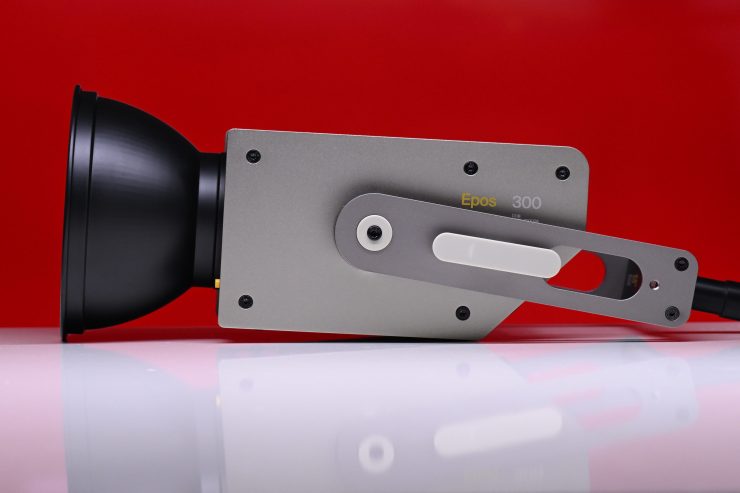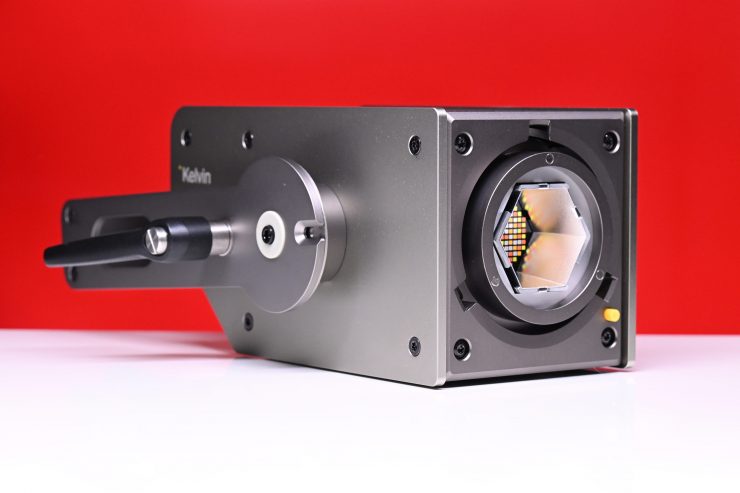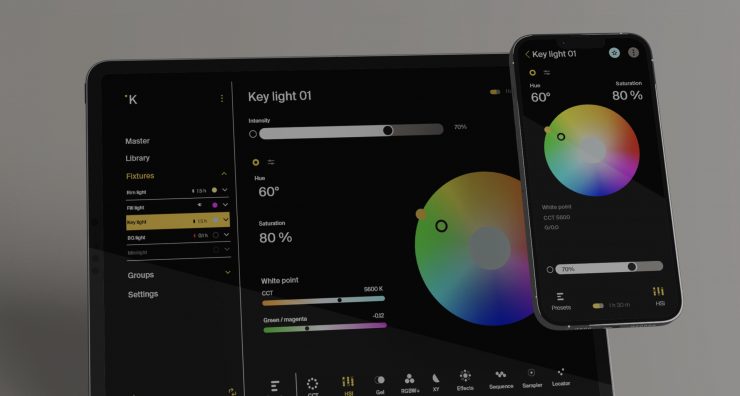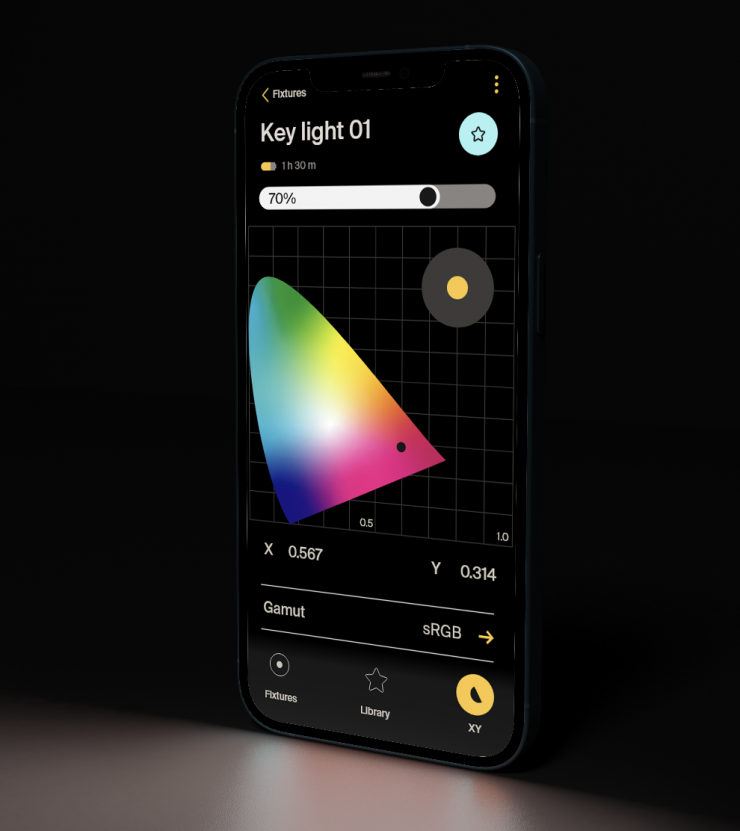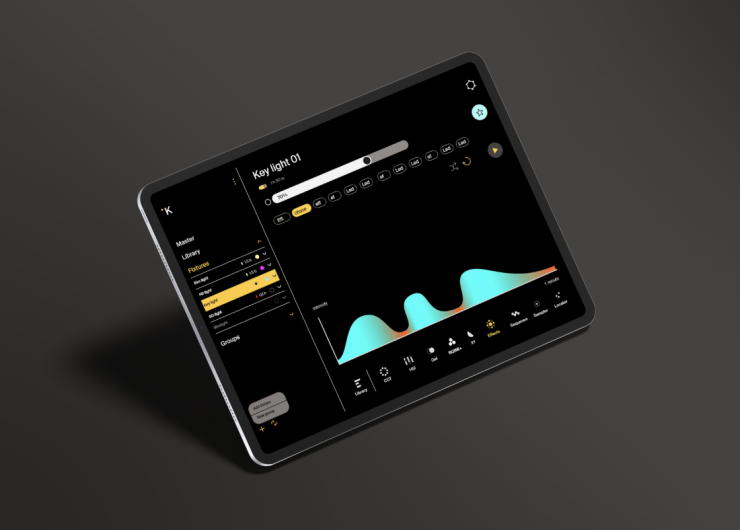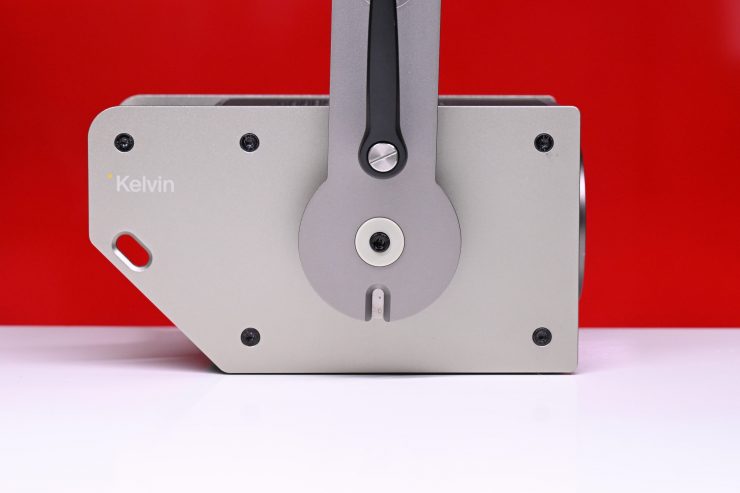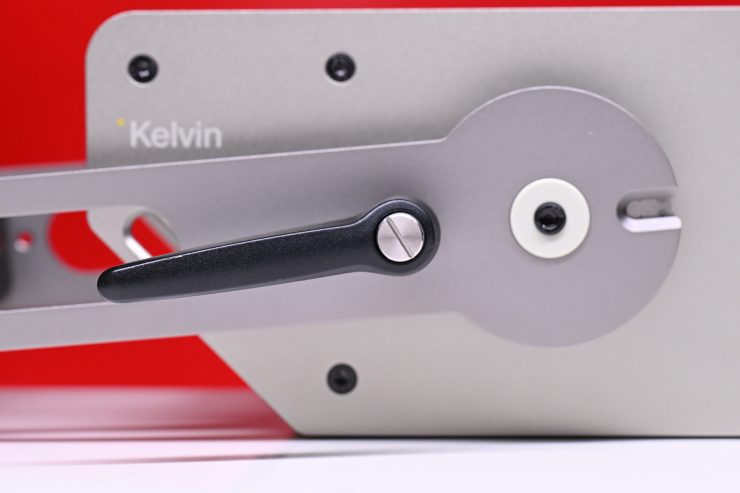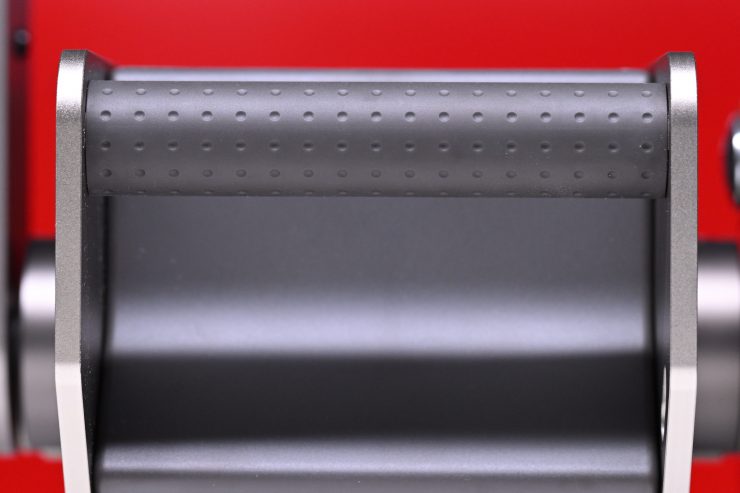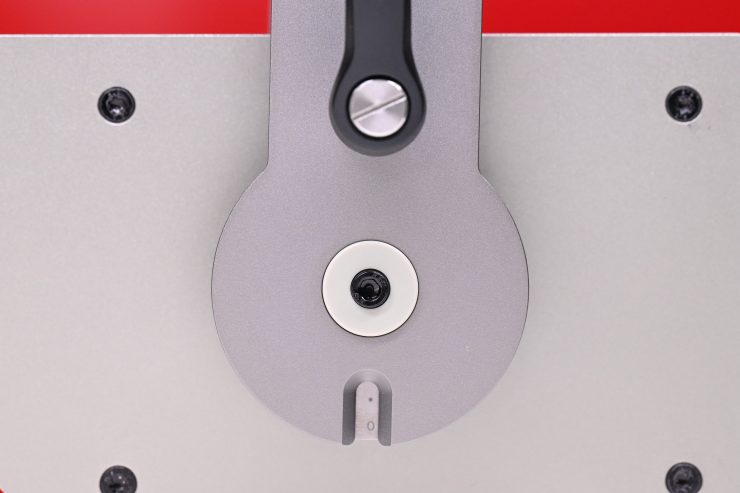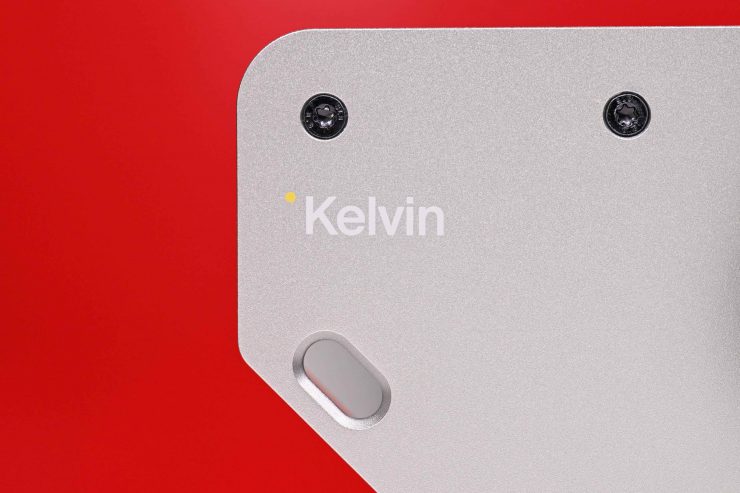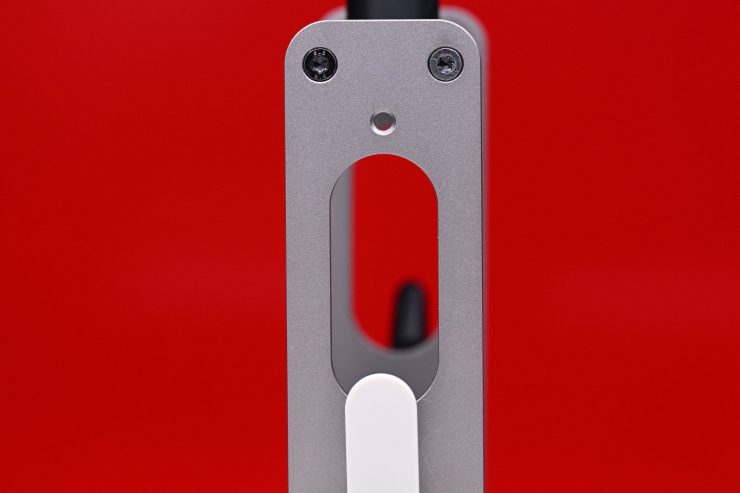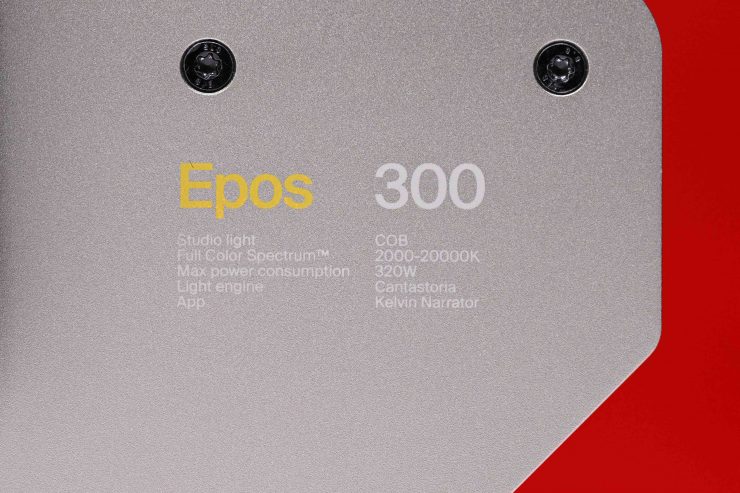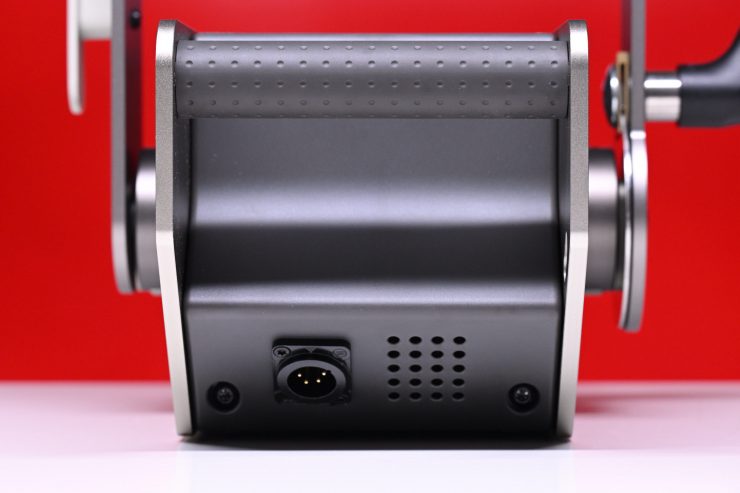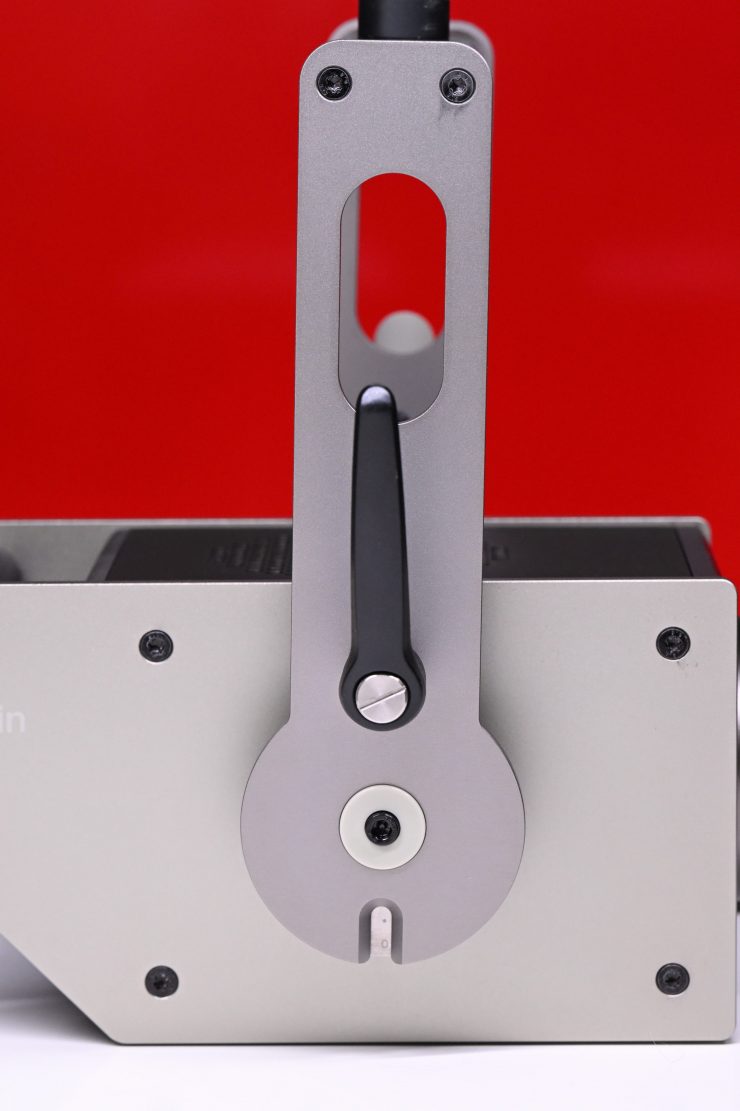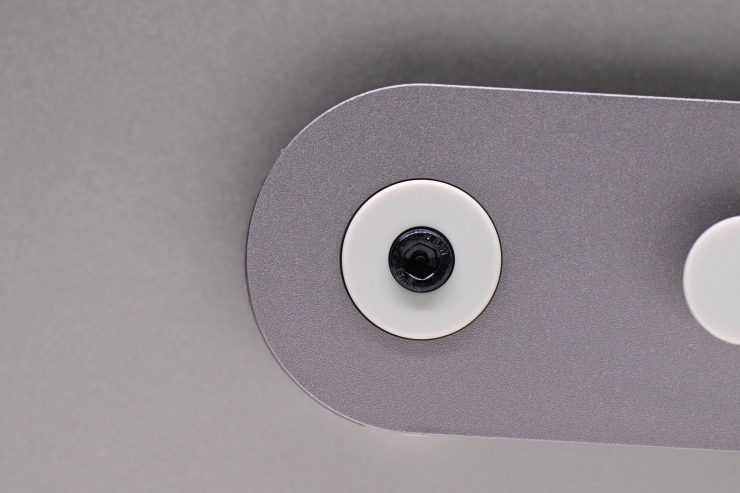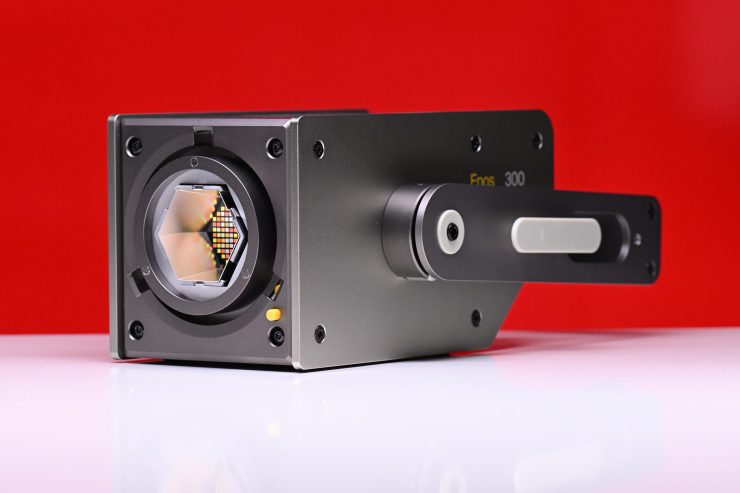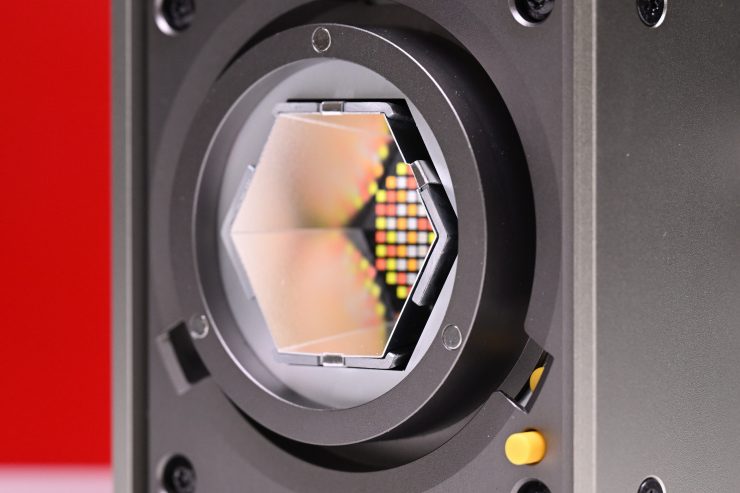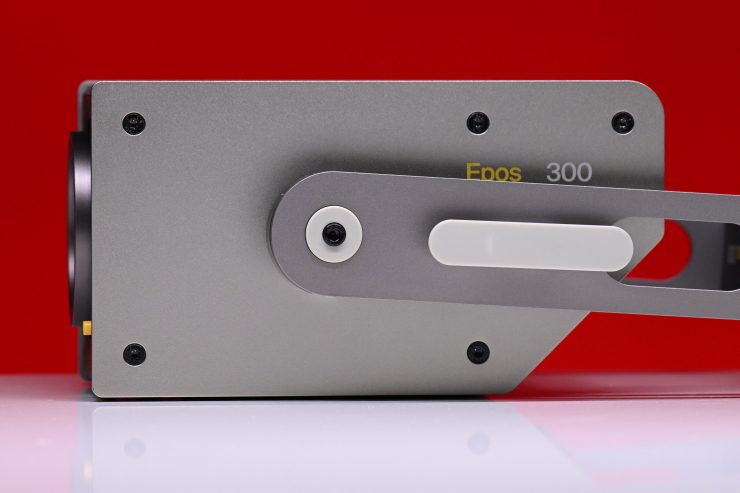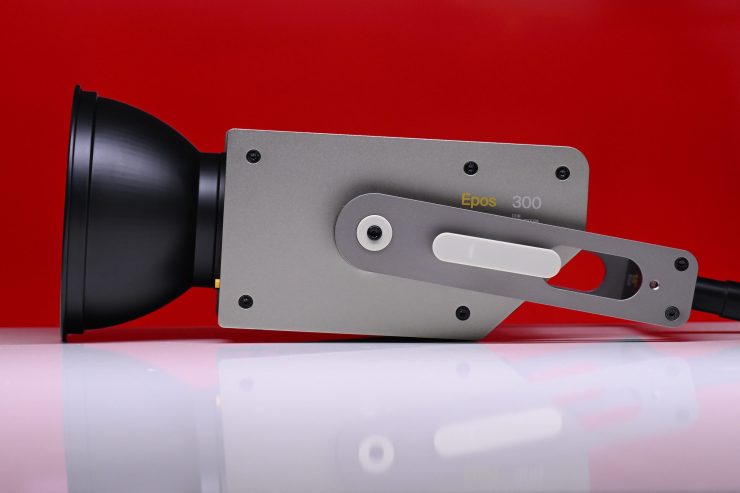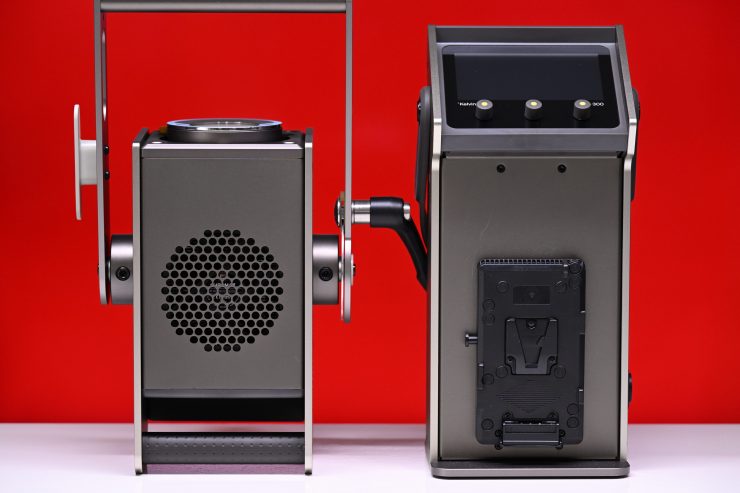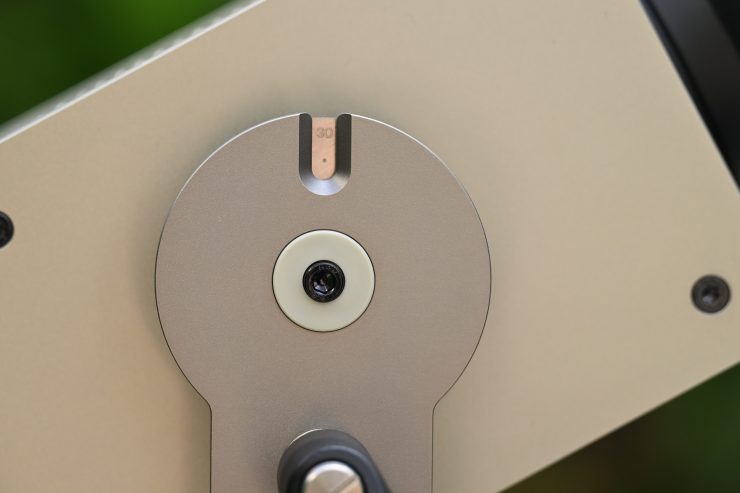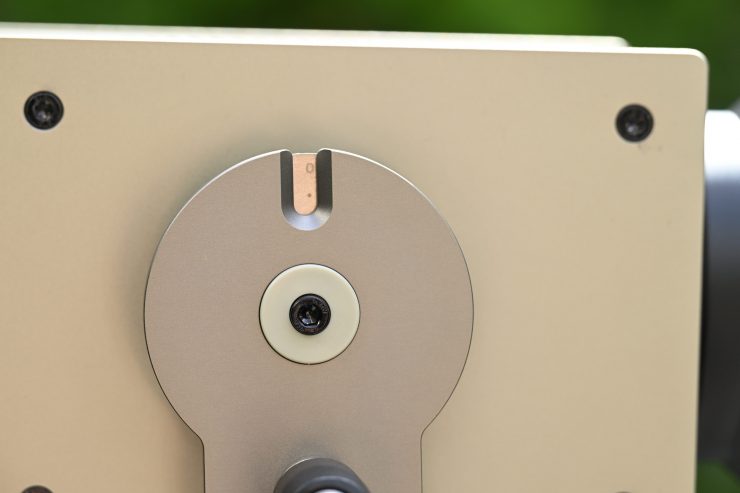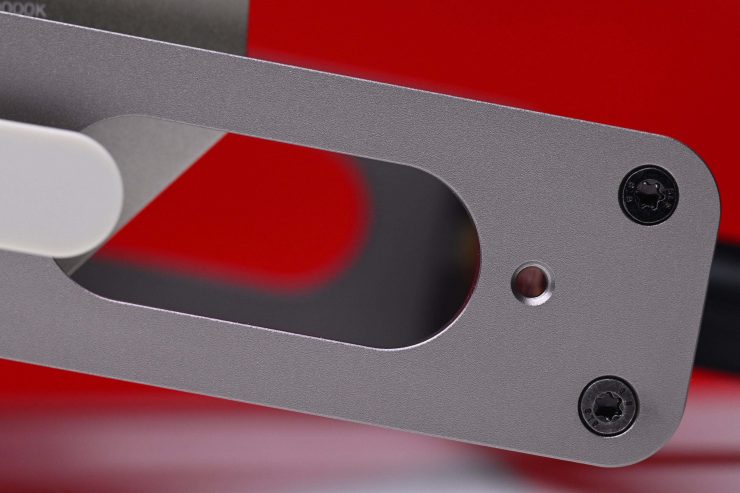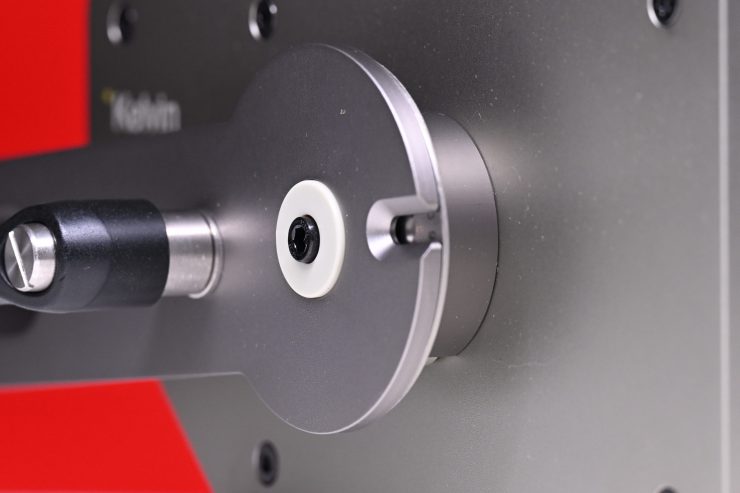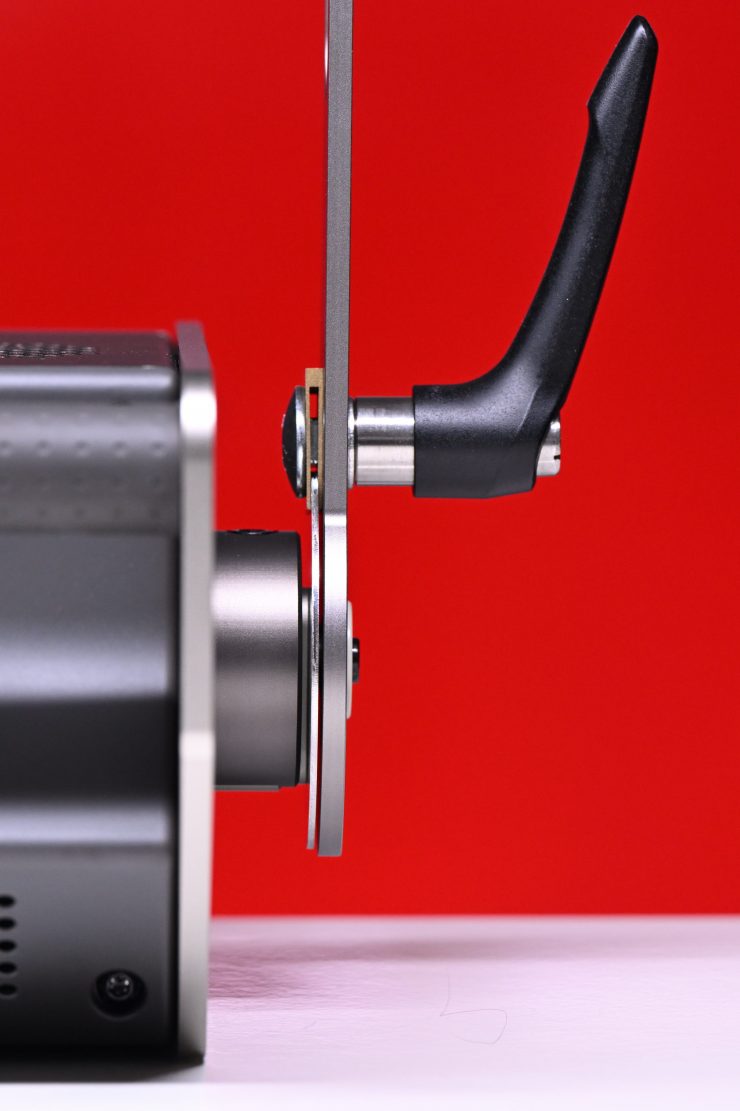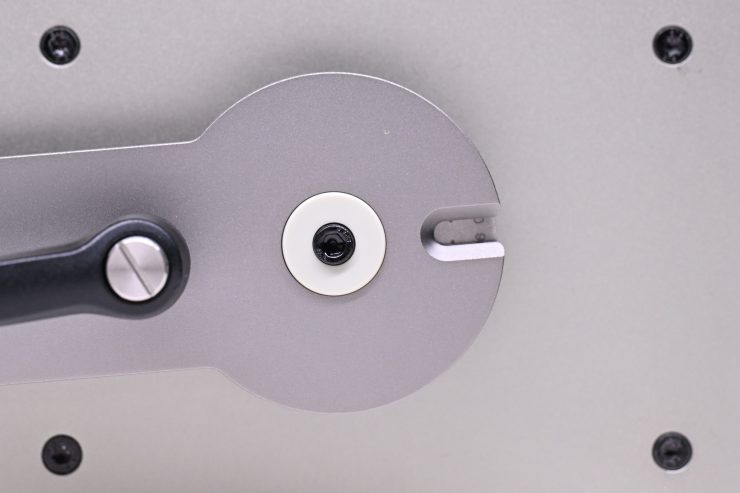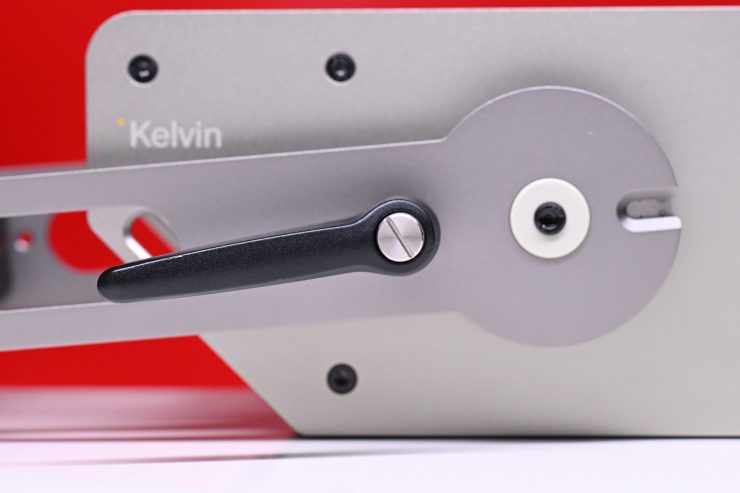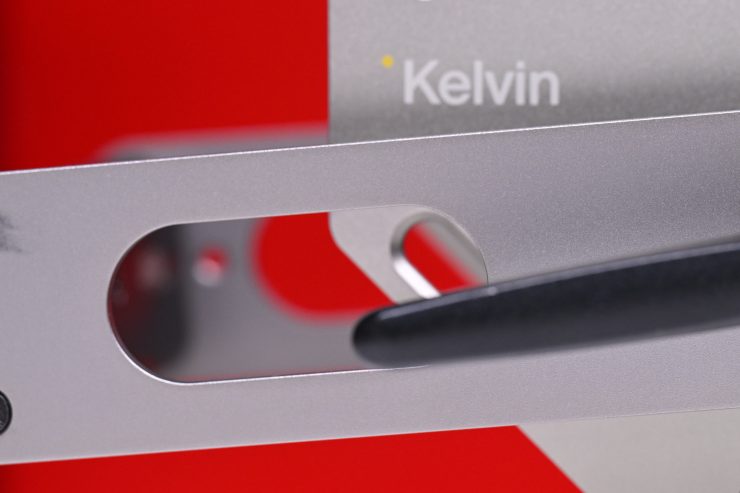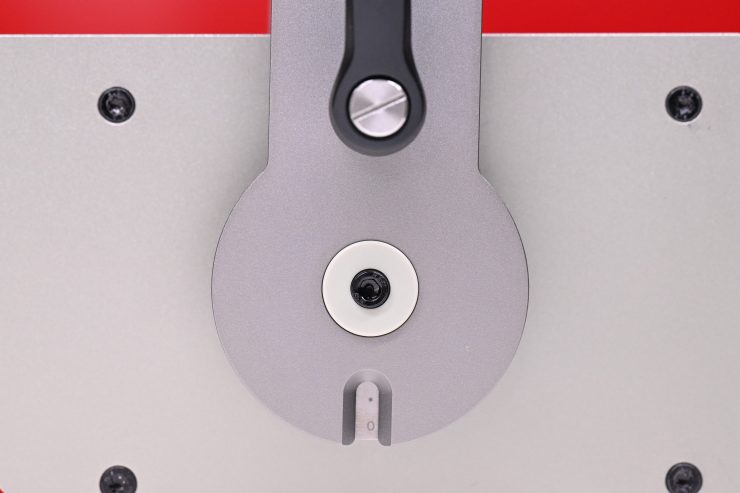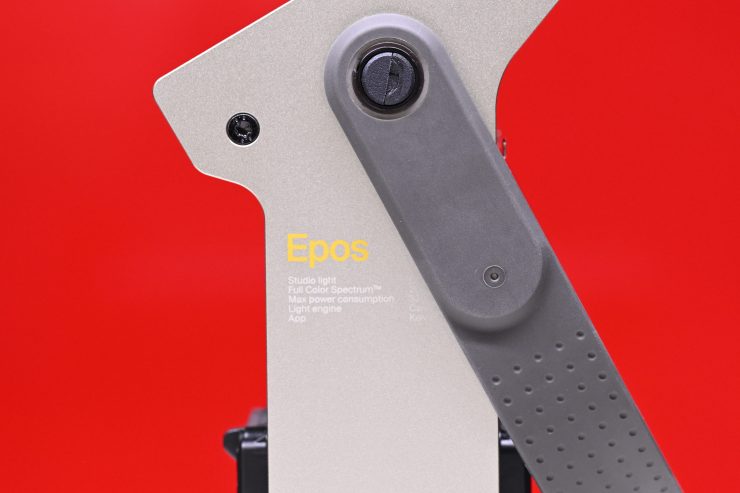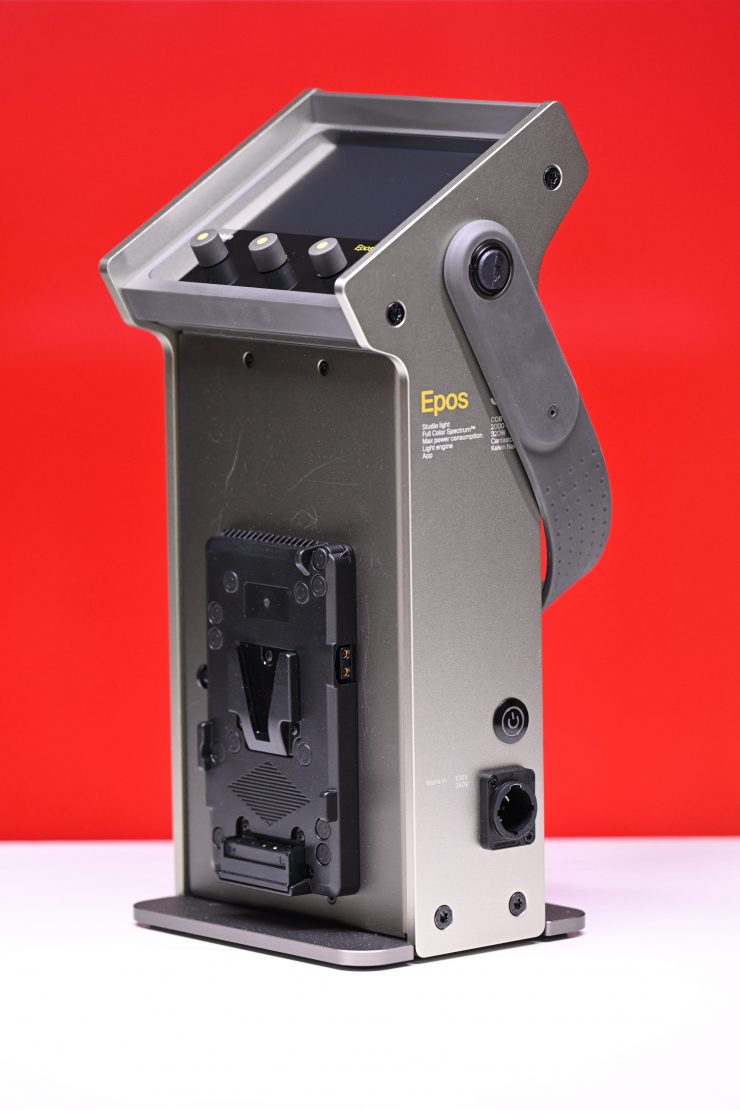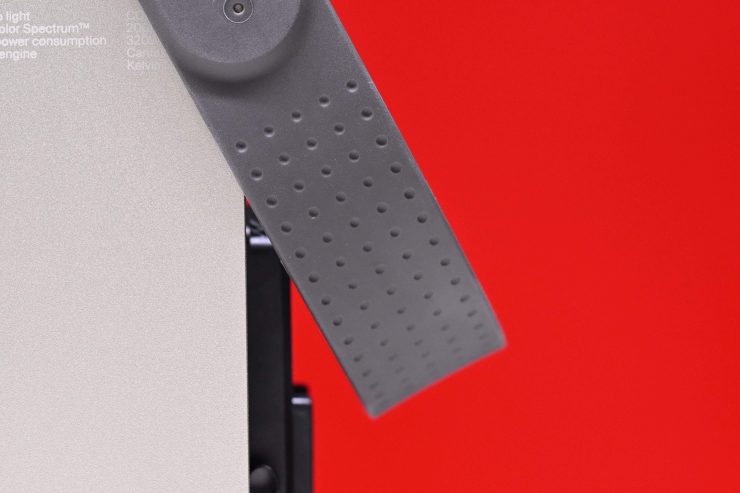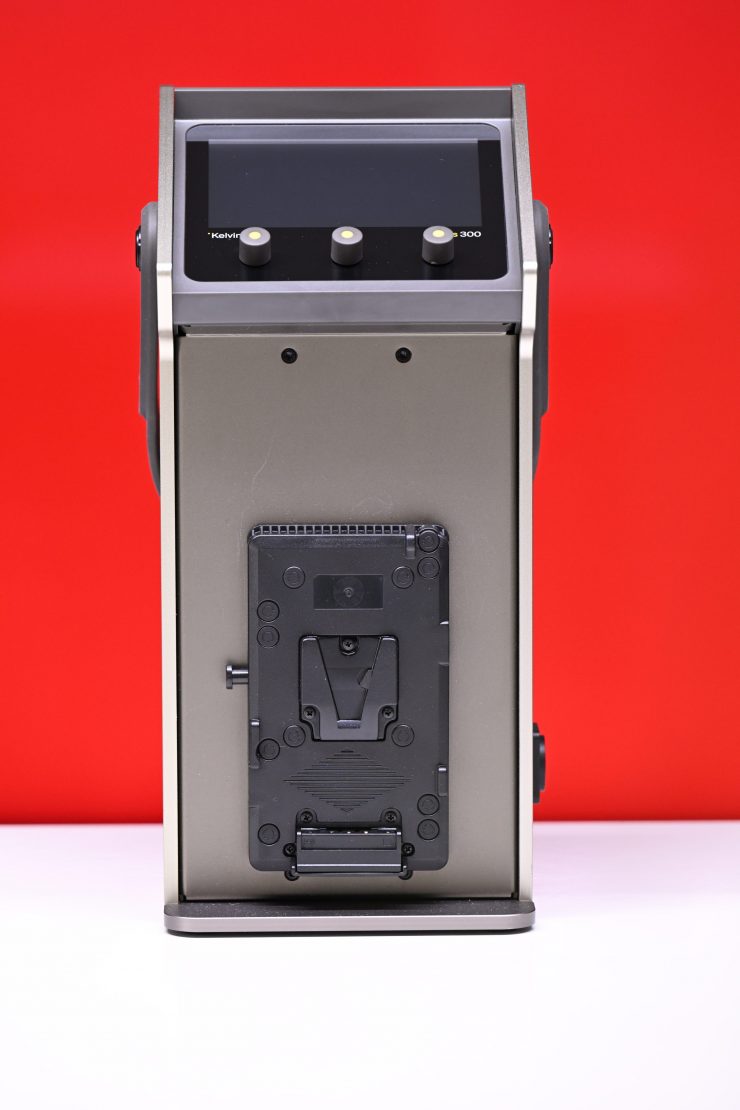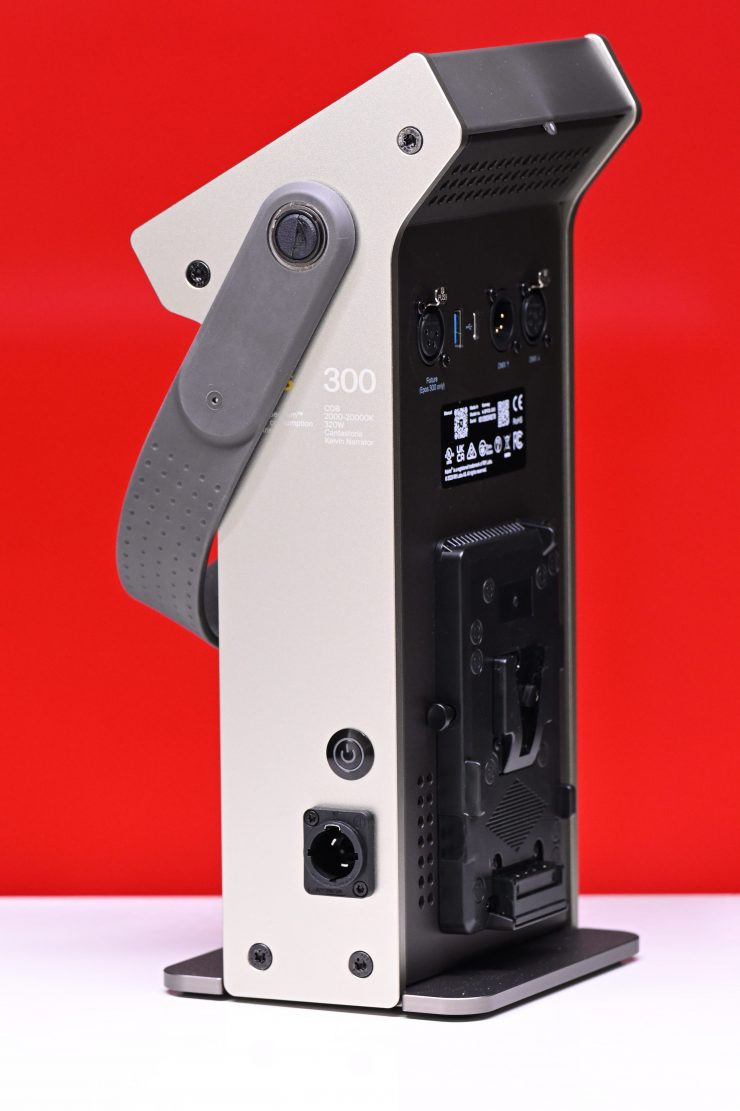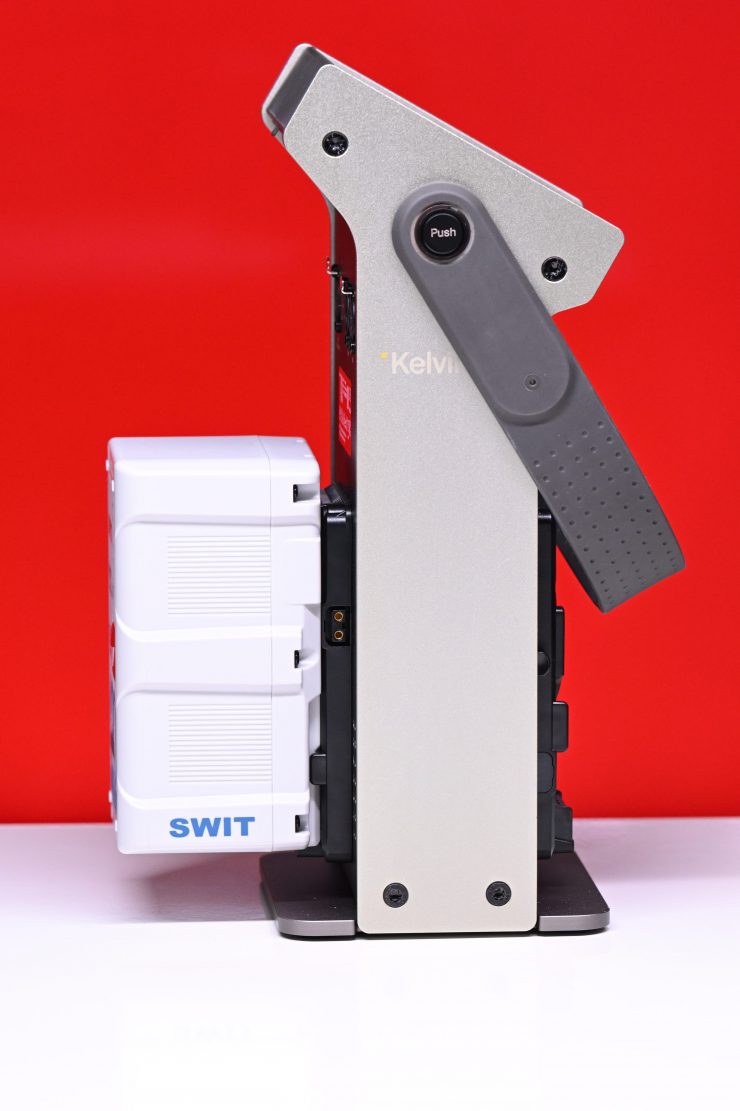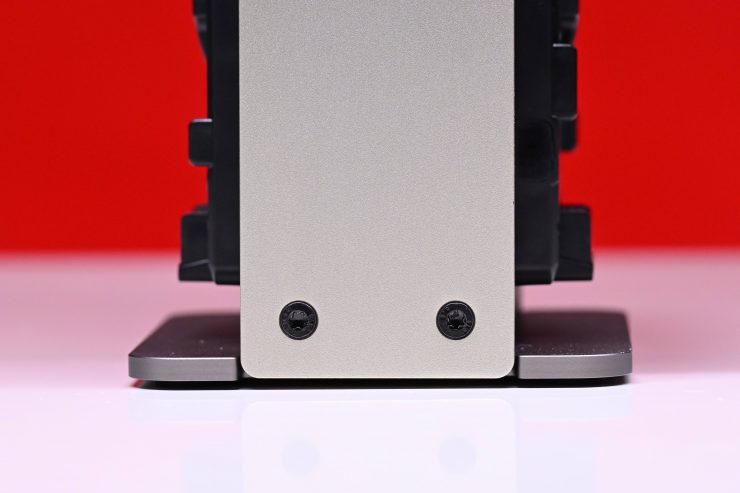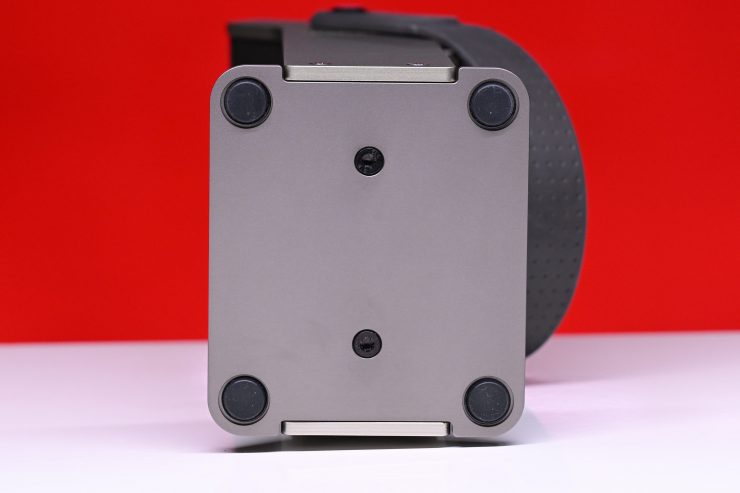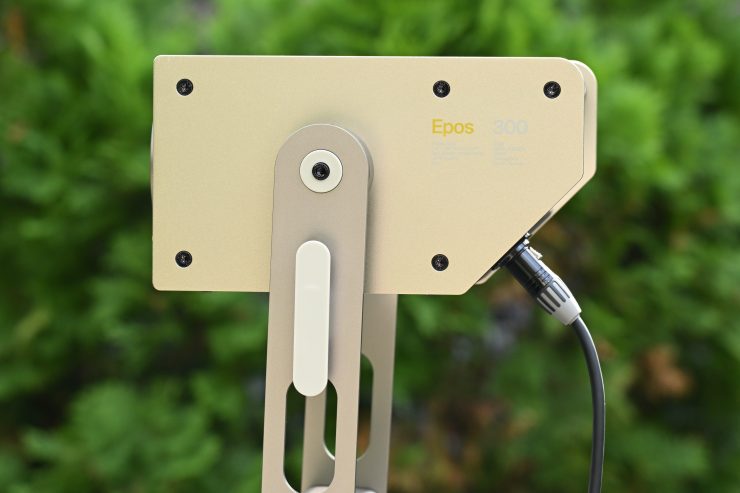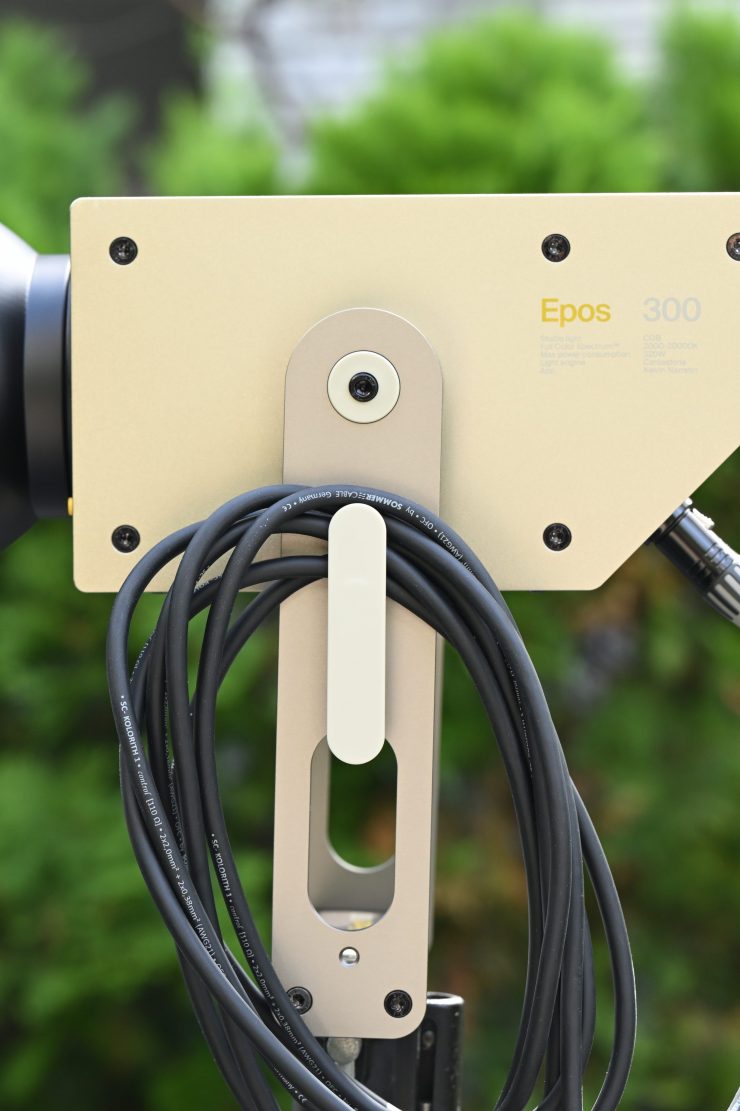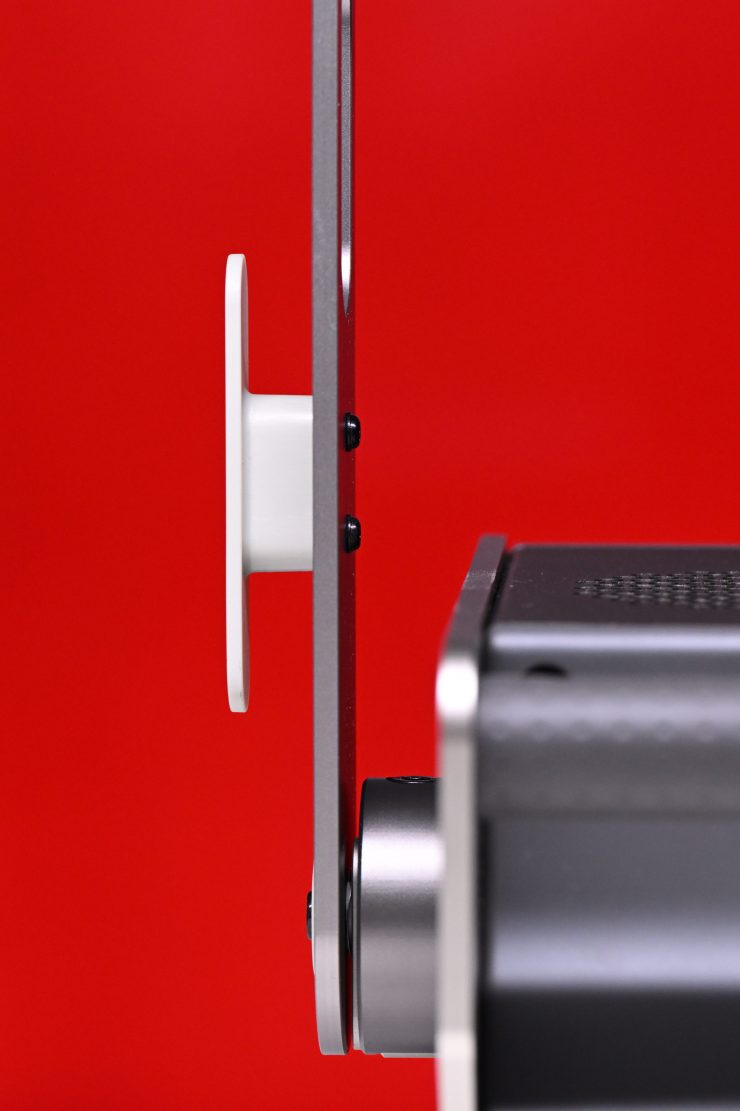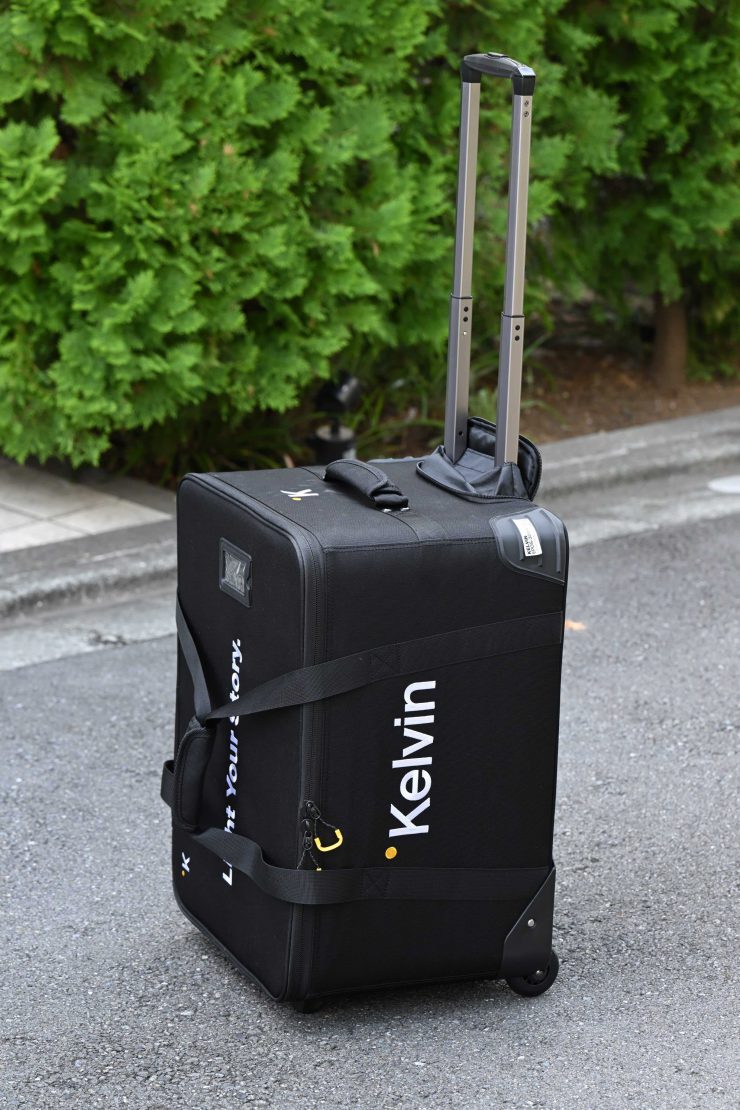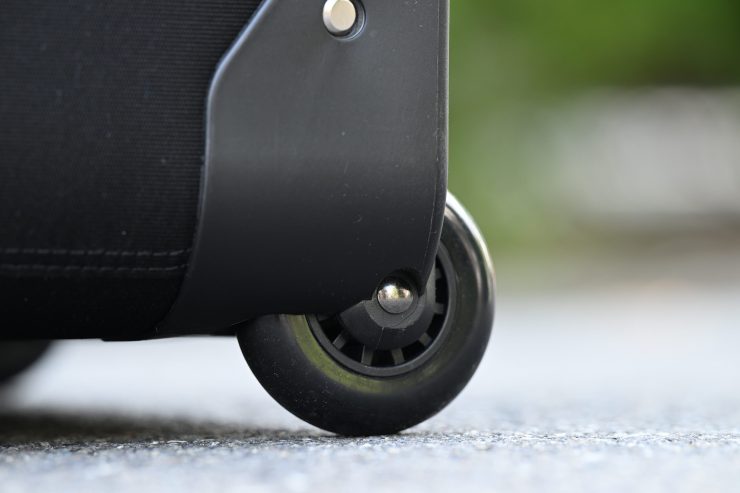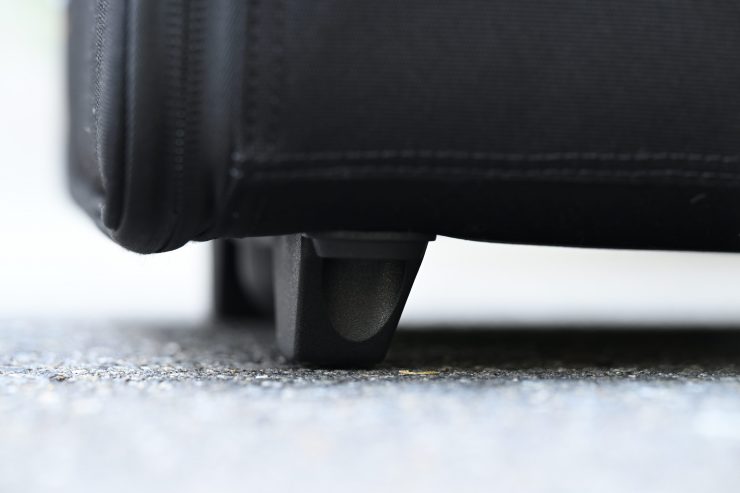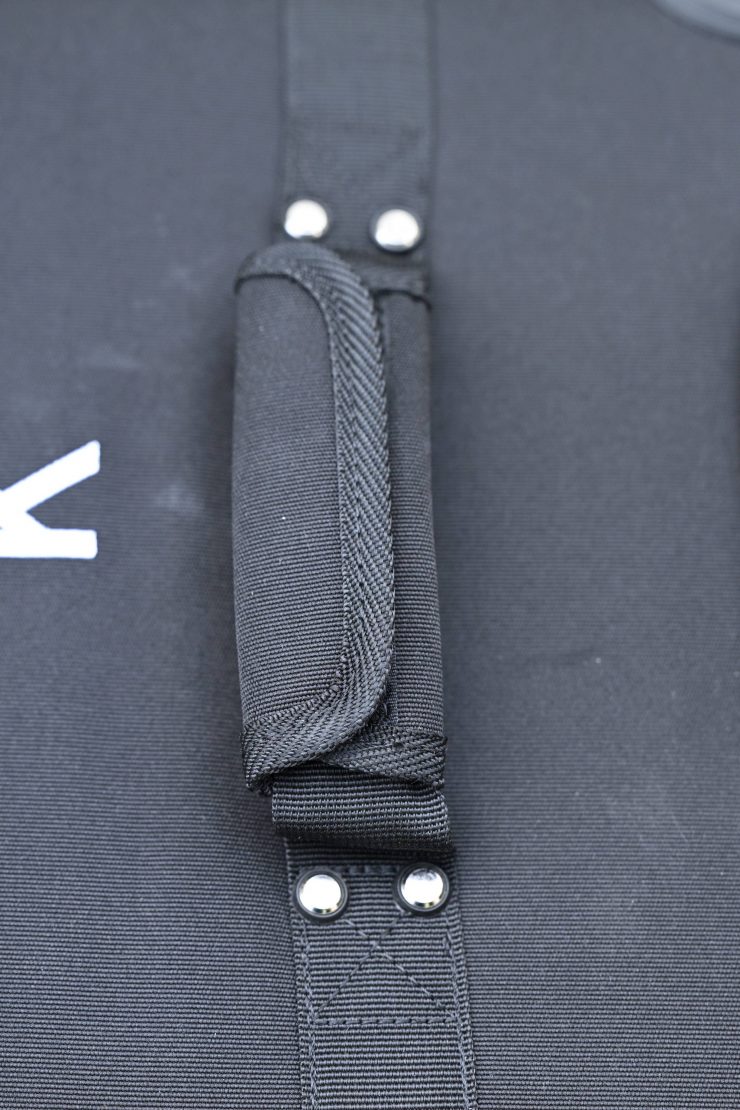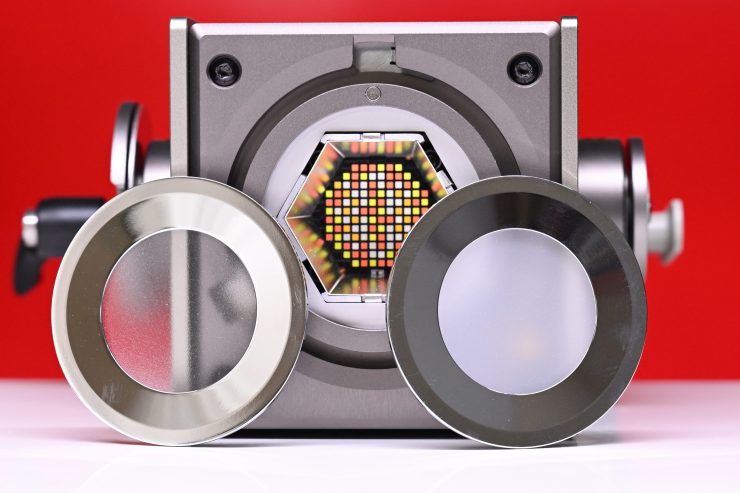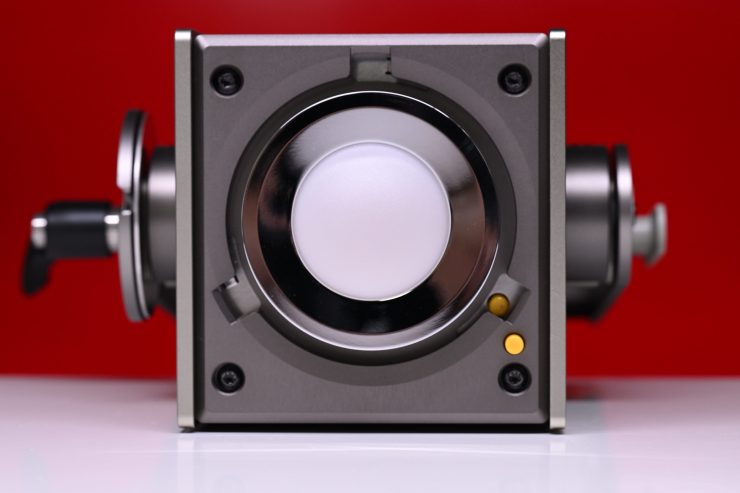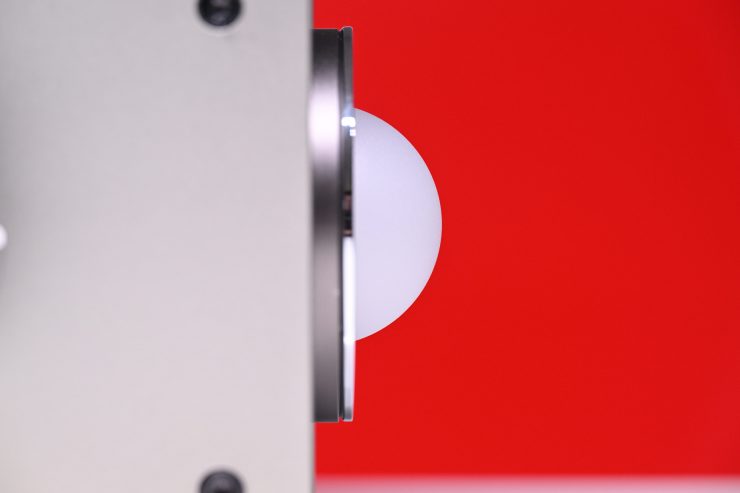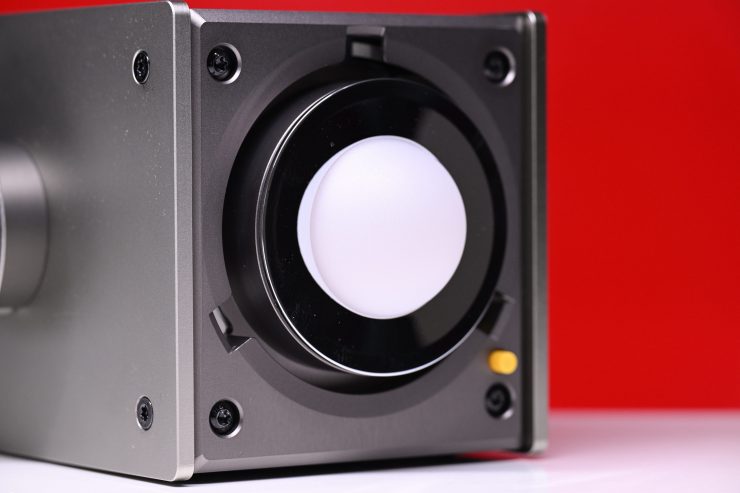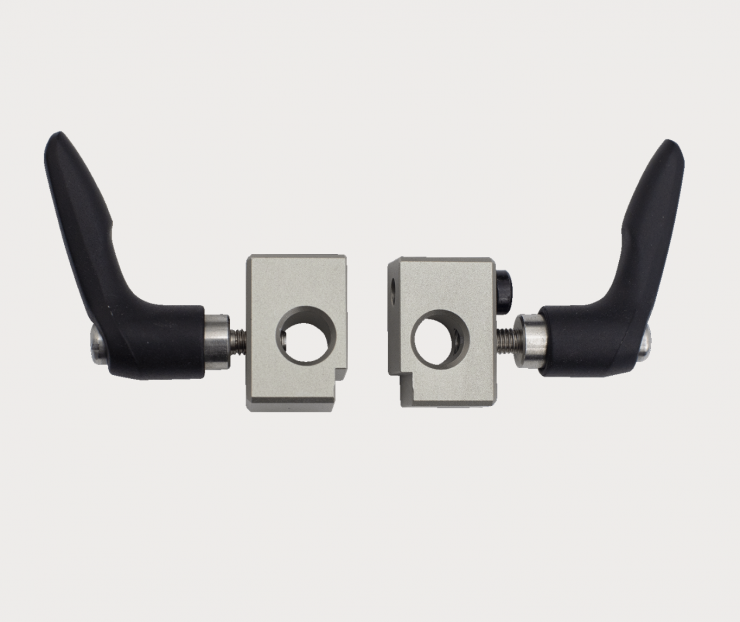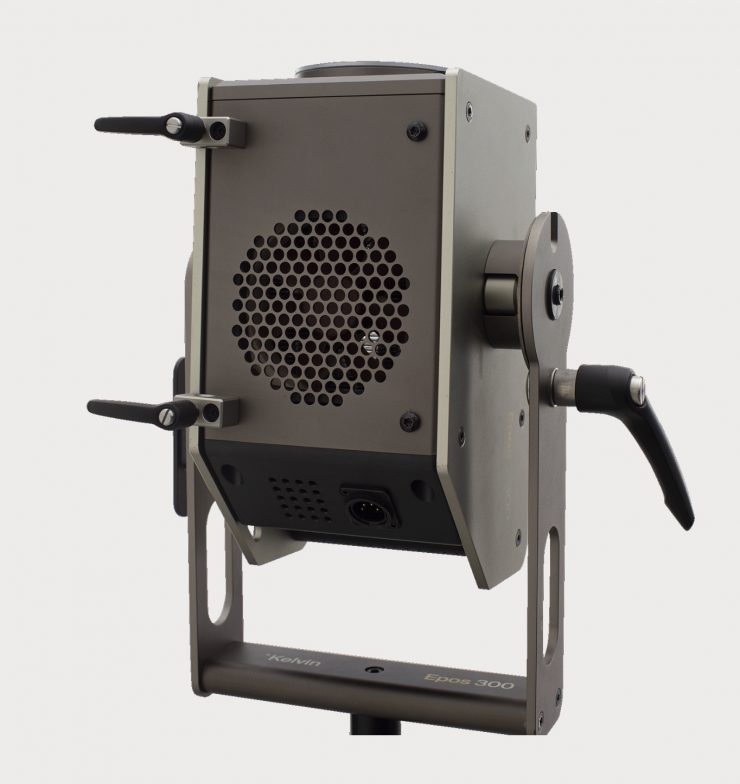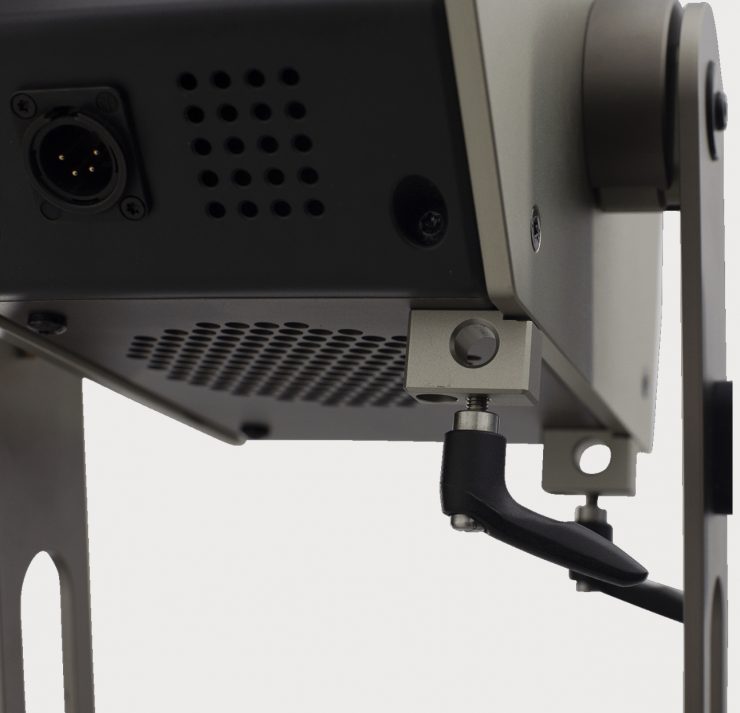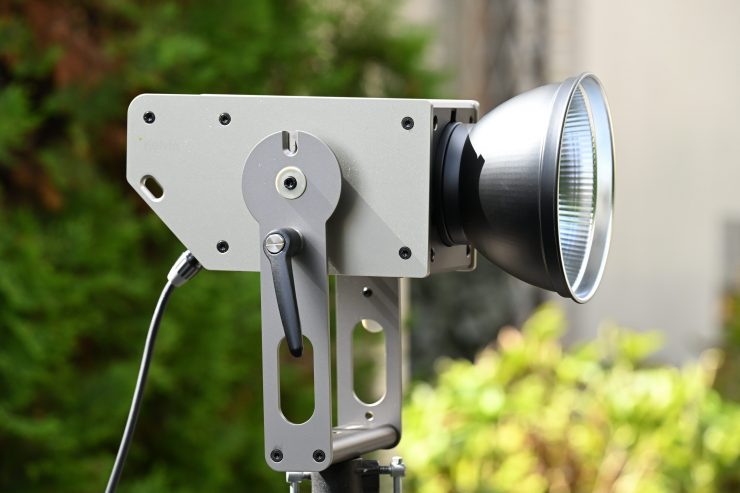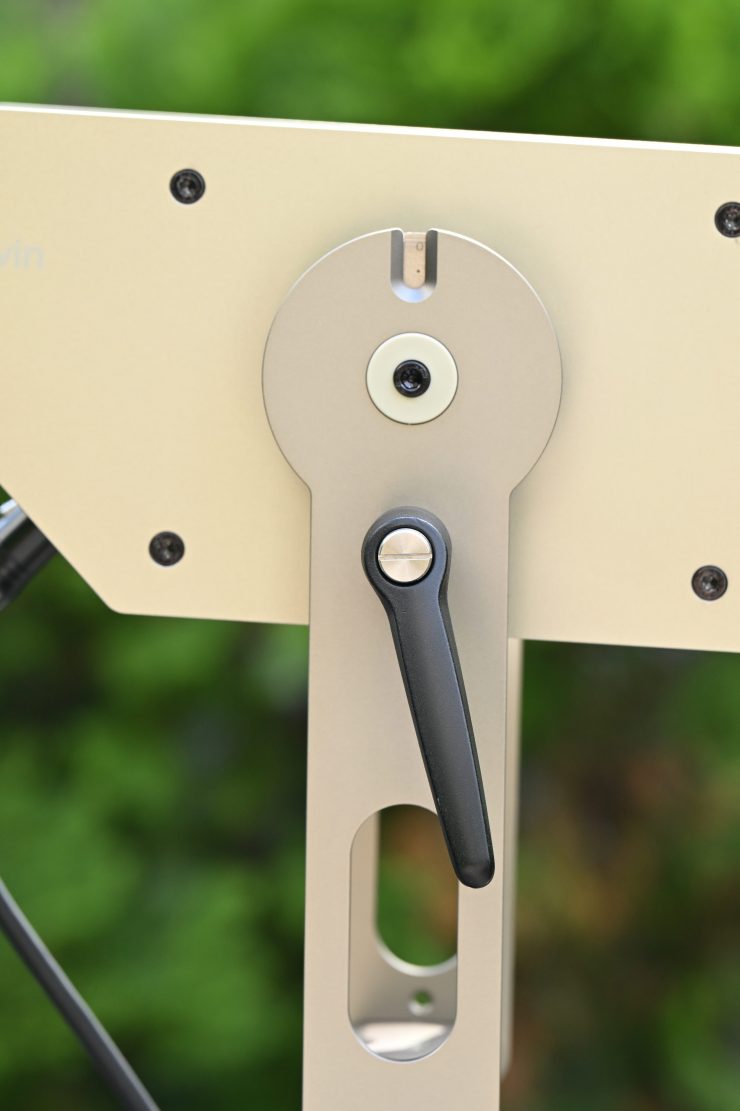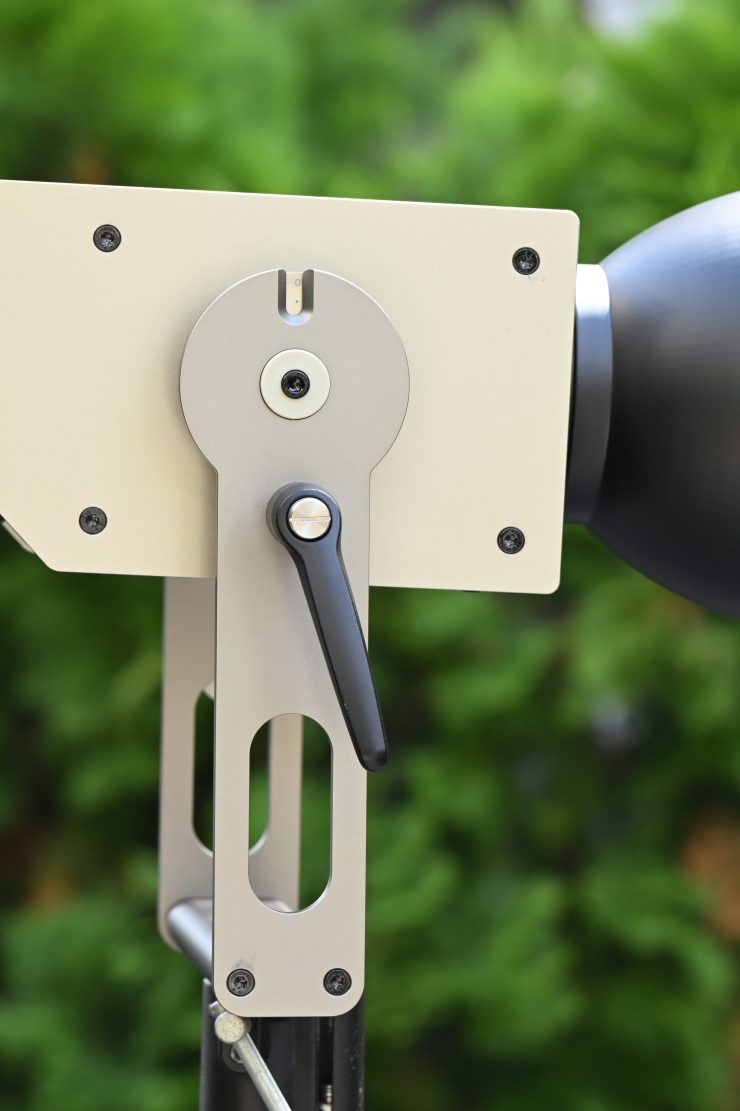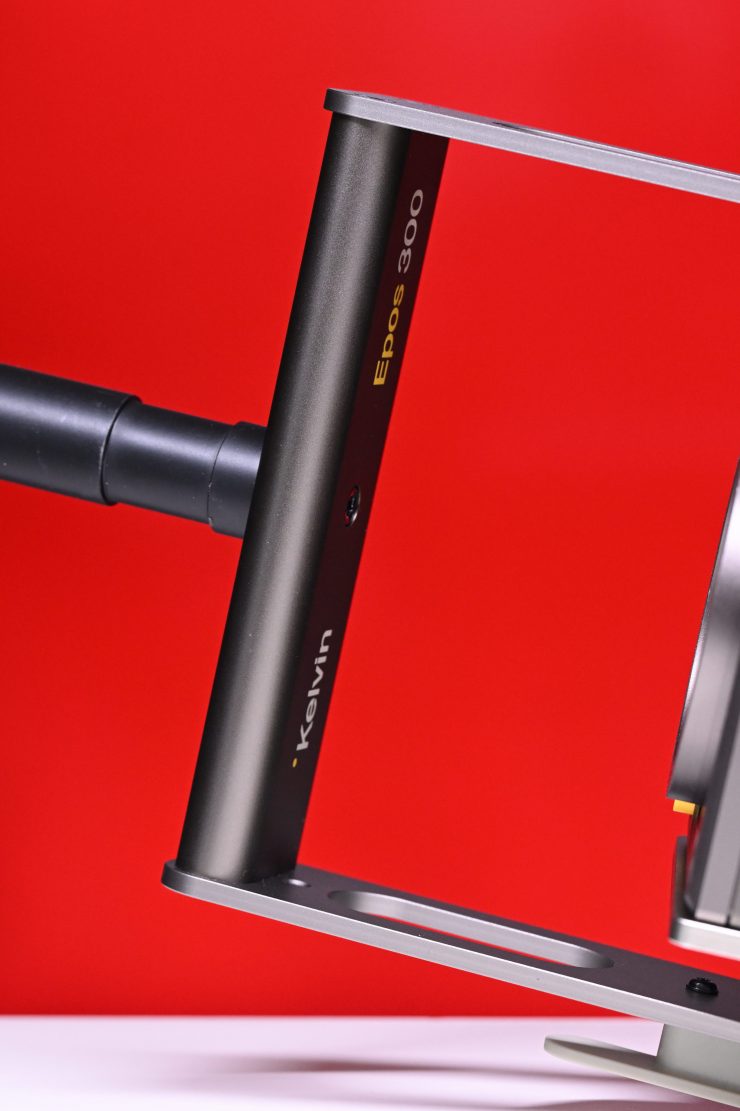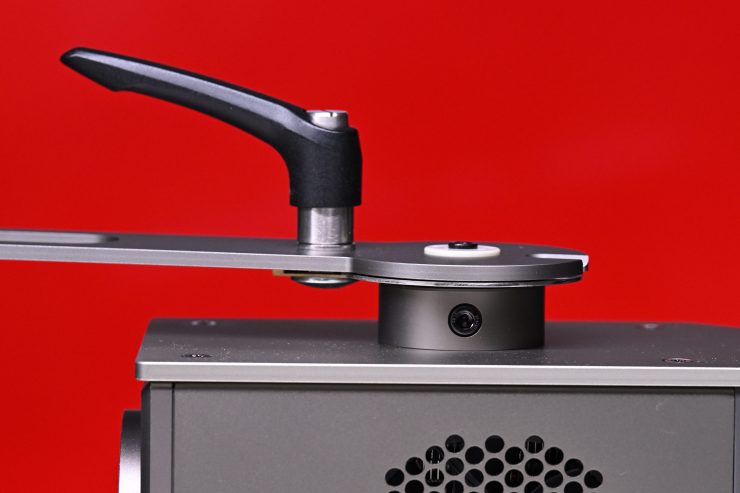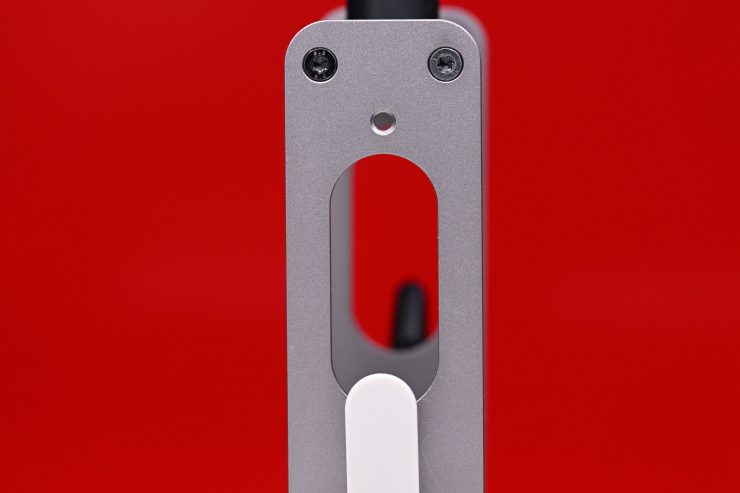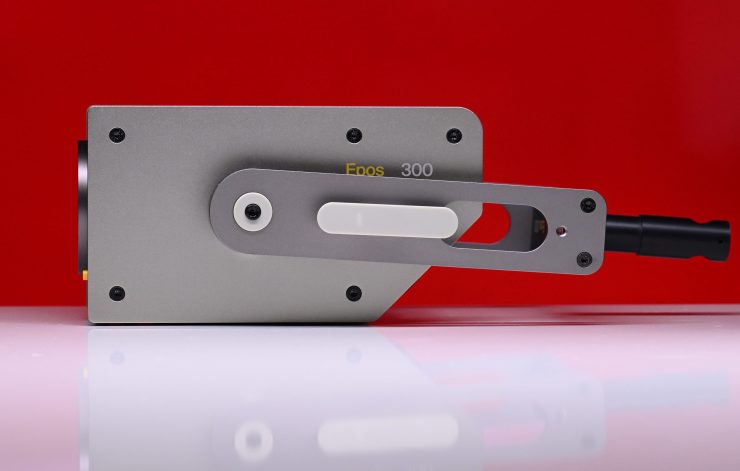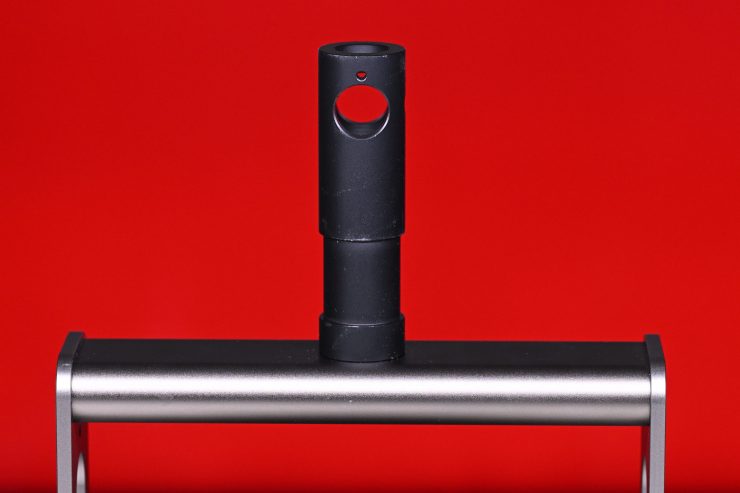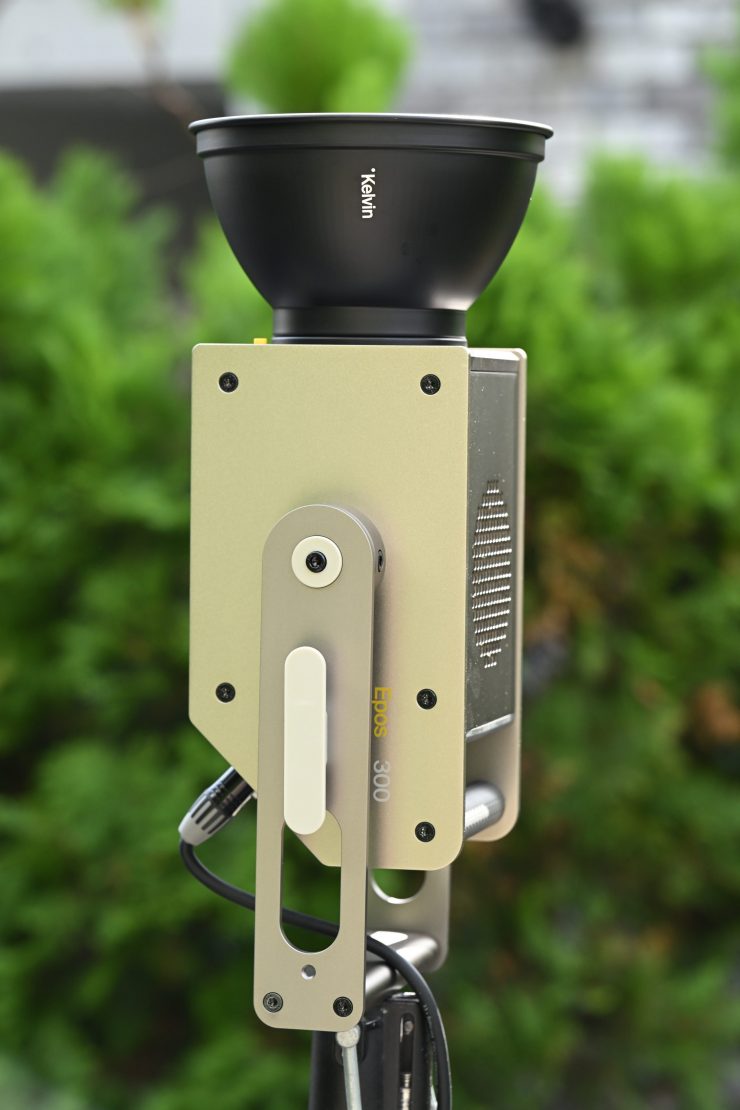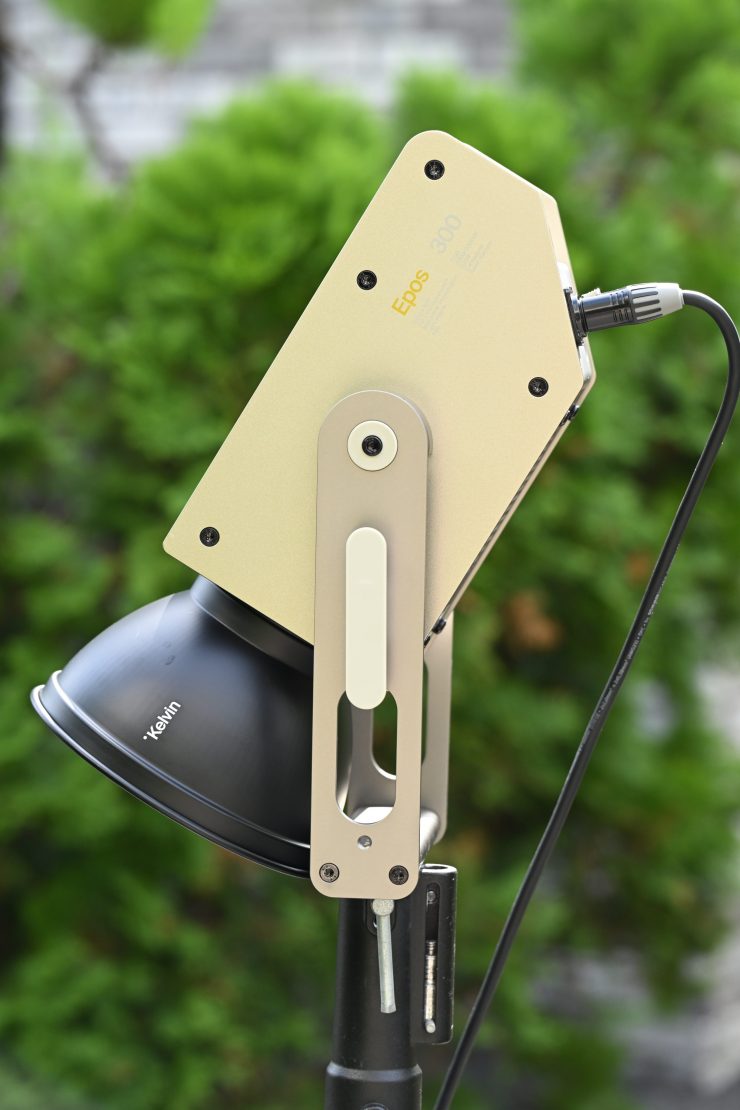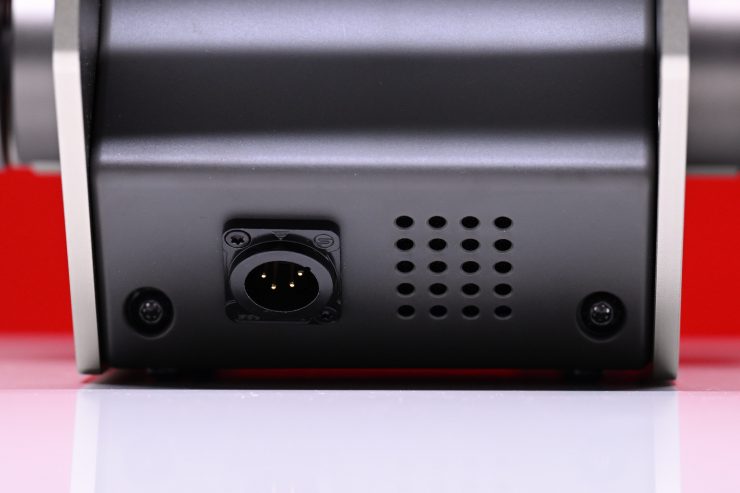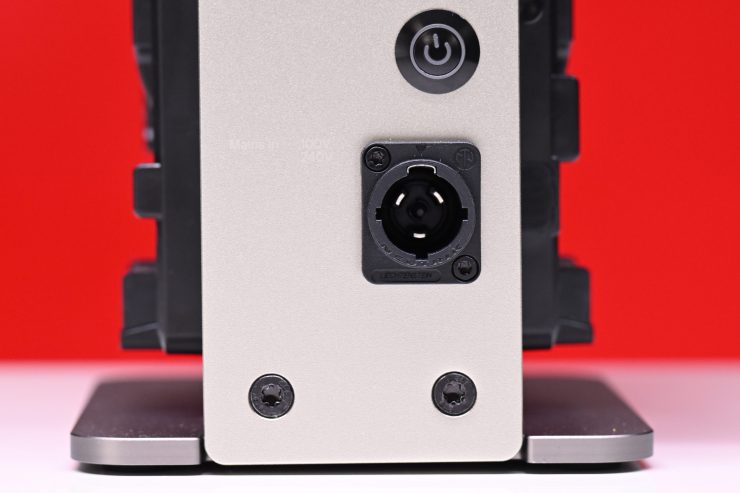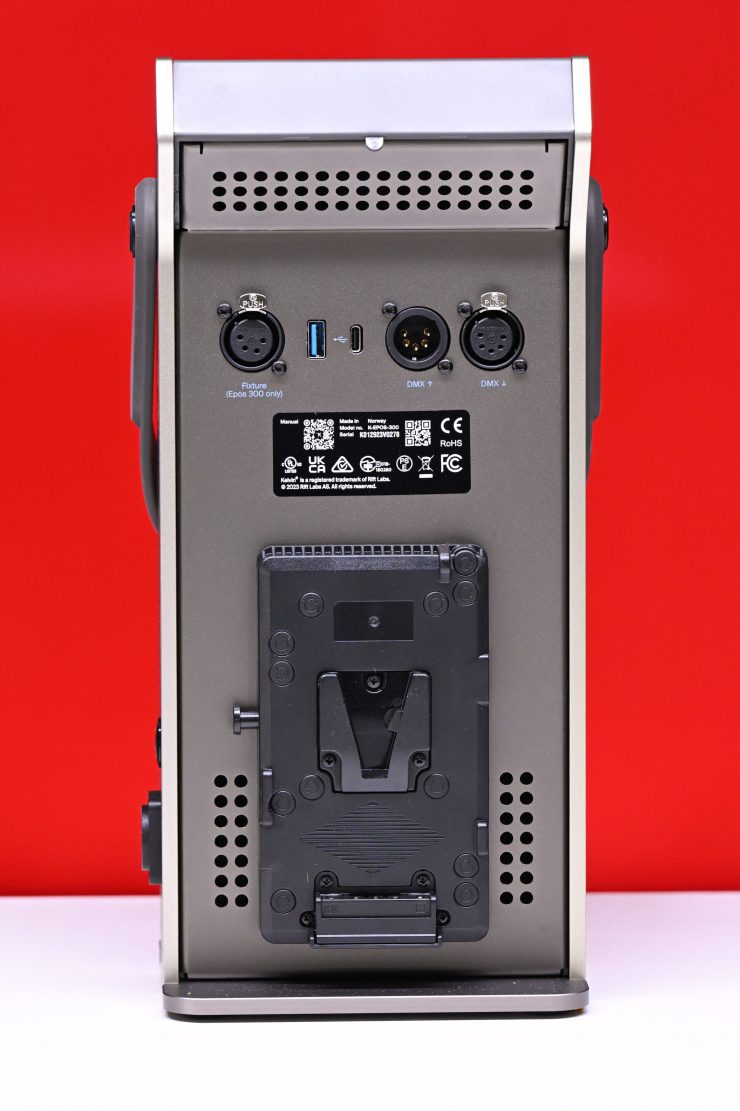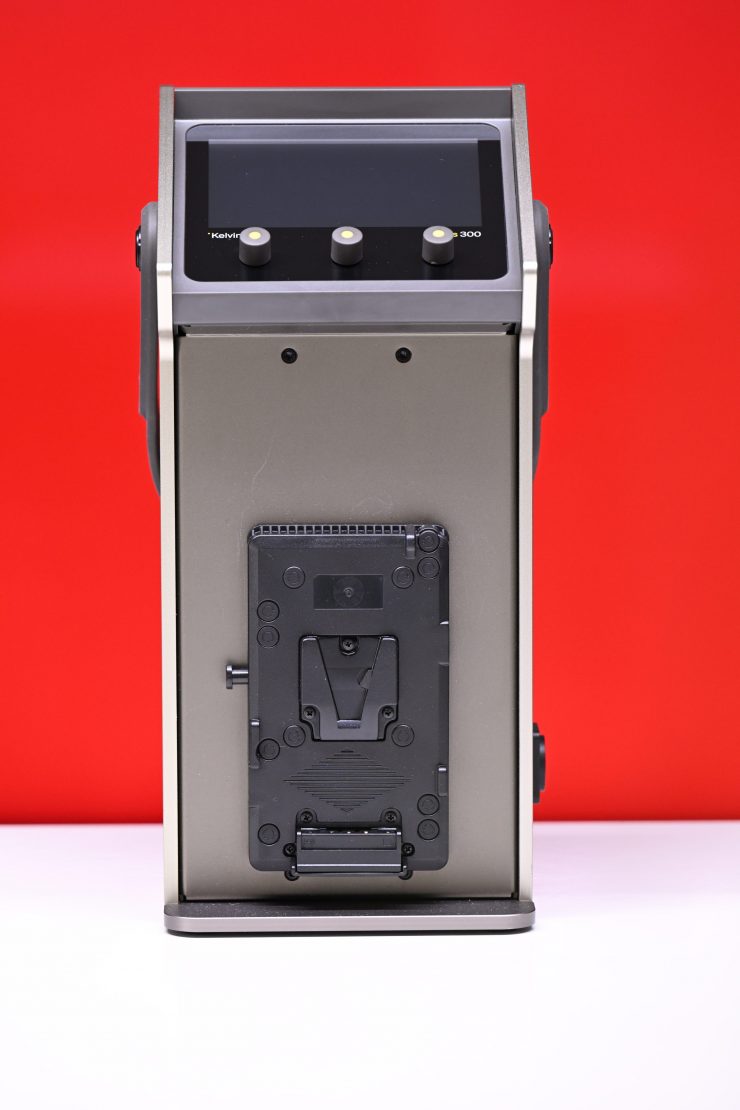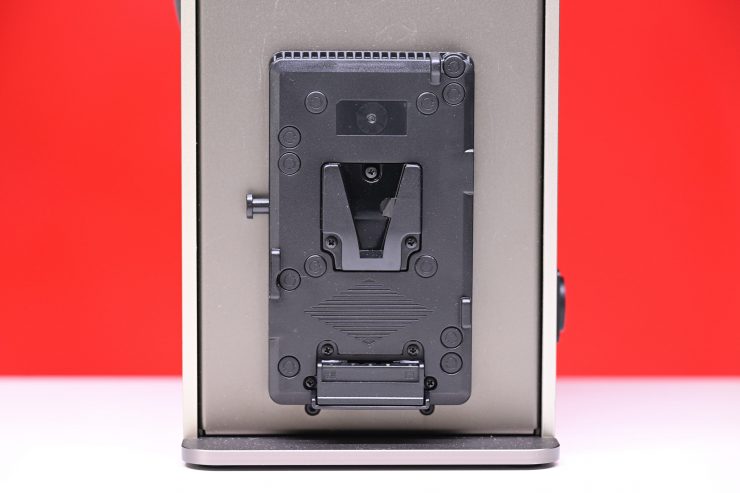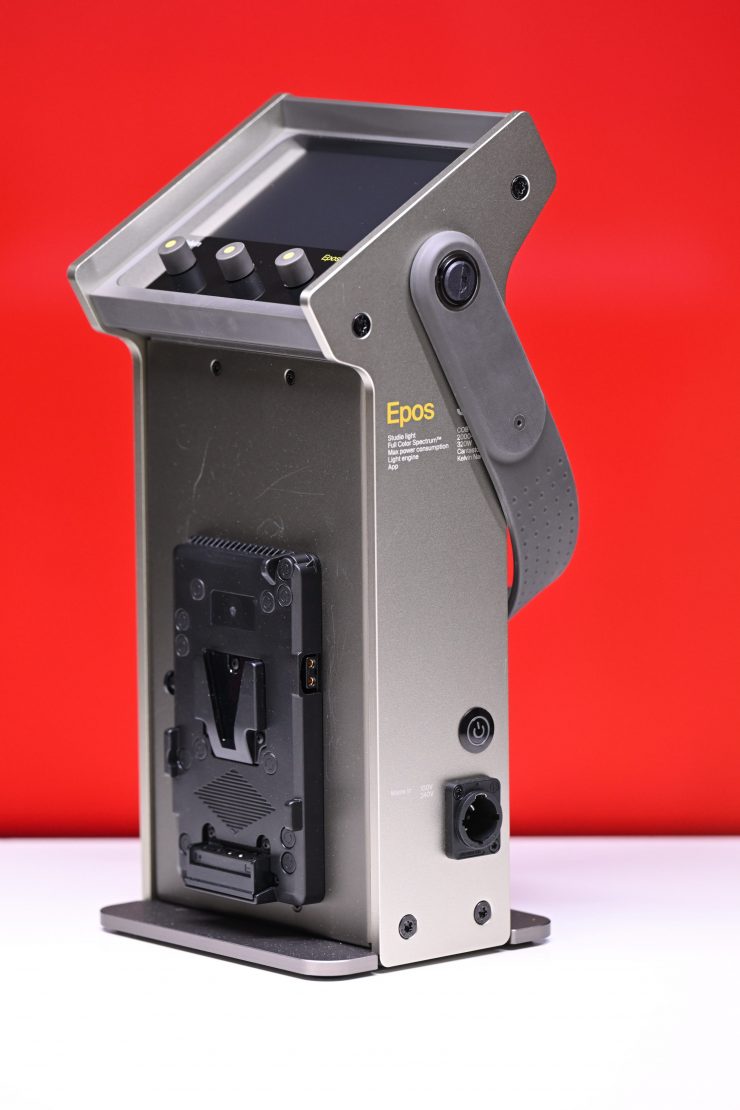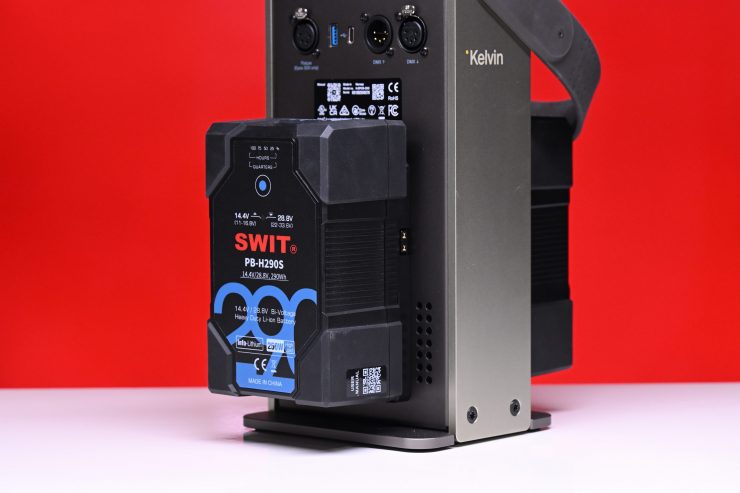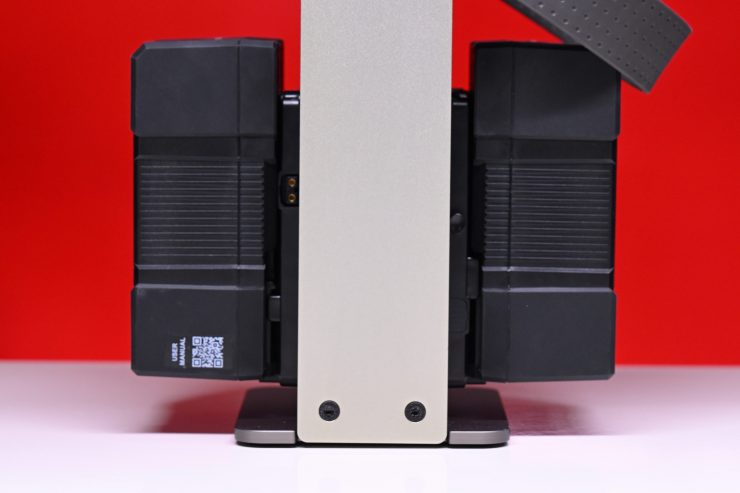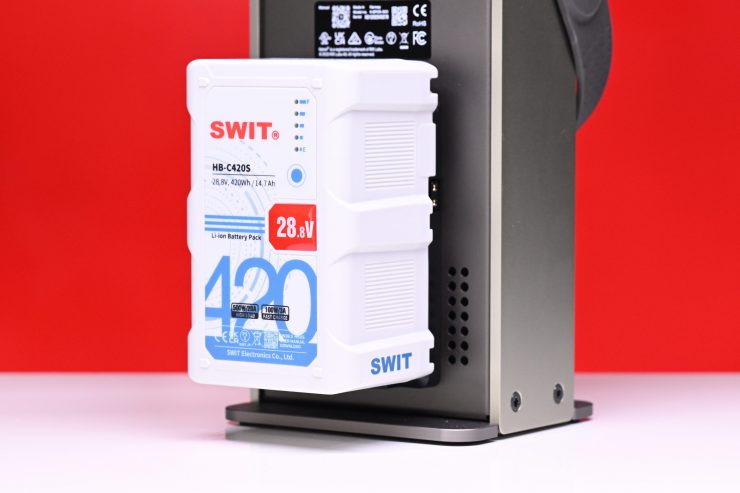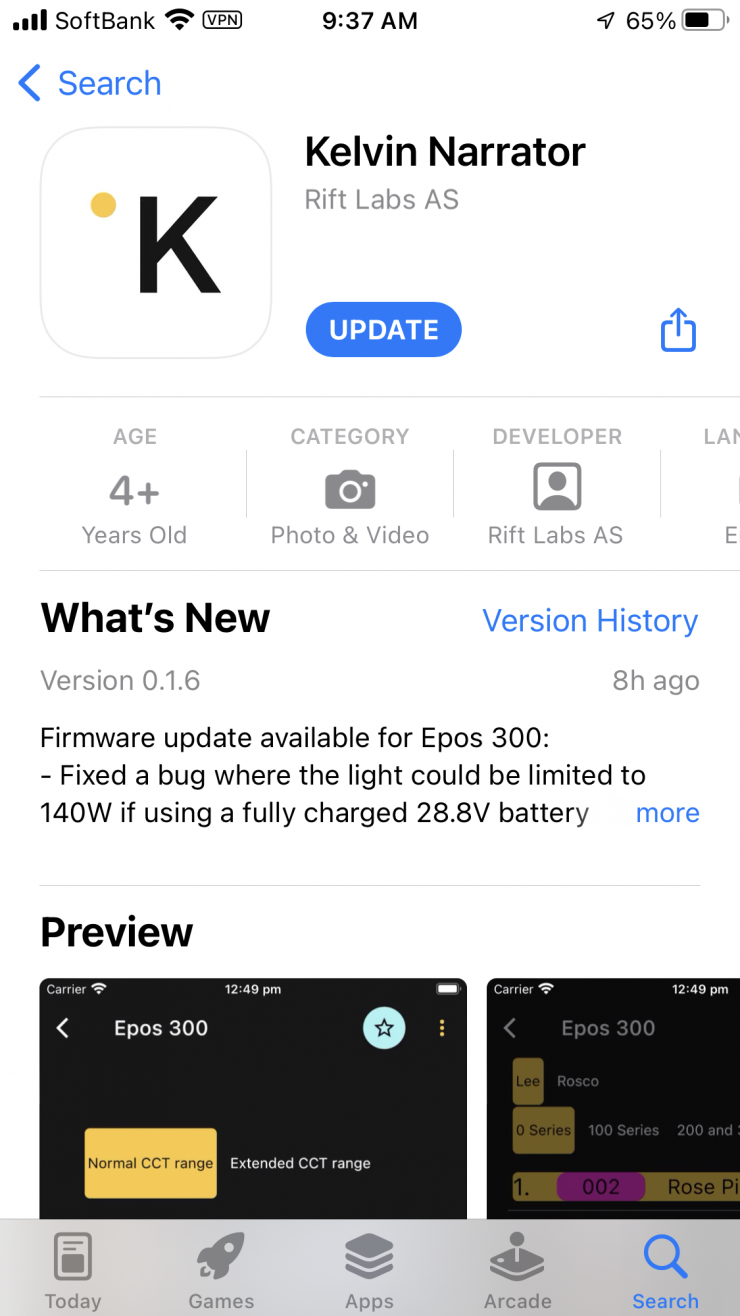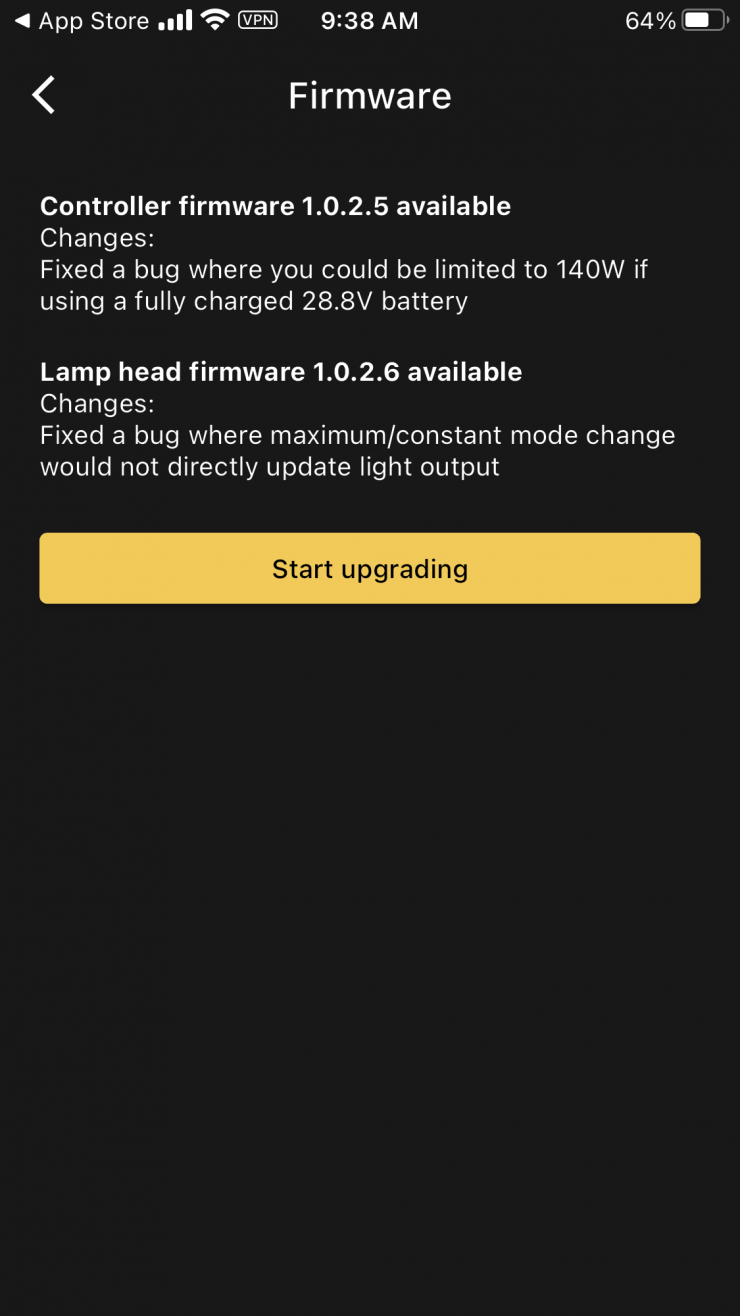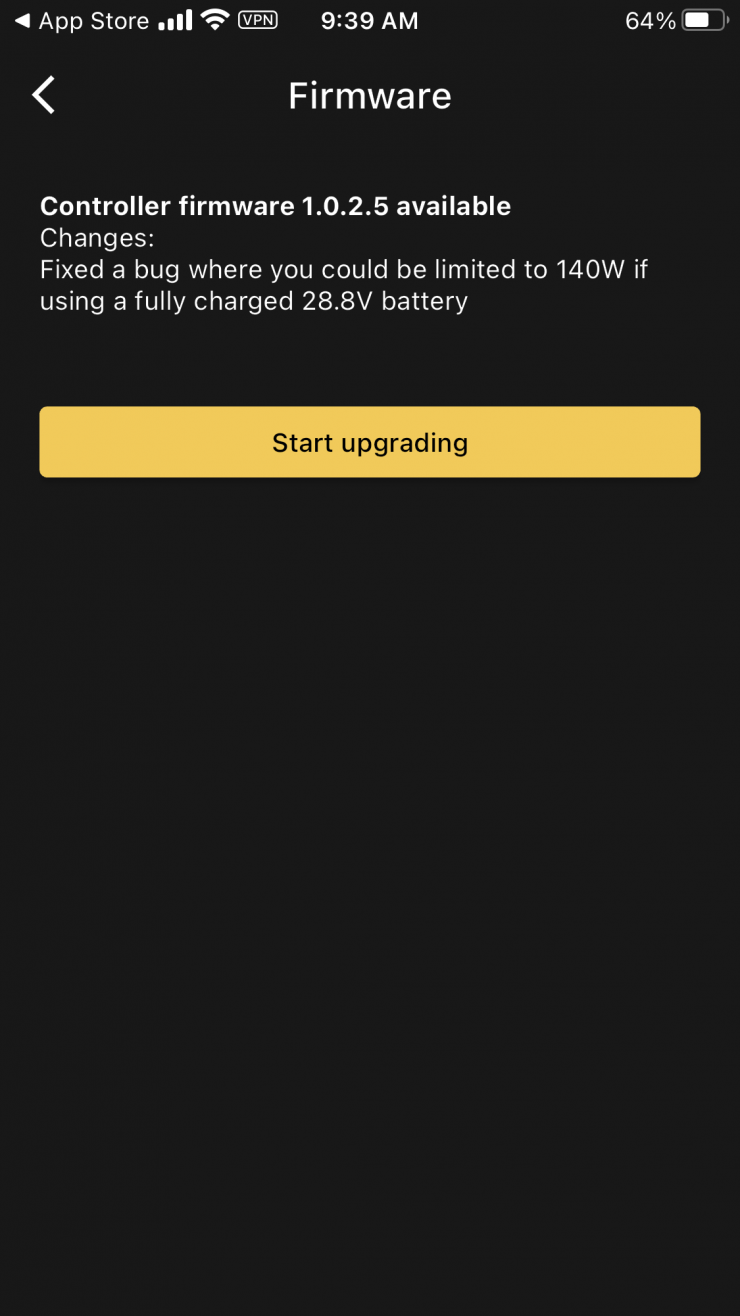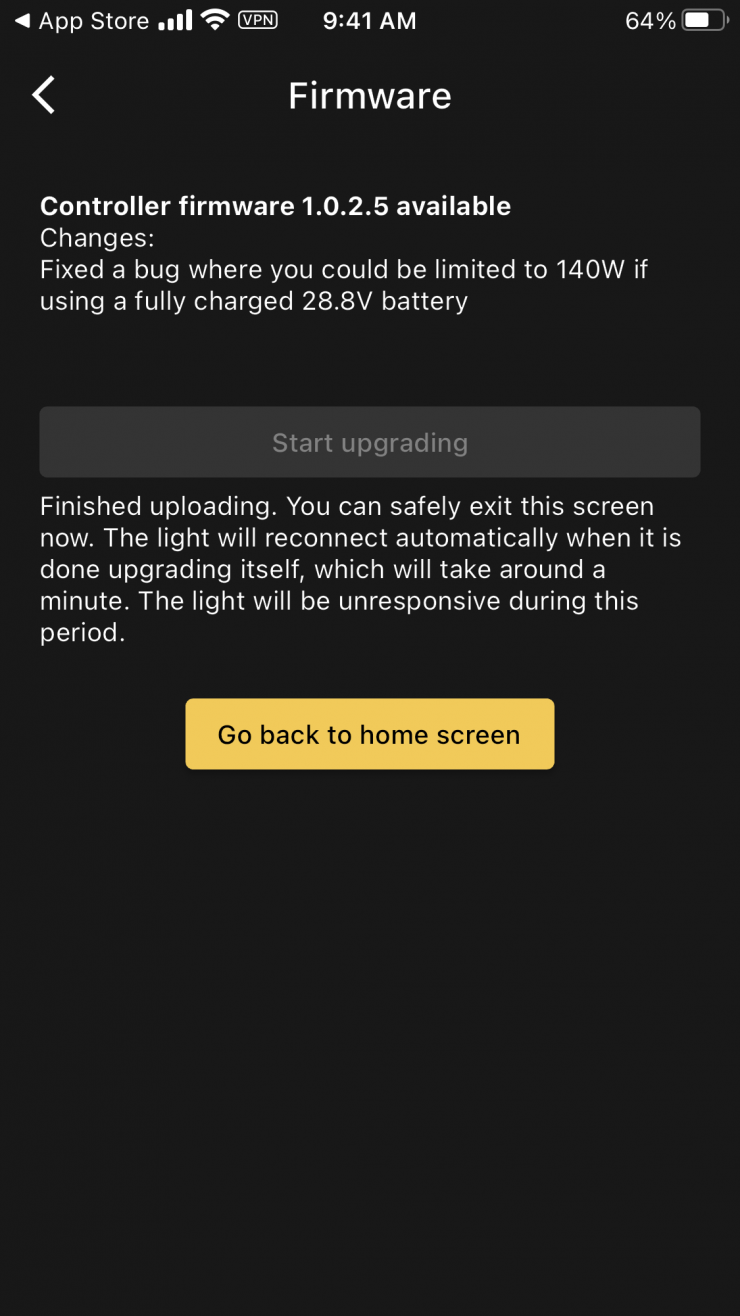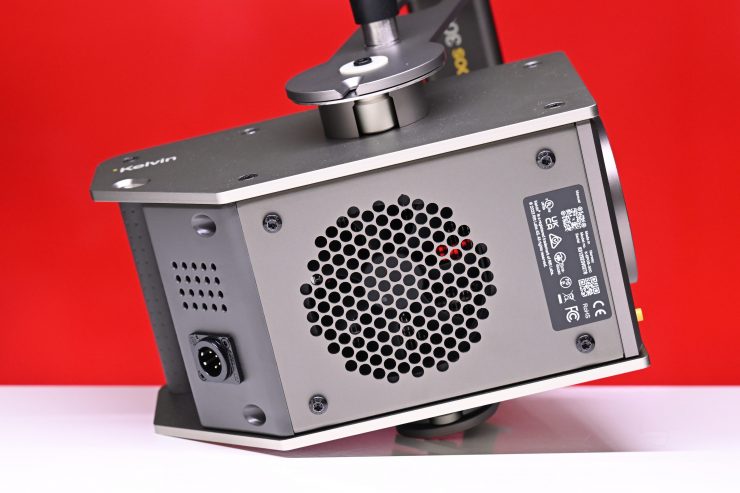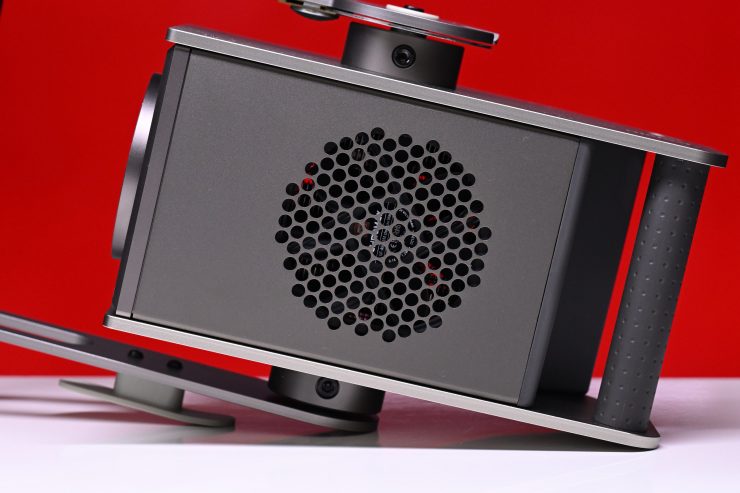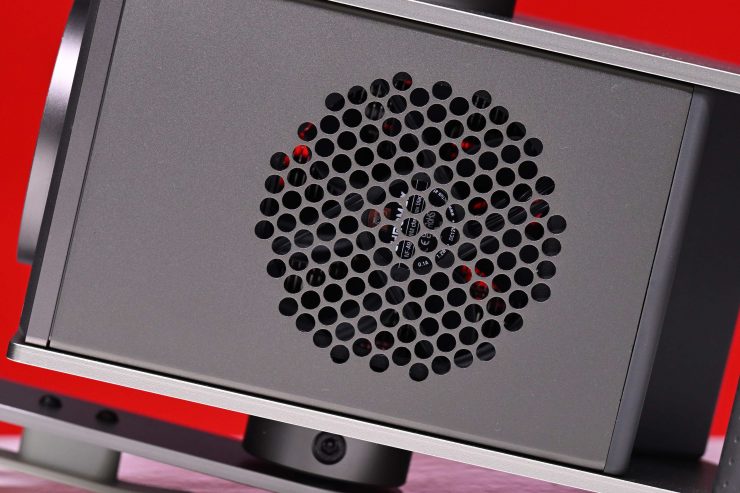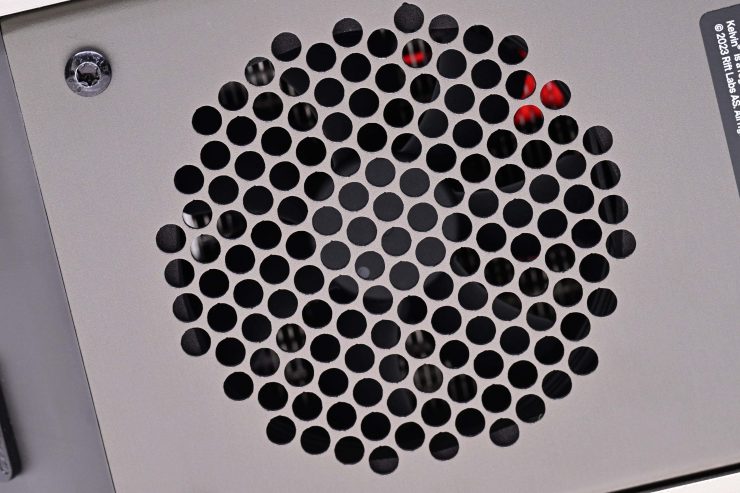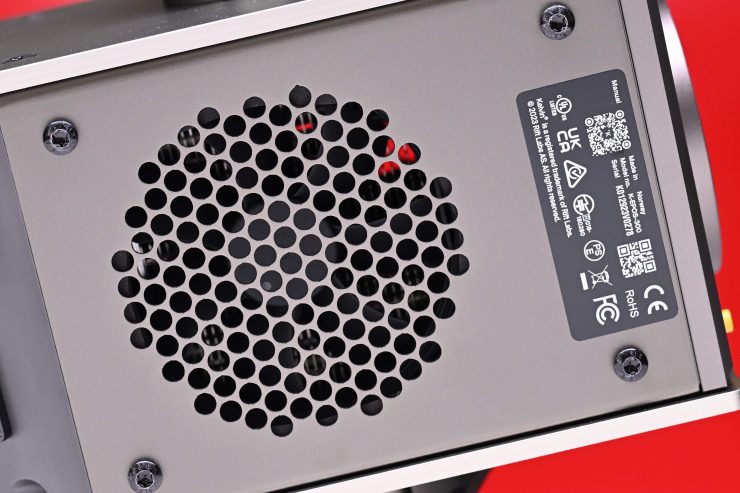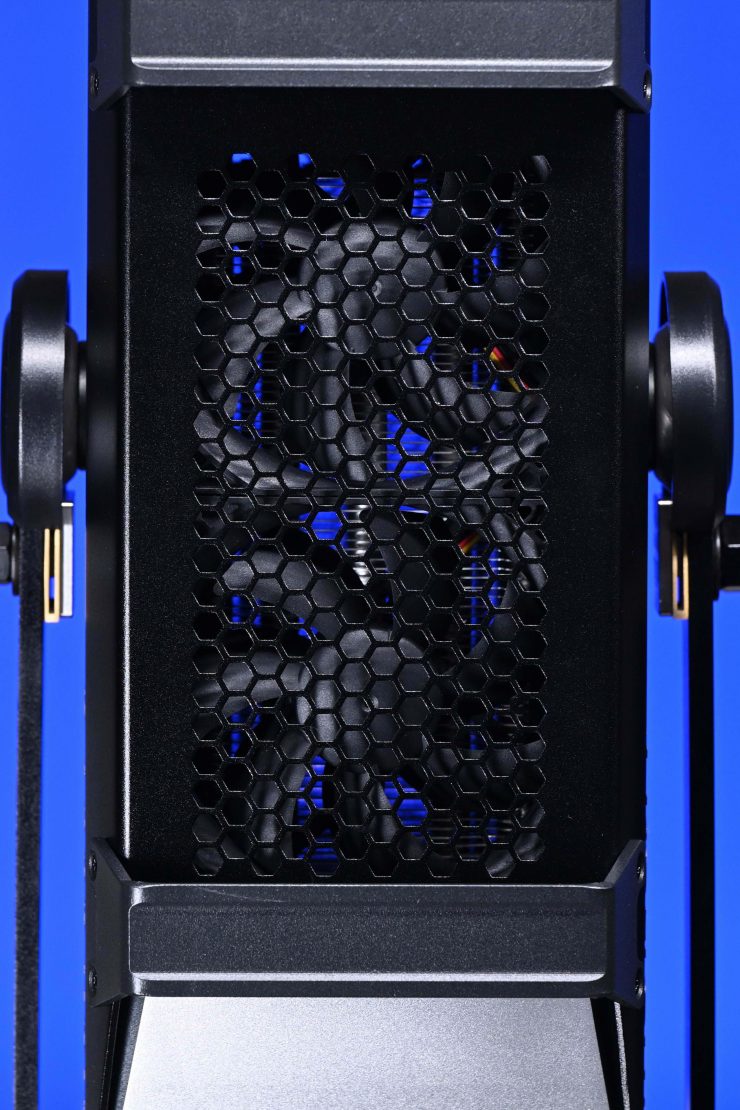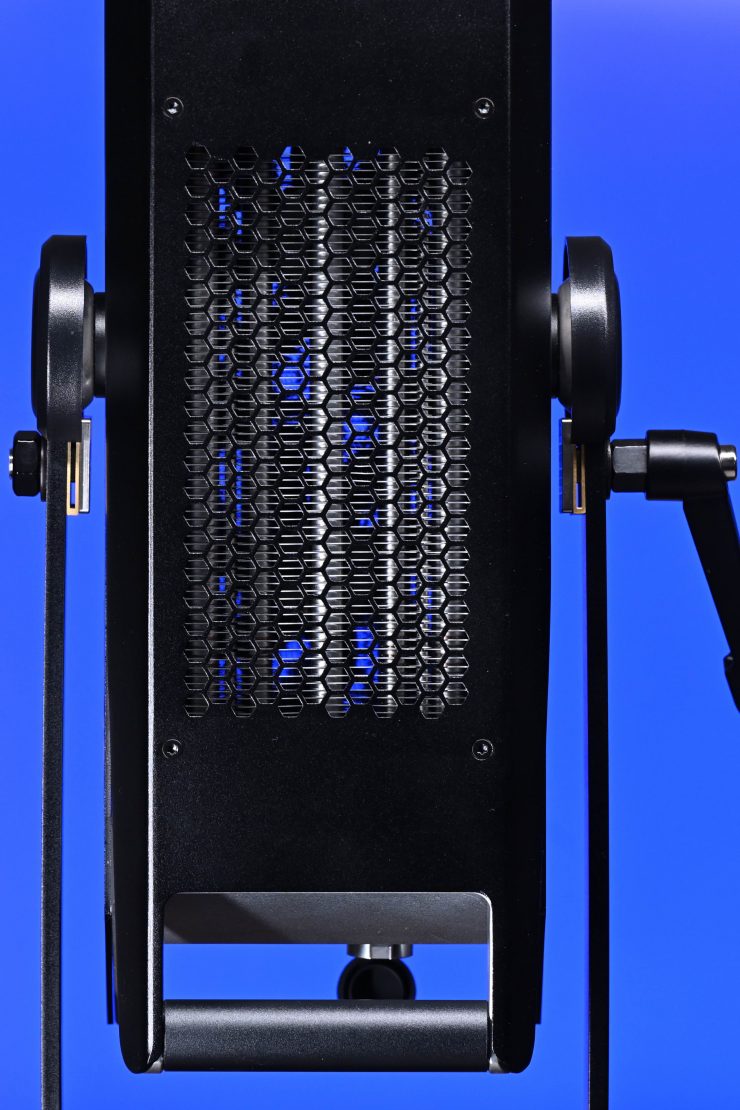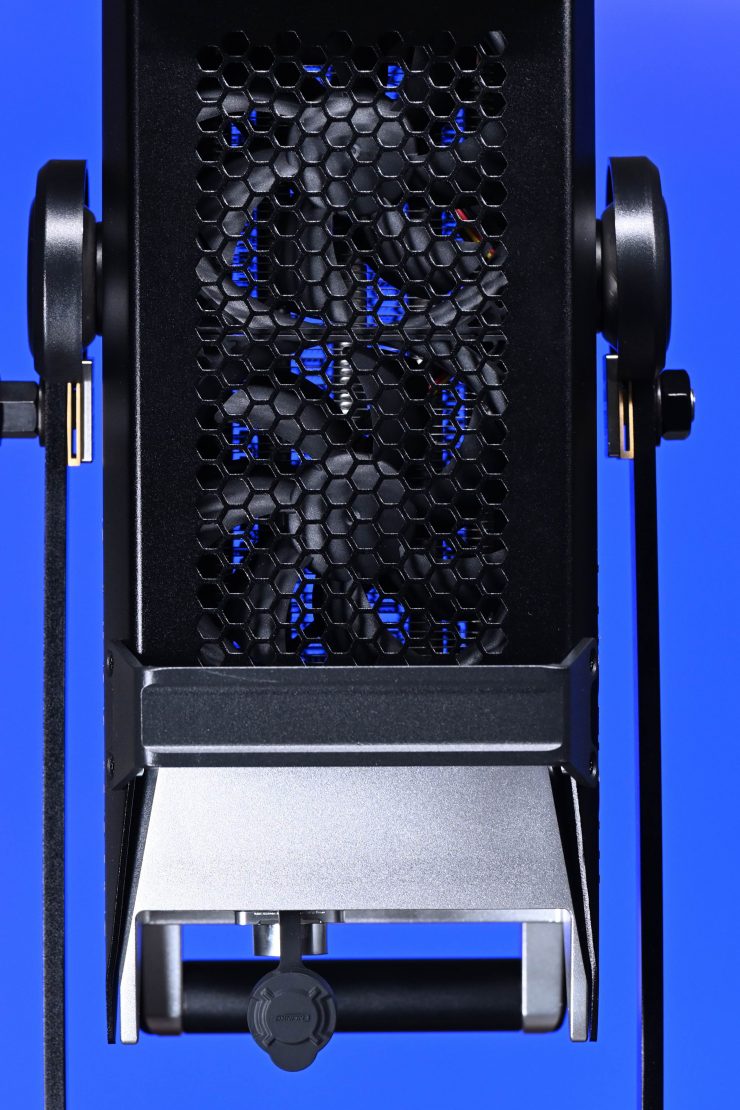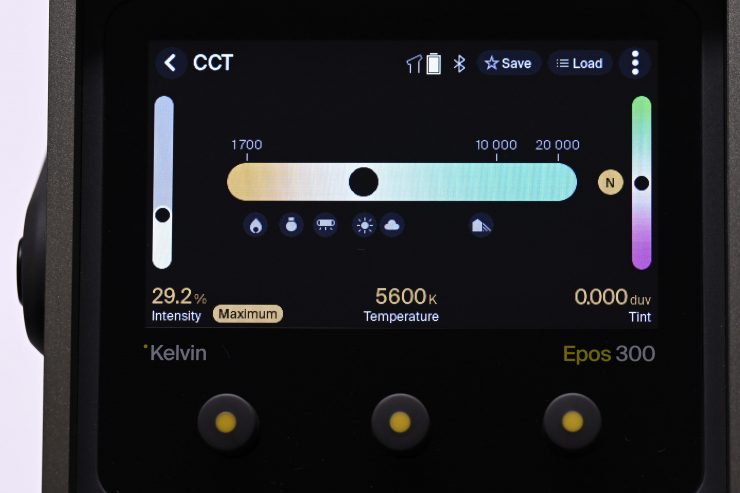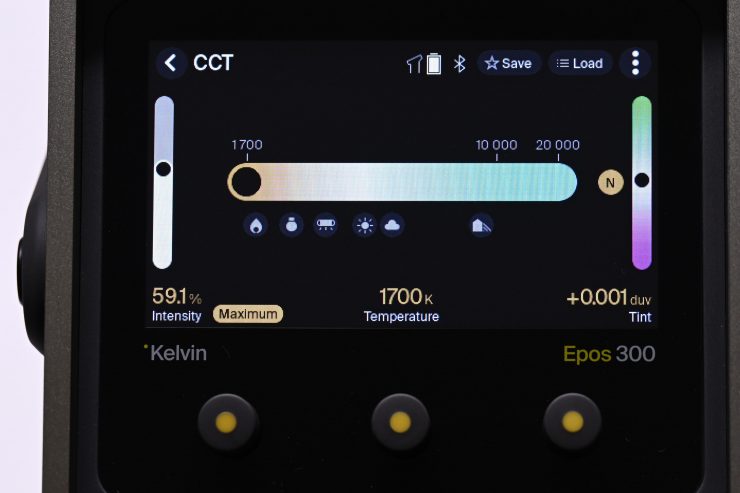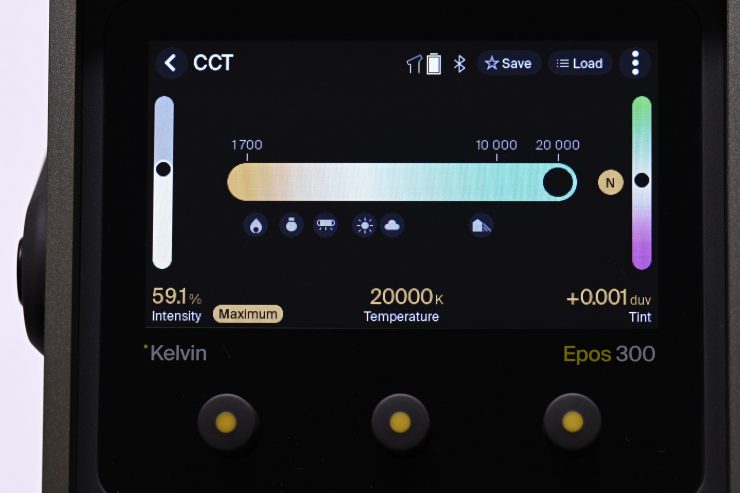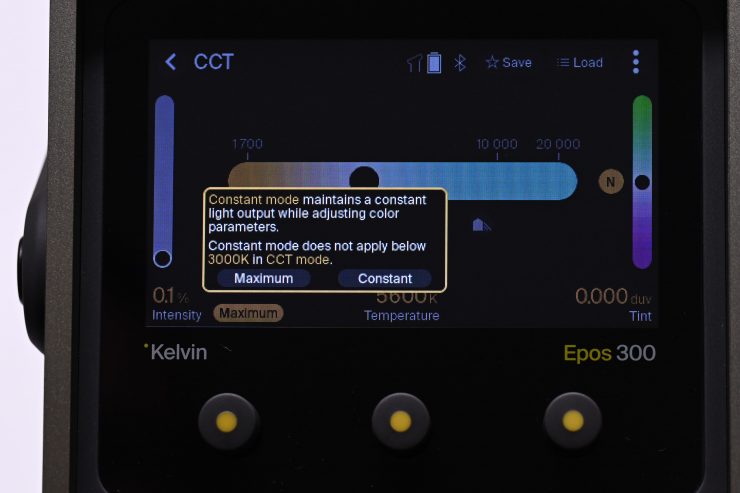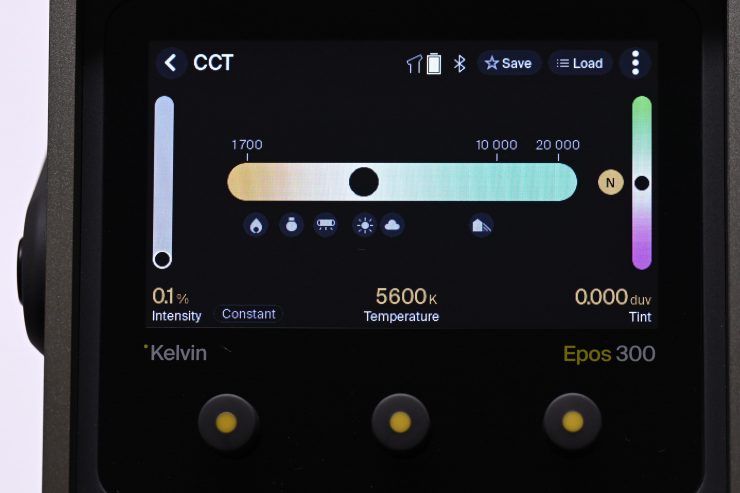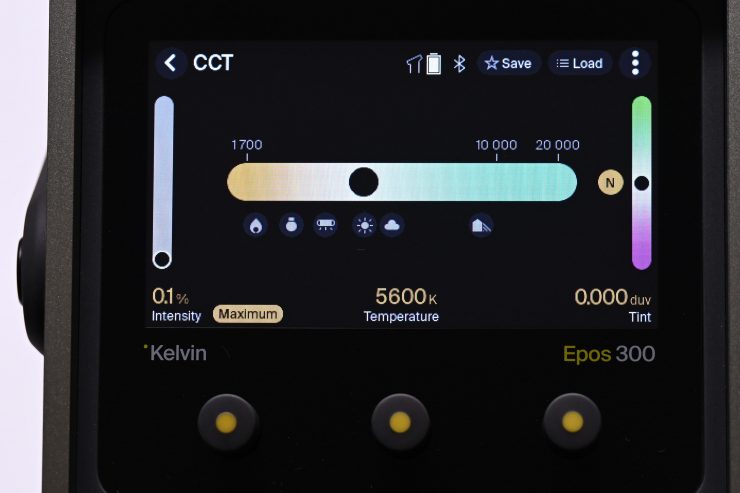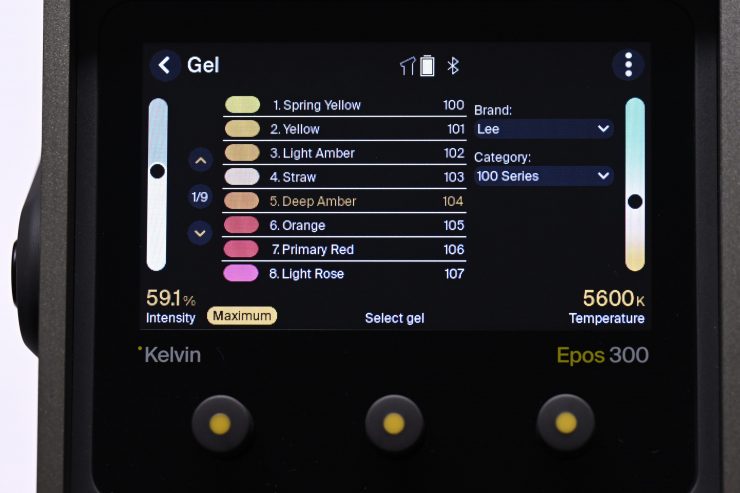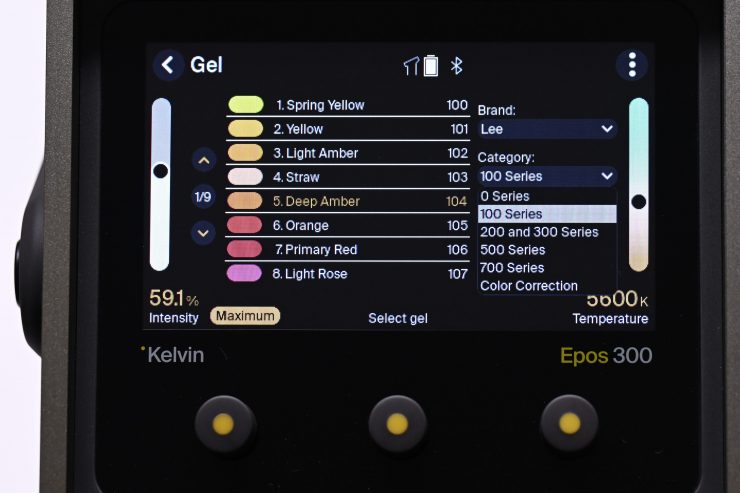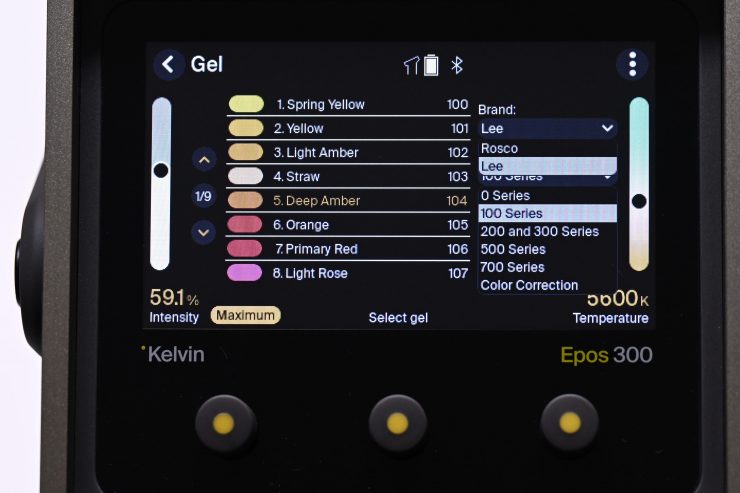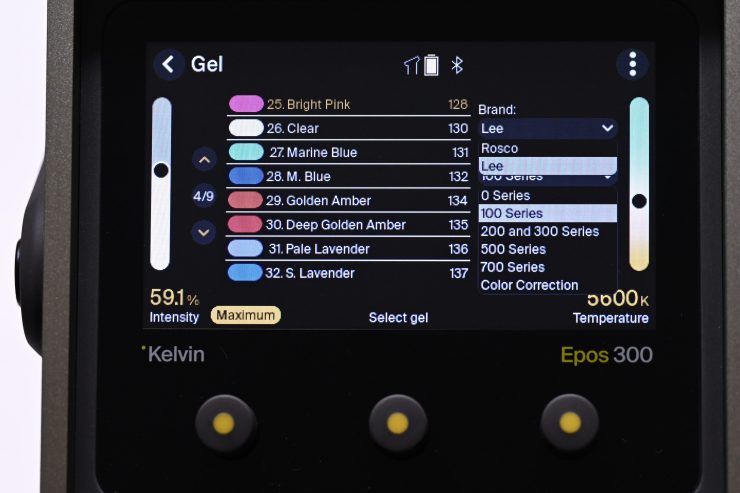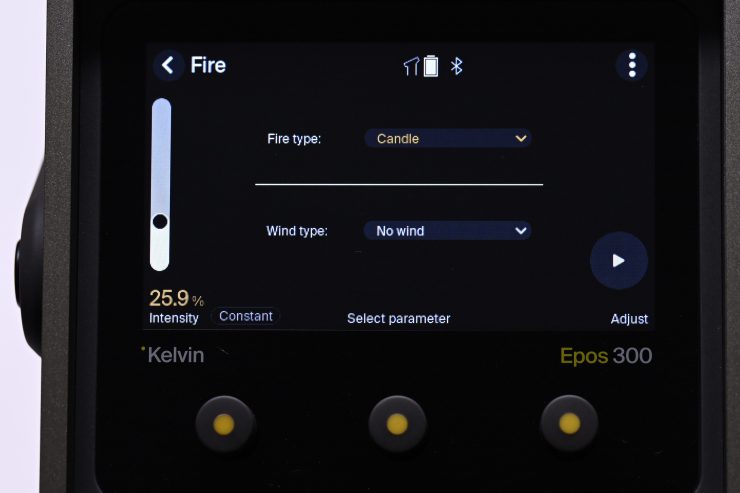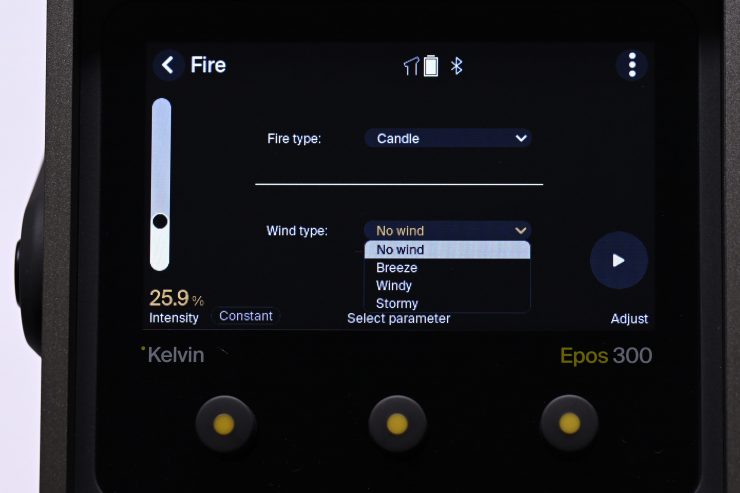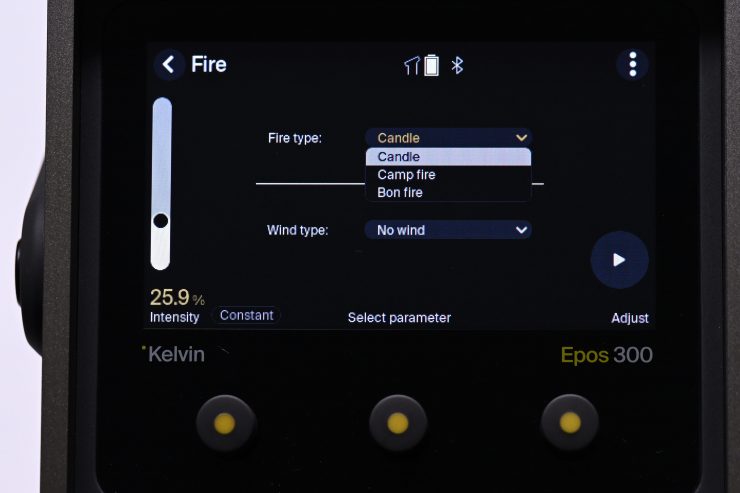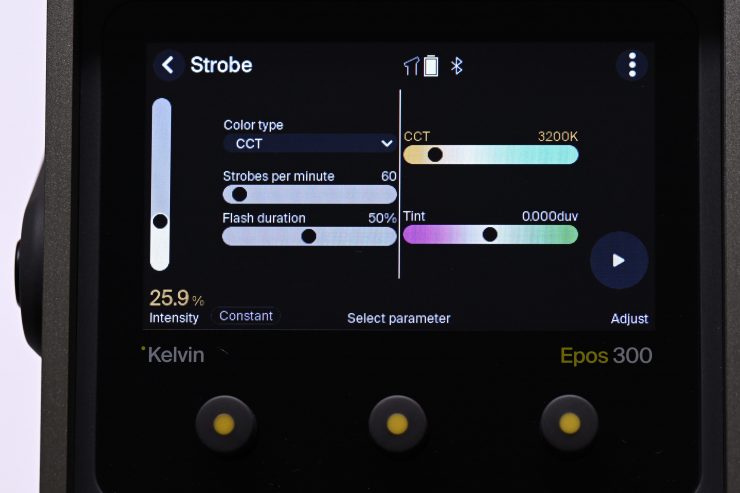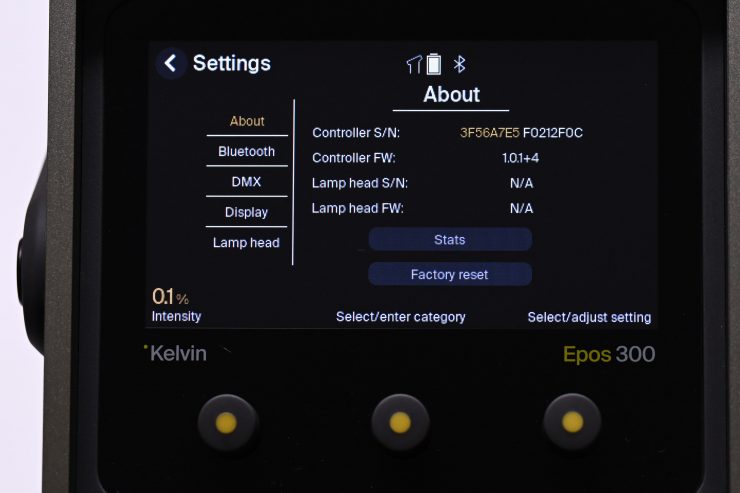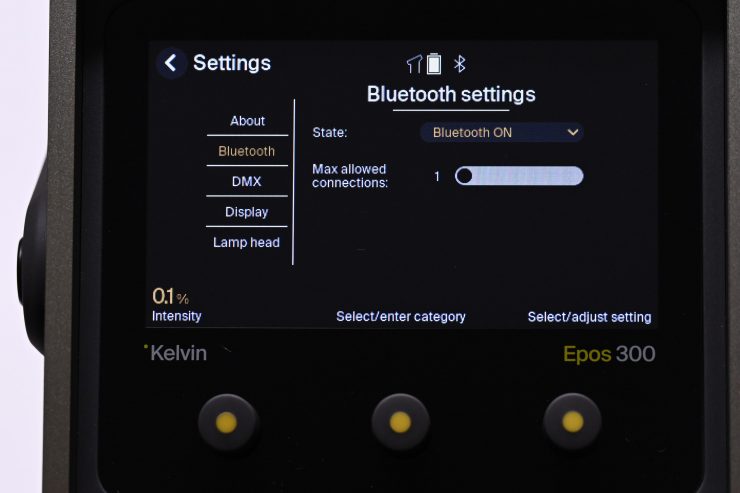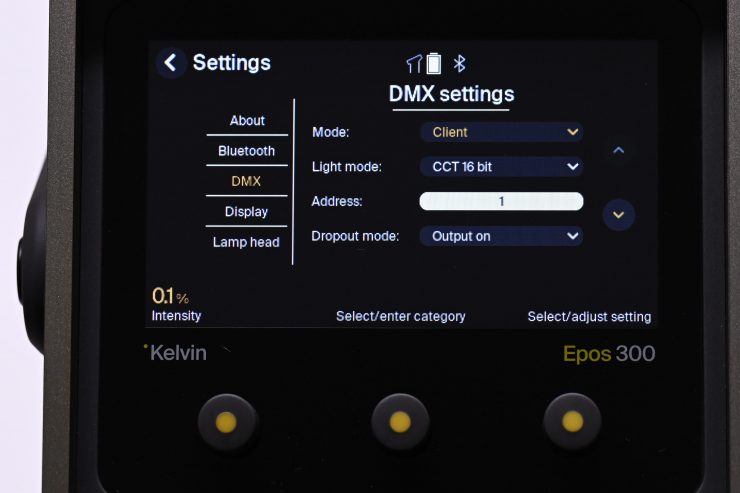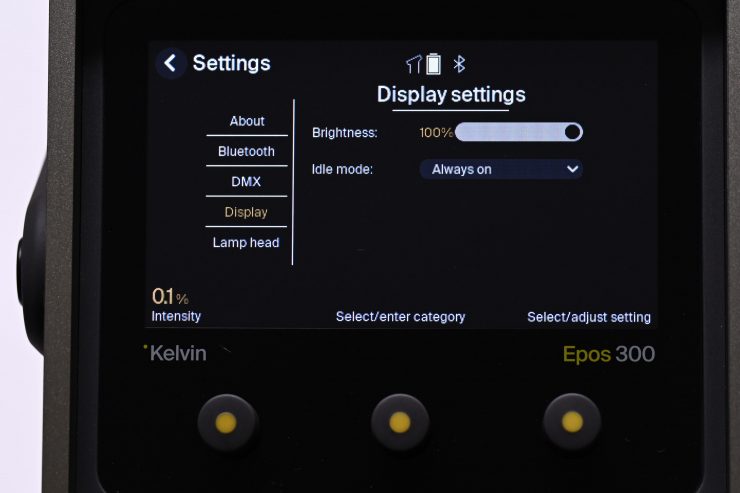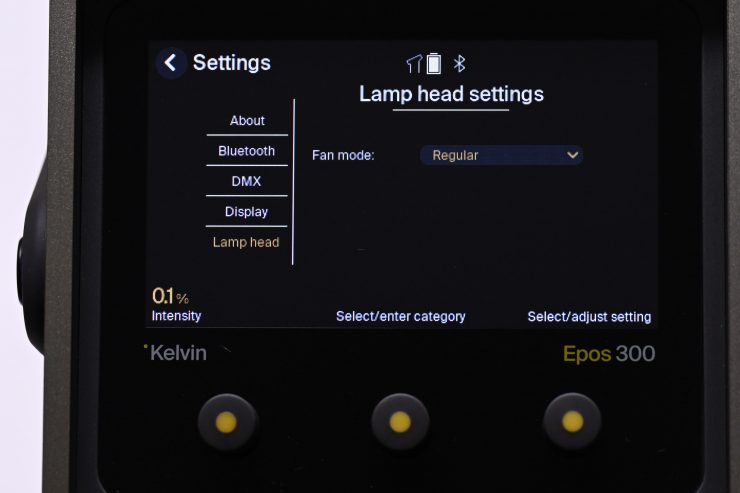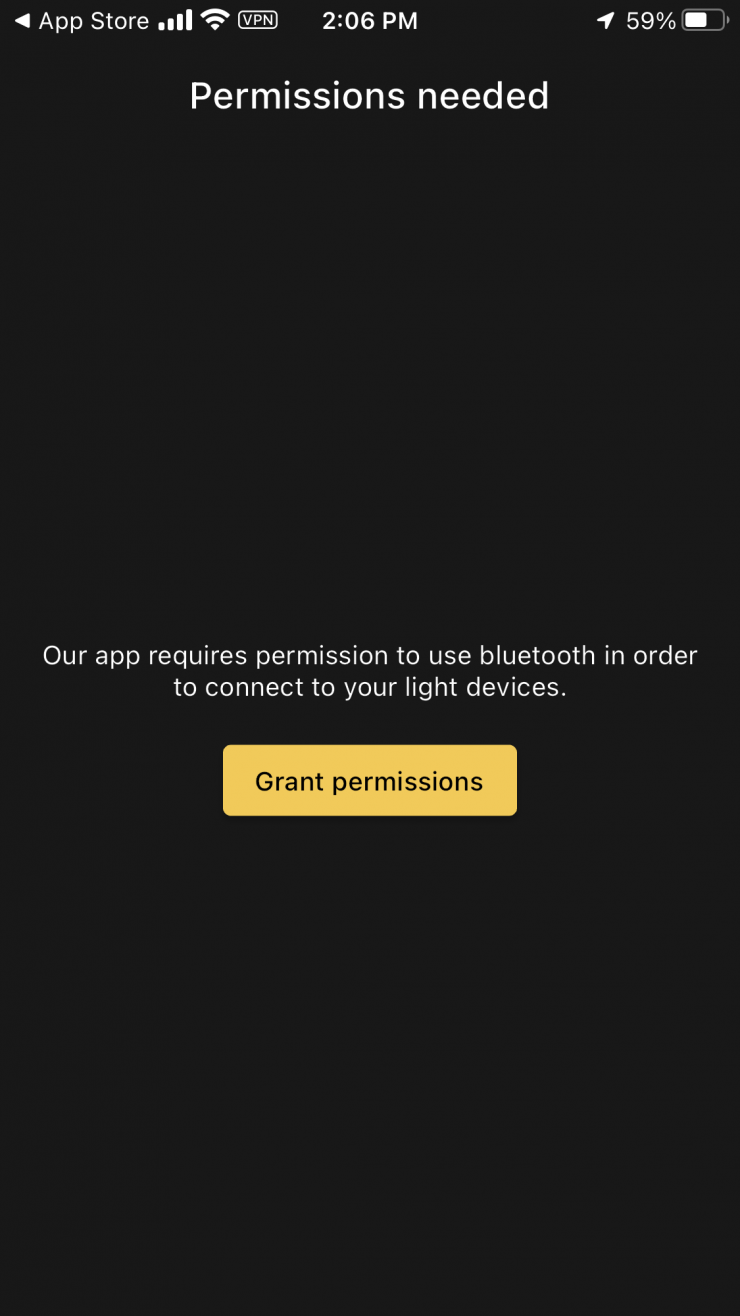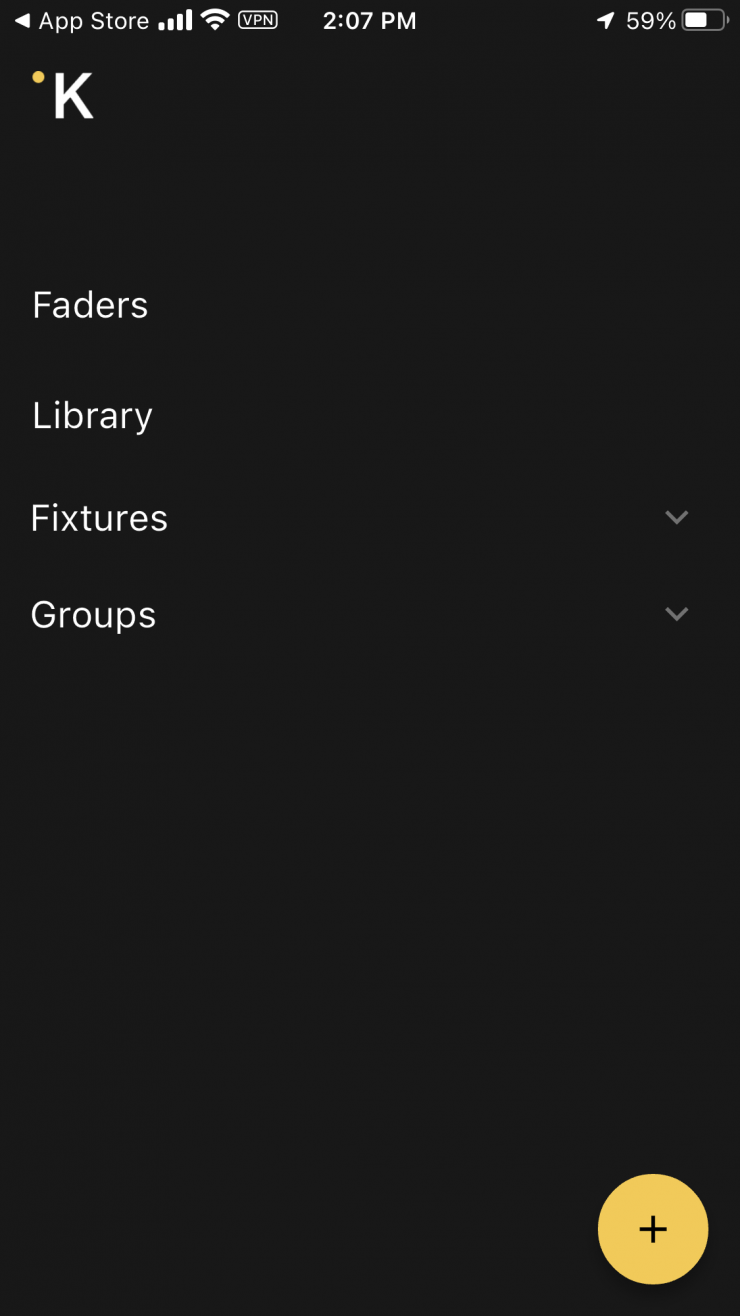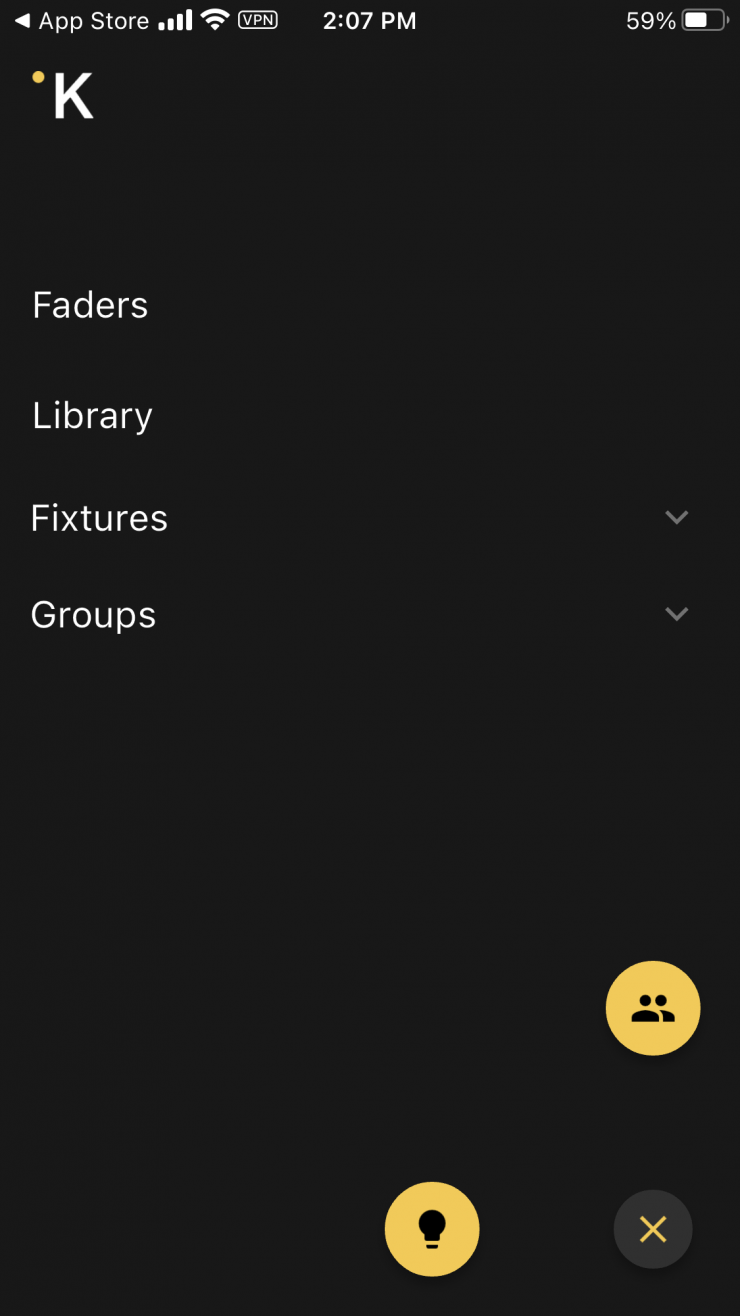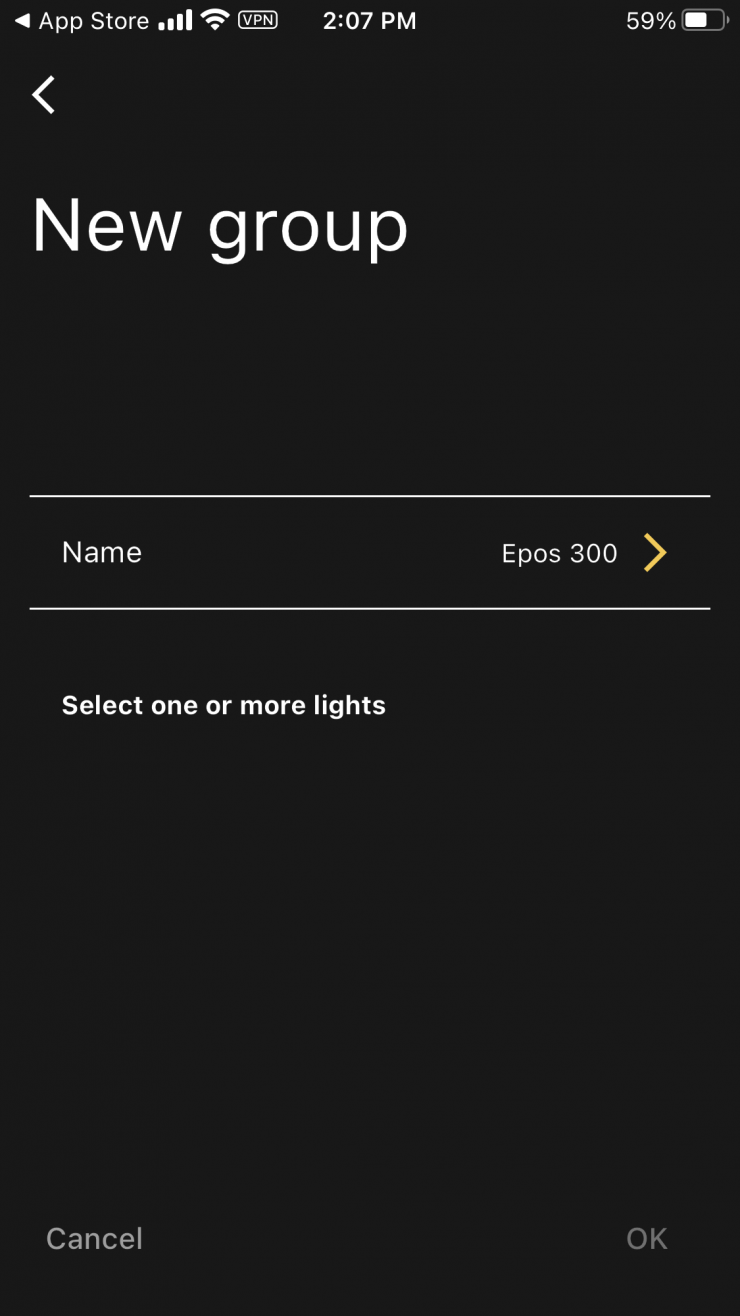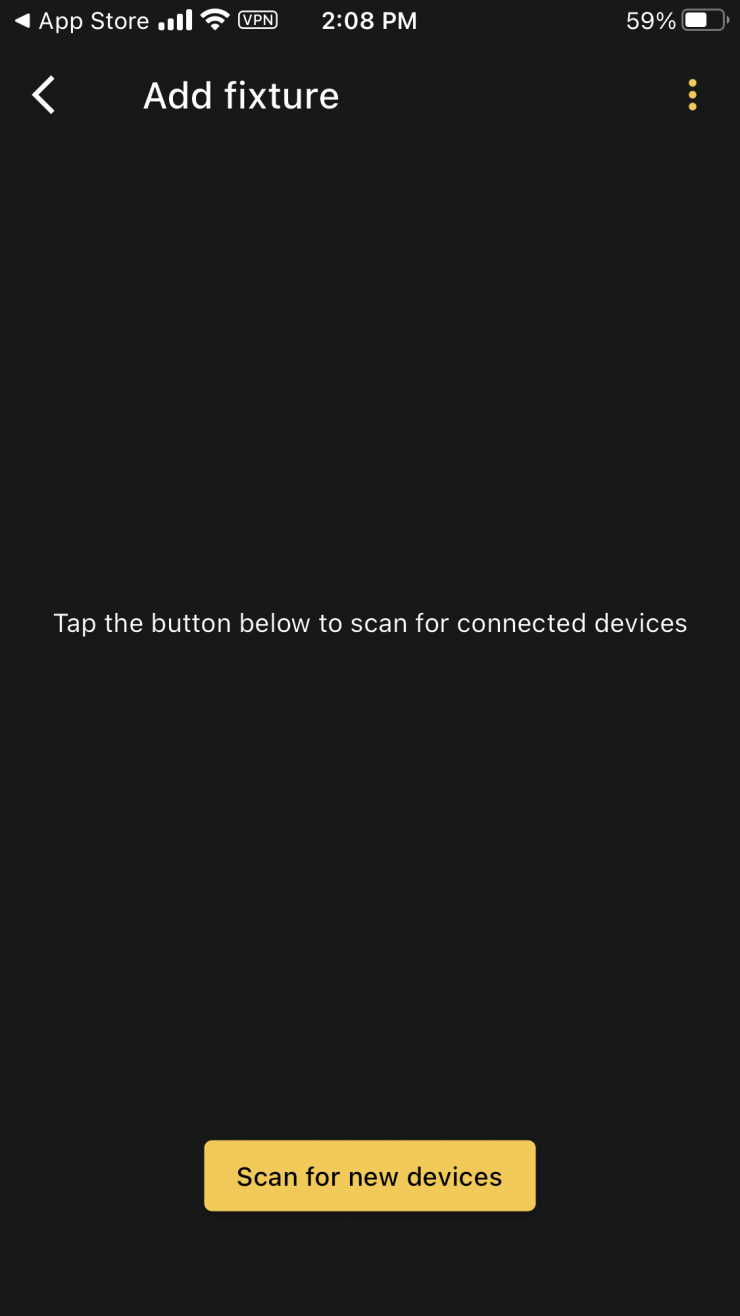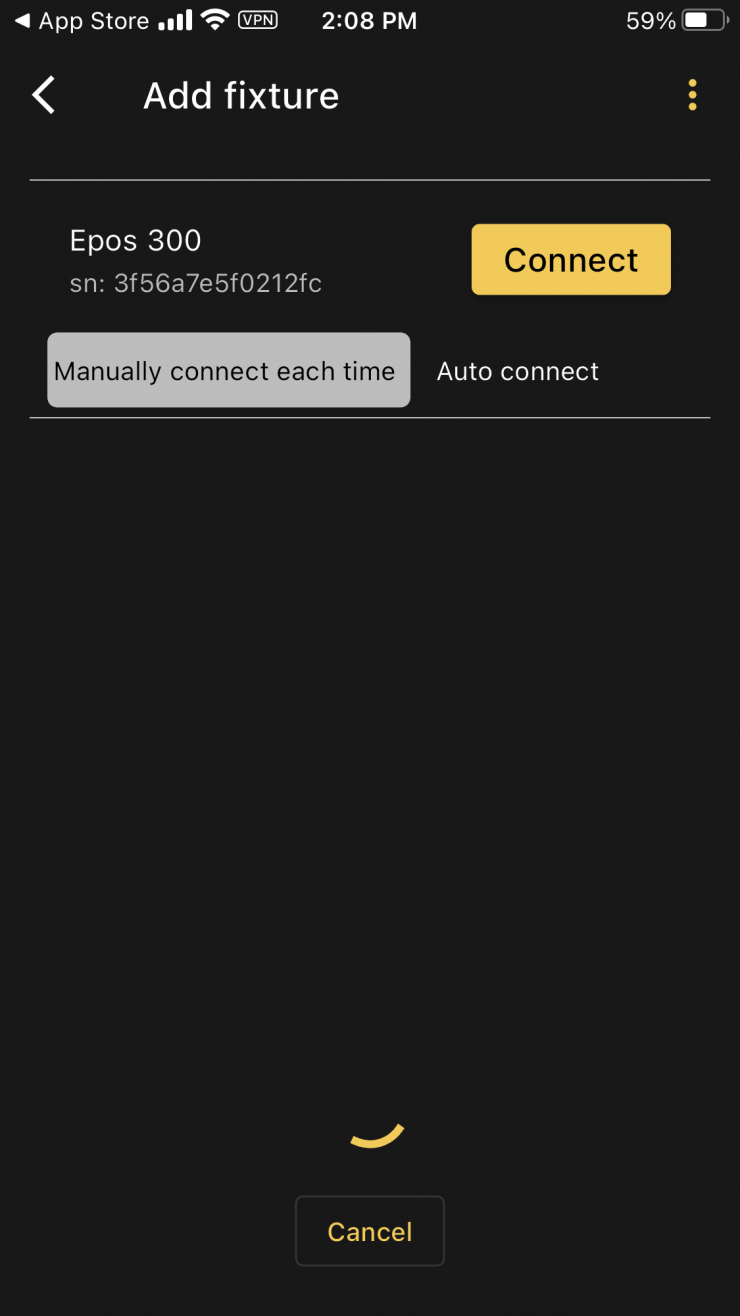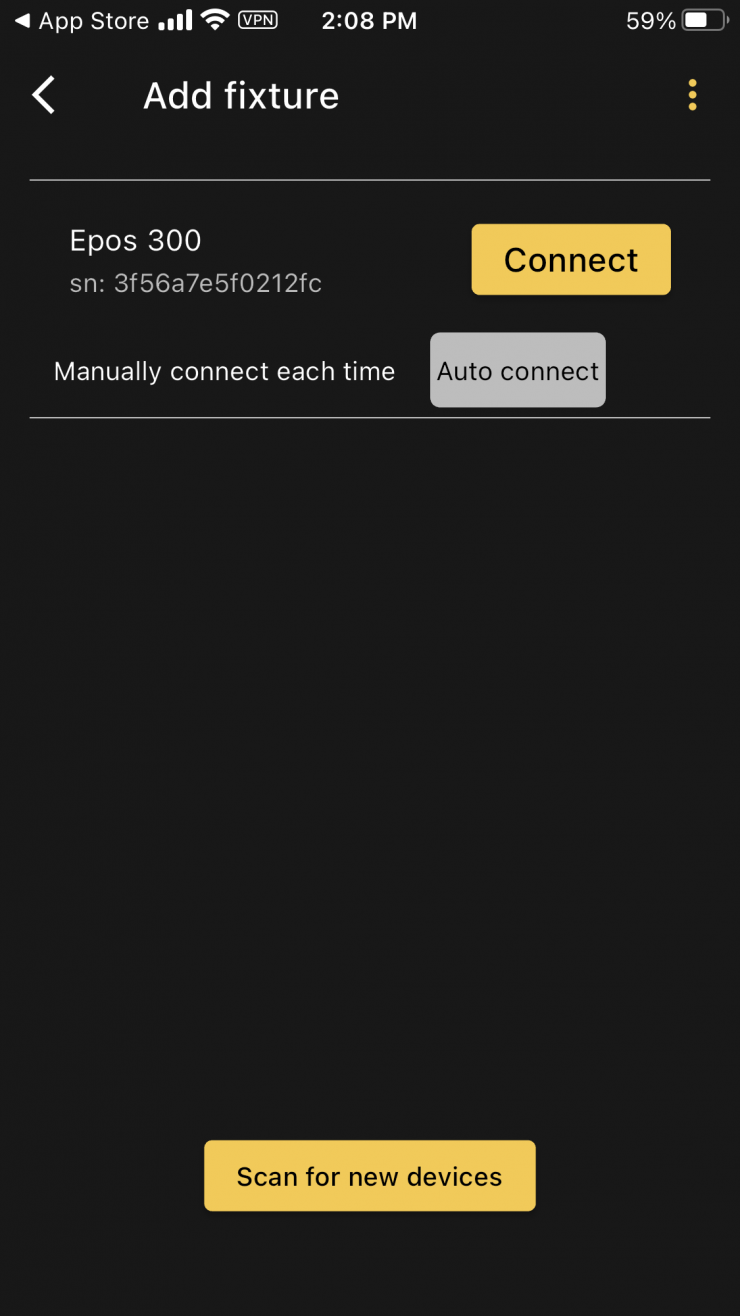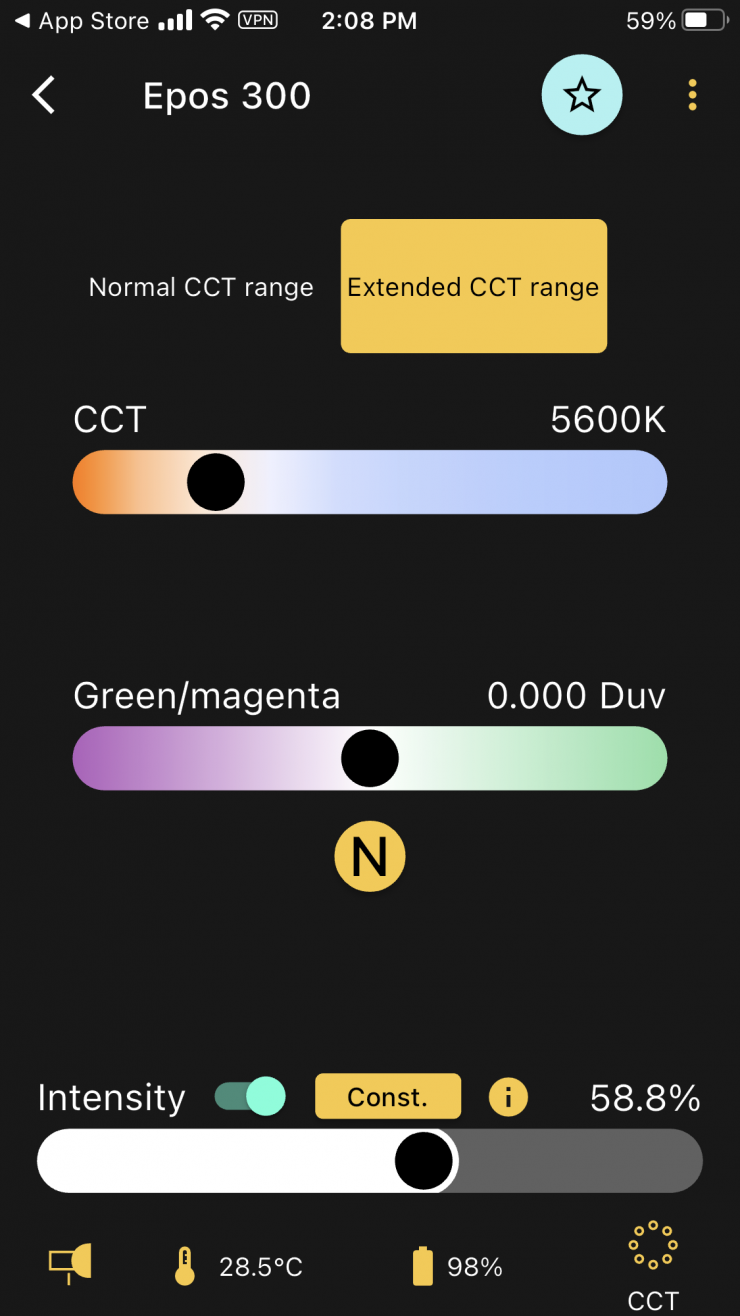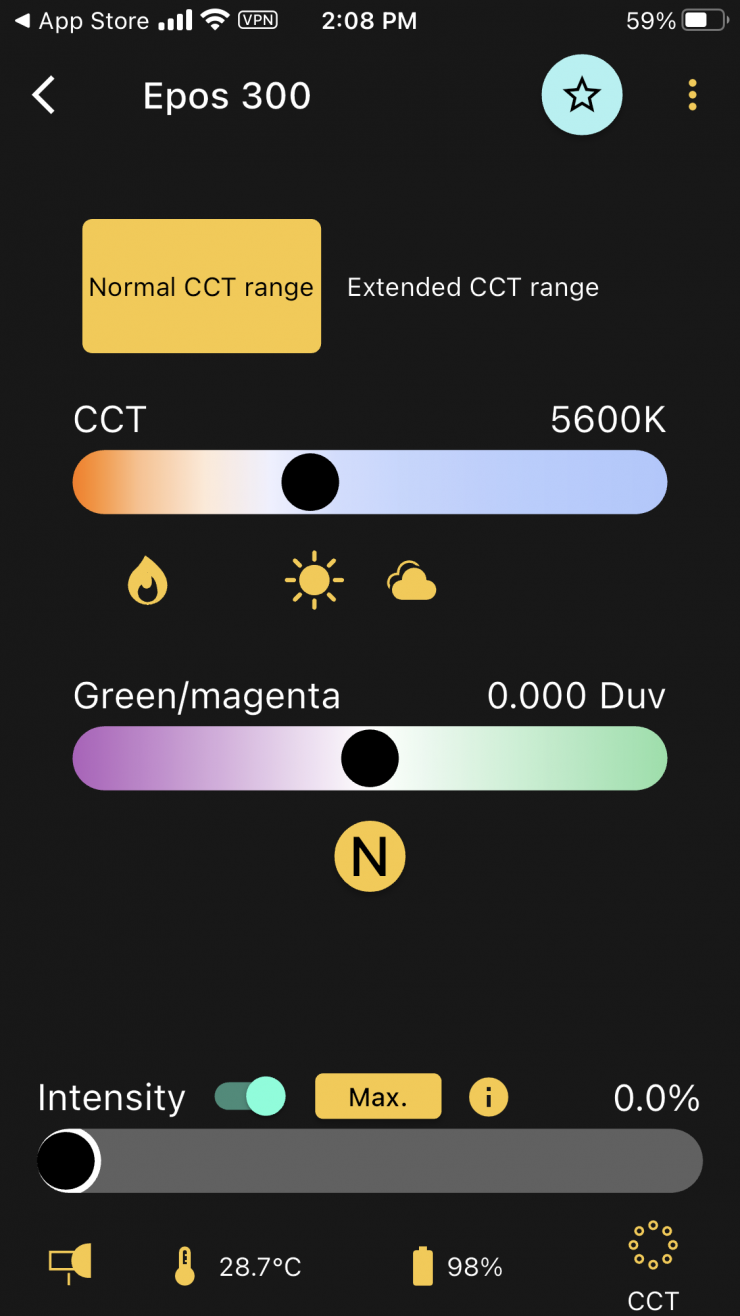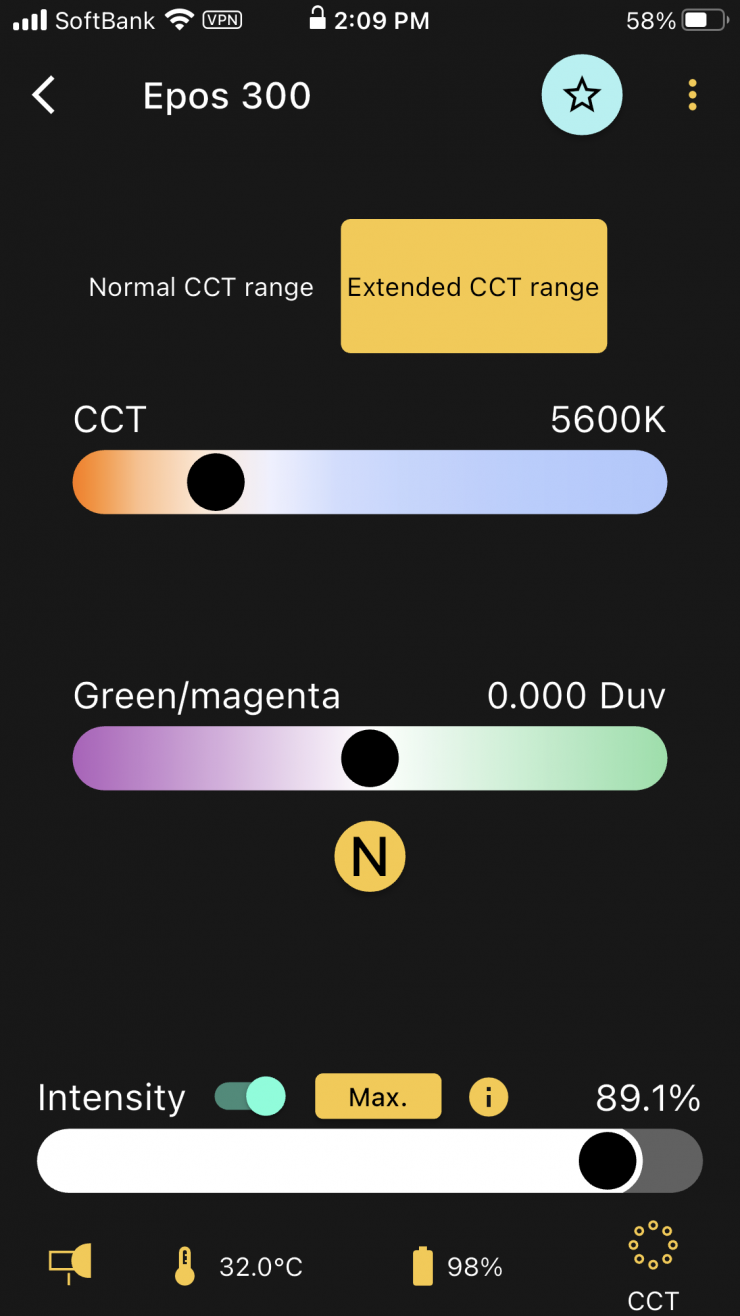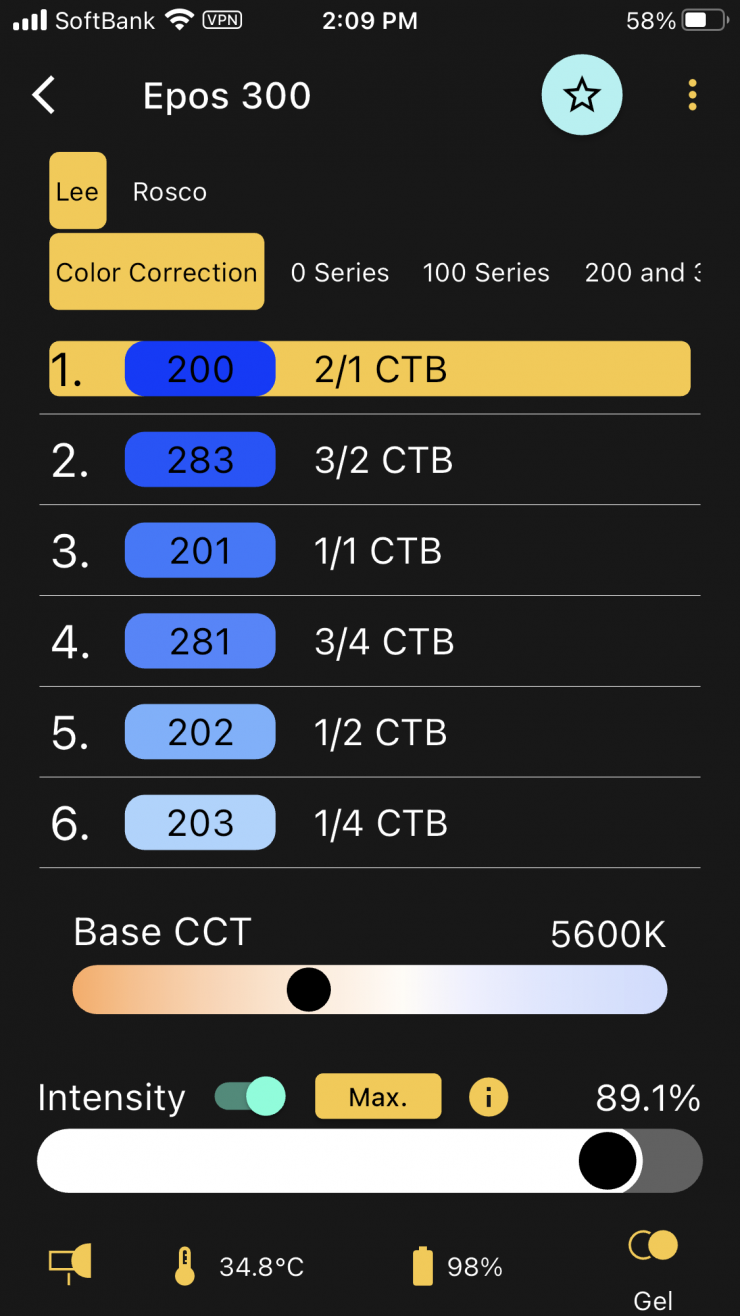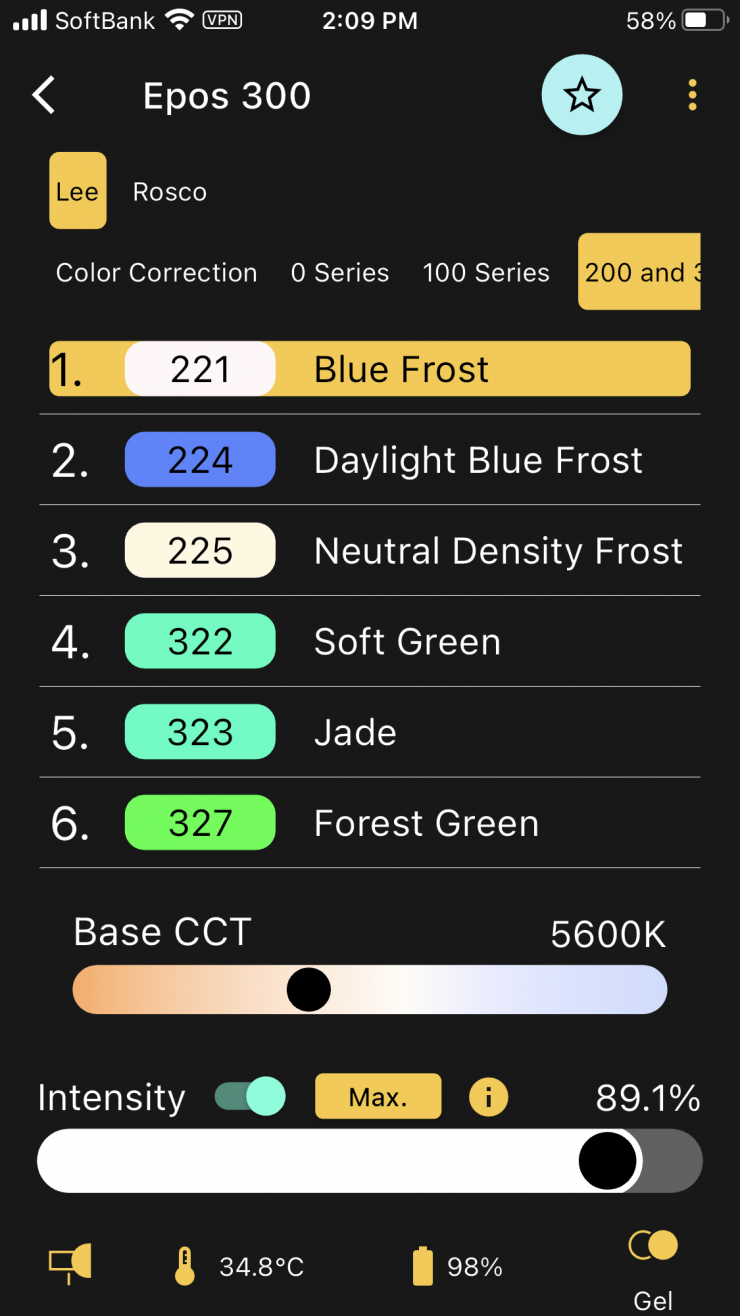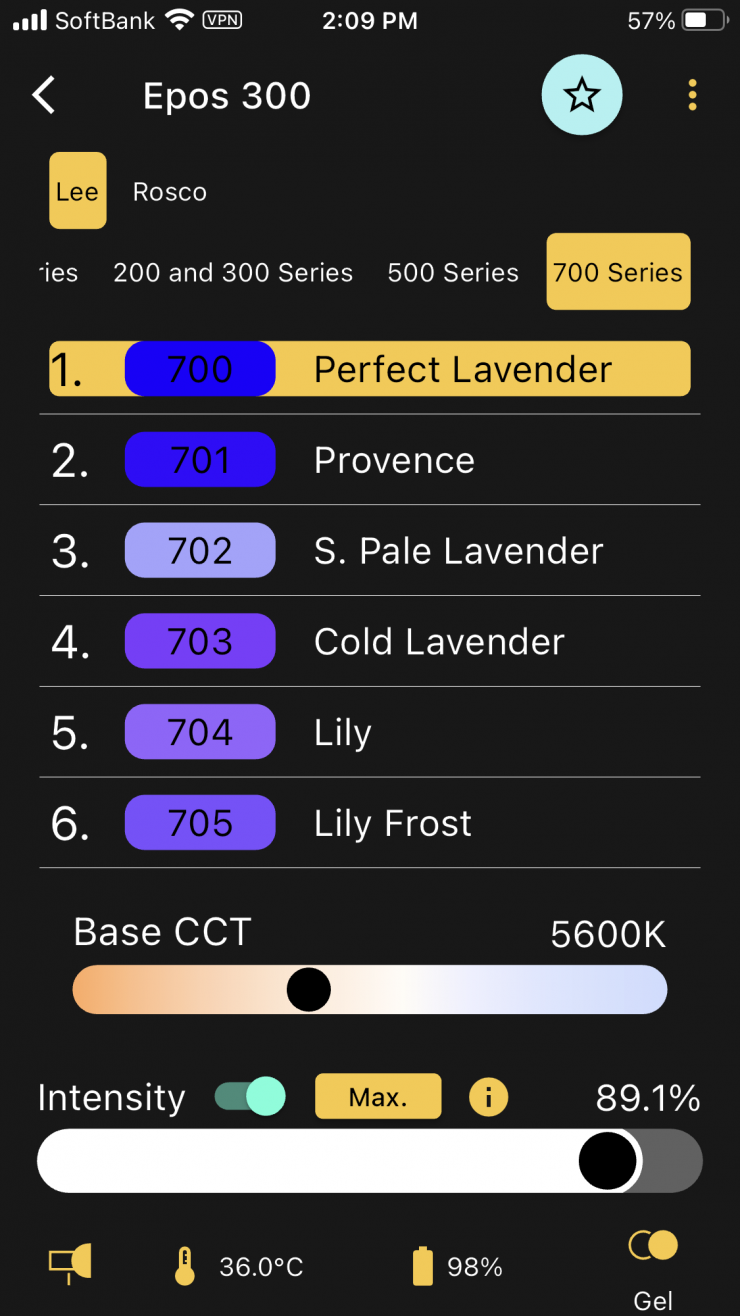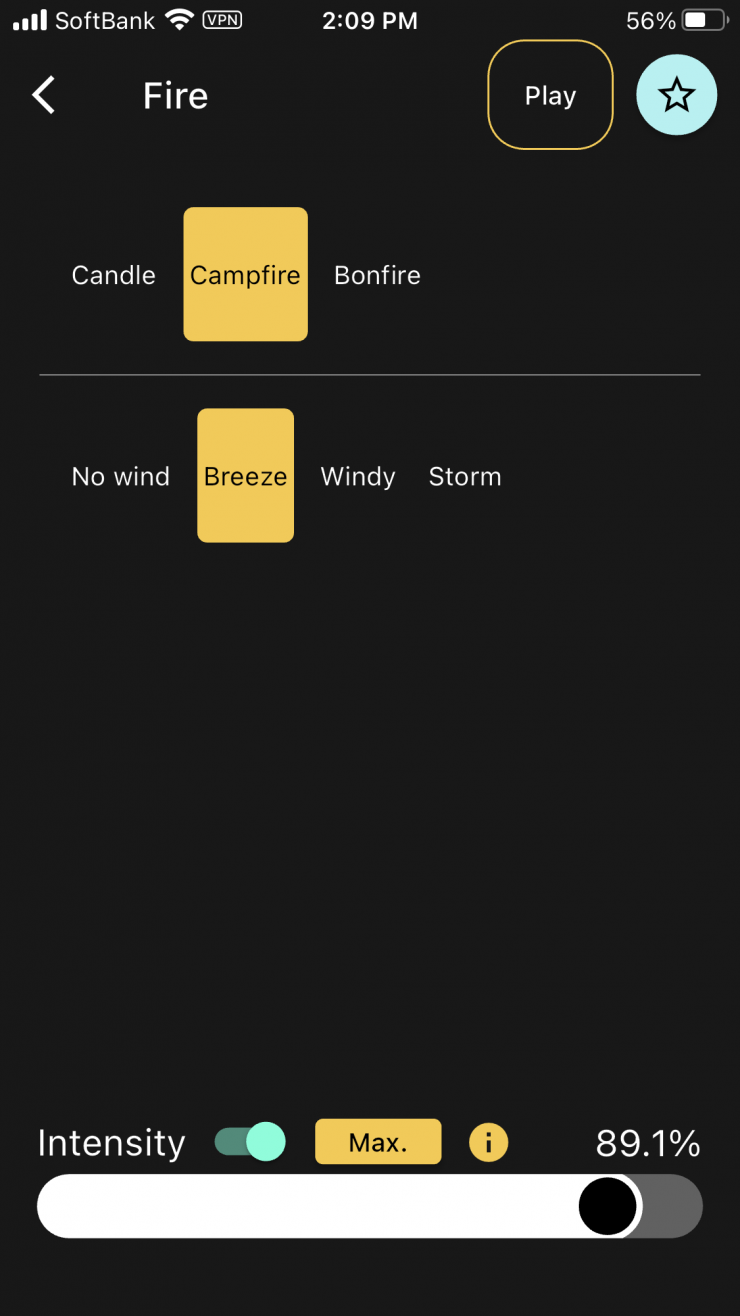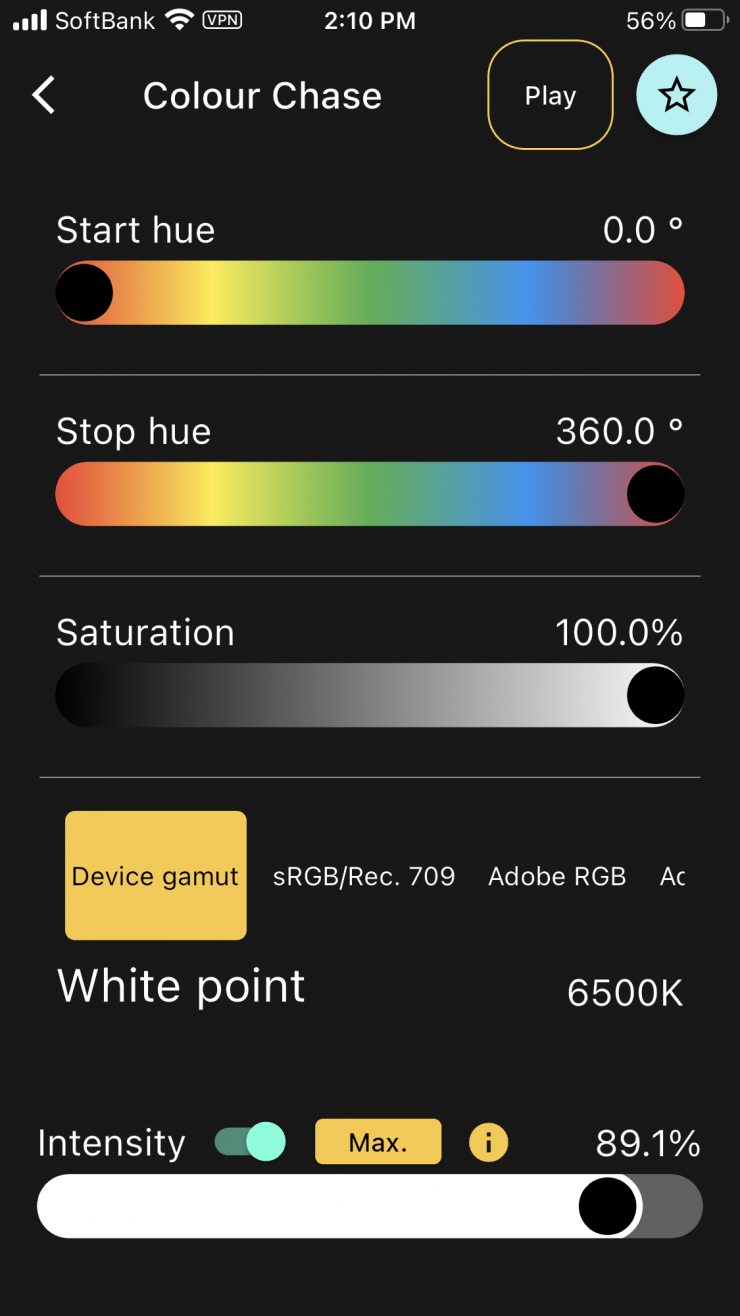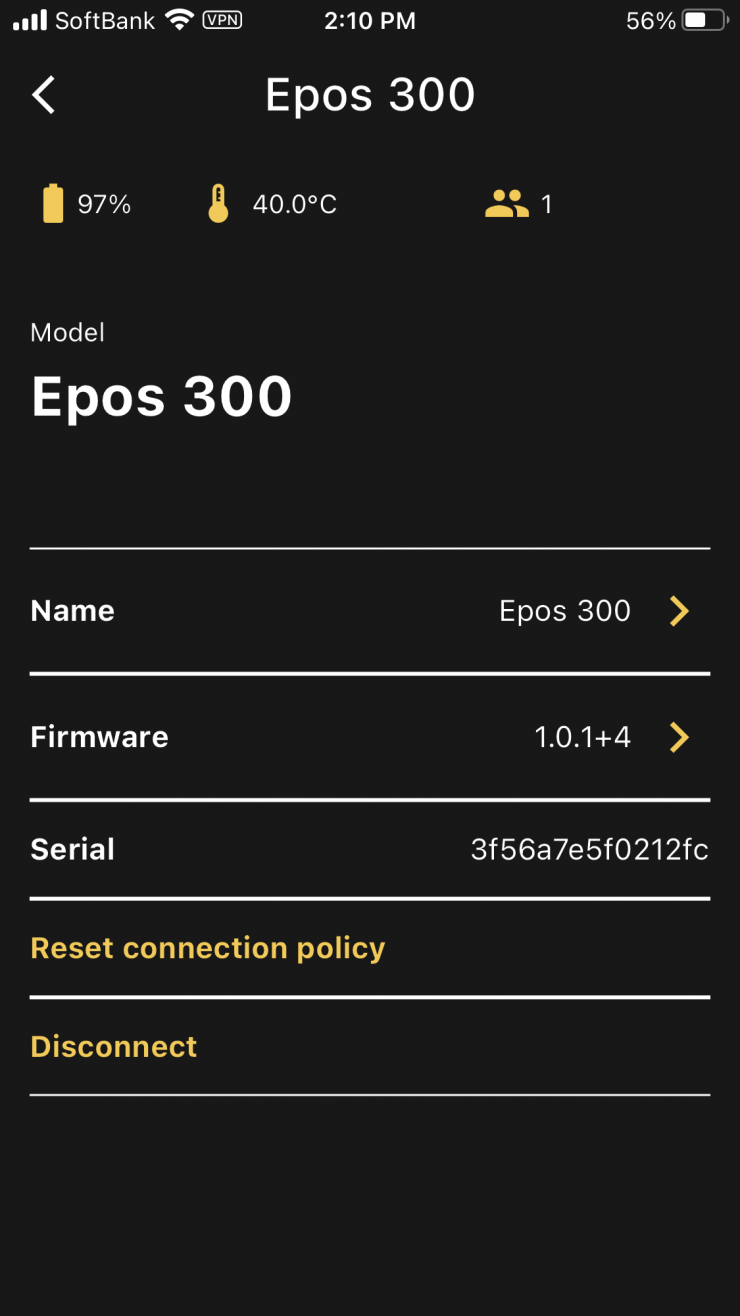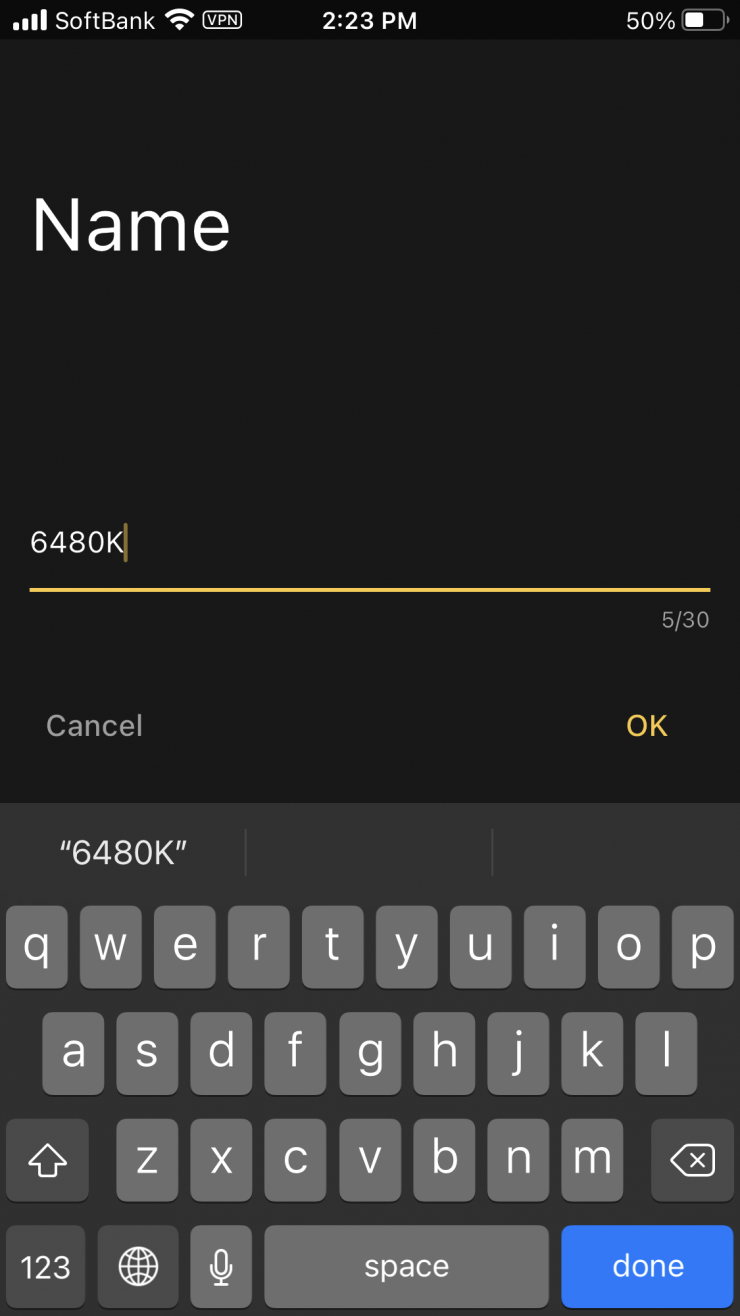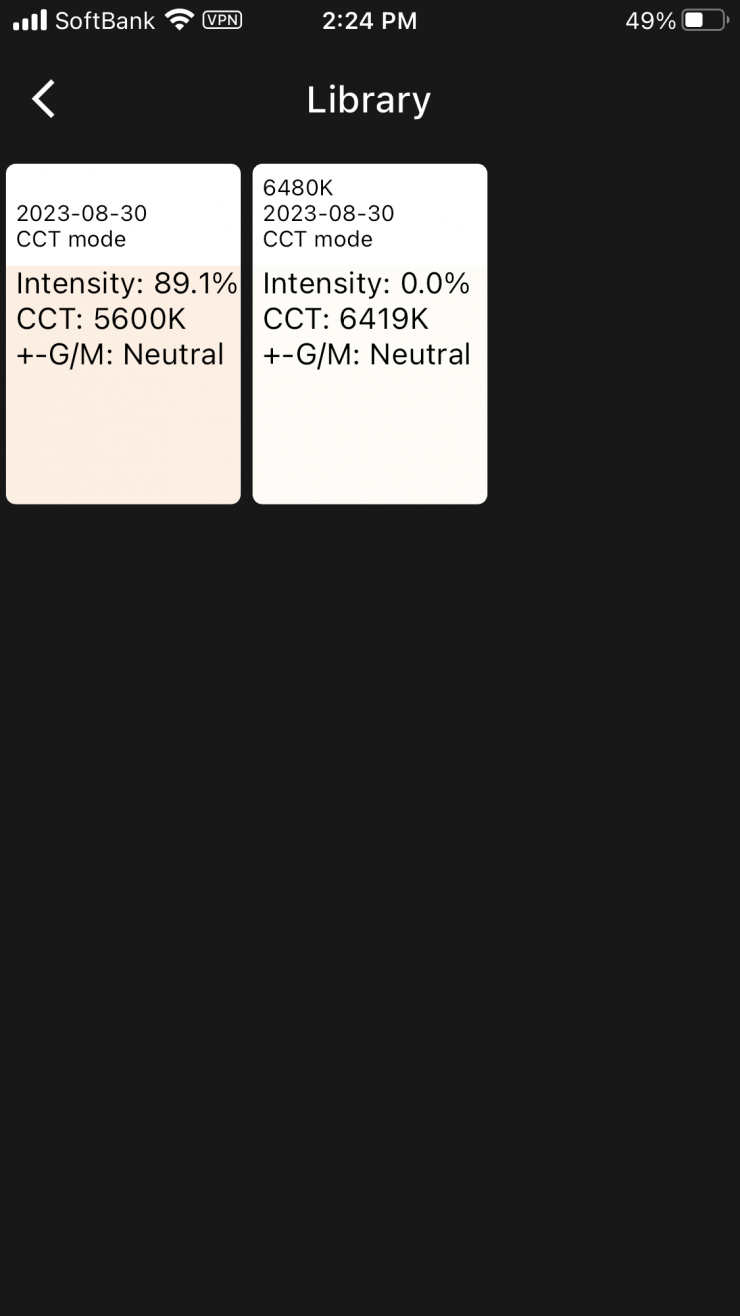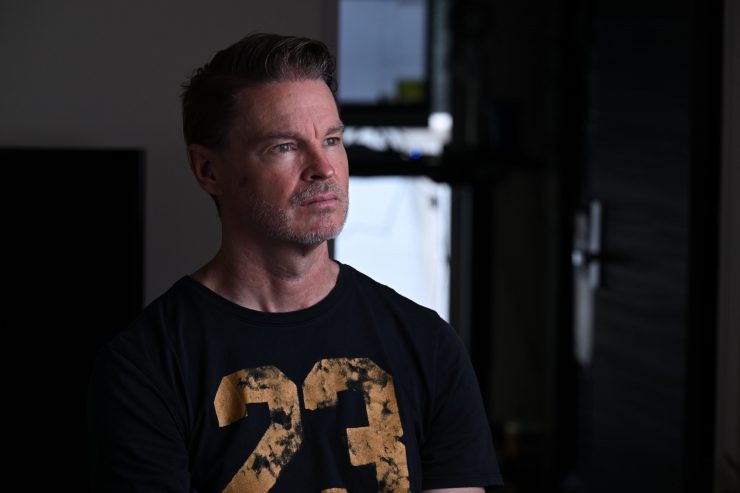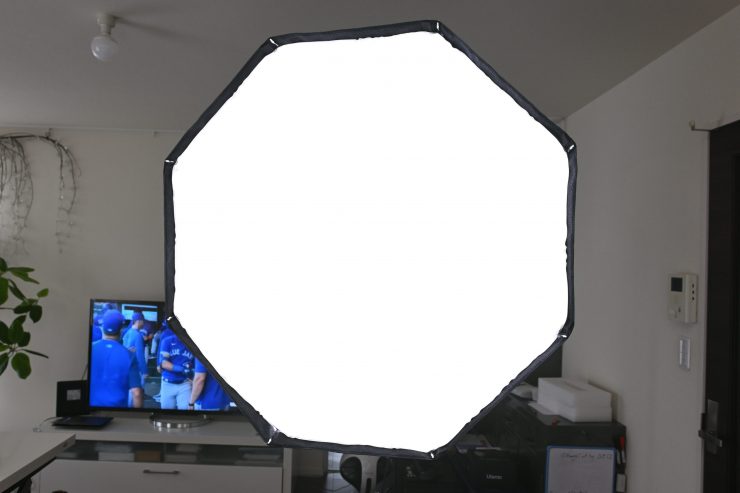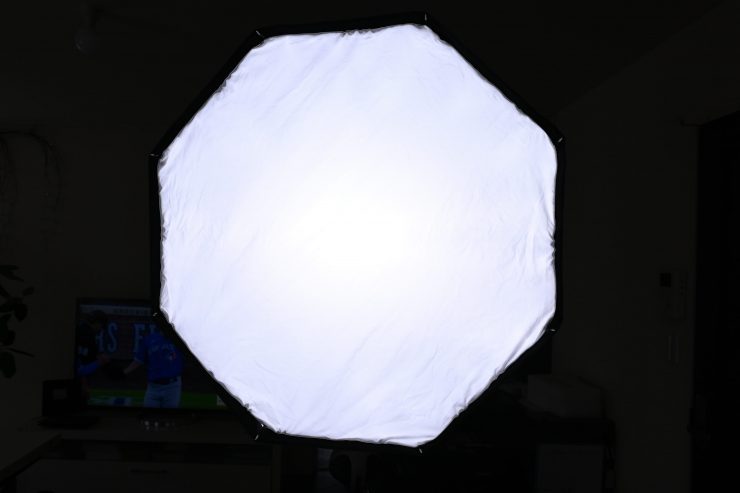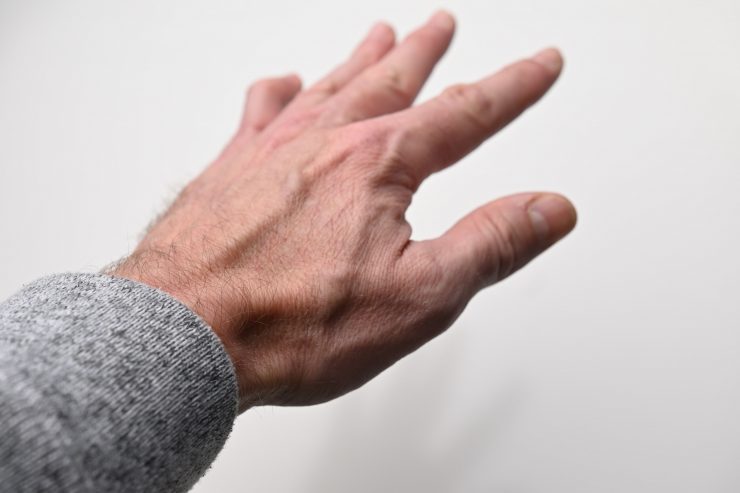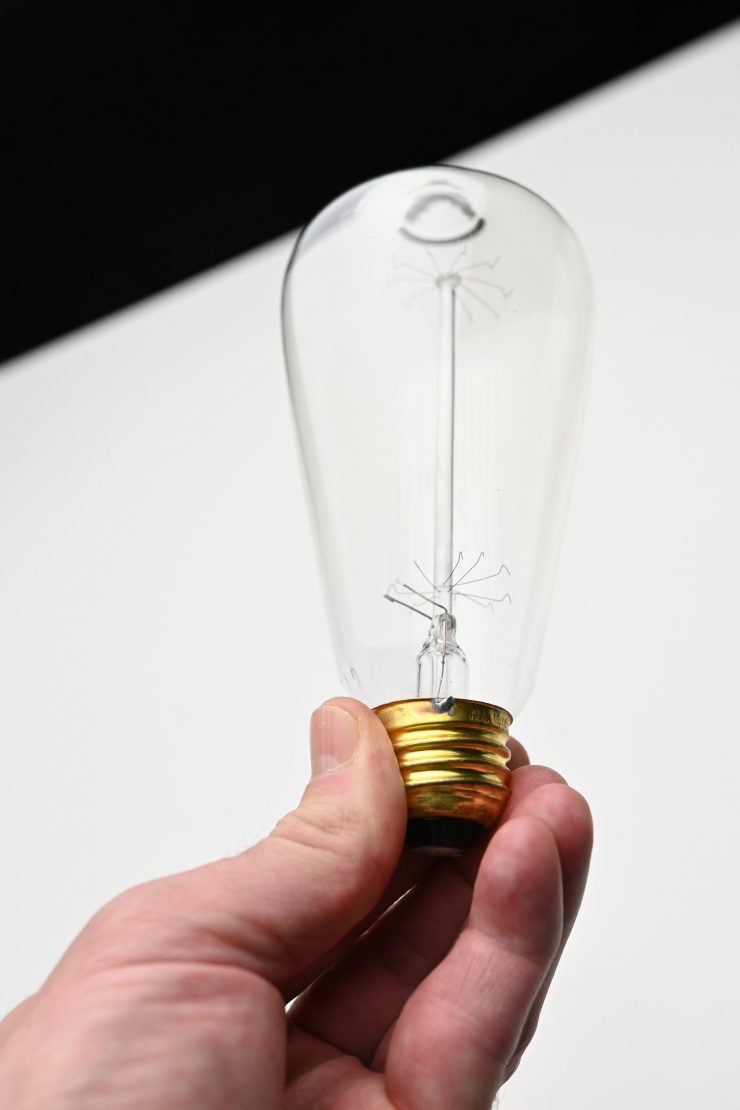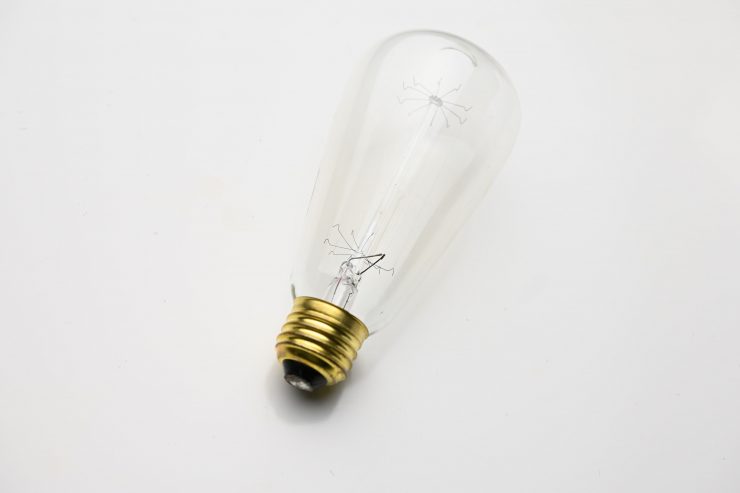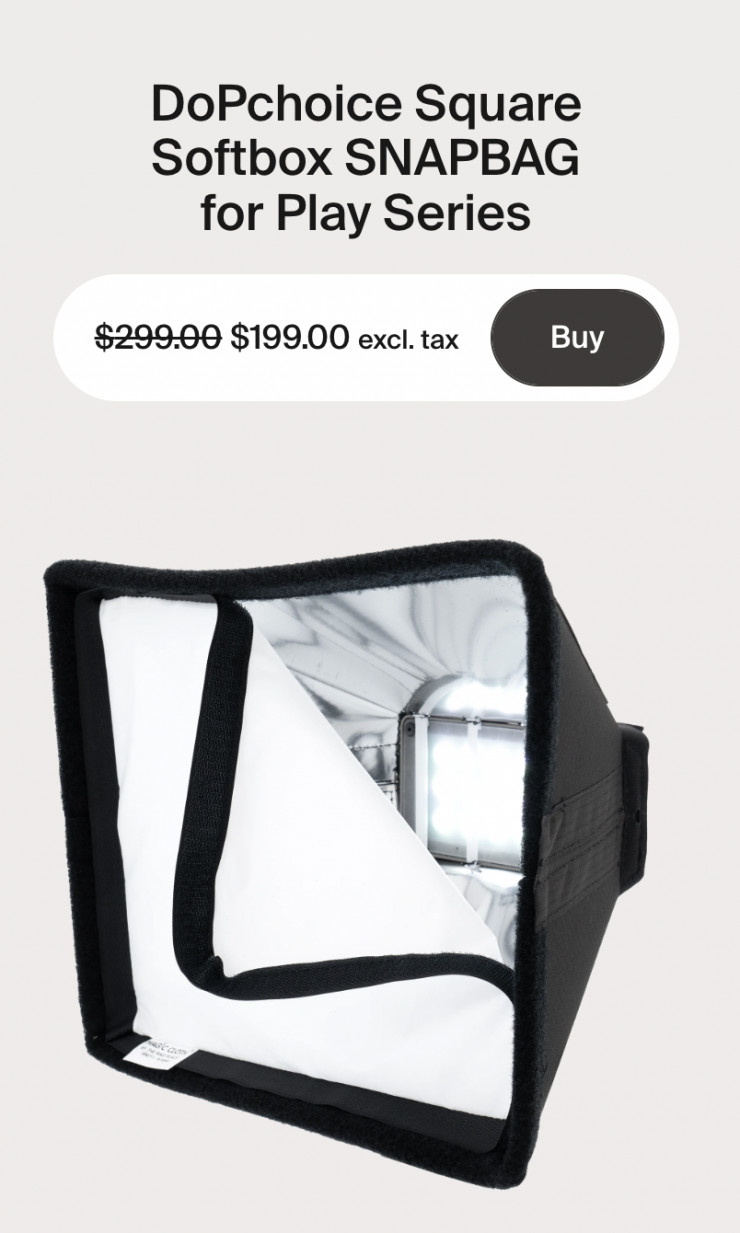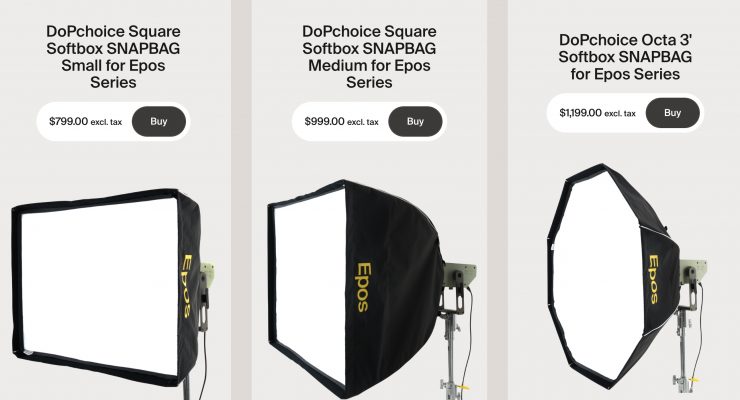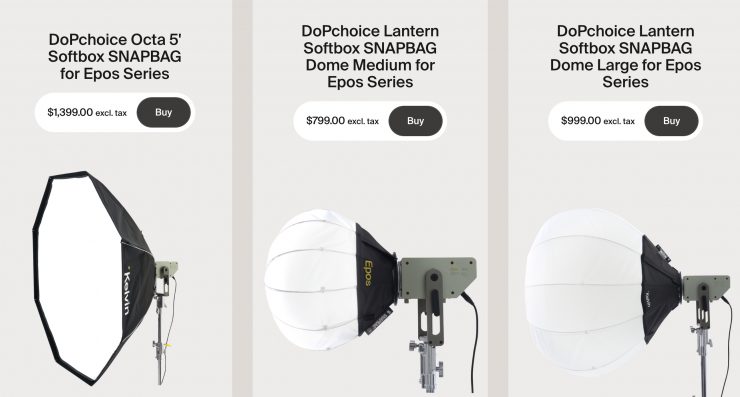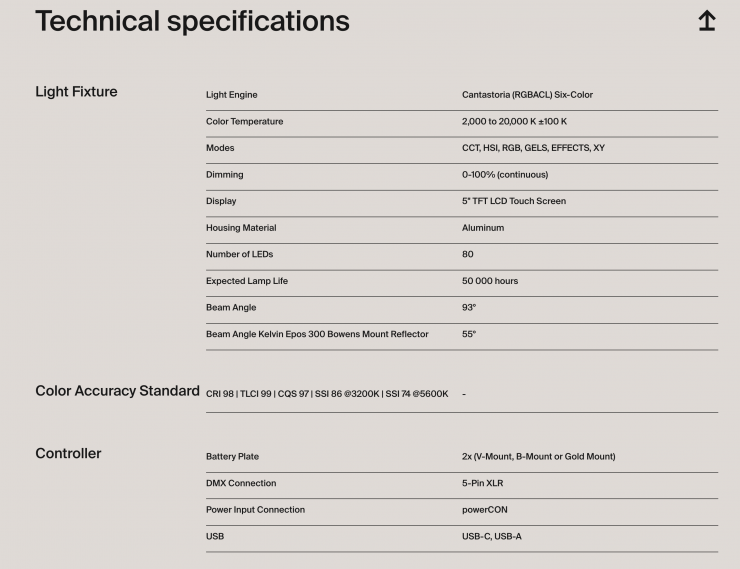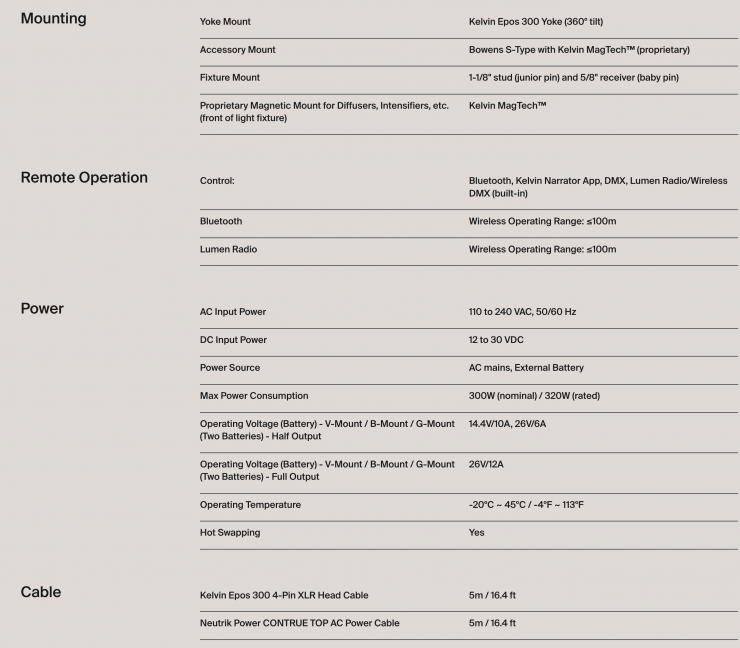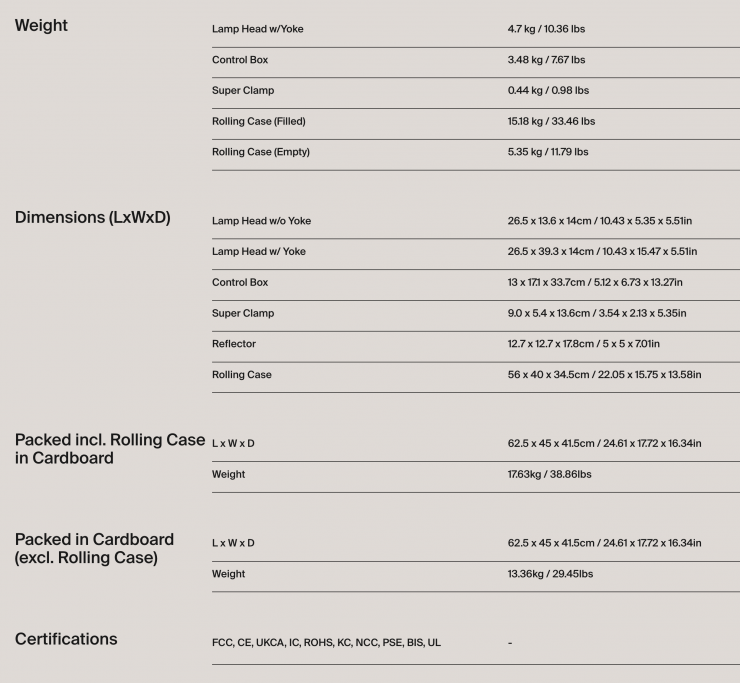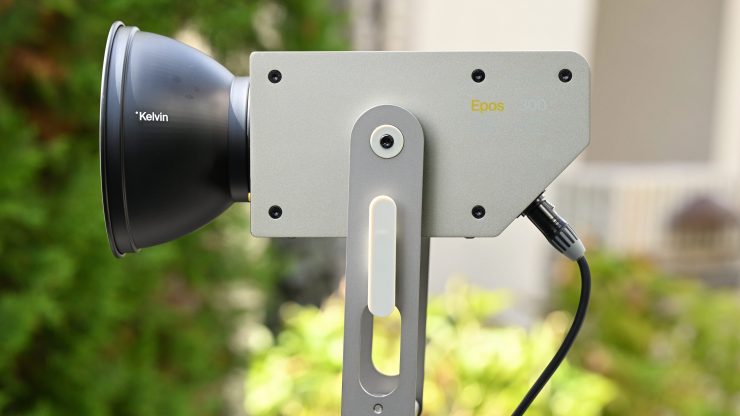
The Kelvin Epos 300 Full RGB LED Light is the first fixture in a new line of products that are being designed to push the boundaries of cinema lighting. It was first announced back in July 2022 and it only started shipping a few months ago.
Encased in 6mm thick aluminum plates, the Kelvin Epos 300 is a full color spectrum 300W LED COB studio light, engineered, and handmade in Norway. It is said to be designed and built without compromise and it comes with a 3-year warranty.
The light has a very industrial edge to it which I personally like. It does look a little bit like a Prolycht 300FS with the build quality of an ARRI Orbiter.
The Kelvin Epos 300 Full RGB light is claimed to have best-in-
class LUX output per watt, as well as offering seamless and intuitive control of the light via the Kelvin Narrator Bluetooth app, DMX, or Lumen Radio Skynode.
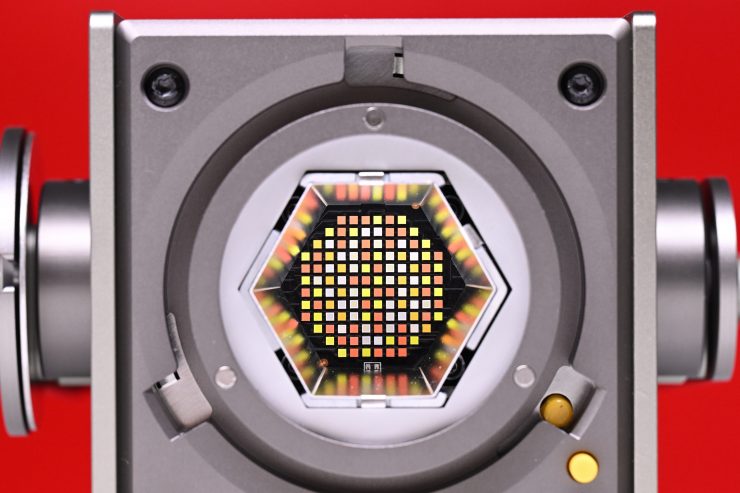
The light utilizes Kelvin’s sophisticated 6-channel RGBACL light engine Cantastoria, which produces a full spectrum of colors within the 2,000 – 20,000K range.
Lights in this form factor are very popular because of their versatility. We have seen the market flooded by so many similar featured spotlights over the last few years, however, the majority of them are either daylight or b-color only. So let’s see if the Kelvin Epos 300 stands out from the crowd.
Key features
- Output: 9031 Lux at 3.3′ (5600K)
- 2000 to 20,000K; RGBACL Control
- Battery / Multi-Voltage AC Operation
- On-Board, DMX, and Bluetooth Control
- CRI 98 | TLCI 99 | CQS 97 | SS1 86
- CCT, HSI, RGB, Gel and Lighting Effects
- Hybrid Fan Cooling
- Includes 55° Reflector
- Includes Controller & 2 x Battery Plates
Concept
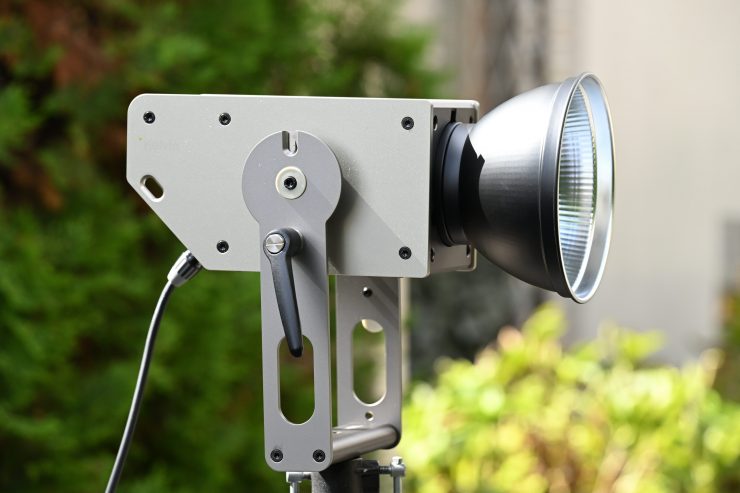
The concept behind the Epos 300 was to make a well-built, very flexible, fully-featured lighting source that could be run off camera batteries and controlled via an app. It is safe to say that Kelvin’s goal was to make something that stands out from other competing options in the market.
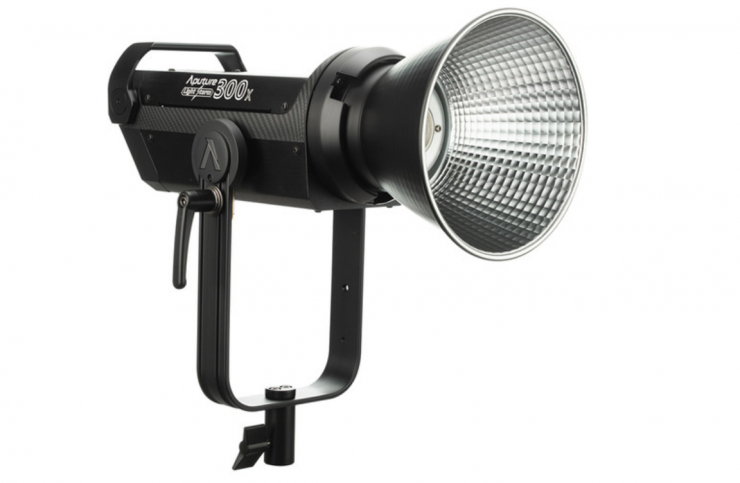
Aputure Light Storm LS300X 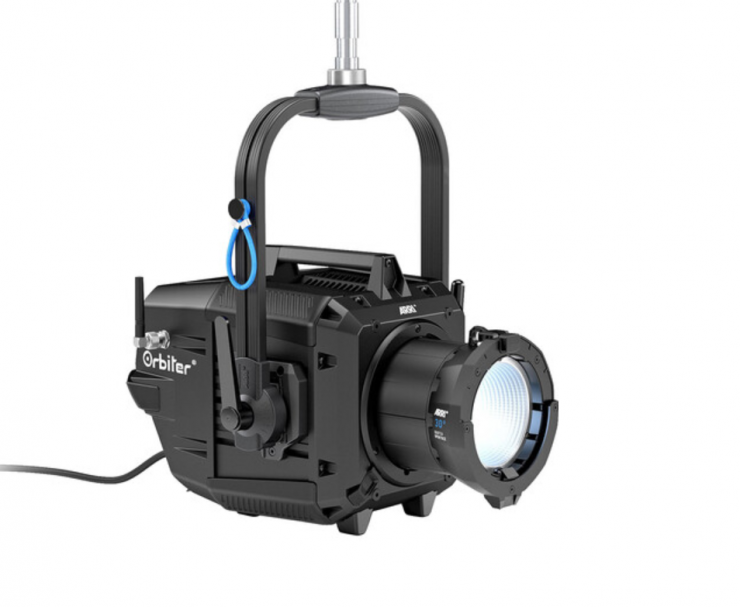
ARRI Orbiter.
In some ways, the Kelvin Epos 300 looks like a lot of other competing LED spotlights, but it certainly has a lot more elegant, refined appearance and a very industrial feel.
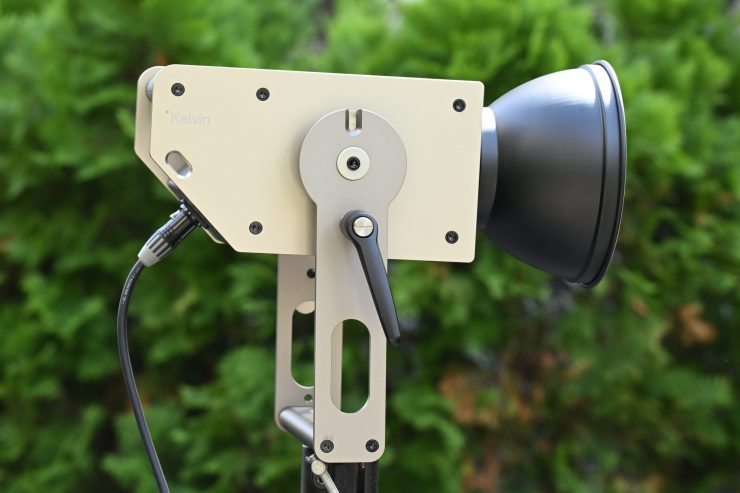
Kelvin doesn’t make any outrageous claims about the Epos 300, nor do they compare it against any other fixture. It is refreshing that they don’t try and compare it to something else. A light should be able to stand on its own, and if it is good enough, then it shouldn’t need to be compared against something else. There is a lot of very misleading marketing material out there when it comes to comparisons, especially in regard to output.
In saying that, this is a review, so I will be comparing it to other fixtures.
Who is Kelvin?
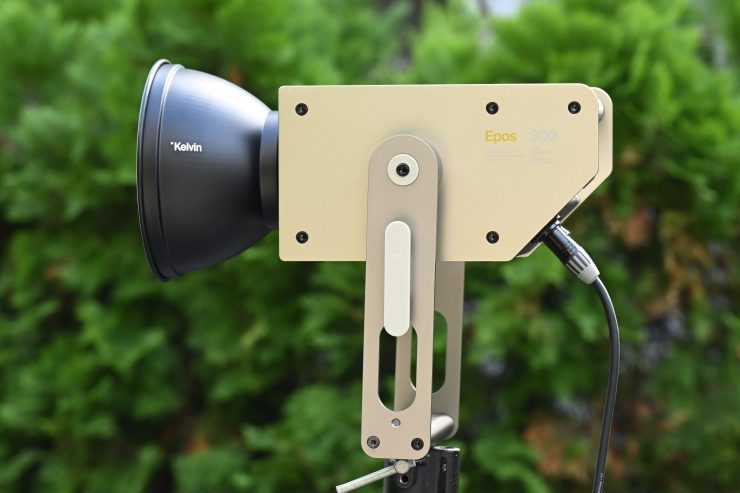
Kelvin is a new lighting brand developed by LED technology company Rift Labs from Scandinavia. Rift Labs has been manufacturing award-winning cinema lighting fixtures and lighting software for the global video and photography market in video and photo since 2010 and they have sold more than 50,000 products.
The headquarters of Kelvin is located in Oslo, Norway with offices in Berlin and an upcoming one in New York.
As well as making the Epos 300, they also have the Epos 600 and the Kelvin Play and Play Pro.
Above, you can watch our interviews with Kelvin from NAB 2023 about the Play and Epos 600.
What do you get?
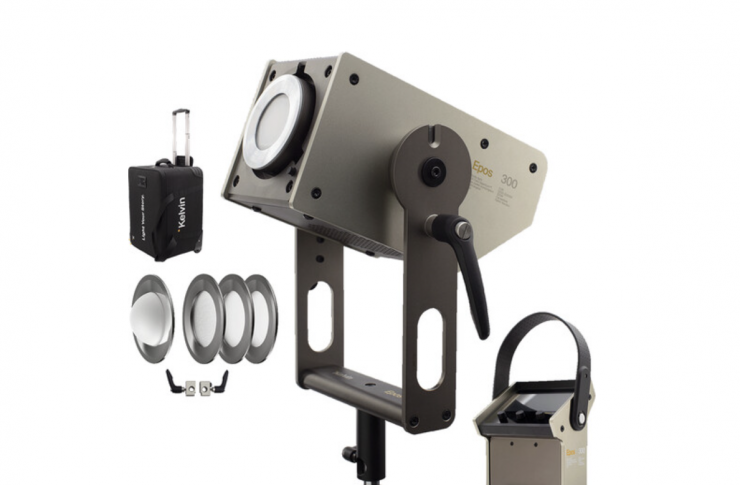
In the Kelvin Epos 300 RGB LED Monolight (V-Mount, Travel Kit with Accessories) that I will be reviewing, you get the following items:
- Controller with 2X V-Mount Battery Plates
- 55° Reflector
- 4-Pin Head Cable (16.4′)
- Neutrik AC Power Cable (16.4′)
- Super Clamp
- Kelvin Rolling Case for Epos 300 LED Monolight
- Kelvin D100 Light Diffuser for Epos LED Monolight
- Kelvin D90 Medium Diffuser for Epos LED Monolight
- Kelvin D75 Heavy Diffuser for Epos LED Monolight
- Kelvin Dome Diffuser for Epos 300 LED Monolight
- Kelvin Umbrella Mount Set for Epos 300 LED Monolights
Build Quality & Design
This is where the Epos 300 stands out from its competition. The light is beautifully made and constructed and you can tell that a lot of thought and care went into the design. As I just mentioned, it is elegant and sophisticated and looks more like something you would find in a modern Scandanavian house being used as a practical fixture.
Every fixture is handmade and the attention to detail is very evident. The build quality is as good as you will see from companies such as ARRI. I am sure there are people out there who arguably don’t care about what the exterior of light looks like, but build quality and attention to detail can tell you a lot about a company.
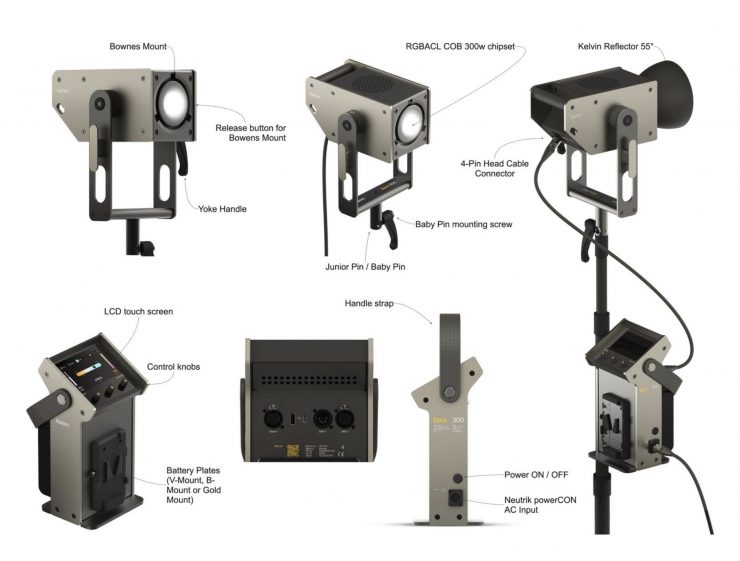
The design of the Epos 300 was developed to be robust, reliable, and practical. There is an extensive use of aluminum that allows for sturdy construction, which is also easy to recycle, long-lasting, and provides a superior protective case for the light’s electronics. Speaking of aluminum, the housing of the Epos 300 is 6mm thick. The light also comes with a 3-year warranty.
The design consists of the lamp head and a separate power supply/controller. This is fairly common with lights such as these. Having multiple components can be a pain, but it does allow you to use the light on smaller-sized light stands because you don’t have all the weight sitting just on the fixture itself. It also helps with cooling and minimizing any noise.
Small touches like putting degree angle markings when you adjust the yoke frame are something you just don’t see on any other fixtures.
The yoke frame is beautifully made and exceptionally strong.
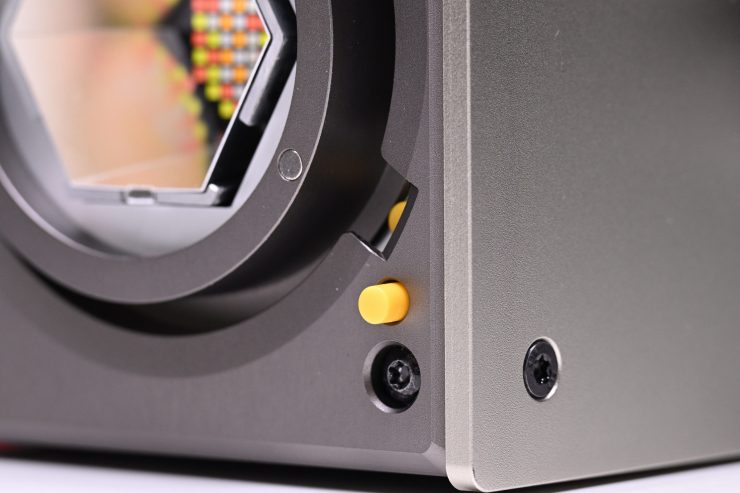
The only small nitpick I have when it comes to build quality is that the Bowens S mount release is just a plastic button. While there is nothing wrong with it and works fine, it doesn’t look like it belongs on the fixture.
The yoke locking mechanism is extremely robust and the fixture won’t move around at all when it is fully locked down.
The separate power supply/controller is just as well made as the light head. Again, the attention to detail is very evident.
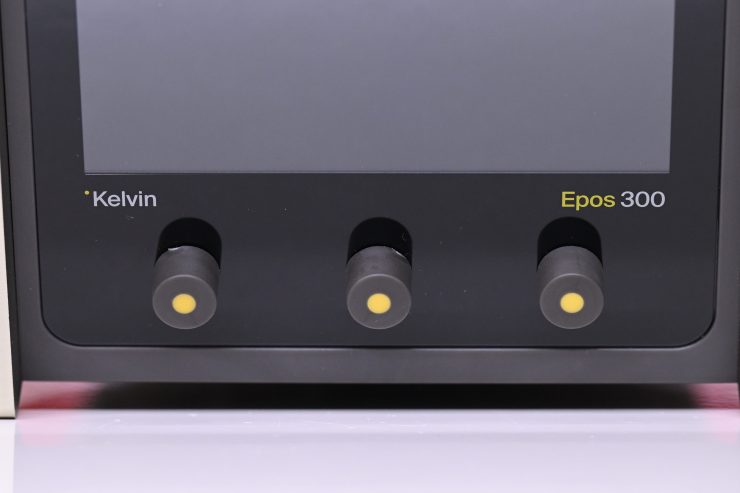
The power supply/controller adjustment dials are very tactile and easy to use.
Small things have been included that most people wouldn’t even glance twice at. Kelvin has made the base of the power supply/controller platform wider than the actual unit so that it provides better weight balance when you are just attaching camera batteries that are different weights and sizes, or just one large battery. This stops it from tipping over.
There is also a nice attachment on the side of the yoke frame that you can use to loop around the power cable if you want to keep it tidy.
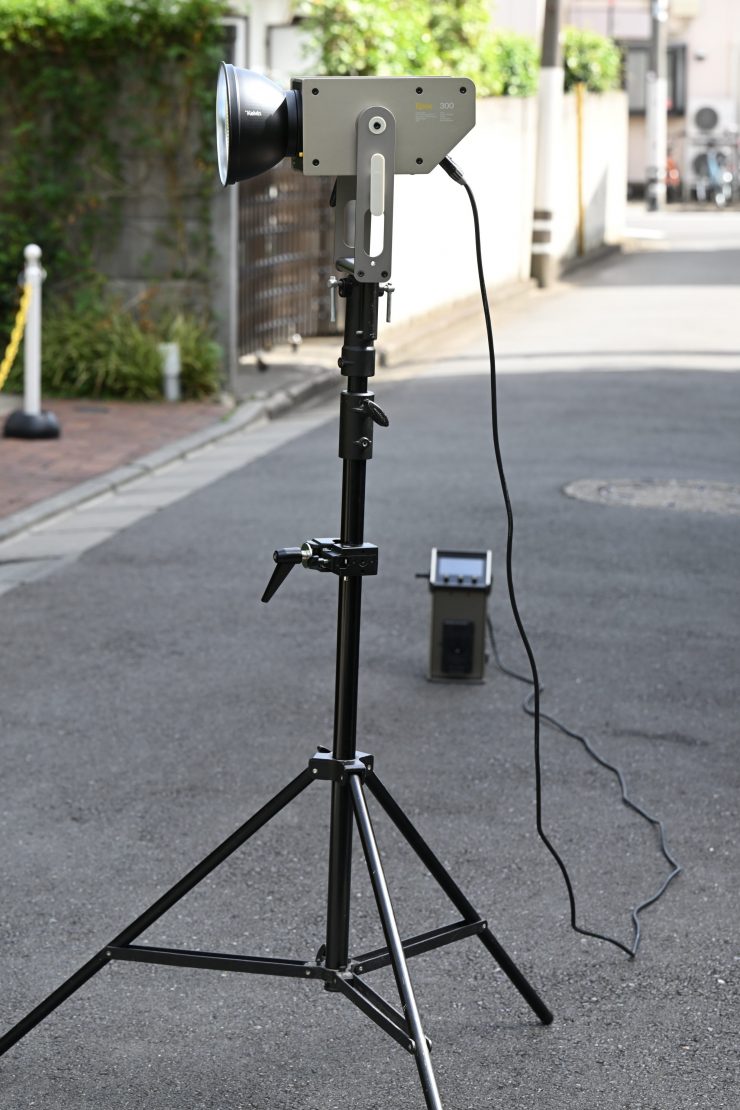
I also like that Kelvin gives you a long 5m cable that goes from the controller/power supply to the lamp head. This allows you to place it a long distance away from the light and it is also handy if you want to keep it on the ground when the Epos 300 is located up very high on a light stand. Kelvin also sells an option longer 10m cable as well.
The included rolling case that comes with the light kit I was reviewing is well made and nice and robust. The retractable handle doesn’t wobble around and flex and the wheels are nicely made. Even the additional carry handle has been re-enforced. Again, and I will keep stressing this throughout this review, attention to detail.
The Kelvin Epos 300, like so many of the new lights coming to market, is an example of blending software and hardware. With software playing such a big role, lighting companies can continue to improve and update fixtures over time via firmware updates. This does give them somewhat of an advantage over older fixtures.
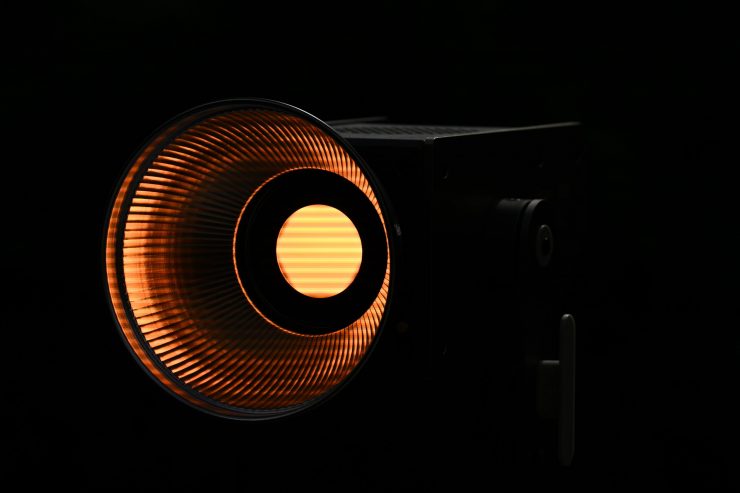
Quite a few LED lights on the market, including the Kelvin Epos 300, are using COB technology. COB stands for “Chip On Board” where multiple LED chips are packaged together as one lighting module. The advantage of COB LEDs being multi-chip packaged is that the light-emitting area of a COB LED can contain many times more light sources in the same area that standard LEDs could occupy. This results in a greatly increased lumen output per square inch. The caveat with COB LEDs is that they produce a ton of heat and that heat needs to be effectively dispersed. You also need to diffuse them as they are very bright to look at and unsuitable for directly lighting talent.
Weight & Size
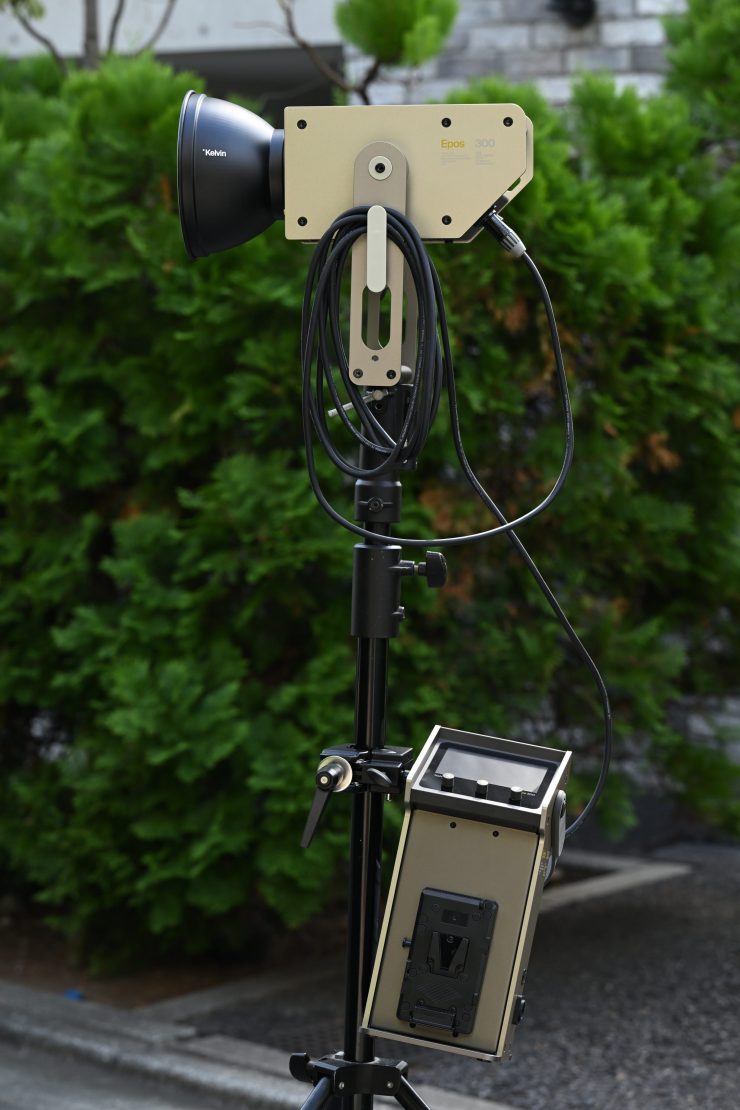
The total weight of the Kelvin Epos 300 is 8.2 kg / 18.07 lb. Here are the individual weights of the various components:
- Power supply/controller 7.7 lb / 3.5 kg
- Lamp Head & yoke frame 10.4 lb / 4.7 kg
The light certainly has some weight to it and a lot of that has to do with how well it is made and the materials being used.
So how does this weight compare to some other similar fixtures?
| WEIGHT | |
| Kelvin Epos 300 | 8.2 kg / 18.07 lb |
| Prolycht Orion 300 FS | 6.9 kg / 15.21 lb |
| amaran 300c RGB LED Monolight | 3.52 kg / 7.76 lb |
| Godox SZ300R Zoom RGB LED Spotlight | 3.2 kg / 7.1 lb |
| Lupo Movielight 300 Full Color PRO | 5 kg / 11 lb |
As you can see, the Kelvin Epos 300 is substantially heavier than all of these other fixtures.
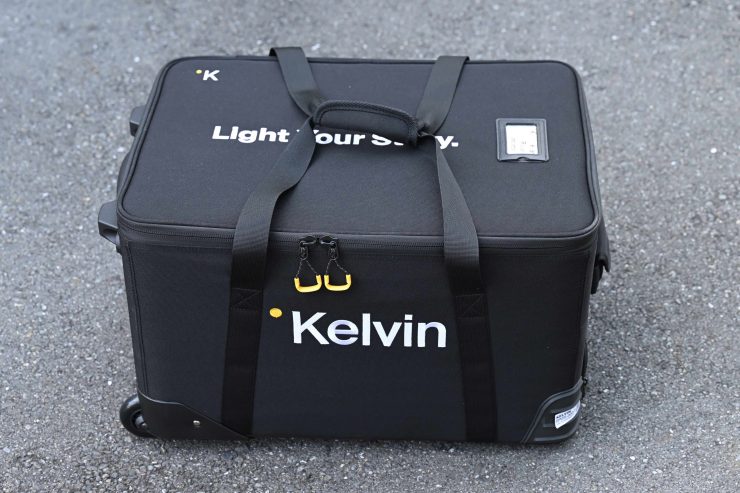
The Epos 300 in its included rolling case with all of the accessories that come with it weighs 15.18 kg / 33.46 lbs.
Bowens S Mount & Magnetic Mounts
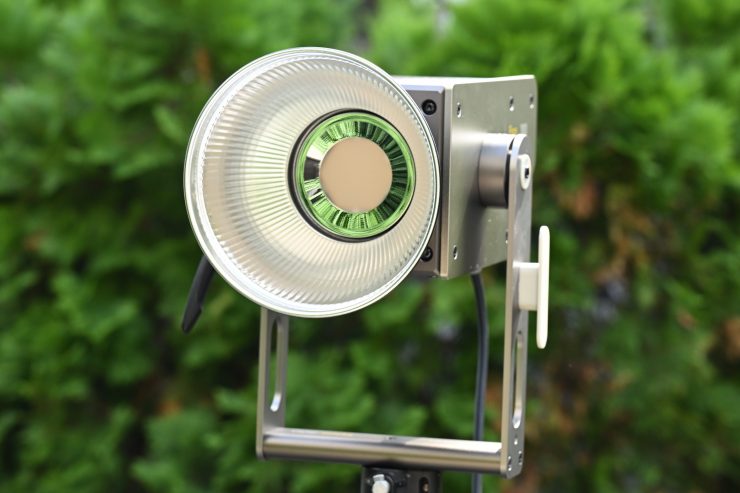
The Epos 300 utilizes a standard Bowens S mount so you can use it with a vast array of affordable lighting modifiers. Using a Bowens S mount makes a lot more sense than going with a proprietary mount.
What is quite clever, but far from unique, is that Epos 300 has the ability to use quite a few magnetic diffusers that simply attach straight to the front of the light.
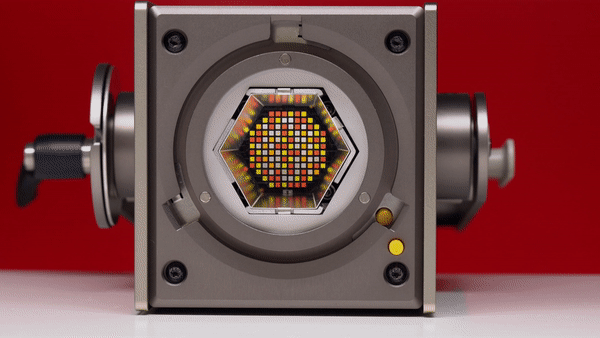
Above you can see how they attach.
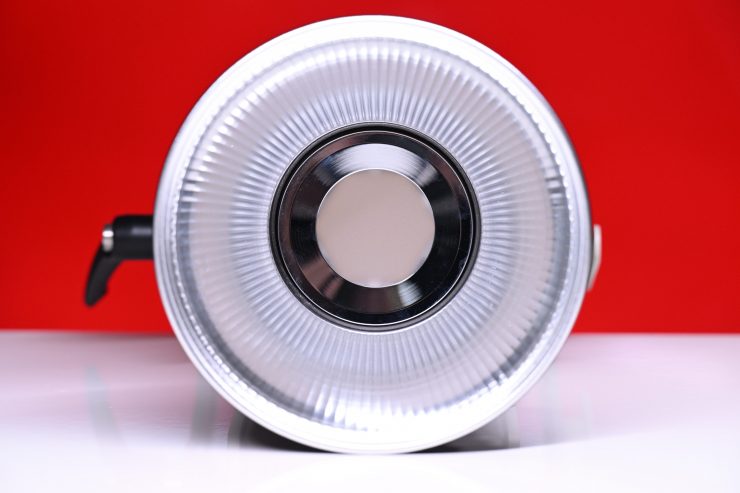
You can also use them with reflectors, softboxes, or any other Bowens-S mount attachment.
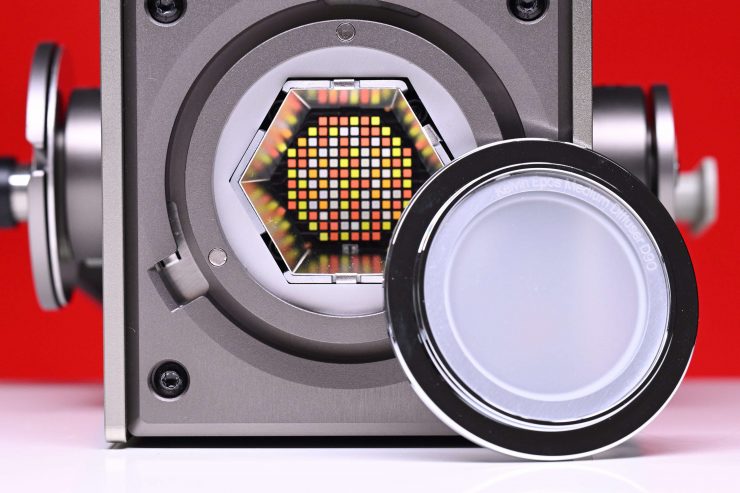
These are great because if you don’t want to attach a softbox or a large lighting modifier to the front of the fixture, they allow you to alter the light’s beam spread and diffusion in a simple, yet effective way.
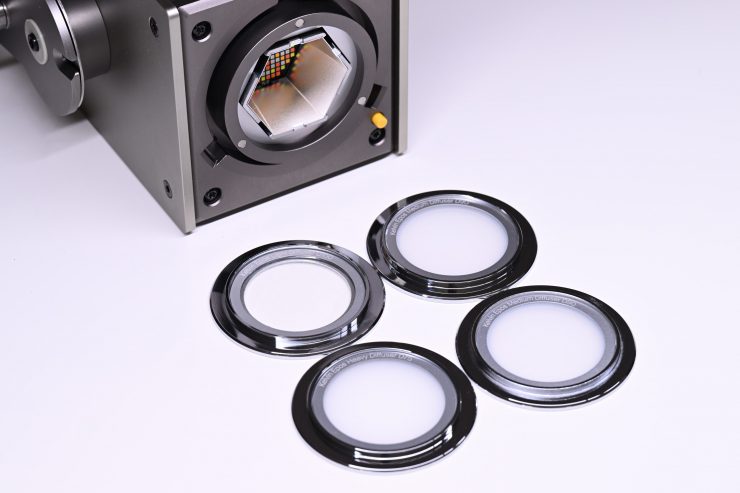
Below are the ones that come with the kit I was testing:
- Kelvin Epos Light Diffuser D100
- Kelvin Epos Medium Diffuser D90
- Kelvin Epos Heavy Diffuser D75
- Kelvin Epos Dome Diffuser
Kelvin Epos Light Diffuser D100
The Kelvin Epos Light Diffuser D100 is the thinnest diffusion available for the Epos 300. It was designed to be just thick enough to mix the colors while still maintaining as hard a source as possible.
Kelvin Epos Medium Diffuser D90
The Kelvin Epos Medium Diffuser D90 offers a slightly thicker diffusion but with minimal light loss of less than 0.2 of a stop. It extends the beam angle slightly, which makes it a good match for use with large softboxes or with less precise optical accessories.
Kelvin Epos Heavy Diffuser D75
The Kelvin Epos Heavy Diffuser D75’s heavy-grade diffuser is the heaviest of Epos diffusers that still maintains a minimum light loss of less than 0.2 stops. It widens the beam by a few degrees, making it a suitable match for use with smaller softboxes or with other optical accessories.
Kelvin Epos Dome Diffuser
The Kelvin Epos Dome Diffusers can be used in conjunction with umbrellas, parabolic accessories, or softboxes. It allows the light output to spread at a very wide beam angle of 180 degrees. The dome creates a point of light, which makes the most out of the silver in softboxes and other modifiers, in the same way, a tungsten bulb traditionally would.
Kelvin Epos Umbrella Mount
In addition to the magnetic diffusion attachments, you also get the Kelvin Epos Umbrella Mount in the kit. This attaches quickly to the Epos monolight’s chassis and allows virtually any kind and size of umbrella to be used. The large clamps make it easy to adjust the umbrella and secure it in place. These mounts allow umbrellas to be used in combination with Epos dome diffusers and other modifiers.
Mounting
As I mentioned before, the yoke frame is very robustly made and it features a single locking mechanism.
On the bottom of the yoke frame, there is a 5/8-inch pin (Baby Pin) receiver.
A Junior Pin also works fine (28mm stand).
You can also attach it to any regular light stand.
The yoke frame allows you to angle the light directly up. If you are angling it down it will depend on what type of lighting modifier you are using and at what angle you will be able to achieve.
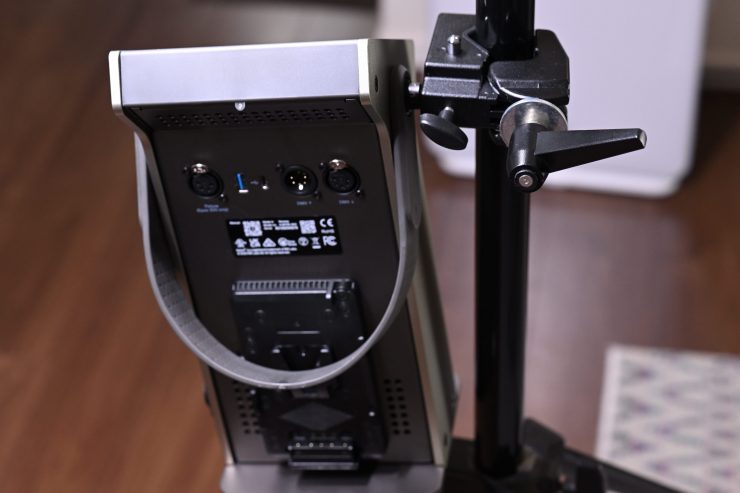
Now, you can mount the power supply/controller to a light stand with the included mount, but it took me a while to work out how to do this.
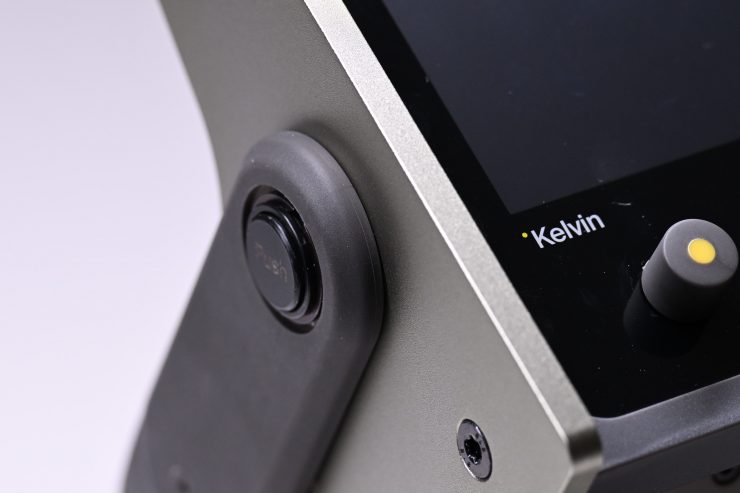
If you look carefully at one of the the pins that secures the carry strap to the power supply/controller you will notice that bis some writing on it that says Push.
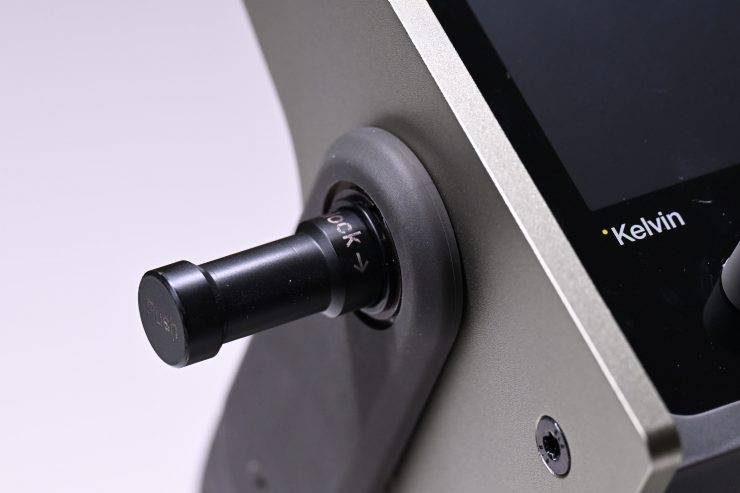
If you actually push and twist this at the same time a mounting pin extends out using a spring mechanism.
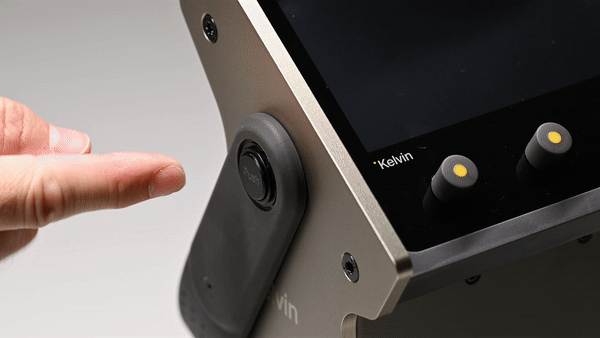
Above you can see how this works.
This is the pin you use to attach the power supply/controller to the super clamp.
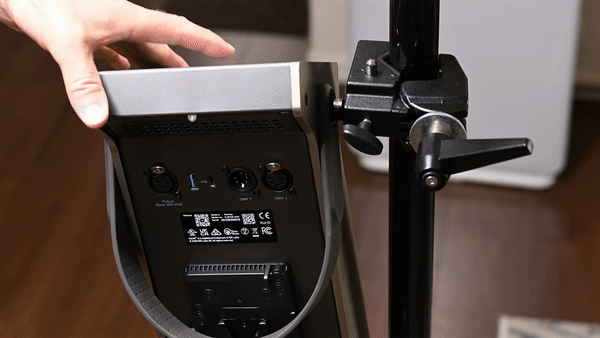
While this is a novel design, because it uses a spring mechanism, when it is extended out it doesn’t lock in place. This means that the power supply/controller can actually move around freely. While this is not a big deal, it does mean that the power supply/controller doesn’t stay straight. You also need to be aware of this if you are picking up a light stand with the power supply/controller attached as it can swing around slightly.
Power Draw
The light draws 320W. So how does that compare to other competing fixtures? Below you can see.
| MAX. POWER DRAW | |
| Kelvin Epos 300 | 320W |
| Prolycht Orion 300 FS | 320W |
| amaran 300c RGB LED Monolight | 360W |
| Godox SZ300R Zoom RGB LED Spotlight | 330W |
| Lupo Movielight 300 Full Color PRO | 220W |
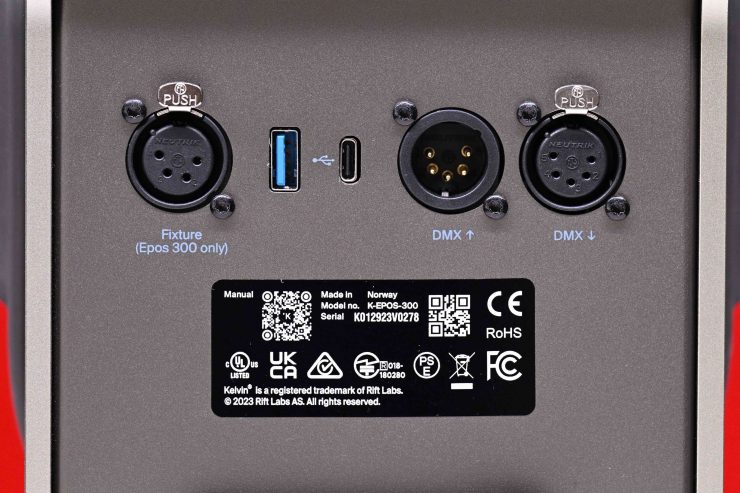
Even though the DC input power for the fixture is 12 to 30 VDC, there is no actual DC input which is a little strange, so there is no way of powering it remotely from block batteries, etc.
The light can also be run off camera batteries as the controller/power supply features dual V-mount (or AB Gold-Mount, or B-Mount depending on the version you purchase) battery plates. As the light only draws 320W you can run it off two flight-safe camera batteries at full power., but there are some caveats that I will talk about in a minute.
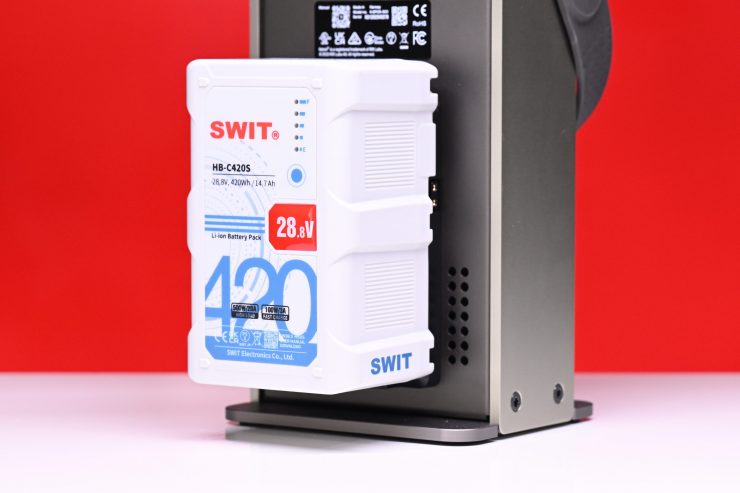
You can use either 14.4, 24, 26, or 28V batteries to power the light remotely.
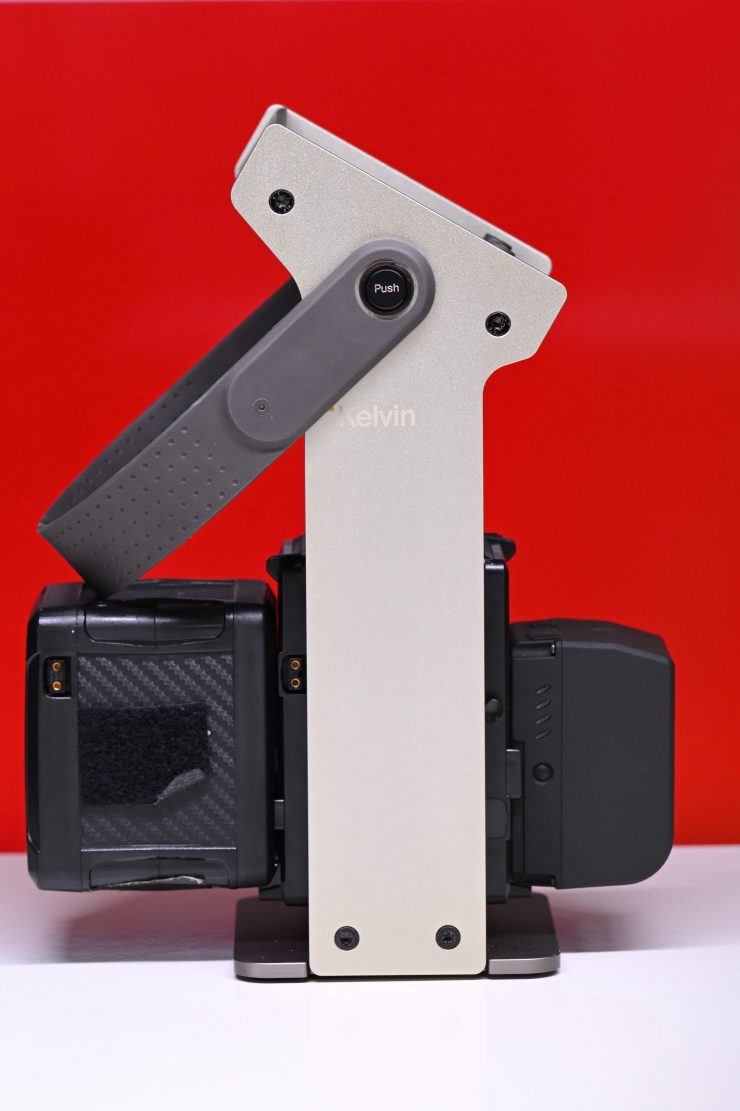
The Epos 300 does not require that both batteries are the same type, have the same charge, or even have the same voltage. Smart batteries have a data connection in addition to the two power connections. The Epos lights use the data connection to query the battery about its state of charge, its capacity, and other things. The Epos will then know how much power is safe to draw from the battery and how long the battery will last if it continues on the same color and brightness.
Now, there are some caveats when using batteries. If you are using two batteries (V-Mount / B-Mount / G-Mount) and they are 14.4V/10A, or 26V/6A- you can only run the light at 50% output.
To run the light at 100% output you need to use two 26V/12A (V-Mount / B-Mount / G-Mount) batteries.
When I first started revieweing the light no matter what battery or batteries you are using, the controller display will go up to 100%. I would have preferred if the light gave you a warning or showed what the maximum intensity level is depending on what you have attached. This would avoid confusion because if you are not familiar with the Epos 300, you are not going to be aware of the powering caveats when running the fixture from batteries.
It is important to know that if the power supply is connected to both a 26V battery and an AC power source, the power supply will draw from the 26V battery instead of the AC power. To preserve battery life, connect a 26V
battery to the power supply only when you intend to use it.
This is not a feature of the battery as such, but it is related. If a light allows hot swapping you can swap between batteries; or between batteries and the wall power without flickering.
If you have two batteries connected to the Epos, the Epos will draw power from the strongest battery until it is empty. It will then switch over to the weaker battery. If you connect the wall power, the Epos will get its power from the mains and not use any of the batteries.
If you disconnect the mains when a battery is mounted the Epos will switch over to the battery without flicker, provided the battery is strong enough to take over. If you run the Epos light at full output and change to a battery that cannot deliver enough power, the light will attempt to lower the power draw instantaneously to avoid killing the battery. This means lowering the brightness. So please be aware of this.
I tested out the Epos 300 with a multitude of different batteries, both 14.4V and 28.8V, and it worked regardless of what type of battery I used or whether I used two batteries or just one. It is also nice that you can mix and match batteries to power it. A lot of fixtures require two identical batteries to work correctly.
Now, in saying that, when I first started testing the light, no matter what batteries I tried I could not get the Epos 300 to work at 100% output. I found this very puzzling so I contacted Kelvin. Kelvin told me: ‘If you can use a slightly discharged battery, it will work as intended.’ They went on to say: ‘We are working on a firmware update that will solve this issue.’ I tried following Kelvin’s advice, but I still couldn’t get the light to work at 100% output.
To their credit, Kelvin came up with a firmware update within a couple of days that fixed the issue. I was able to power the EPOS 300 at 100% from a single 28.8V battery.
Not being able to power it at full output from two or even one high-power draw 14.4V batteries is not ideal, and that could put some potential buyers off. On fixtures like the Prolycht Orion 300 FS, you can power the light at 100% output from two flight-safe 14.4V batteries.
While it is nice to be able to power a light like this from two flight-safe camera batteries, especially for field work or anyone who needs to travel, unless you have at least one 28.8V 12A battery you won’t be able to power it at full output.
How does it stay cool?
Large, high-powered COB lights get very hot, and keeping them cool is not an easy task. Using fans is the best solution, but the caveat with fans is that they can create noise.
The Kelvin Epos 300 has 2 large fans, one above and one below the heatsink. These are top-of-the-line silent Noctua fans.
As a comparison, above you can see what the fans look like on the competing Prolycht Orion 300 FS.
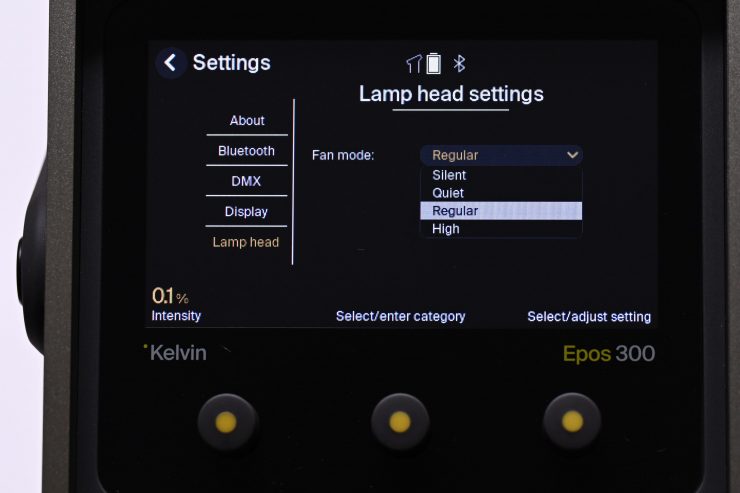
The light gives you the option of changing the fan speed. You can set it to:
- Silent (the cooling fan is running very low or turned off)
- Quiet (the cooling fan is running at up to half speed)
- Regular (the cooling fan is running at up to 70%)
- High (the cooling fan can run at full speed)
The fan in the Kelvin Epos 300 is incredibly quiet. Even if you set it to Regular and put the light at 100% output in its Max. mode you can barely hear it. It is by far the quietest fixture I have come across that has this type of power draw.
Are there any caveats? Yes. Running the fixture in silent or quiet mode reduces the maximum light output in order to protect the lamp head from overheating.
Cantastoria 6-channel RGBACL light engine
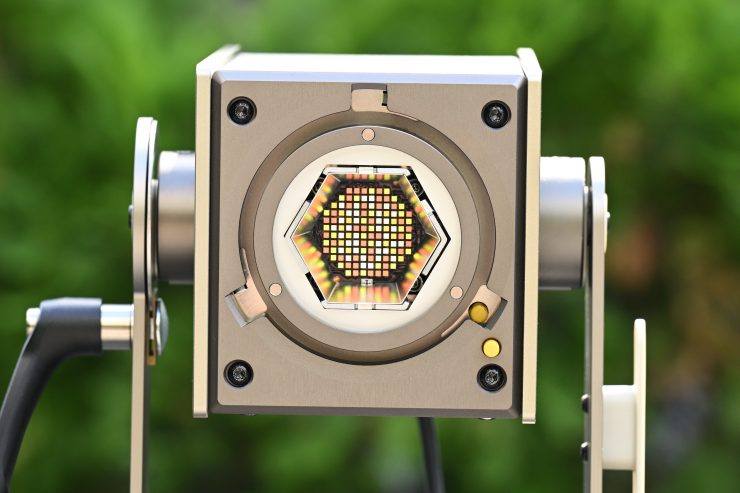
We are seeing a lot of lighting companies now using RGBW technology. RGBW stands for Red, Green, Blue & Warm White. There are, however, other types of RGB such as RGBWW and RGBAW.
The Epos 300 utilizes Kelvin’s sophisticated 6-channel RGBACL light engine Cantastoria, which produces a full spectrum of colors within the 2,000 – 20,000K range.
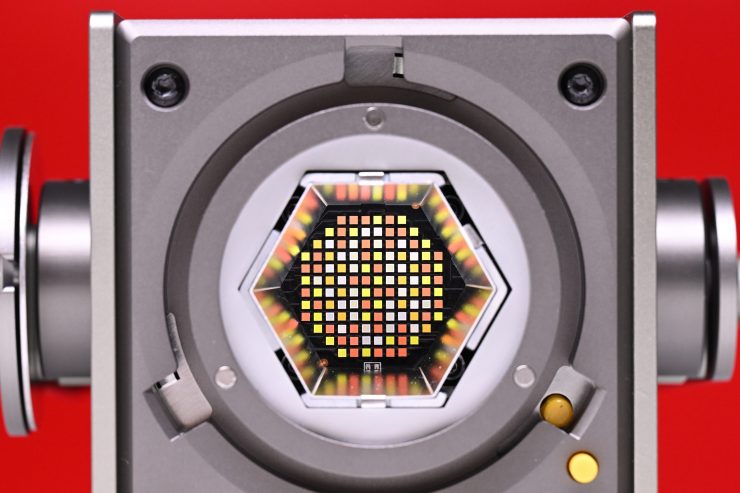
Due to the unique Cantastoria Light Engine, a predictable continuity of light across the full color spectrum is guaranteed, and the light intensity is highly precise and controllable to an accuracy of 0.01%
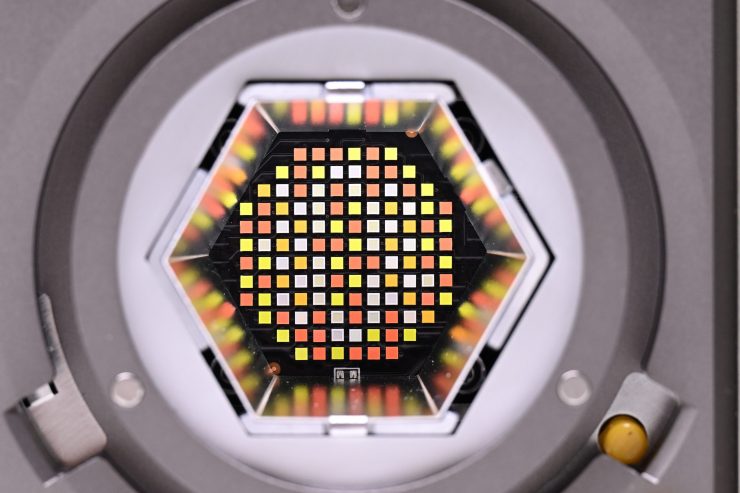
Just like the competing Prolycht Orion 300 FS, the Kelvin Epos 300 has Red, Green, Blue, Amber, Cyan, and Lime LEDs. The Epos 300 doesn’t use any white LEDs, instead, Kelvin are mixing all of those different color LEDs to produce white light. This is exactly what ARRI does with the Orbiter. Hive Lighting has also been using 7 LED-chip blending. Instead of the traditional 3 colors, Hive uses red, amber, lime, cyan, green, blue, and sapphire.
The advantage RGBACL has over RGBWW is that it is capable of giving you a larger CCT range and it can produce more saturated colors with more output. RGBWW lights tend to struggle to create saturated colors like yellow and they don’t always have as much output when generating saturated colors. They can also have a large drop-off in output at different CCT settings.

Just how well the Epos 300’s light engine works, we will see later in the review.
Touchscreen Operation
What I really like is that the controller uses a touchscreen interface. The only other lights off the top of my head that I can think of that have a touchscreen interface are the Rotolight Titan X1 and X2.
The touchscreen interface works really well. It is snappy and responsive.
If you don’t want to use the touchscreen or you have gloves on, etc. you can control everything using the dials. It is nice having the option for both forms of control.
Operating Modes
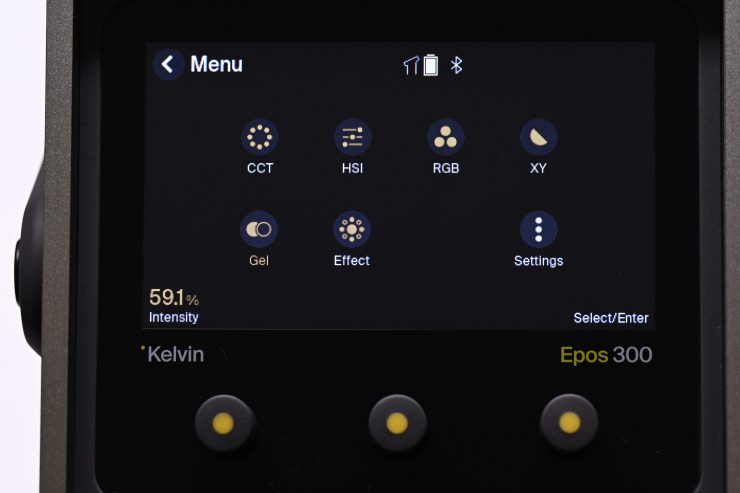
The light has 6 key lighting modes:
- CCT
- HSI
- Gel
- RGB
- XY
- Effects
Correlated Color Temperature (CCT)
This is the mode most people are going to use the light in. In the CCT Mode, you have full access to making Kelvin color temperature adjustments between 1700-20,000K. This is a very wide range and it offers plenty of versatility.
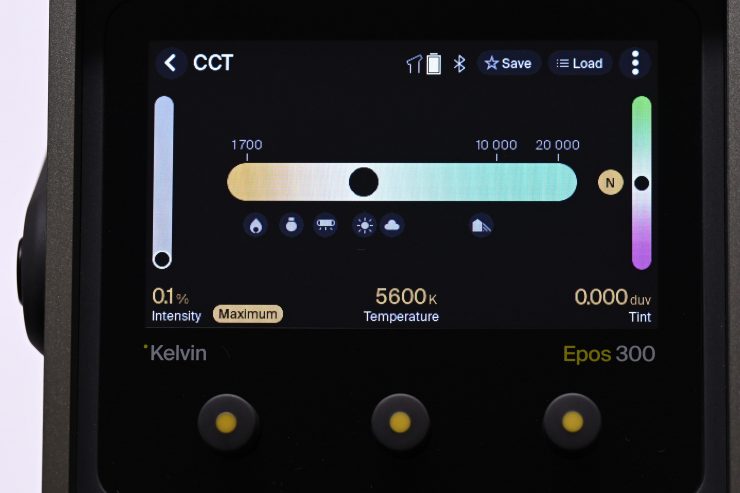
You can adjust the intensity right down to 0.1% and the light still stays on.
There is also a Max Mode and a Constant Mode. The constant mode will give you roughly the same output at all CCT settings, while Max Output will give you the most output, but the CCT settings will vary that output.
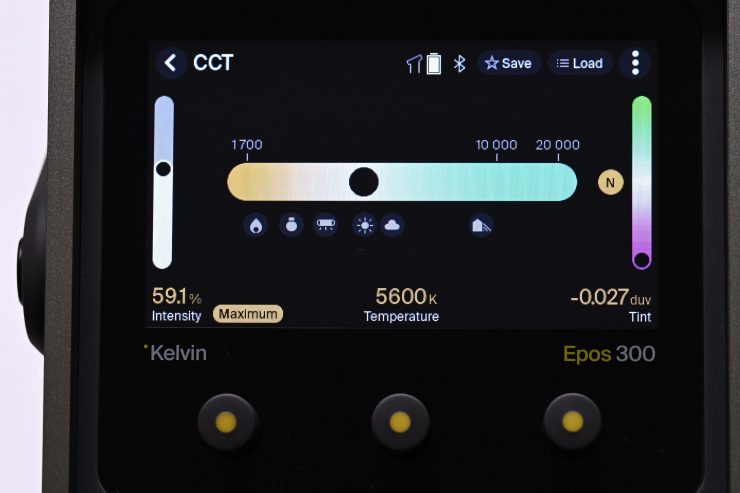
The fixture also has continuous variable (full minus green to full plus green) correction.
Being able to dial in more or reduce the amount of green coming from your lighting source can make a huge difference. Different camera companies use different sensors in their cameras and they all react differently to light. Some camera sensors may lean towards magenta, and some, more towards green. By making CCT adjustments you can dial in the light so that it looks better for whatever camera system you are using. CCT adjustment also helps when you are trying to match lights from different manufacturers.
The Kelvin color temperature range is impressive and it should suit most people’s needs.
HSI
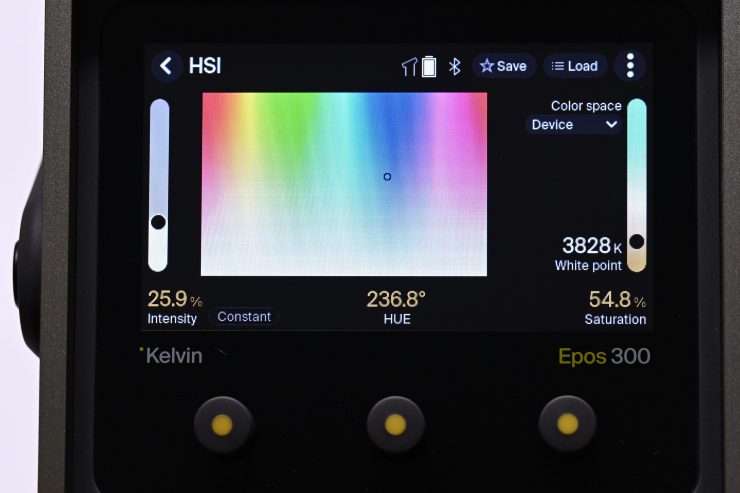
The HSI mode lets you create just about any color you can think of. It gives you full hue and saturation control as well as intensity. By manipulating, the hue and saturation you can create some really interesting colors that depending on the project you are working on can really add some creative flair. I quite like using this mode to create a lot of color separation between the foreground and background, or for recreating a really cold or warm-looking image.
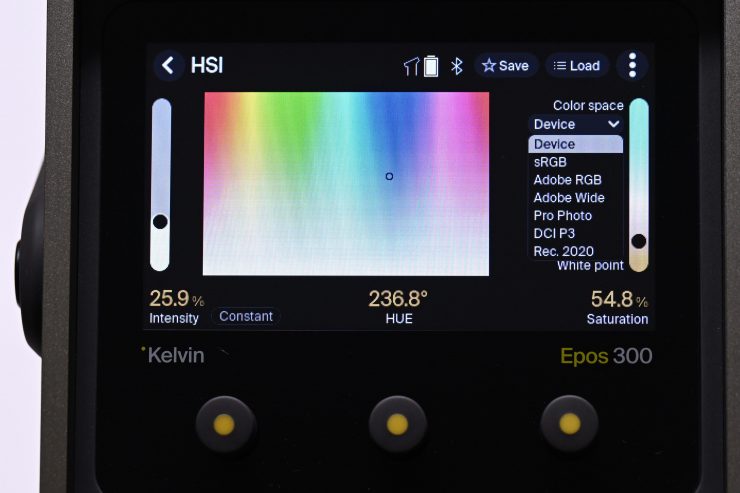
The colors are represented as degrees from 0-360. You can also change the white point and the color space.
Because the interface has really good visual aids it is so much easier to dial in the exact color you want to create. On some lights, you have to use dials with no visual reference.
Gel
Inside the fixture, there is a huge assortment of industry-standard gels from both Lee and Rosco. In fact, you can choose from 318 Rosco/LEE Gels.
Having built-in Digital Gels not only means that you don’t have to physically carry gels around, but you can also quickly and easily replicate popular gels. Using the gel mode can help you match other lighting sources, especially if you are working with other lights with physical gels.
You can select the white point by adjusting the CCT slider and then the selection of gels you see will change.
RGB

In this mode, you can individually adjust the Red, Green, and Blue channels of the fixture. Now, unlike some other RGBACL fixtures, you can’t individually adjust all 6 colors.
XY
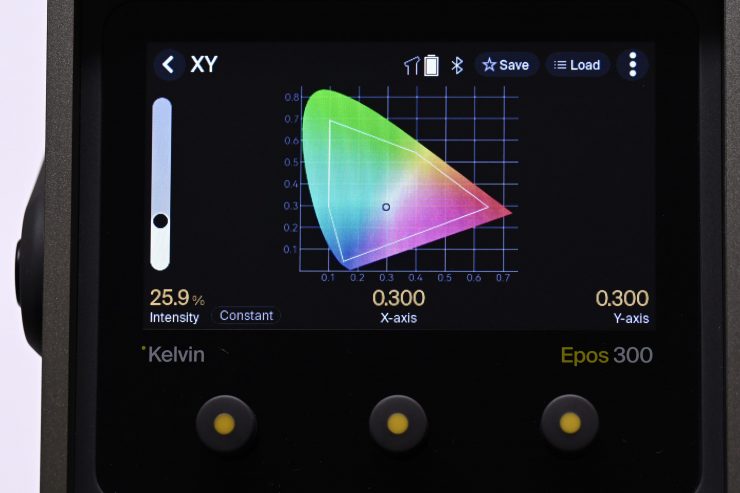
In this mode, you can adjust the x.y coordinates of the light.
Effects
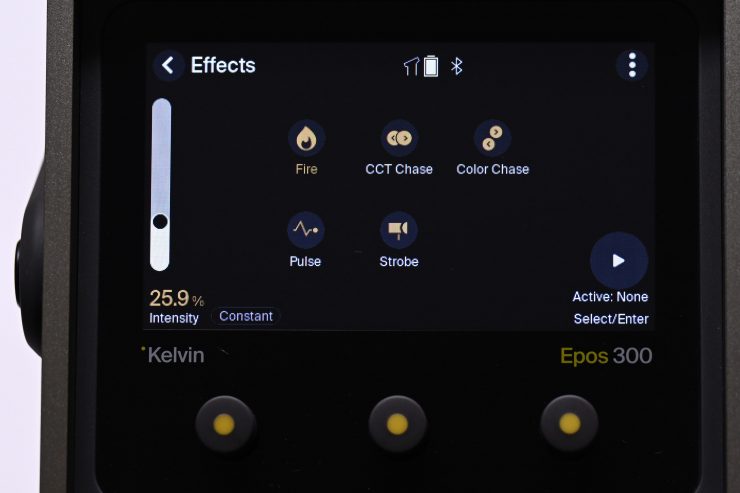
The Cantastoria 6-channel RGBACL light engine allows the fixture to deliver a lot of very realistic full-color lighting effects.
Effects mode lets you recreate a range of lighting effects that can be handy for certain scenarios. The effects are:
- CCT Chase
- Color Chase
- Fire
- Pulse
- Strobe
All the effects modes can be individually adjusted and tailored to your lighting needs.
Controls & Menu System
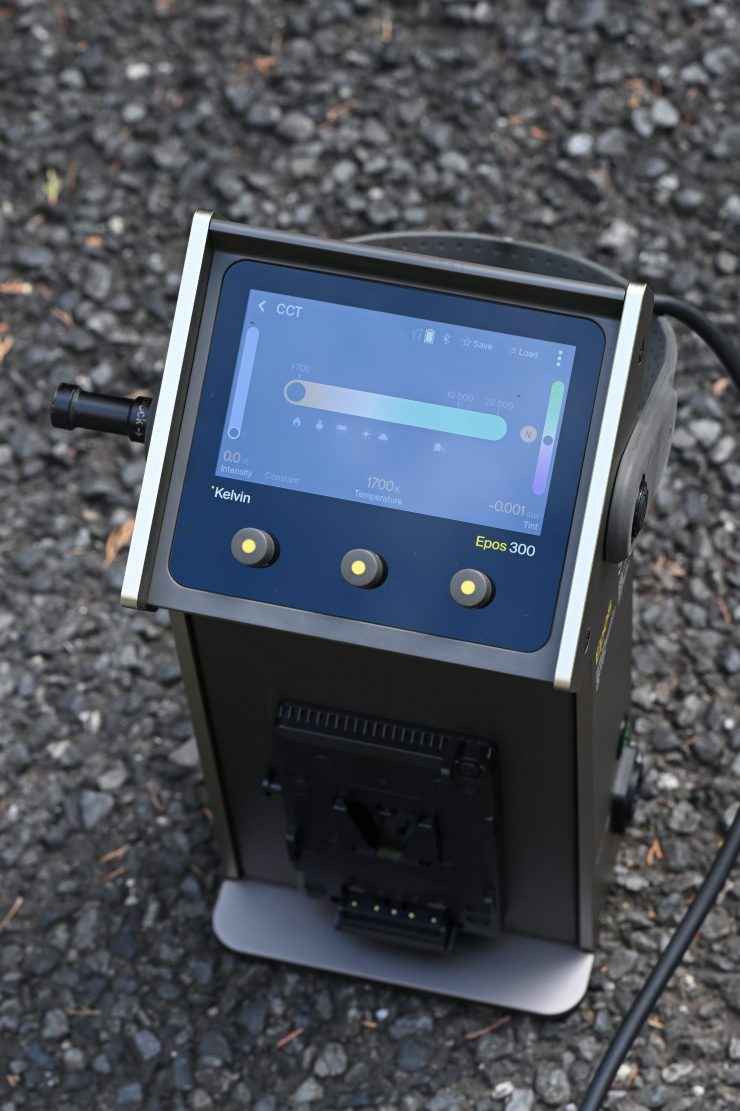
The Epos 300 controller/power supply uses a large LCD screen that clearly shows you information about the light. I love that it can be controlled via the touchscreen or by using the dials.
I really like the touchscreen interface. The only other lights off the top of my head that I can think of that have a touchscreen interface are the Rotolight Titan X1 and X2. The touchscreen interface works really well. It is snappy and responsive.
If you don’t want to use the touchscreen or you have gloves on, etc. you can control everything using the dials. It is nice having the option for both forms of control.
The design and look of the screen are clear and concise and it isn’t overly cluttered. There is good spacing between all of the information on the screen and this helps to avoid any confusion when operating the unit.
With a good light, you shouldn’t have to read a manual to work out how to operate it. You should be able to turn it on and use it straight away. You won’t find any deep sub-menus or complicated way of making changes on the Epos 300. Keeping things simple and easy to navigate is always a good strategy when it comes to menus and controls.
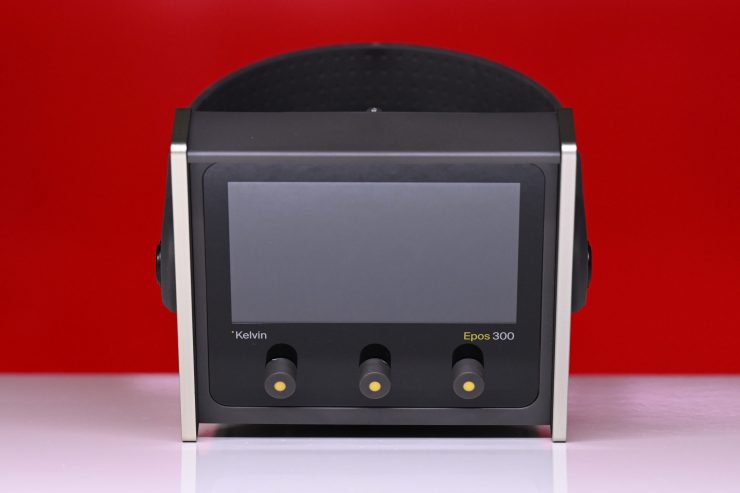
The physical dials that you can use to control the light are very tactile. They all have the same response and feel to them.
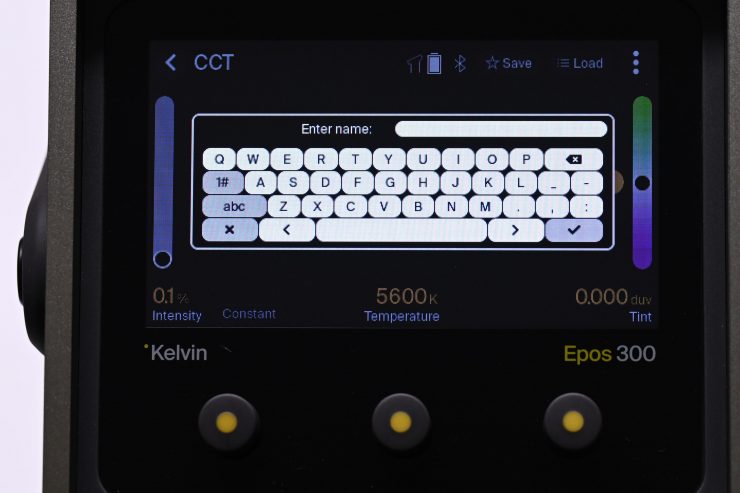
Kelvin has a very easy way to save and recall presets. You simply touch on the Save icon on the screen and then a virtual keyboard comes up where you can name your preset.
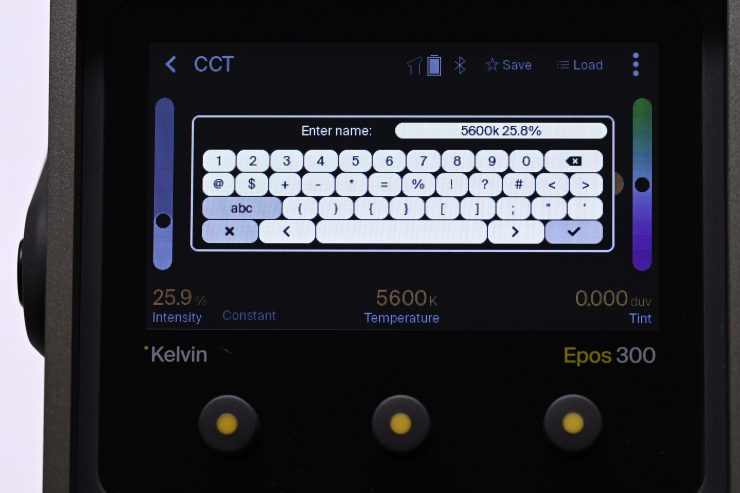
You then hit Save and you are done.
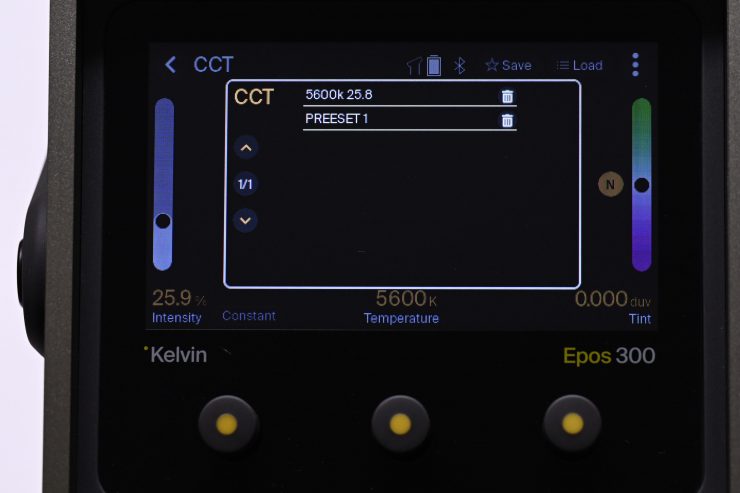
You can then press the Load icon on the screen and recall that saved setting anytime. This is really well implemented and it allows you to jump between saved settings very quickly. My only slight complaint is that it would have been nice to have the Saved preset’s name displayed when you were using it.
The menu also gives you the ability to adjust the Bluetooth, DMX, Display, and Lamp Head settings.
Kelvin Narrator Bluetooth App
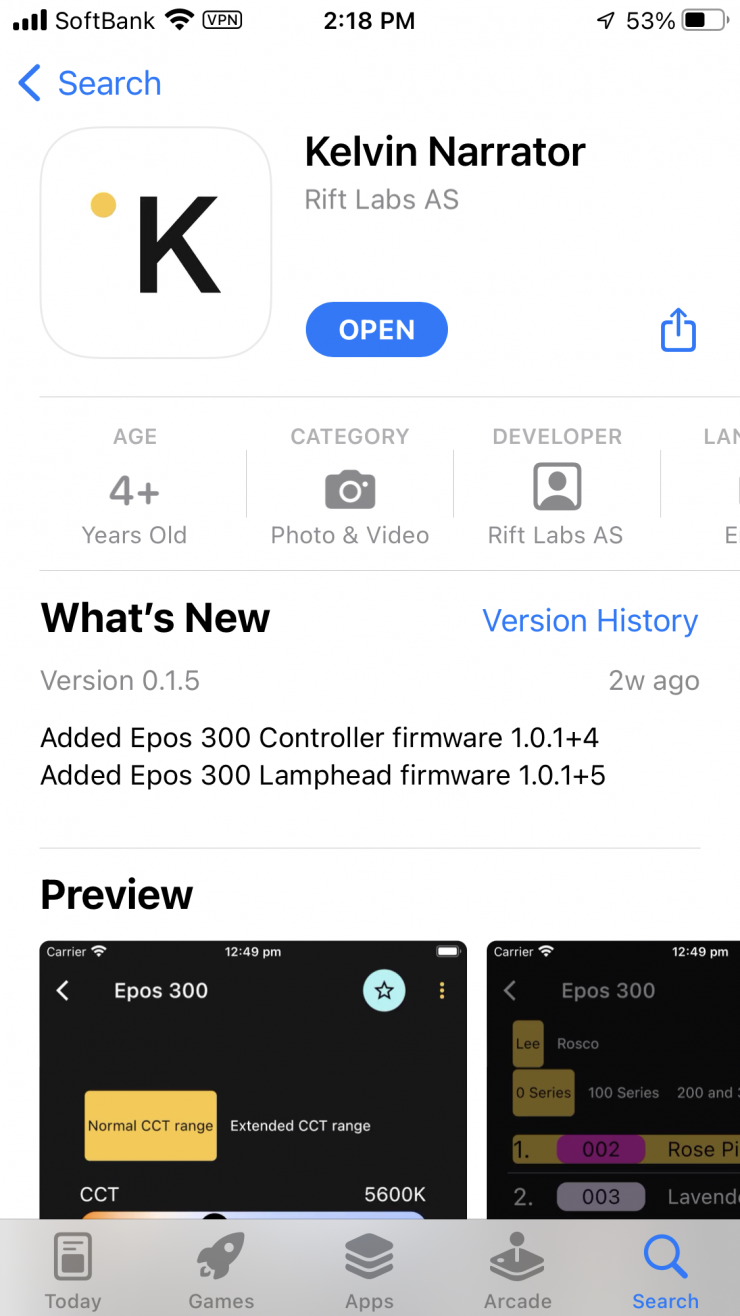
The light can be controlled via Bluetooth using the Kelvin Narrator App.
The app is reasonably easy to set up and get going. Once you have created a group you can then add fixtures to that group. You simply scan for new lights if you haven’t added them previously.
Once it finds your fixture you can choose to have it automatically connect every time, or not.
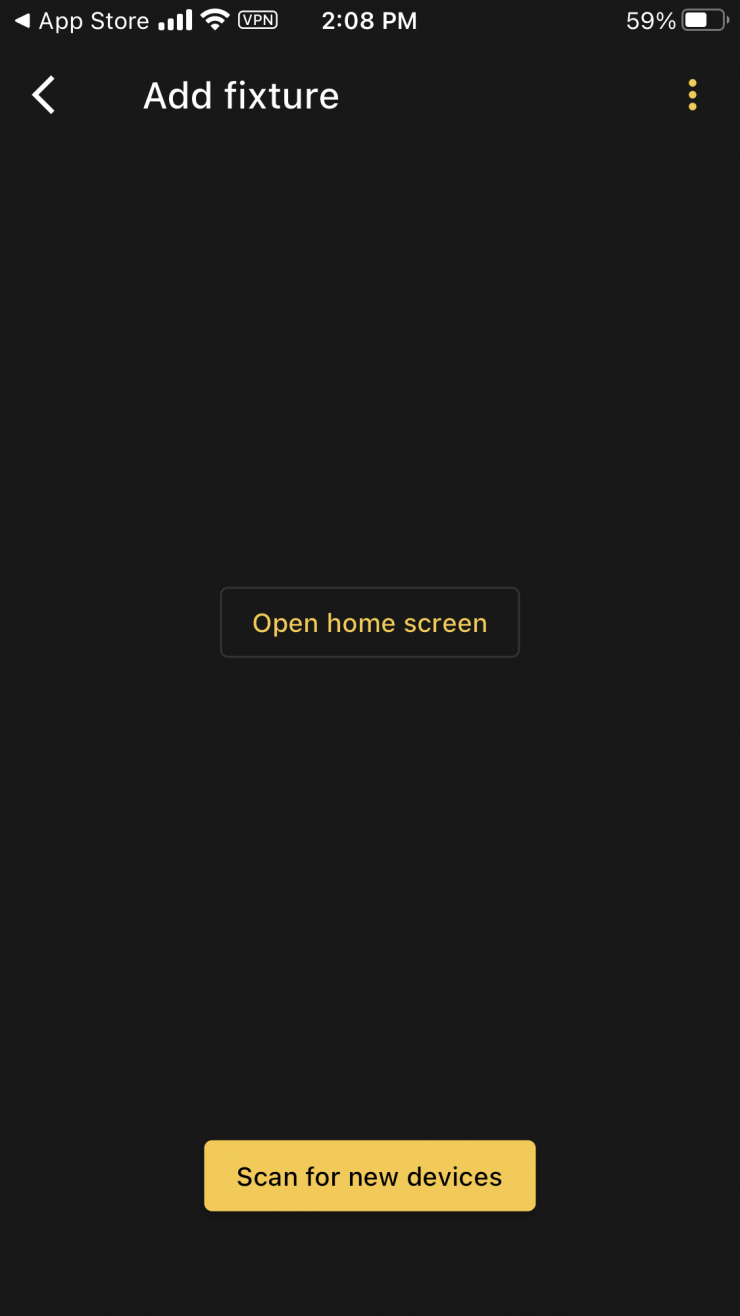
Once you hit connect you will be brought to his screen where you can simply click on Open Home Screen.
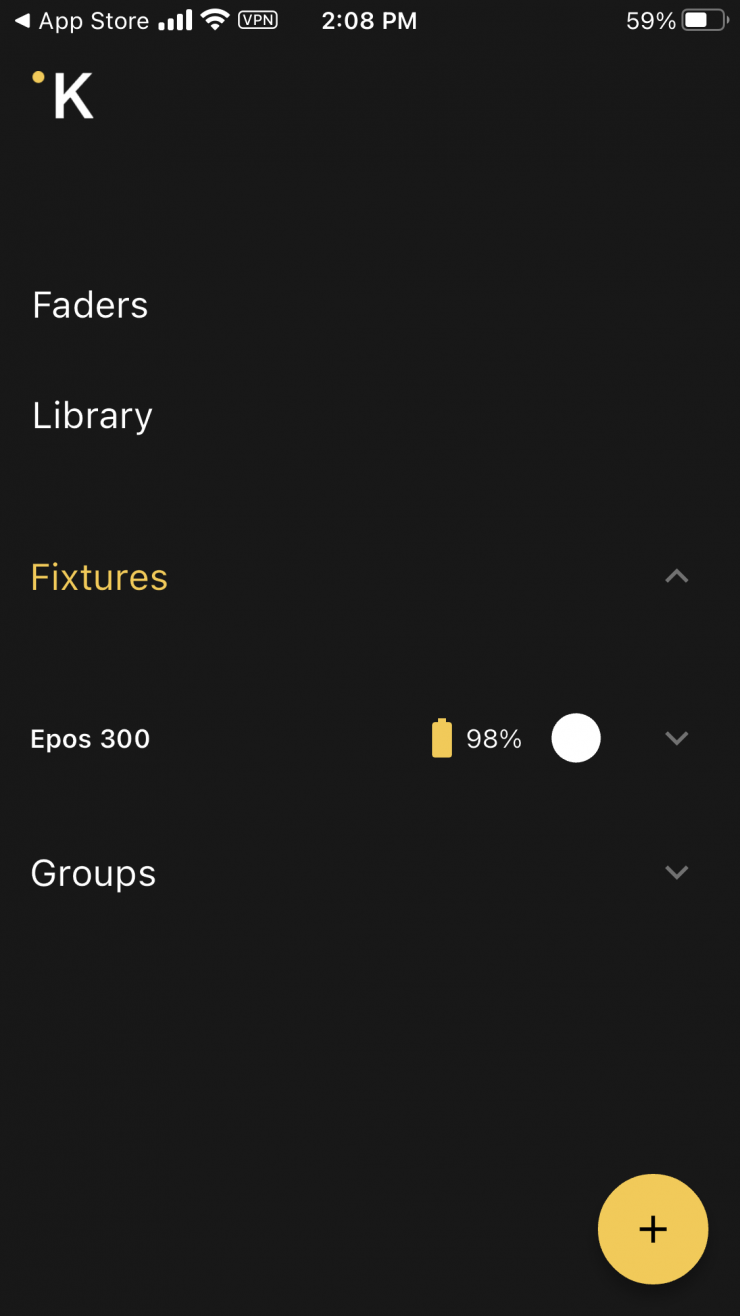
This takes you back to the home screen and then you need to click on the fixture you want to control.
Once you do, you are taken to the main operating page. In the default mode it will be on CCT. Here you can adjust the CCT, intensity, and +/- G/M bias. You can also choose from the Standard CCT range or the Extended CCT range. I can also see if the lamp head is attached, the temperature of the fixture, and the battery capacity if I am running it via camera batteries.
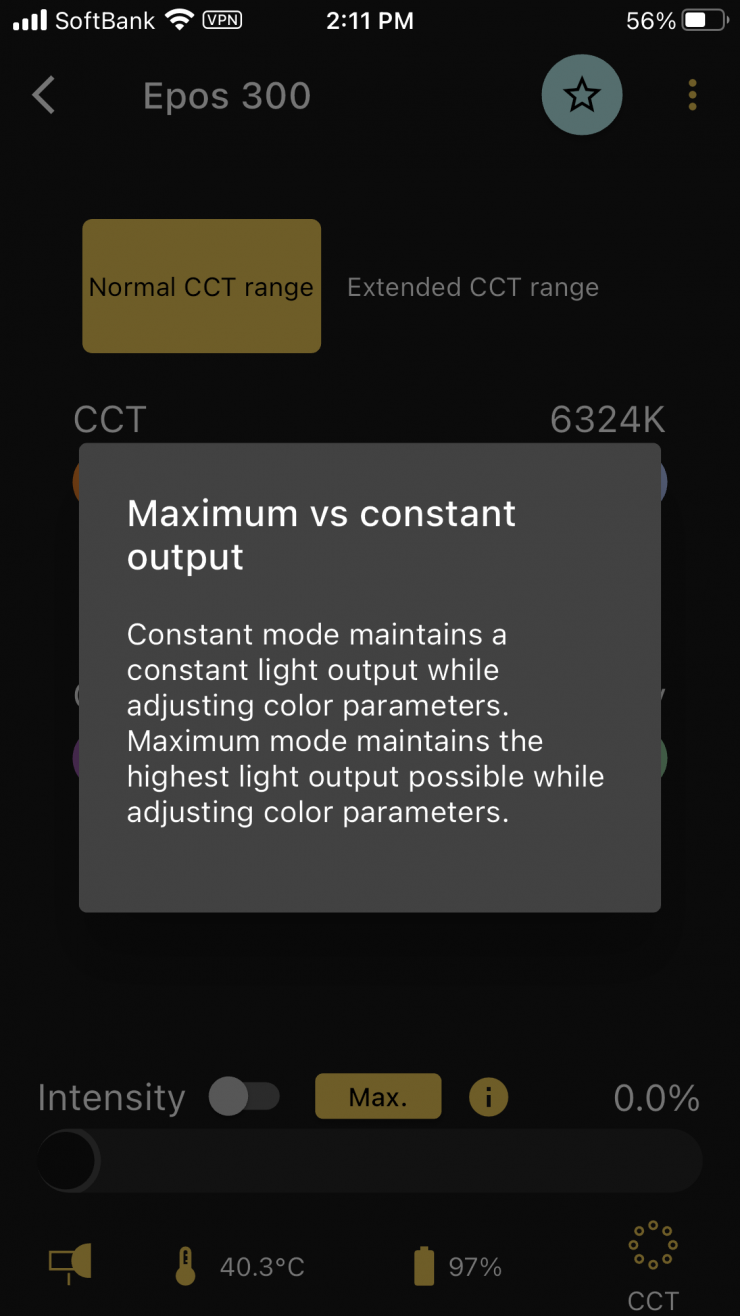
Now, if I press on the Max. or Constant Output I can change how the light performs and operates.
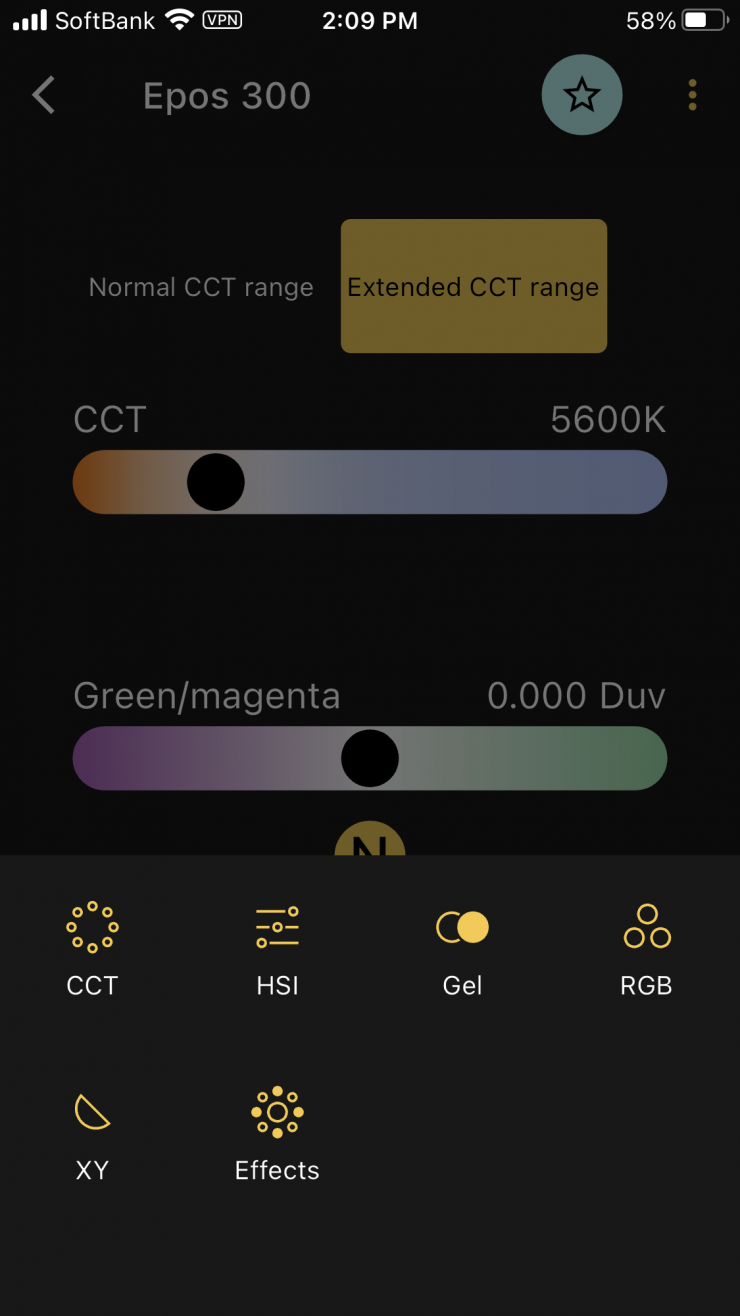
To change operating modes I can simply click on the CCT icon and then I will get the above menu.
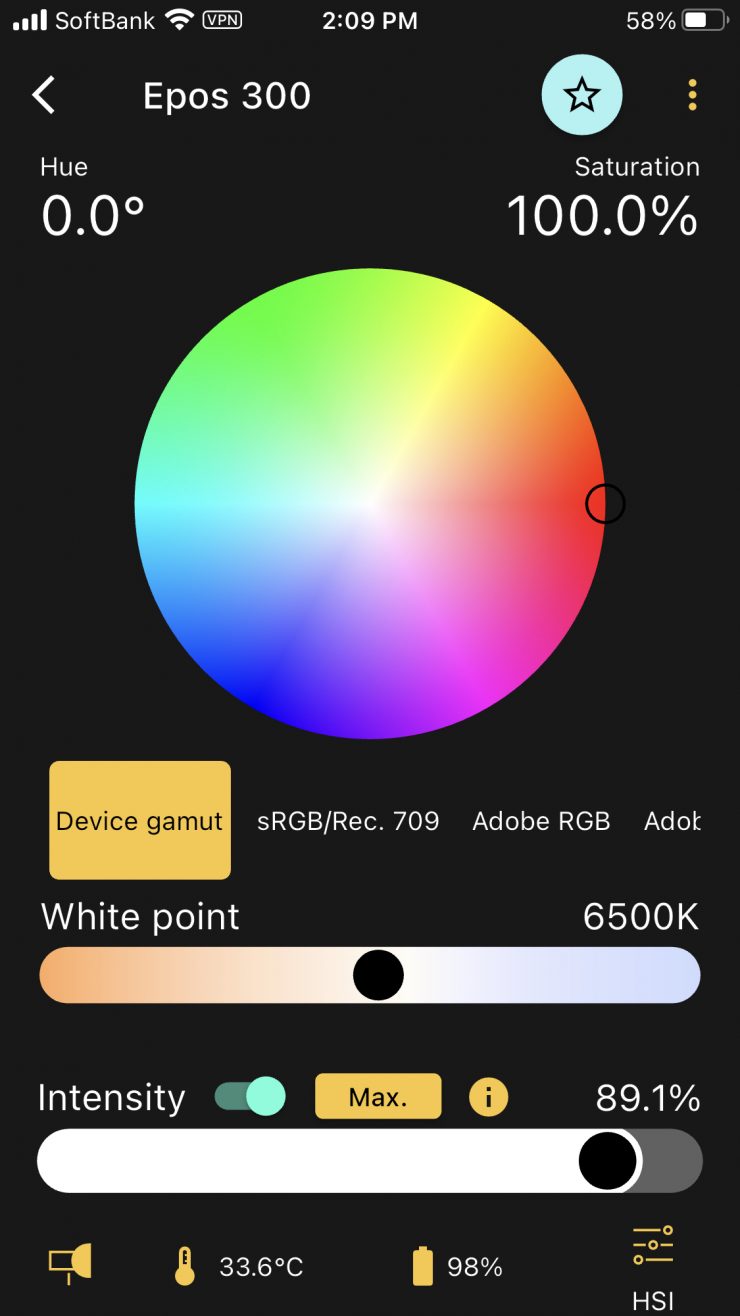
If you click on HSI you can adjust the Hue, Saturation, and Intensity of the light. You can also change the white point using the CCT slider. In a nice touch, there are also options to adjust the gamut.
If you click on Gel, you can choose from a vast array of digital gels that mimic industry-standard Lee and Rosco physical gels.
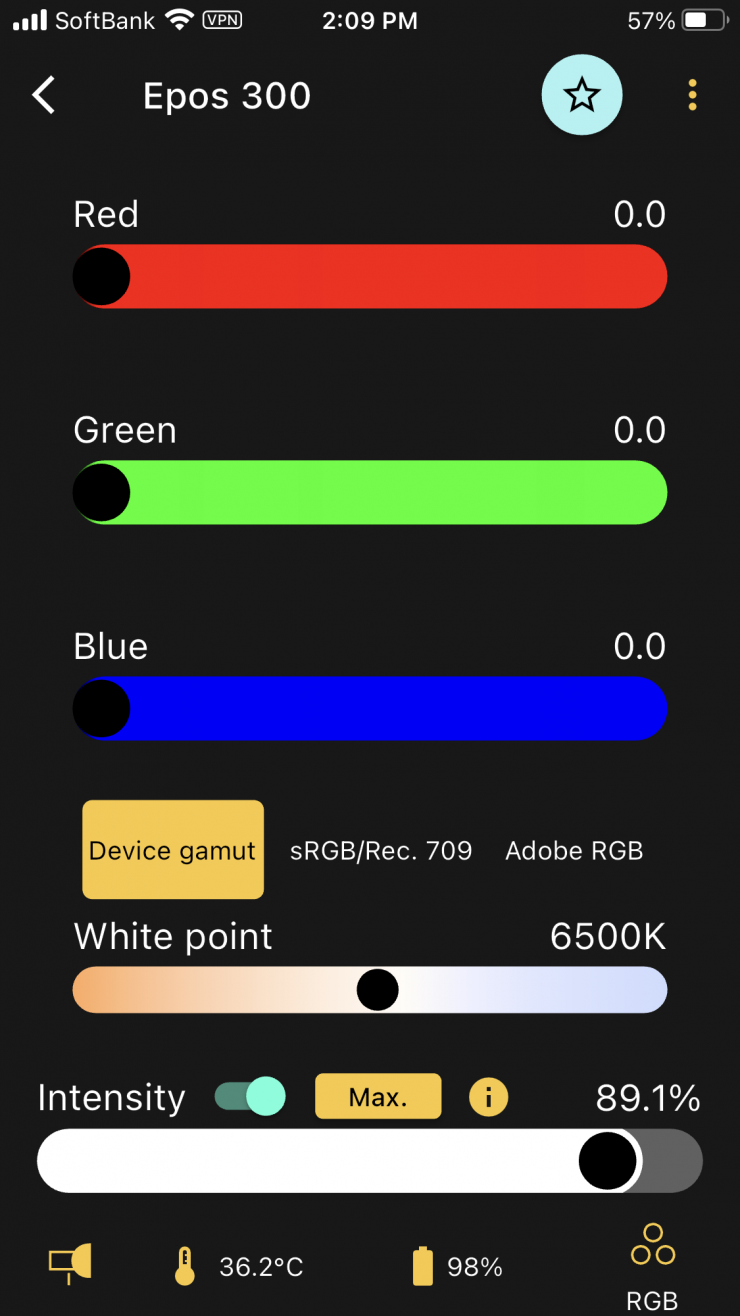
If you click on RGB you can adjust the individual Red, Green, and Blue channels. You can also adjust the white point using the CCT slider.
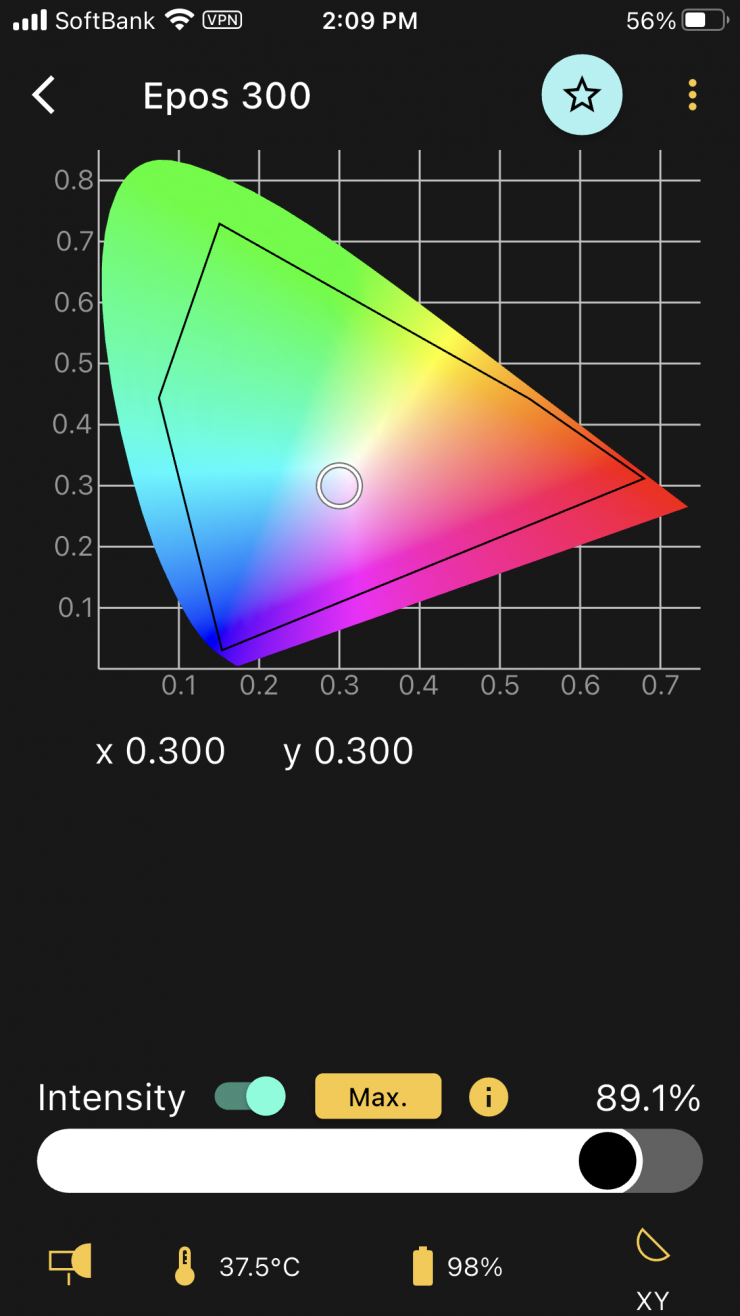
If you click on XY, you can manually adjust the x,y coordinates of the fixture.
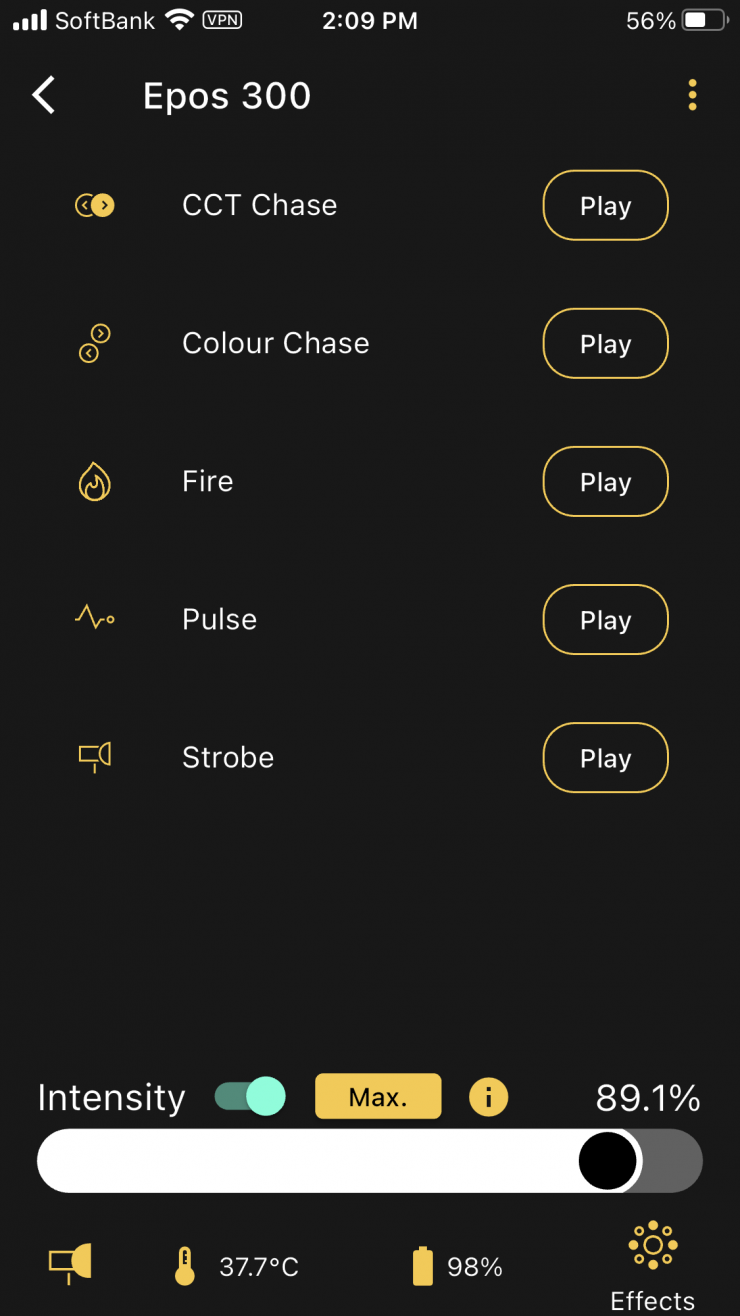
If you click on Effects you can choose from a reasonable selection of special effects.
There are some nice adjustments you can make to the individual effects.
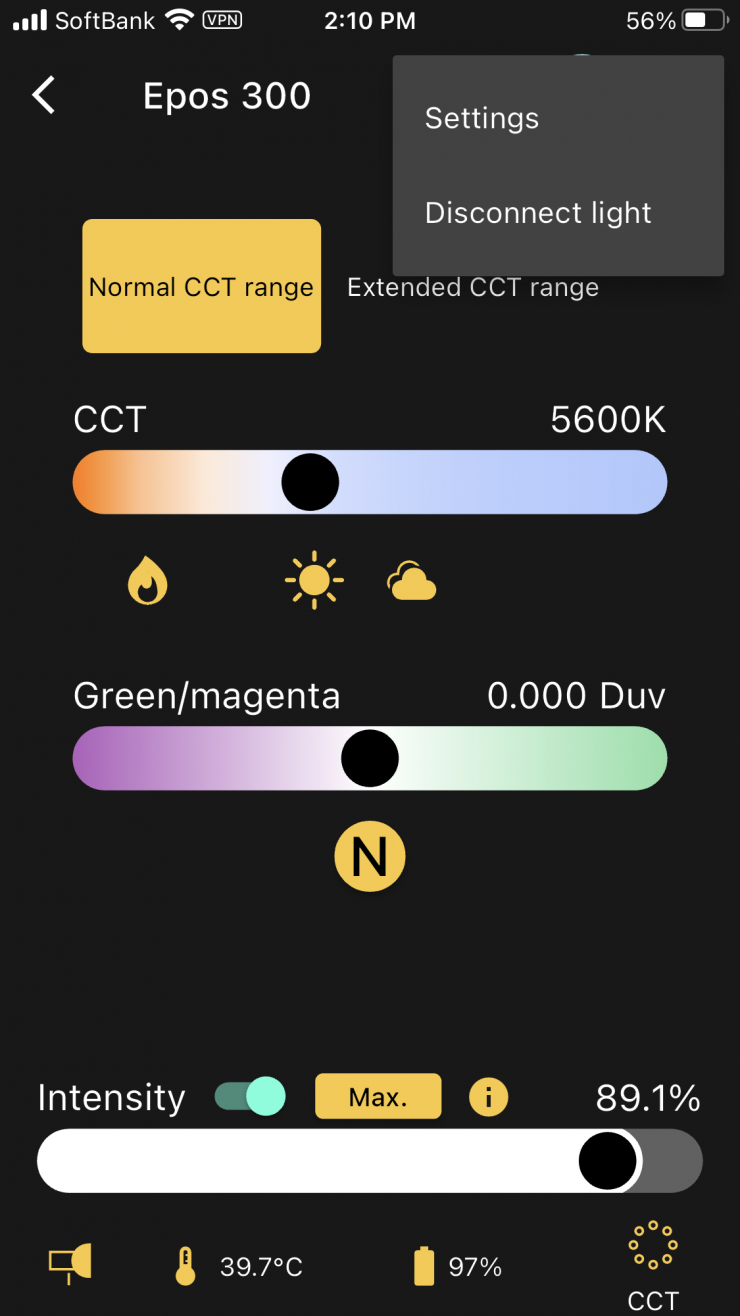
If you click on the three dots in the top right corner of the app you can disconnect from the light or go to the Settings page.
On the Settings page, you can see what the firmware you are running is, the temperature of the fixture, how many lights are connected to the app, and the battery level if you are not running it via mains power.
I like that you can save favorite presets and then bring them back up very quickly using the app. What is nice is that any preset, regardless of whether you create it on the controller or in the app, gets saved and can be recalled.
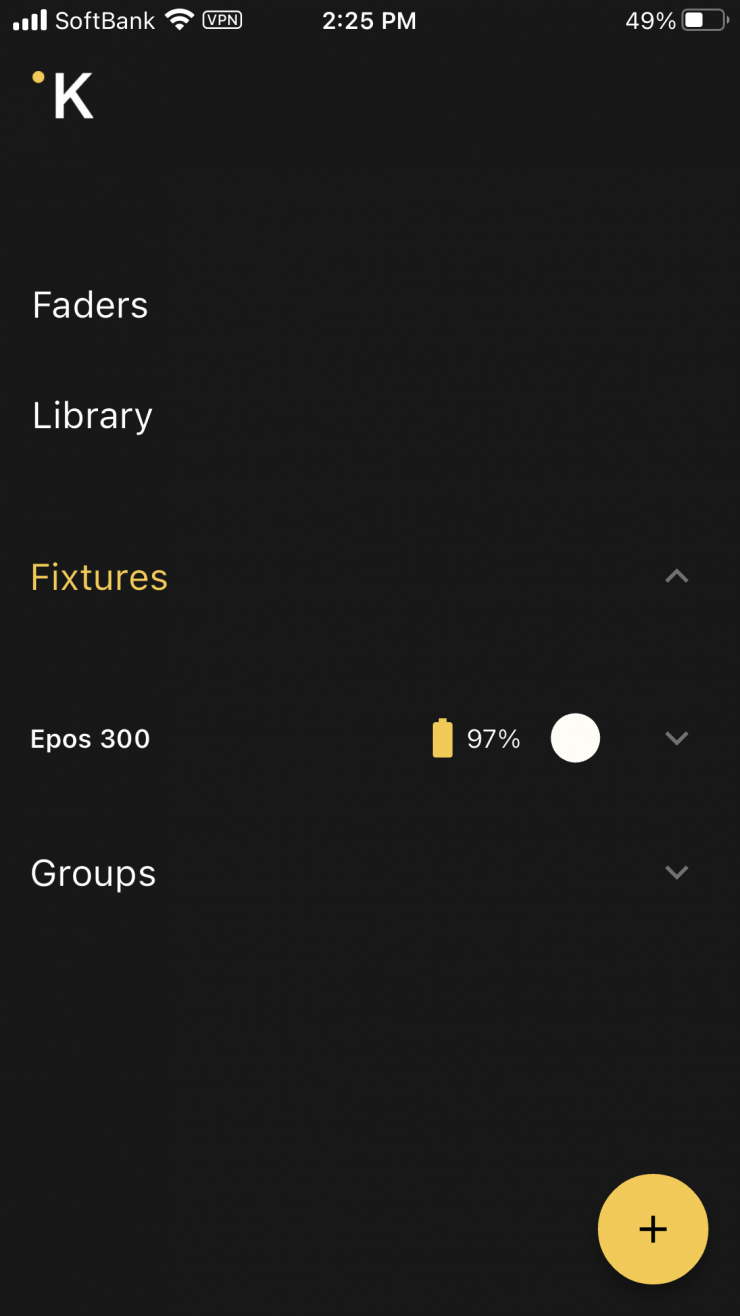
Now, you do need to go to the main menu and click on Library in the app to recall any presets you have saved.
What I like is that when you make a change using the Kelvin Narrator App, it is instantaneously reflected on the power supply/controller. Now, unfortunately, if you make a change on the power supply/controller directly, it doesn’t reflect what you have done on the app.
The app is straightforward and easy to use. I like how they have made it intuitive and visually appealing. Lighting control shouldn’t be overly complicated.
It is certainly one of the better lighting control apps I have seen or used.
Beam Angle
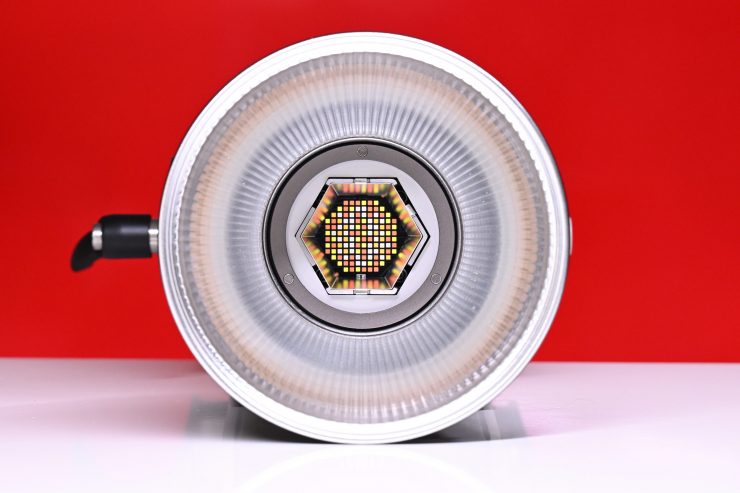
The native beam angle when the fixture is used open face is 93° which is a bit narrower than some of the other competing lights, however, it is wider than that of its closest competitor the Prolycht Orion 300 FS which has a beam angle of just 50 Degrees. When you use it with its included reflector the beam angle is 55°
Photometrics
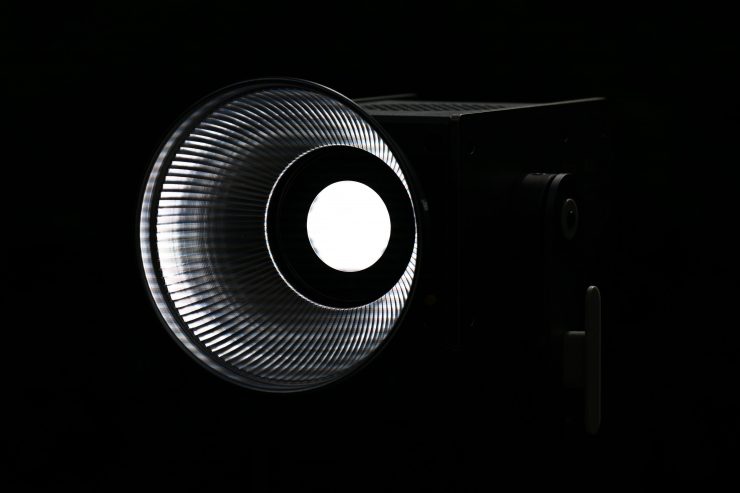
So now let’s get to the photometric results. I always test lights in this way so that I get a reference to how they compare to other fixtures. Results only tell part of the story and should never be used alone to judge a light. I have found from extensive testing over the years that certain lights that have good photometric results don’t always look good, and lights that have worse photometric scores can sometimes look better than their results indicate.
You can’t judge a light from one set of photometric results. You have to look at all of the different results to be able to come to a conclusion.
Different lights can also look different depending on what camera you happen to be using.
Output & Color Temperature Accuracy
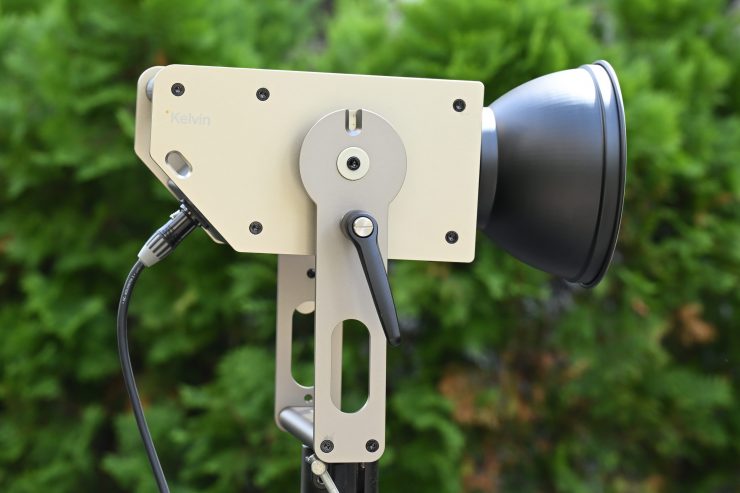
I tested the Kelvin Epos 300 at a variety of CCT settings with a Sekonic C-800 Spectrometer to find out how much output the light had and how accurate the Kelvin color temperature reproduction was. All readings are taken at a distance of 1m (3.28ft) in a controlled environment. The readings were also taken directly from the lighting source. In the case of using the light with the Reflector, the readings were taken from the edge of the attachments.
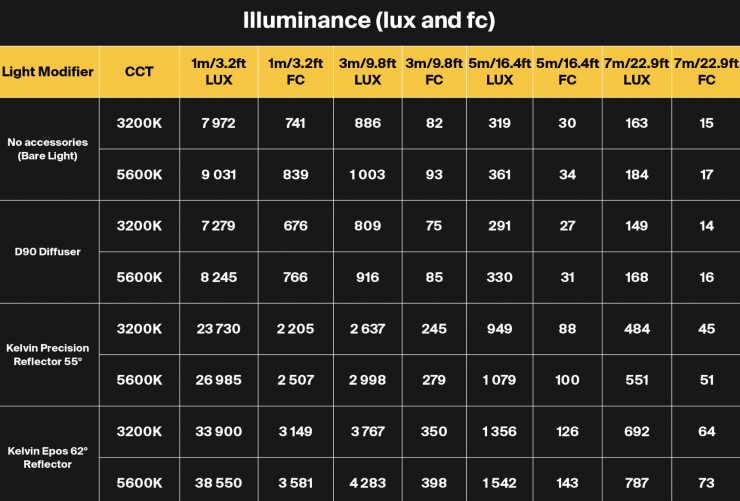
Above you can see the claimed output figures from the manufacturer.
Kelvin Epos 300 5600K (Open Face Medium Diffusion)
Let’s first look at the light when it is used open face with its Medium Diffusion. This is the default diffusion that comes on the light.
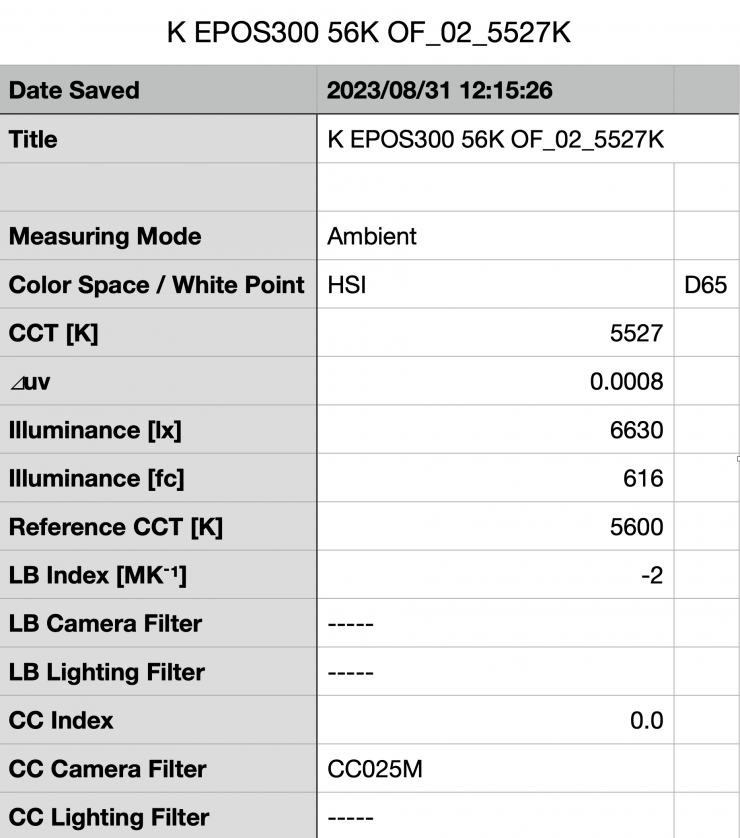
Above you can see that the Kelvin Epos recorded an output of 6,630 lx (616 fc) when set at 5600K and used open face with its Medium Diffusion.
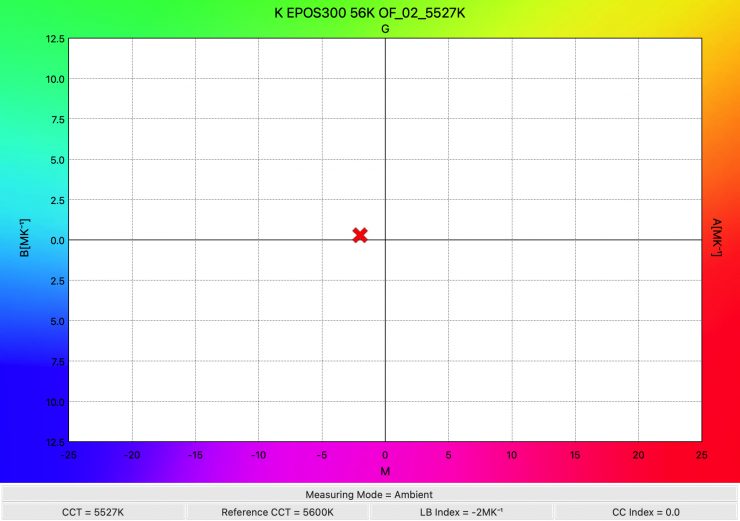
The light recorded a CCT reading of 5527K which was pretty good.
Kelvin Epos 300 3200K (Open Face Medium Diffusion)
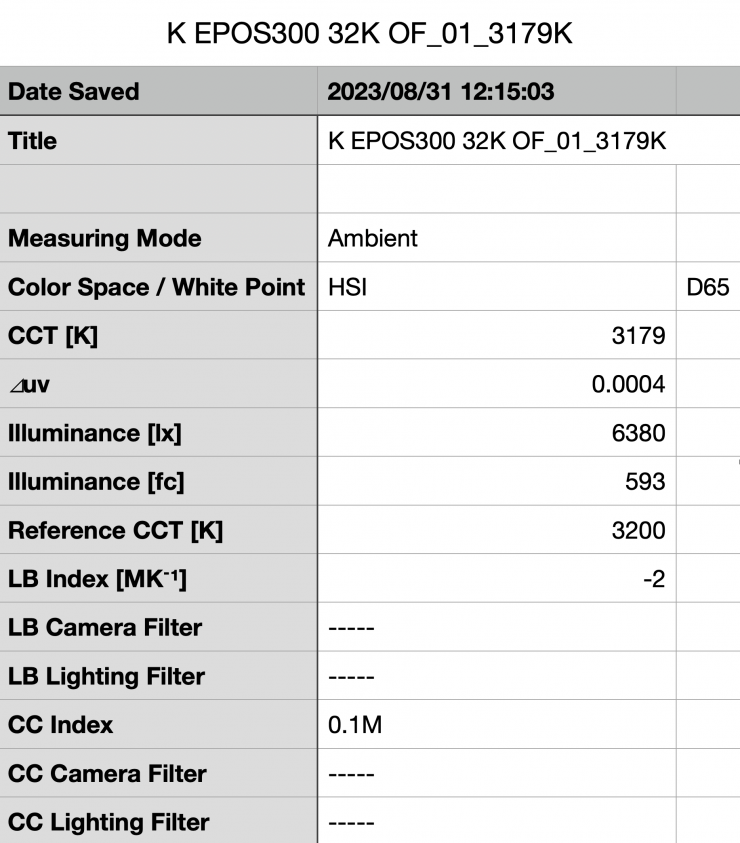
Above you can see the light’s output when it was set at 3200K in the open face configuration with the medium diffusion was 6380 lx (593fc), which is 3.77% less than the 6630 lx it produced at 5600K.
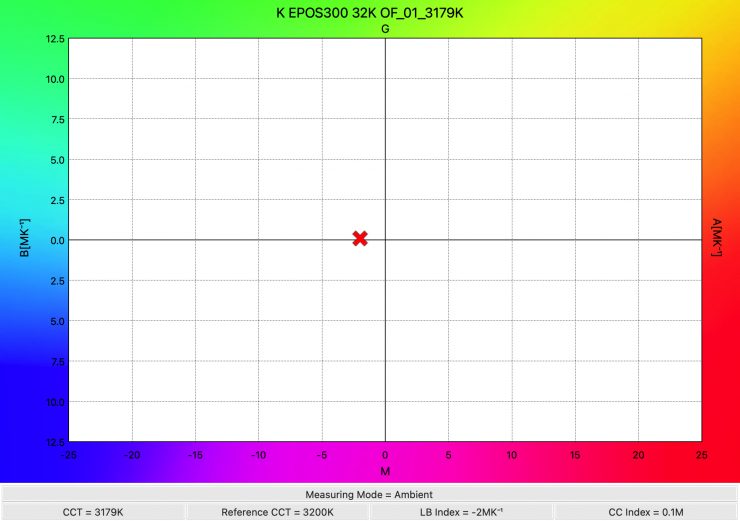
As far as CCT accuracy goes, it recorded a very accurate reading of 3179K.
Summary of results (medium diffusion)
| OUTPUT | CCT | |
| 2500K | 5480 lx | 2503K |
| 3200K | 6380 lx | 3179K |
| 4500K | 6640 lx | 4458K |
| 5600K | 6630 lx | 5779K |
| 6500K | 6640 lx | 6397K |
| 8000K | 6610 lx | 7837K |
| 10000K | 6610 lx | 9753K |
Above you can see a summary of results when the light was used with its medium diffusion at various CCT settings.
The results show me that the light’s CCT accuracy when using the diffusion is good up until about 4500K. Above 4500K it isn’t nearly as good. Yes, anytime you put anything in front of a light it will alter the CCT, but nonetheless, this is something you need to be very aware of.
What was nice to see is that the light’s output is very, very consistent across the CCT settings I tested. From 4500K to 10000K it only varied by 30 lx.
Standard 55° Reflector & Medium Diffusion
So, now let’s see how much output the light has when used with its standard 55° reflector & medium Diffusion.
Kelvin Epos 300 5600K (standard 55° reflector & medium Diffusion)
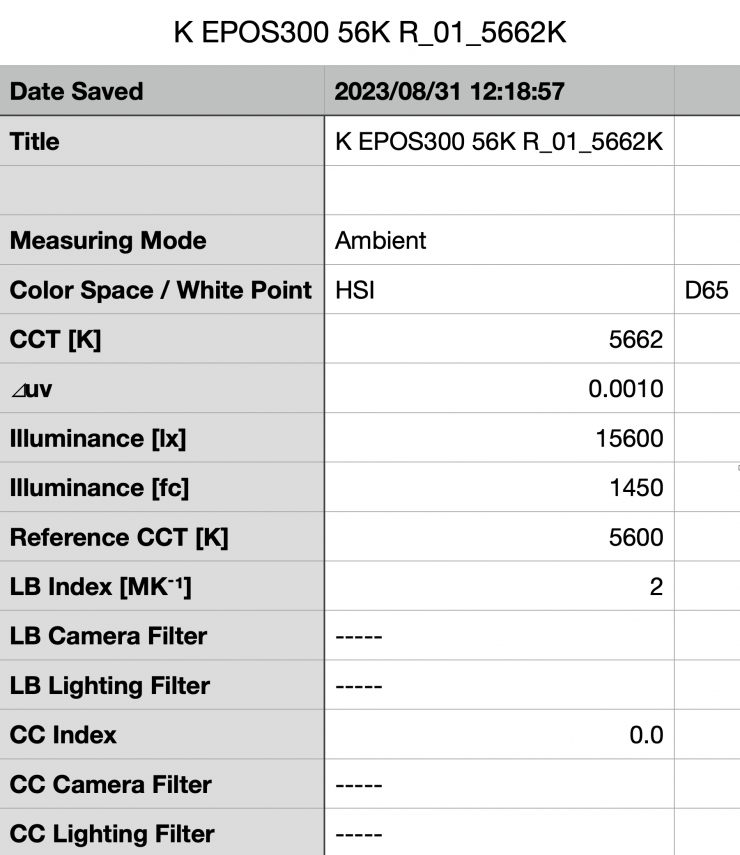
Above you can see the light’s output when it was set at 5600K with the standard reflector and medium diffusion was 15,600 lx (1450 fc). It is important to note that this measurement was made 1m/ 3.3′ from the end of the reflector.
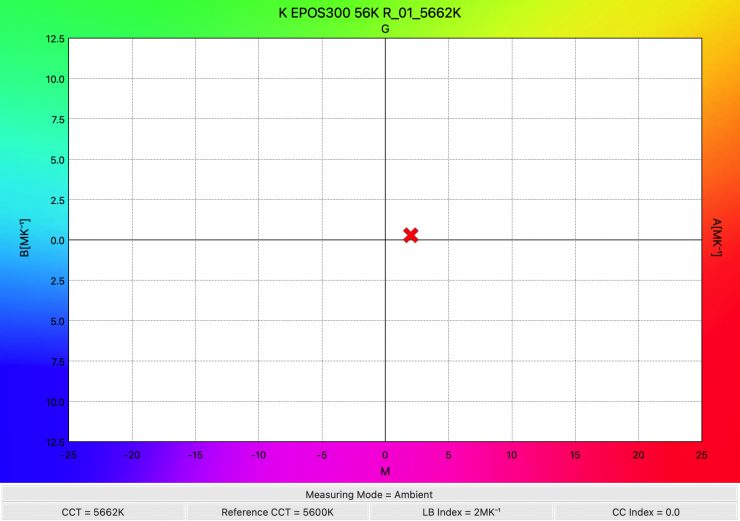
As far as CCT accuracy goes, it recorded a very accurate reading of 5662K.
Kelvin Epos 300 5600K (standard 55° reflector & medium Diffusion)
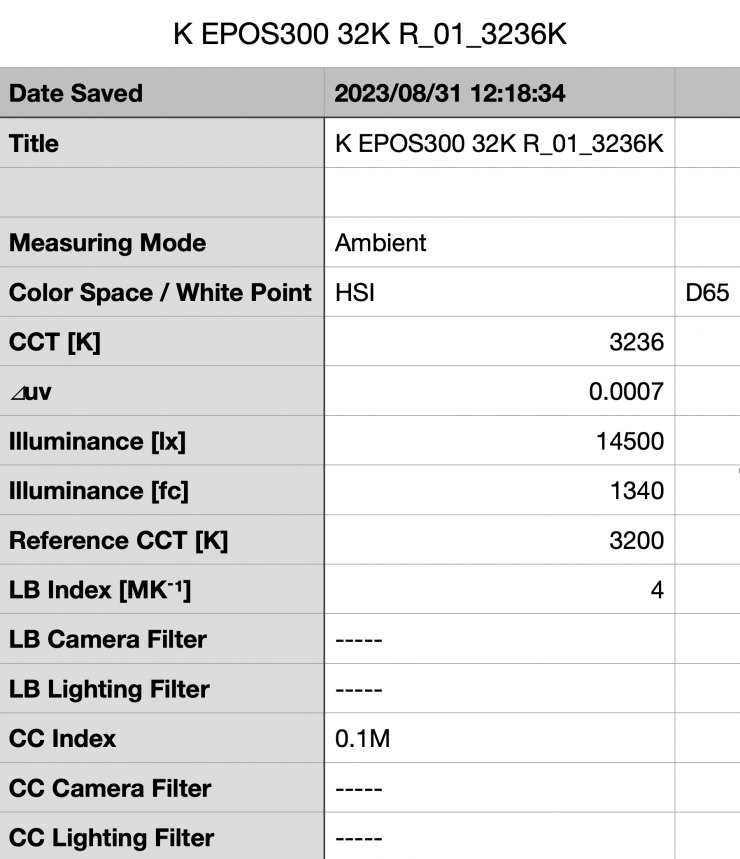
Above you can see the light’s output when it was set at 3200K with the standard reflector and medium diffusion was 14,500 lx (1340 fc), which was 7.05% less than what it output at 5600K.
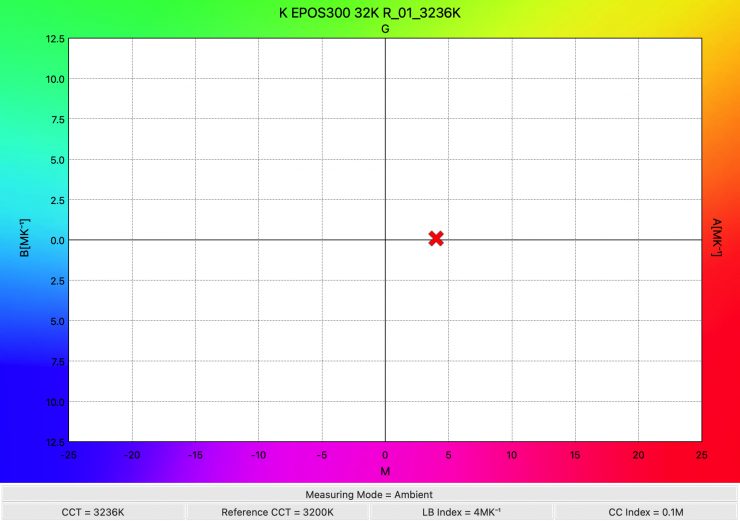
As far as CCT accuracy goes, it recorded a reading of 3236K which was a very good score.
Summary of results (55° reflector & medium diffusion)
| OUTPUT | CCT | |
| 2500K | 12,400 lx | 2578K |
| 3200K | 14,500 lx | 3236K |
| 4500K | 15,500 lx | 4544K |
| 5600K | 15,600 lx | 5662K |
| 6500K | 15,600 lx | 6566K |
| 8000K | 15,600 lx | 8093K |
| 10000K | 15,600 lx | 10162K |
Above you can see a summary of results when the light was used with its reflector and medium diffusion at various CCT settings.
The results show me that the light’s CCT accuracy when using the standard 55° reflector and the medium diffusion was excellent. What also impressed me, was that the output was super consistent from 3200-10000K. These were outstanding results.
Kelvin Epos 300 Standard 55° Reflector & Medium Diffusion (Max. Mode)
Okay, now, let’s look at the Kelvin Epos 300 Standard 55° Reflector & Medium Diffusion when set in its Max. Mode to see how much more output it has.
Kelvin Epos 300 Standard 5600K 55° Reflector & Medium Diffusion (Max. Mode)
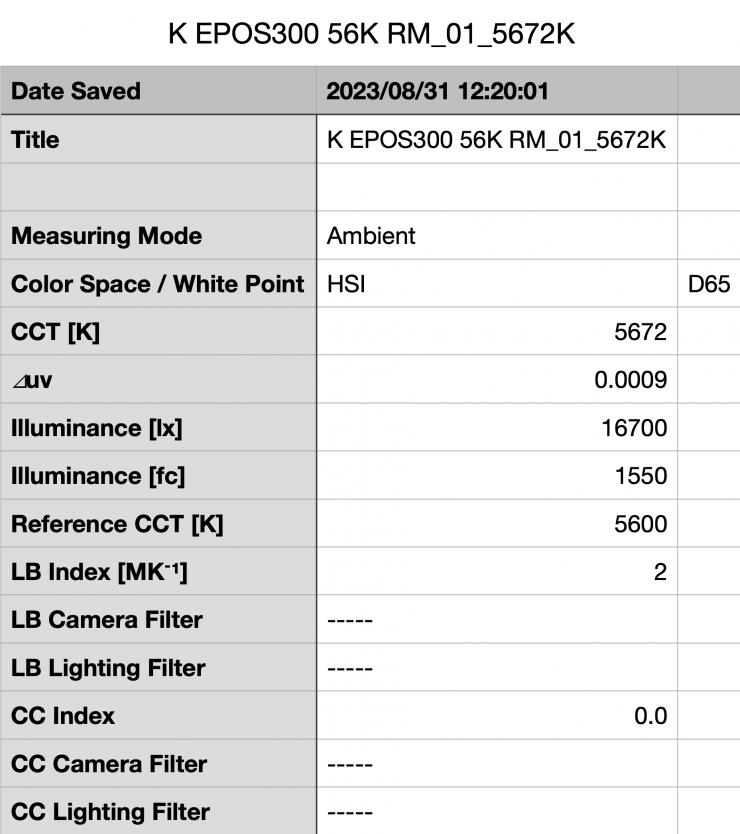
Above you can see the light’s output when it was set at 5600K in its Max. Mode with the standard reflector and medium diffusion was 16,700 lx (1550 fc).
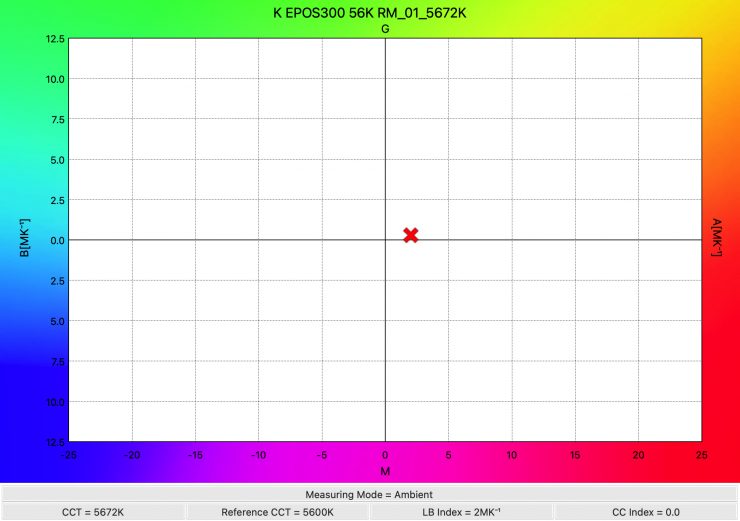
As far as CCT accuracy goes, it recorded a reading of 5672K which was a very good score and only 10K different from its reading in the Constant mode.
Kelvin Epos 300 Standard 3200K 55° Reflector & Medium Diffusion (Max. Mode)
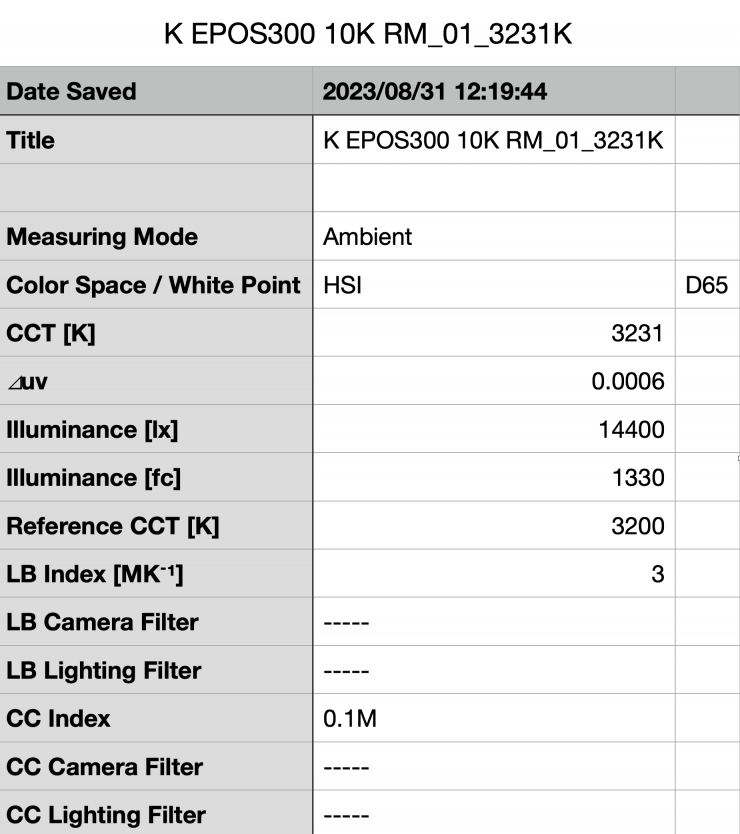
Above you can see the light’s output when it was set at 3200K in its Max. Mode with the standard reflector and medium diffusion was 14,400 lx (1330 fc), which was actually 0.68% less than what it output in its Constant Mode. I couldn’t understand why it was actually lower, but I double-checked the test just to be sure.
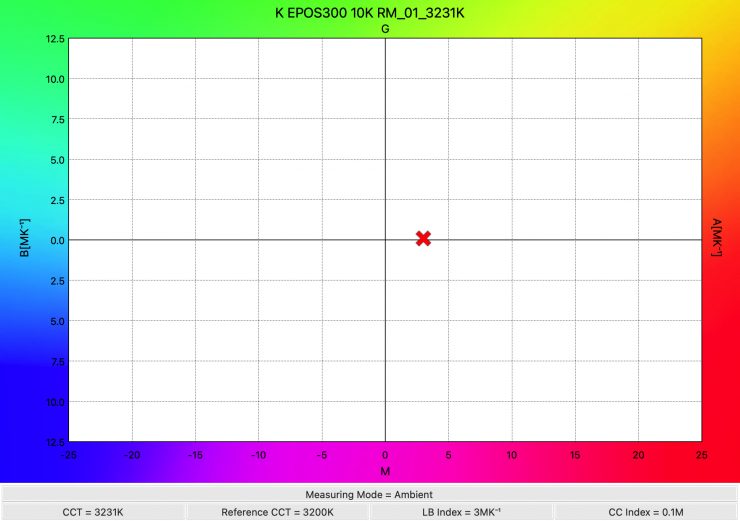
As far as CCT accuracy goes, it recorded a reading of 3231K which was a very good score and only 5K different from its reading in the Constant mode.
These results clearly show me that the CCT doesn’t get altered when you use the Max. Mode instead of the Constant Mode.
Standard 55° Reflector
So, now let’s see how much output the light has when used with its standard 55° reflector and no diffusion.
Kelvin Epos 300 5600K (standard 55° reflector )
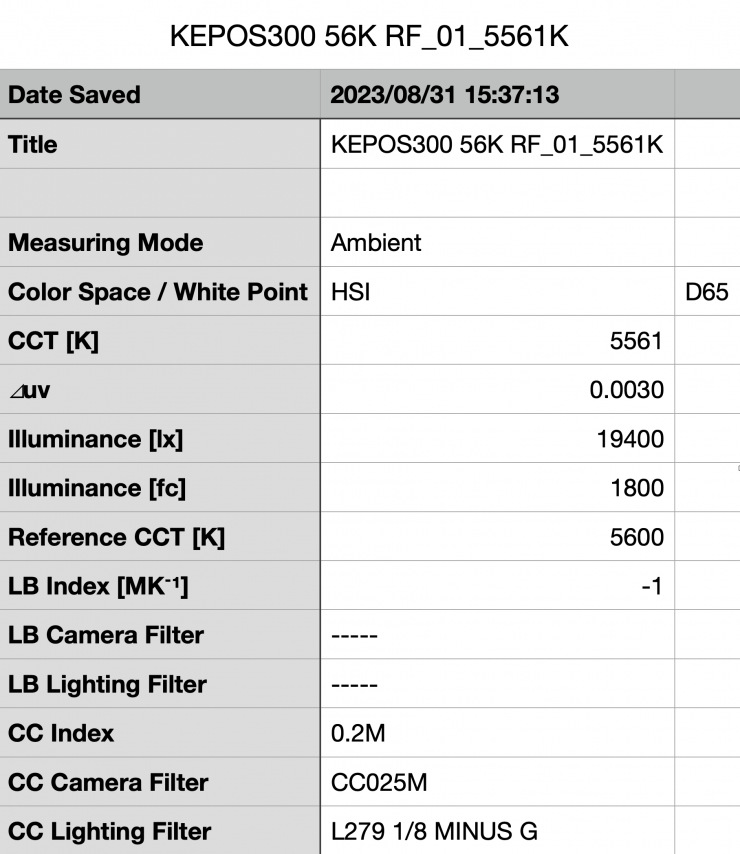
Above you can see the light’s output when it was set at 5600K with the standard reflector was 19,400 lx (1800 fc). It is important to note that this measurement was made 1m/ 3.3′ from the end of the reflector.
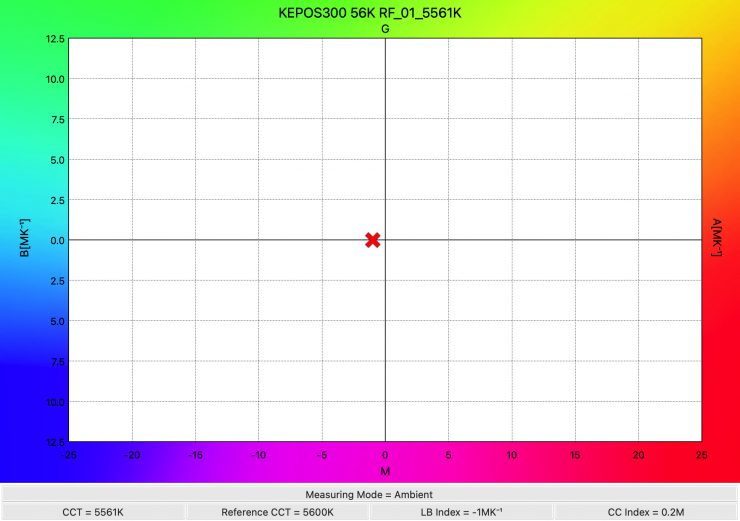
As far as CCT accuracy goes, it recorded a very accurate reading of 5561K.
Kelvin Epos 300 3200K (standard 55° reflector)
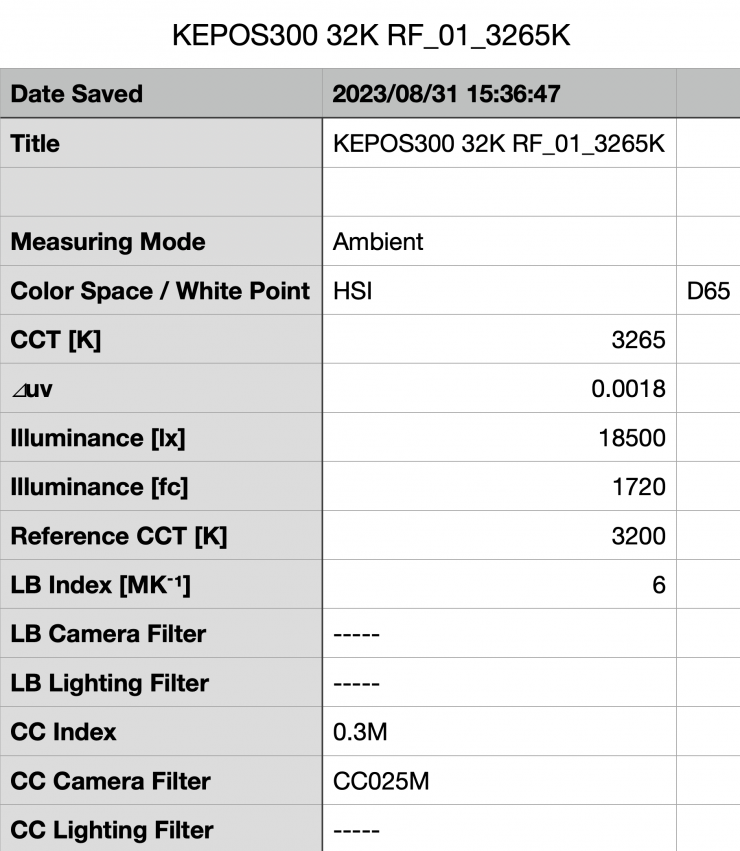
Above you can see the light’s output when it was set at 3200K with the standard reflector and medium diffusion was 18,500 lx (1720 fc), which was just 4.63% less than what it output at 5600K.
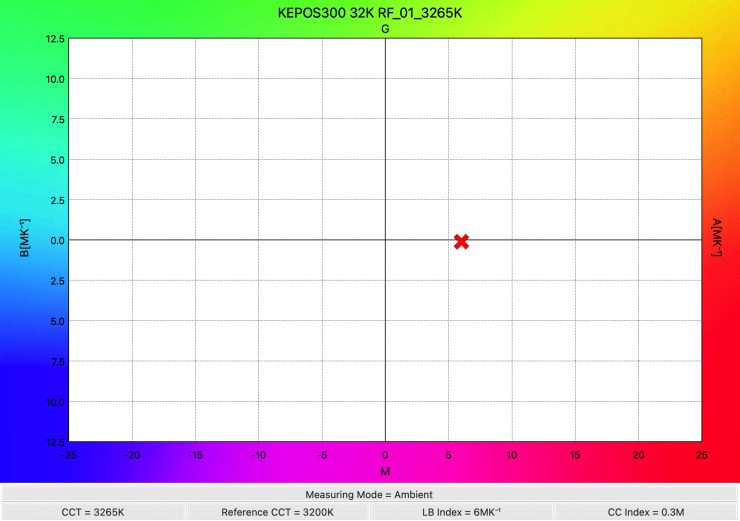
As far as CCT accuracy goes, it recorded a reading of 3265K which was a very good score.
Now, these readings were substantially lower than the manufacturer’s claimed figures, but I think their measurements were taken from the COB and not the end of the reflector. I am also doing these teats in a 110V country, so the figures will be slightly less.
Summary of results (55° reflector)
| OUTPUT | CCT | |
| 2500K | 15,700 lx | 2575K |
| 3200K | 18,500 lx | 3265K |
| 4500K | 19,300 lx | 4522K |
| 5600K | 19,400 lx | 5561K |
| 6500K | 19,400 lx | 6389K |
| 8000K | 19,200 lx | 7784K |
| 10000K | 19,100 lx | 9630K |
Above you can see a summary of results when the light was used with its reflector at various CCT settings.
The results show me that the light’s CCT accuracy when using the standard 55° reflector was excellent from 2500-5600K, however, above 5600K it wasn’t that good. What impressed me, was that the output was super consistent from 3200-10000K.
How does this compare to some of the competitors? Below you can see:
5600K
| Output at 5600K | CCT (K) | |
| Kelvin Epos 300 | 19,400 lx (55° reflector) | 5561K |
| Prolycht Orion 300 FS | 25,900 lx (55° reflector) | 5665K |
| amaran 300c RGB | 26,580 lx* (65° reflector) | NA |
| Lupo Movielight 300 Full Color PRO | 28,600 lx (55° reflector) | 5779K |
| Aputure Light Storm 300x | 17,500 lx (hyper reflector) | 5295K |
3200K
| Output at 3200K | CCT (K) | |
| Kelvin Epos 300 | 18,500 lx (55° reflector) | 3265K |
| Prolycht Orion 300 FS | 25,000 lx (standard reflector) | 3148K |
| amaran 300c RGB | 21,390 lx* (65° reflector) | NA |
| Lupo Movielight 300 Full Color PRO | 28,200 lx (55° reflector) | 3139K |
| Aputure Light Storm 300x | 15,100 lx (hyper reflector) | 3144K |
*Manufacturers claims, not independently tested
As you can see, the competing fixtures all have more output than the Kelvin Epos 300 when used with their 55-degree reflectors.
Below you can see how the output of the Kelvin Epos 300 compares to some HMI fixtures at a distance of 3m.
| OUTPUT @5600K 3m / 9.9′ | |
| Kelvin Epos 300 (55° reflector) | 2155 lx |
| ARRI M8 (Standard 60° reflector) | 4589 lx |
| K 5600 Lighting Joker 2 400W (50° super wide) | 2400 lx |
| K 5600 Lighting Joker 2 800W (50° super wide) | 5560 lx |
Please note that the readings from the two K 5600 Lighting options and the ARRI M8 are claimed figures. I haven’t independently tested these lights.
While the Kelvin Epos 300 is quite different from a light like the Joker2 and M8, at least you can get some idea of how its output compares.
Kelvin Epos 300 55° reflector (Max. Mode)
Okay, how about if we now look at the light being used with its 55° reflector in its Max. Mode.
Kelvin Epos 300 55° reflector (Max. Mode)
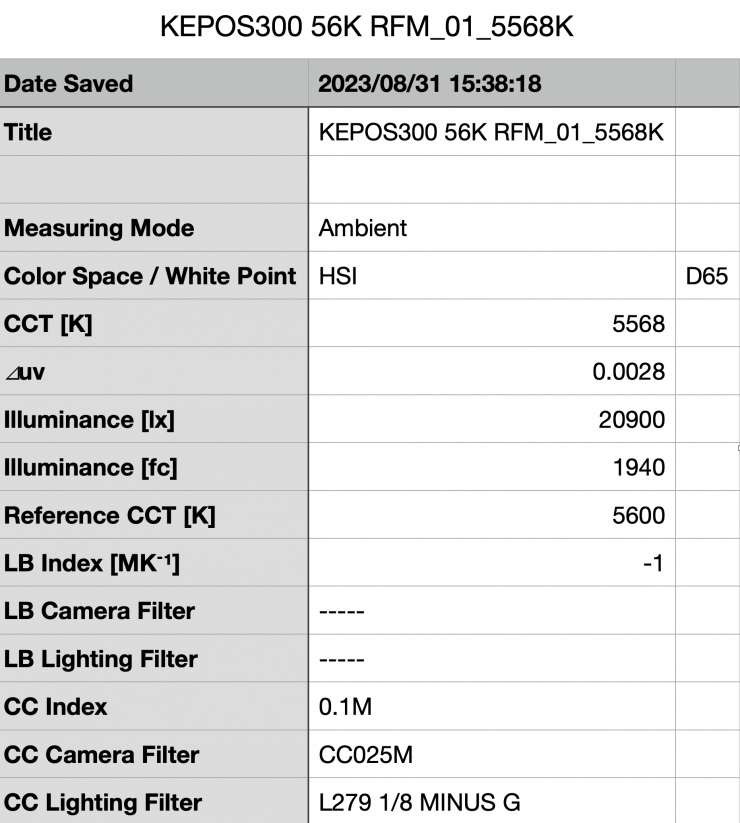
Above you can see the light’s output when it was set at 5600K in its Max. Mode with the standard reflector was 20,900 lx (1940 fc). This was 7.73% more than its output in the Constant Mode.
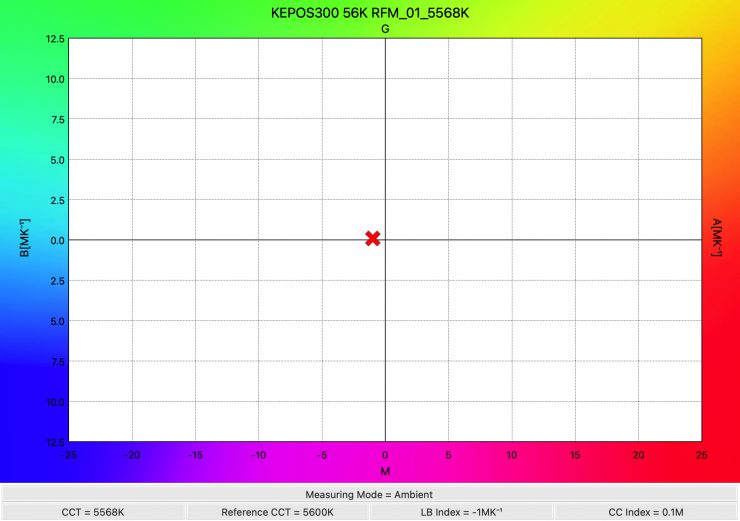
As far as CCT accuracy goes, it recorded a very accurate reading of 5568K. This was only 7K different from using the light in its Constant Mode.
Kelvin Epos 300 3200K 55° reflector (Max. Mode)
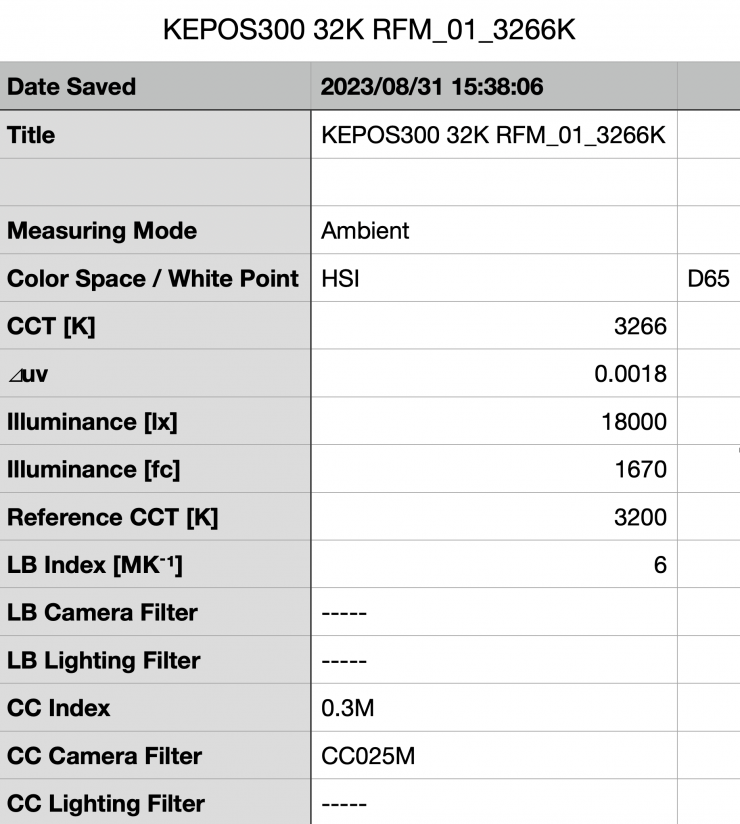
Above you can see the light’s output when it was set at 3200K in its Max. Mode with the standard reflector was 18,000 lx (1720 fc), which was 7.21% less than what it output at 5600K.
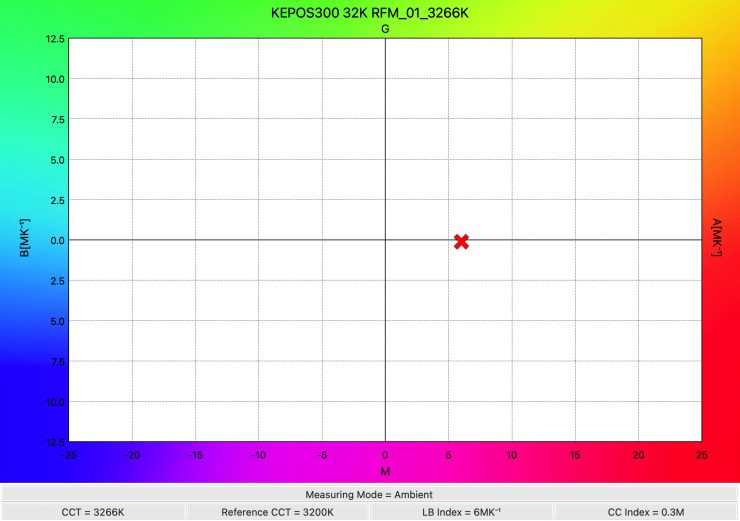
As far as CCT accuracy goes, it recorded a reading of 3266K which was just 1K different from when the light was used in the Constant mode.
Kelvin Epos 300 5600K 62° Reflector (Bare)
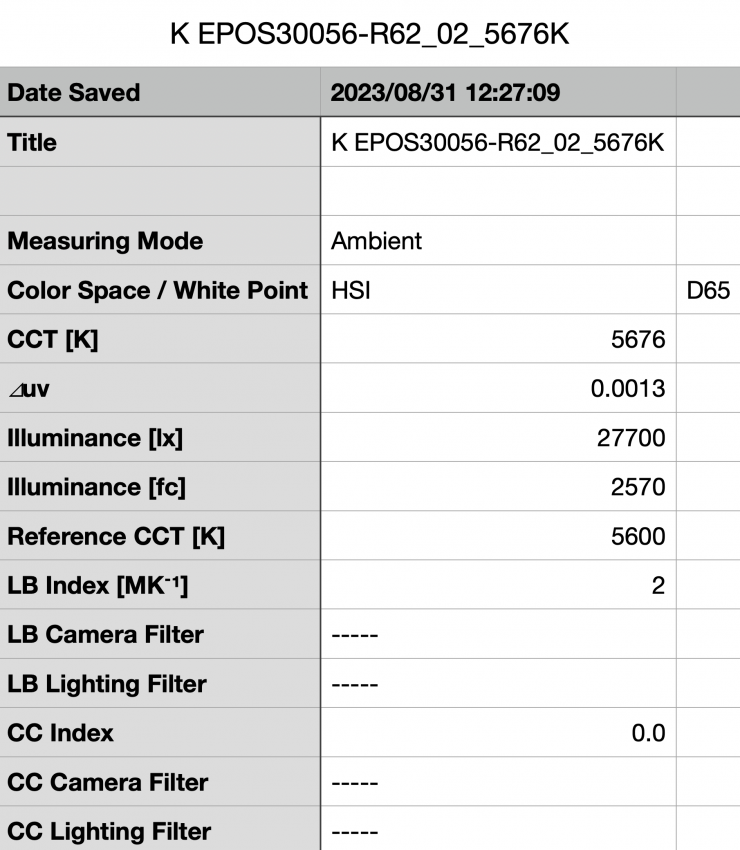
Above you can see that the Kelvin Epos 300 when set at 5600K using the 62° Reflector had an output of 27,700 lx (2570 fc). Now, this was 77.56% more than its output when using the 55° reflector. At first, it makes no sense as to why a 62° reflector has way more output than a 55° reflector, however, the 62° reflector uses a slightly different design and it has quite a pronounced hot spot in the middle.
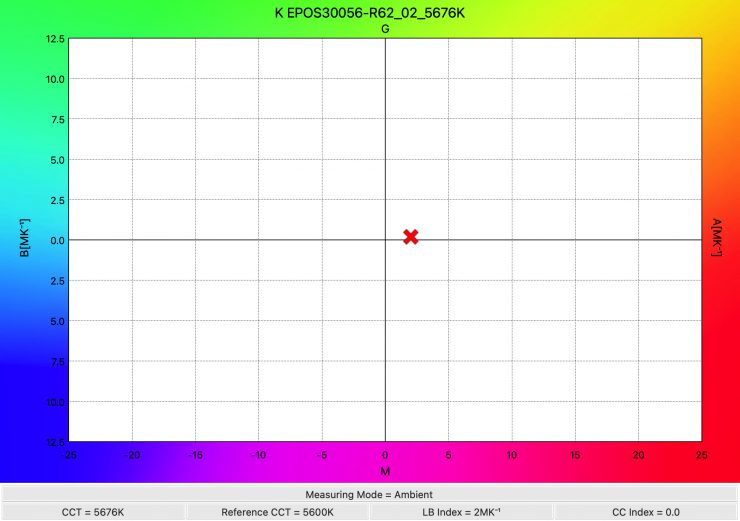
As far as CCT accuracy goes, it recorded a reading of 5676K which was quite different from the 5561K reading it recorded when using the 55° reflector.
How does this compare to some of the competitors? Below you can see:
5600K
| Output at 5600K | CCT (K) | |
| Kelvin Epos 300 | 27,700 lx (62° reflector) | 5675K |
| Prolycht Orion 300 FS | 25,900 lx (55° reflector) | 5665K |
| amaran 300c RGB | 26,580 lx* (65° reflector) | NA |
| Lupo Movielight 300 Full Color PRO | 28,600 lx (55° reflector) | 5779K |
| Aputure Light Storm 300x | 17,500 lx (hyper reflector) | 5295K |
*Manufacturers claims, not independently tested
Battery Output
As the fixture can be run off a variety of different batteries let’s have a look at what the output is when doing so.
Kelvin Epos 300 5600K Reflector & Medium Diffusion (Single SWIT PB-C420S 420Wh 14.4V Battery)
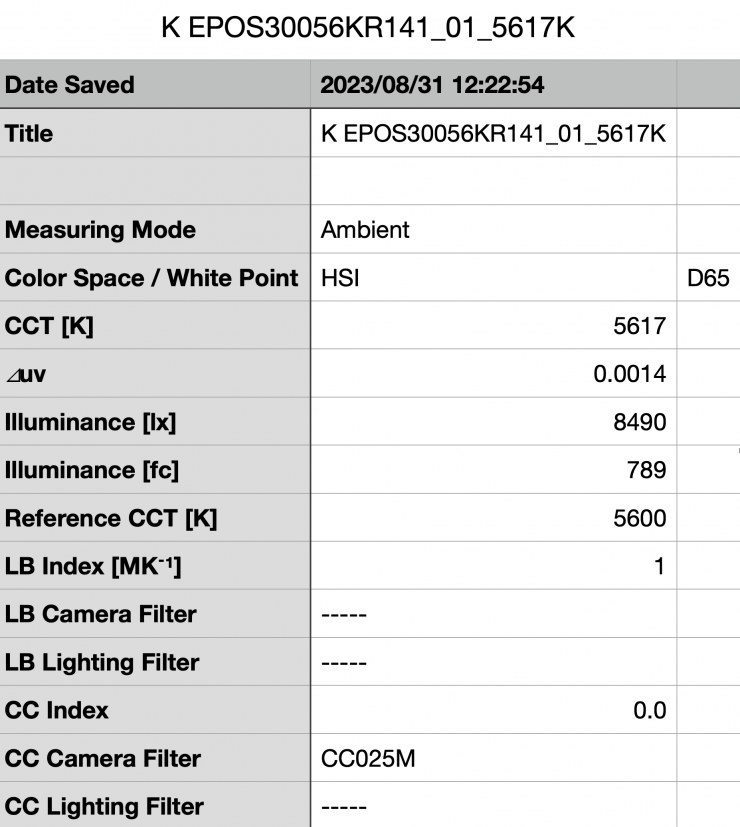
Above you can see the light’s output when it was set at 5600K and run via single 420Wh 14.4V battery was 8490 lx (789 fc), which was 45.57% less than what it output using mains power.
Kelvin Epos 300 5600K Reflector & Medium Diffusion (Single SWIT PB-C420S 420Wh 14.4V Battery & Anton Bauer Cine 150Wh Battery)
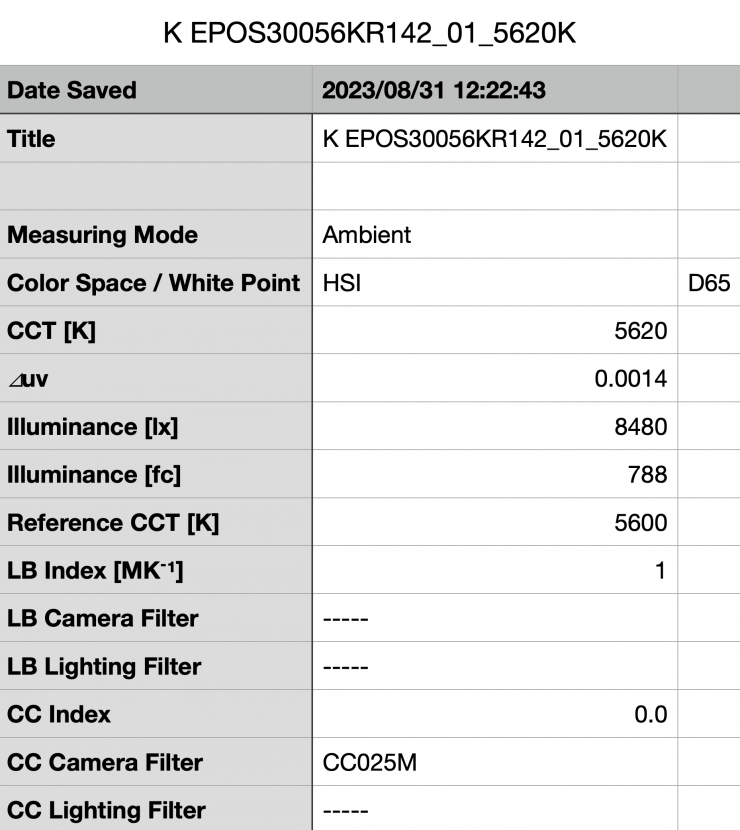
Above you can see the light’s output when it was set at 5600K and run via a 420Wh 14.4V battery and a 150Wh 14.4V battery was 8490 lx (789 fc). This is exactly the same as when I ran it off the single 420Wh battery.
Kelvin Epos 300 5600K Reflector & Medium Diffusion (Single SWIT HB-C420S 420Wh 28.8V Battery)
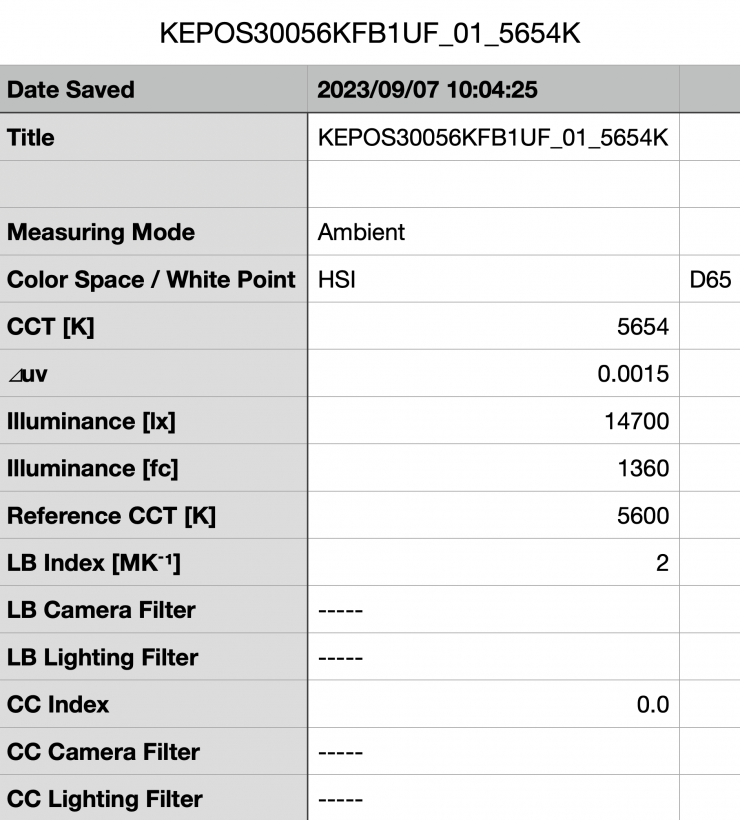
Above you can see the light’s output when it was set at 5600K and run via a single 420Wh 28.8V battery was 14,7000 lx (1360 fc). When run via mains power a 5600K in its Max. Mode with the standard reflector and medium diffusion the output was 16,700 lx (1550 fc). When running the light from a battery the output was roughly 12% less than when using mains power.
Kelvin Epos 300 5600K Reflector & Medium Diffusion (Two SWIT HB-C420S 420Wh 28.8V Batteries)
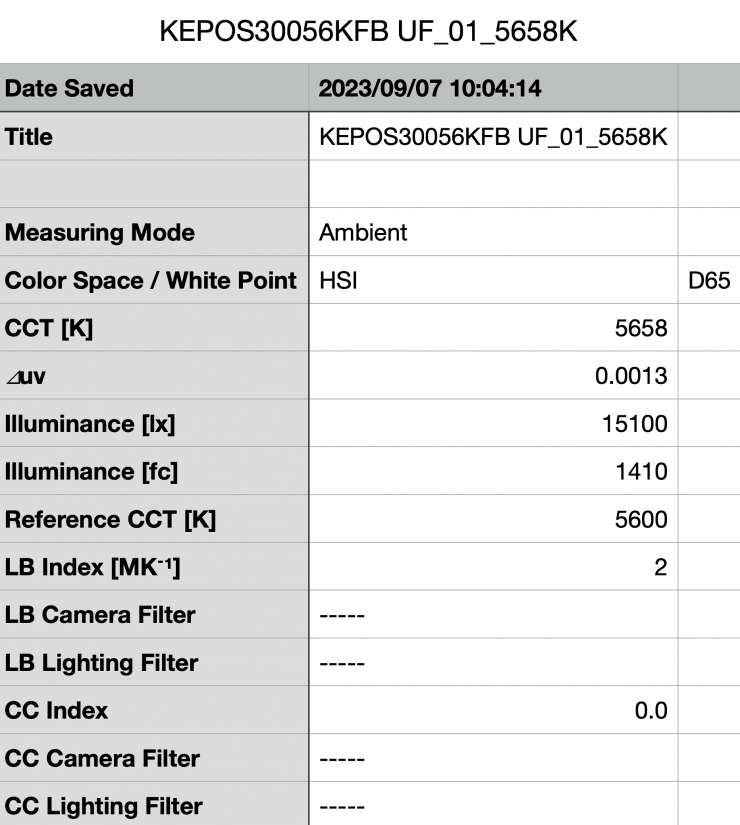
Above you can see the light’s output when it was set at 5600K and run via two 420Wh 28.8V batteries was 15,100 lx (1410 fc). This is essentially very similar as when I ran it off the single 420Wh 28.8V battery. The light had 9.58% less output when using two 28.8V batteries than it did when running via mains power.
Magnetic Diffusion Attachments
So let’s now have a look at the output you get when using the various Magnetic Diffusion attachments
Diffusion Dome 5600K
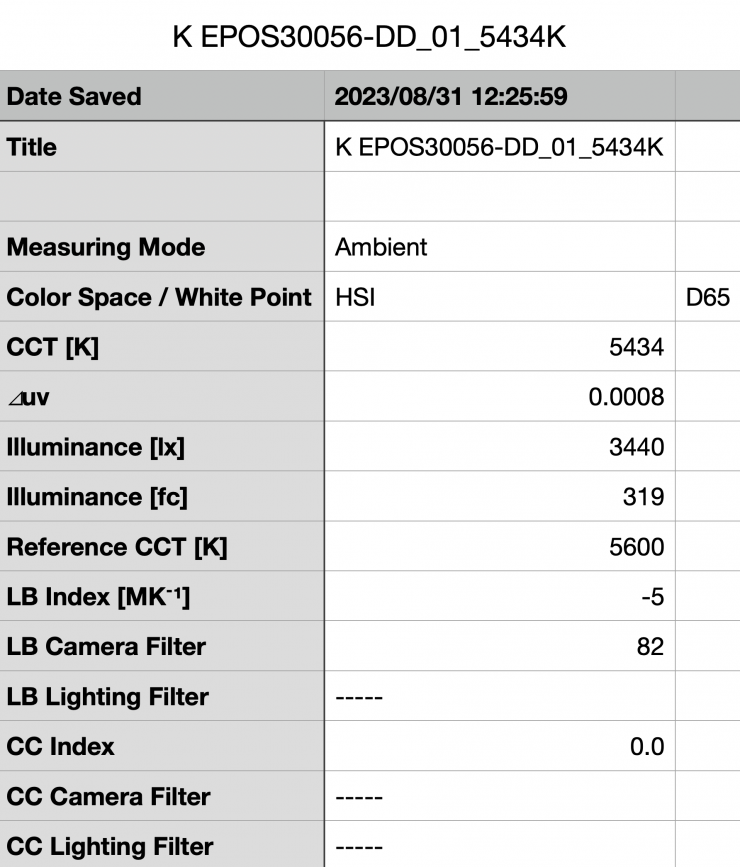
Above you can see that when used with its Diffusion Dome at 5600K it recorded an output of 3440 lx (319 fc).
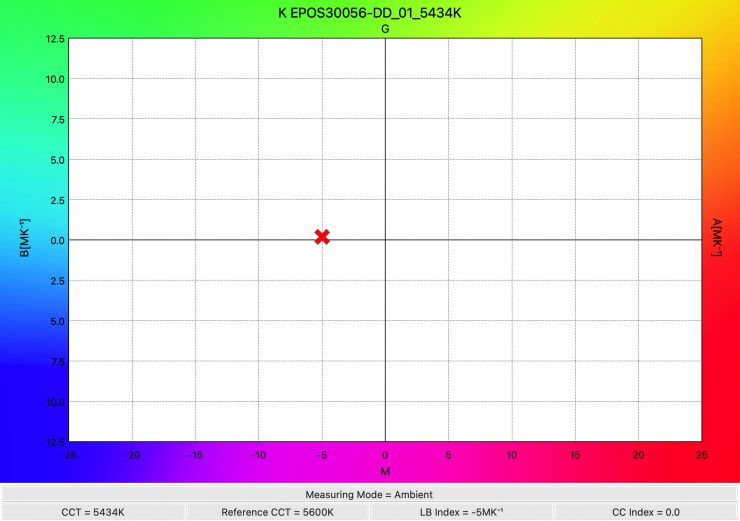
As far as CCT accuracy goes, it recorded a reading of 5434K. This does tell me that the CCT is getting changed when you use the diffusion dome.
Light Diffusion D100
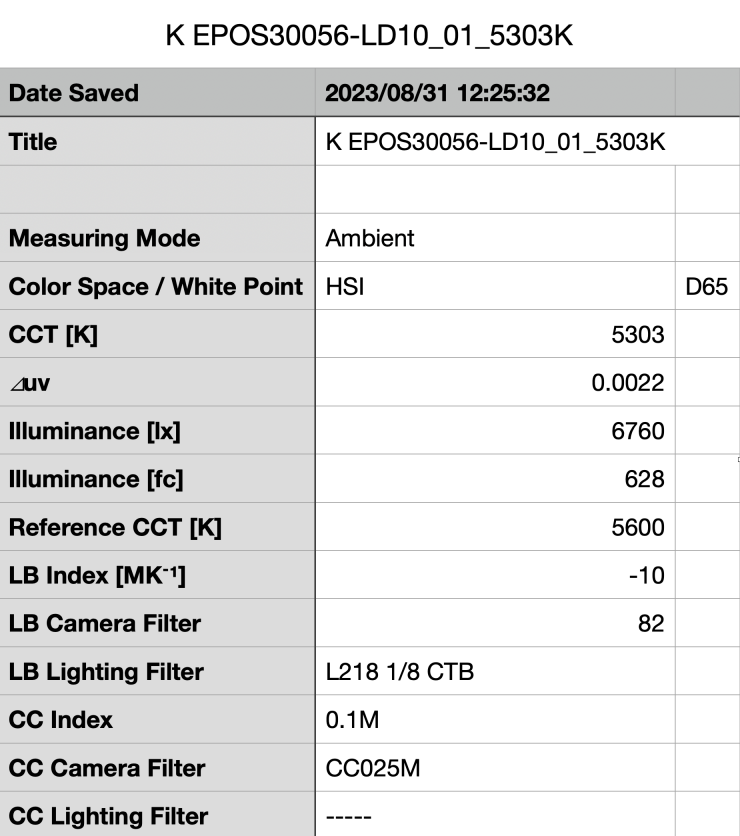
Above you can see that when used with its Light Diffusion D100 at 5600K it recorded an output of 6760 lx (628 fc).
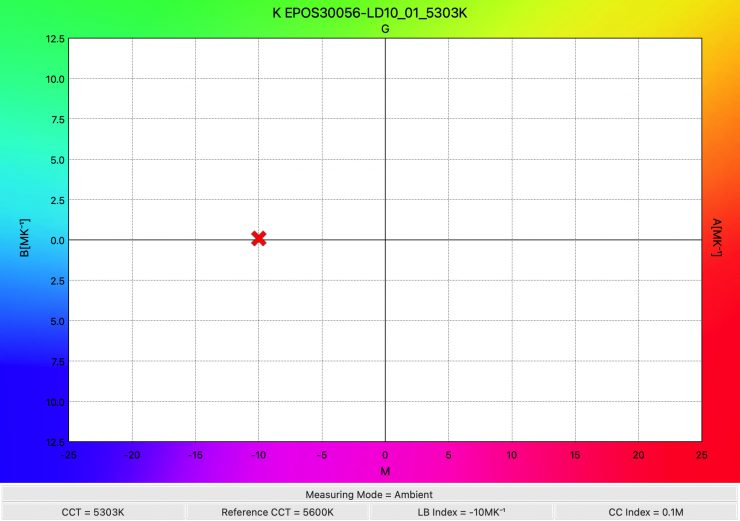
As far as CCT accuracy goes, it recorded a reading of 5303K. This shows me that the Light Diffusion D100 alters the CCT quite a bit.
Light Diffusion D90
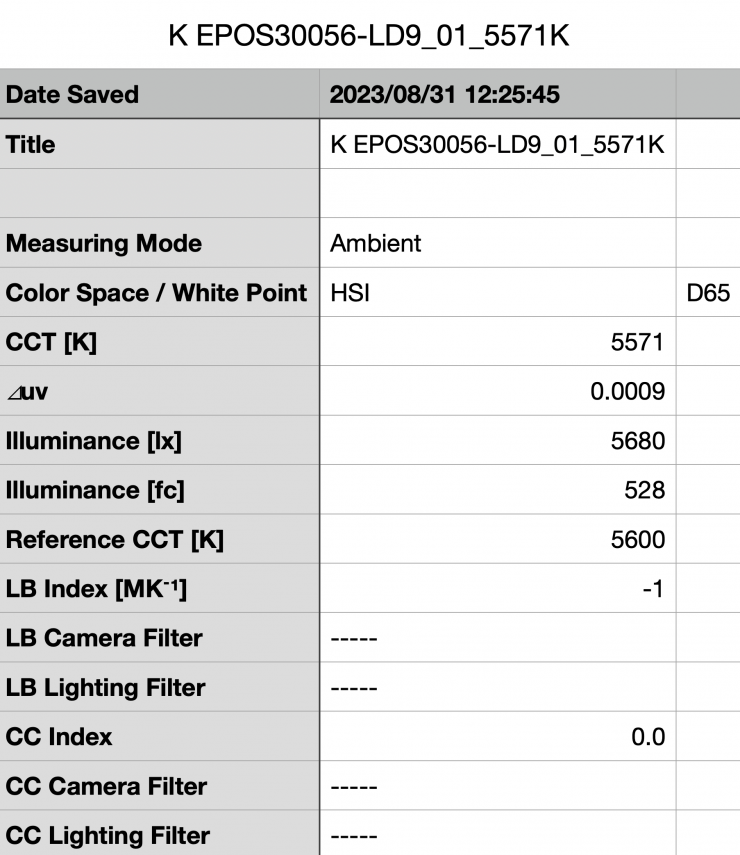
Above you can see that when used with its Light Diffusion D90 at 5600K it recorded an output of 5680 lx (528 fc).
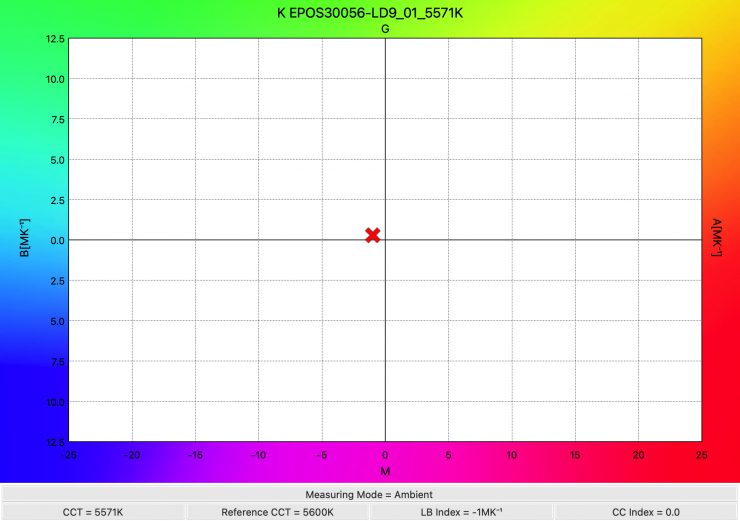
As far as CCT accuracy goes, it recorded a reading of 5571K which was very good. This shows me that the Light Diffusion D90 has far better CCT accuracy than the Light Diffusion D100.
Heavy Diffuser D75
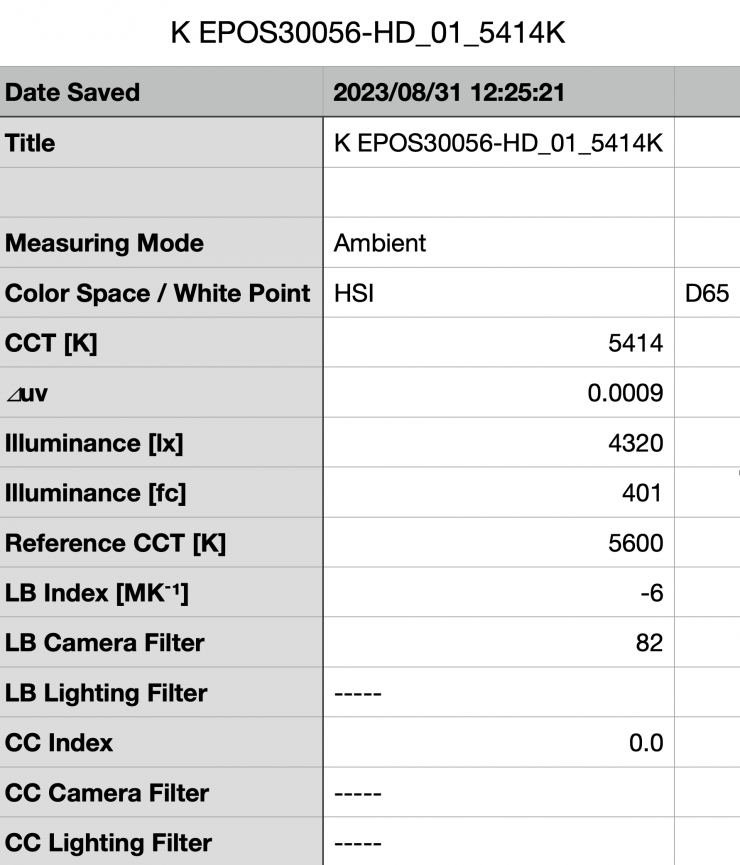
Above you can see that when used with its Heavy Diffuser D75 at 5600K it recorded an output of 4320 lx (401 fc).
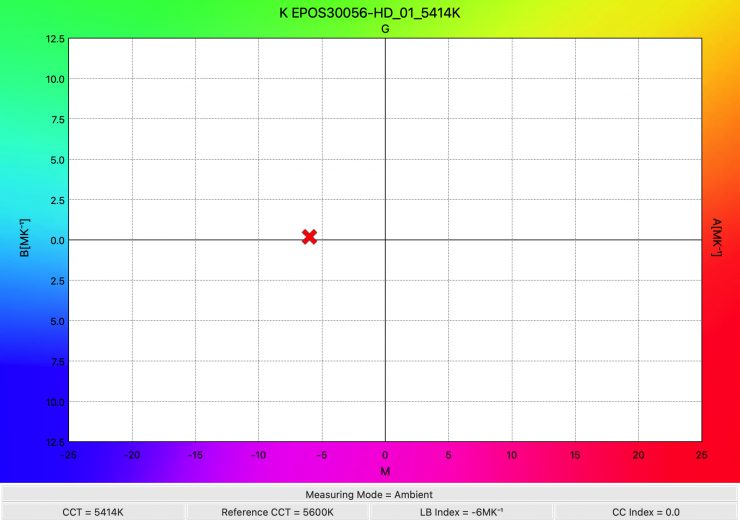
As far as CCT accuracy goes, it recorded a reading of 5414K. This shows me that the Heavy Diffuser D75 does alter the CCT accuracy slightly.
Summary of Output Results
There is a ton of data, and if it is a bit overwhelming, then I have collated a table of all the results for the light when used at 5600k.
| OUTPUT @5600K | |
| Medium Diffuser Regular Mode | 6630 lx |
| Medium Diffuser Max. Mode | 7130 lx |
| Diffusion Dome | 3440 lx |
| Light Diffusion D100 | 6760 lx |
| Light Diffusion D90 | 5680 lx |
| Heavy Diffuser D75 | 4320 lx |
| Open Face | 8790 lx |
| 55° Reflector (Bare) | 19,400 lx |
| 55° Reflector (Bare) Max. Mode | 20,900 lx |
| 55° Reflector (Medium Diffusion) | 15,600 lx |
| 55° Reflector (Medium Diffusion) Max. Mode | 16,700 lx |
| 55° Reflector (Medium Diffusion) Battery | 8490 lx |
| 62° Reflector (Bare) | 27,7000 lx |
+/- Green adjustment
As the fixture includes +/- Green adjustment you can quite easily correct any tint. While there is no exact science to this, and it really depends on what camera you are using as well, it’s just a matter of trial and error to see what setting actually works the best. The nice thing is, any light with +/- Green adjustment can be fine-tuned to deliver better results.
CCT consistency & linear output when dimming the light
Now, what you should always do when testing lights is to see if the CCT remains consistent when dimming the light. Just because you set a light at say 5600K, that doesn’t mean that the CCT will remain stable as you start dimming the fixture down. I also wanted to see how linear the dimming curve was.
I decided to do a series of tests at 100%/75%/50%/25%10% to see if the CCT being recorded changed. This was done at a distance of 1m / 3.3′ using a Sekonic C-800. These tests were done at 5600K with the light being used open face.
Kelvin Epos 300 (55° reflector & Medium Diffusion)
| CCT READING | OUTPUT | INTENSITY % |
| 5662K | 15,600 lx | 100 |
| 5642K | 11,700 lx | 75 |
| 5646K | 7840 lx | 50 |
| 5628K | 3980 lx | 25 |
| 5662K | 1640 lx | 10 |
The Kelvin Epos 300 maintained excellent CCT consistency as you start dimming the fixture. My testing showed that the CCT readings varied by 34K from 100% to 10%.
As far as how linear the output is when you start dimming the light, at 50% output it had 49.74% less output than when used at 100%. At 25% it had 74.48% less output than when used at 100%. At 10% output, it had 89.48% less output than when used at 100%. This shows me that the light’s dimming curve is extremely linear.
Color Rendering
So now that we have seen how much output the Kelvin Epos 300 produces, how does it perform when it comes to replicating accurate colors?
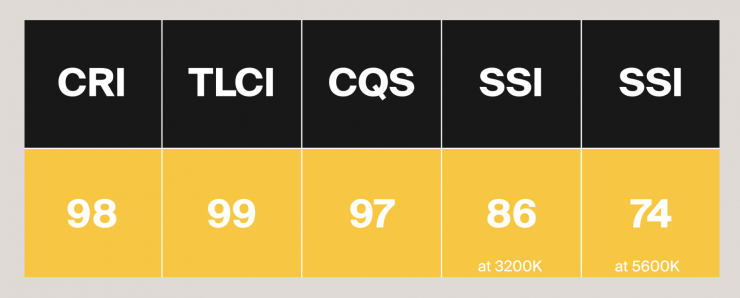
Above you can see the claimed photometric color quality figures from the manufacturer. So, let’s put those to the test.
Kelvin Epos 300 5600K (55° reflector & Medium Diffusion)
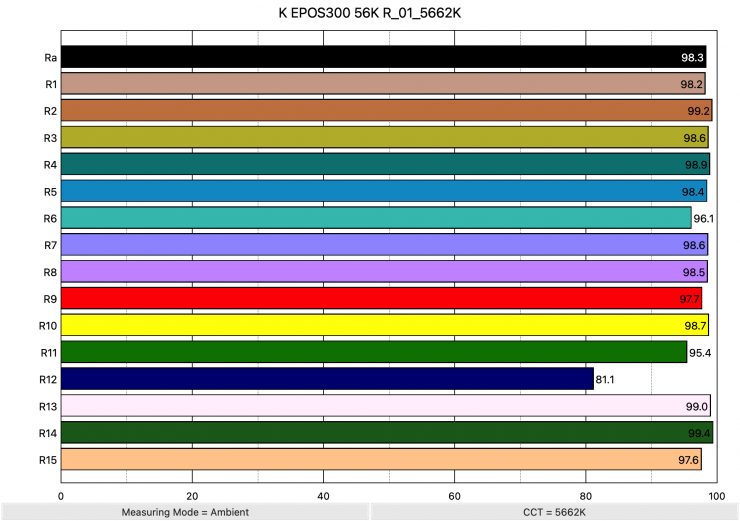
Above you can see that when the light was set at 5600K using the standard reflector and medium diffusion it recorded an average CRI (R1-R8) of 98.3 and an extended CRI (R1-R15) of 97.02. For replicating accurate skin tones it recorded 97.7 for R9 (red), 99.0 for R13 (closest to caucasian skin tones), and 97.6 for R15 (closest to Asian skin tones). These are excellent results, and only R12 (Blue) was below 90).
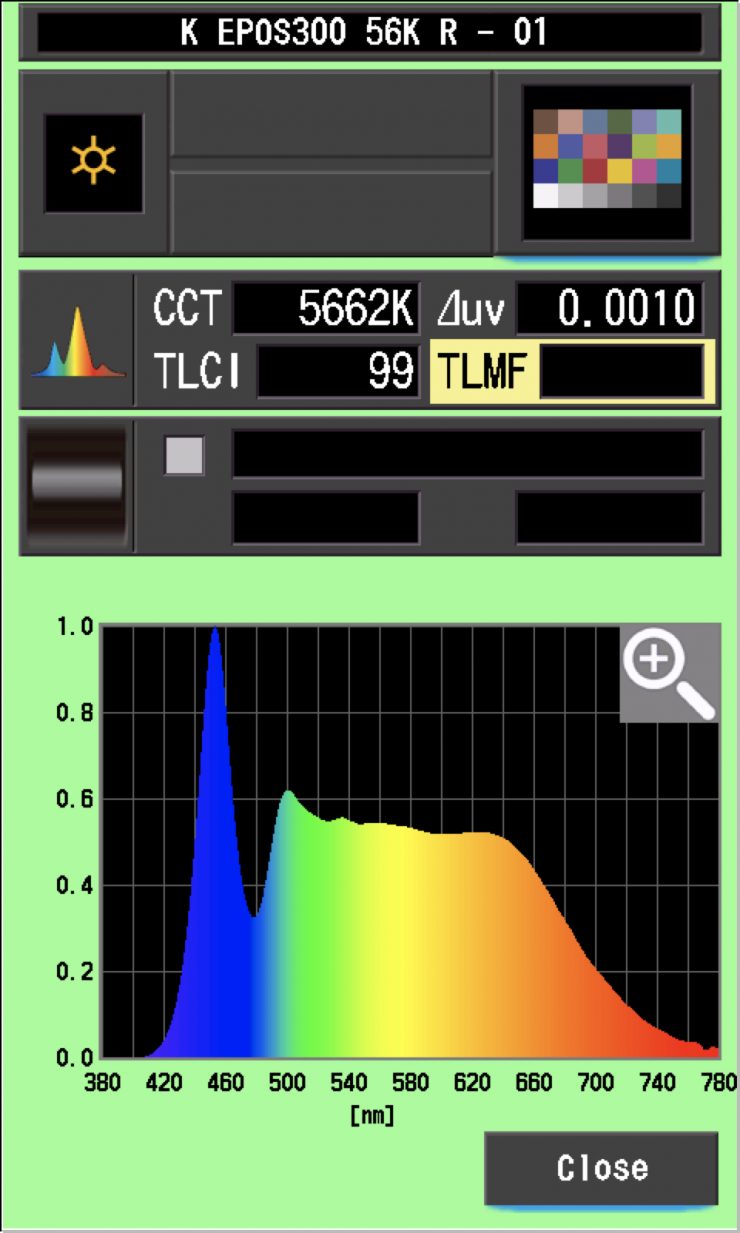
The light, when set at 5600K using its standard reflector and medium diffusion, recorded a TLCI score of 99.
Kelvin Epos 300 3200K (55° reflector & medium diffusion)
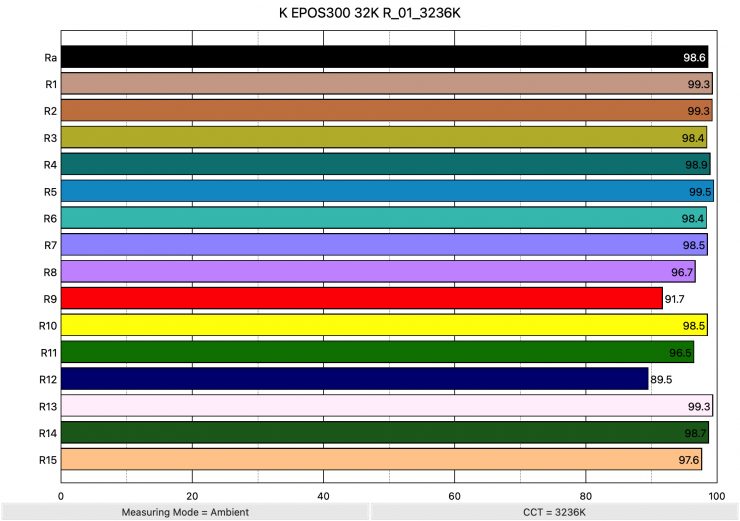
Above you can see the scores for when the light was used at 3200K. It recorded an average CRI (R1-R8) of 98.6 and an extended CRI (R1-R15) of 97.38. For replicating accurate skin tones it recorded 91.7 for R9 (red), 99.3 for R13 (closest to caucasian skin tones), and 97.6 for R15 (closest to Asian skin tones).
These results were outstanding and slightly better than when the light was used at 5600K. The extended CRI score of 97.38 is the highest I have ever recorded from any LED light I have reviewed.
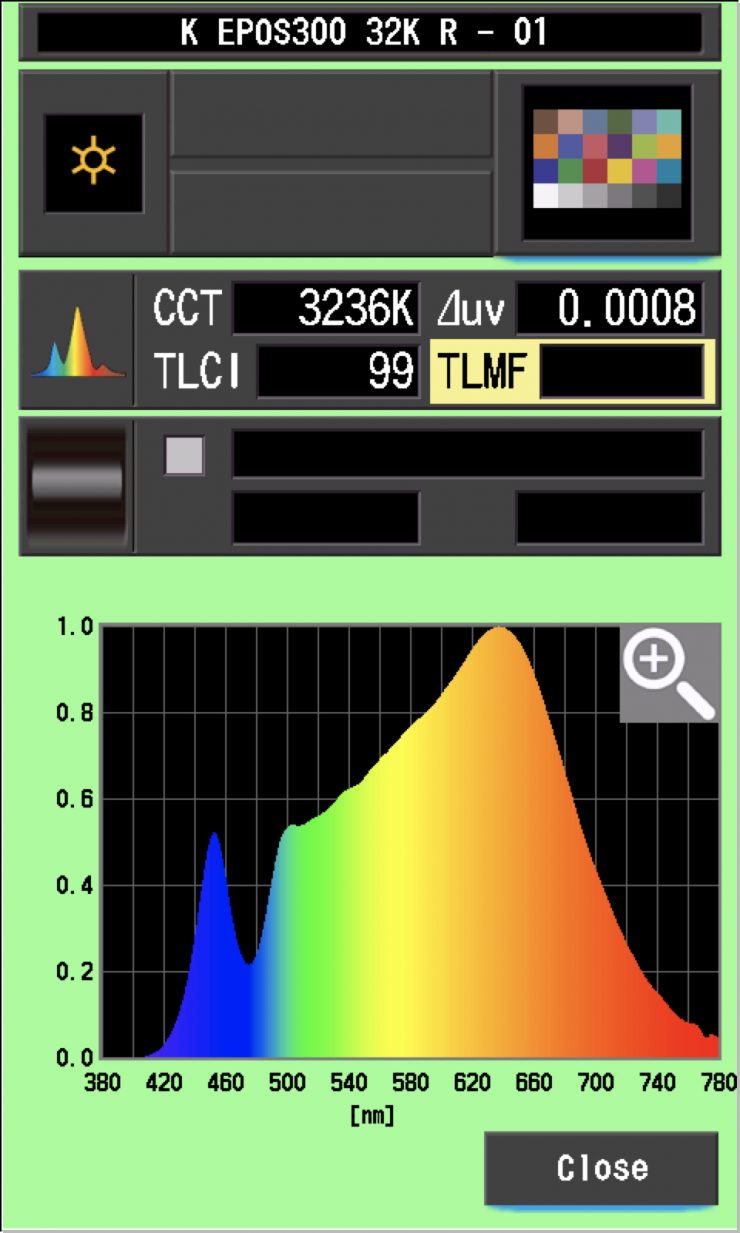
The light, when set at 3200K, recorded a TLCI score of 99.
How do these figures at 3200K and 5600K compare to other lights that we have previously reviewed? Below you can see:
5600K
| CRI | EXTENDED CRI | R9 | R13 | R15 | |
| Kelvin Epos 300 | 98.3 | 97.02 | 91.7 | 99.0 | 97.6 |
| Prolycht Orion 300 FS | 97.2 | 96.06 | 93.2 | 98.7 | 99.5 |
| Lupo Movielight 300 Full Color PRO | 96.8 | 96.06 | 97.9 | 98.5 | 98.2 |
| ARRI Orbiter | 98.1 | 97.10 | 86.3 | 98.9 | 97.4 |
The scores were excellent for the Kelvin Epos 300 and it was just marginally behind the ARRI Orbiter’s extended CRI score of 97.10.
3200K
| CRI | EXTENDED CRI | R9 | R13 | R15 | |
| Kelvin Epos 300 | 98.6 | 97.38 | 91.7 | 99.3 | 97.6 |
| Prolycht Orion 300 FS | 96.3 | 94.85 | 89.8 | 98.7 | 97.3 |
| Lupo Movielight 300 Full Color PRO | 94.4 | 93.56 | 97.0 | 93.9 | 95.7 |
| ARRI Orbiter | 97.8 | 96.89 | 80.7 | 99.9 | 96.9 |
The scores were excellent for the Kelvin Epos 300 at 3200K were outstanding. The extended CRI score was the best I have ever seen from any LED light when used at 3200K. The score beat out the very, very good ARRI Orbiter.
Kelvin Epos 300 5600K (55° reflector & Medium Diffusion) Max. Mode
So, now let’s have a look if running the light in its Max. Mode changes the color rendering scores.
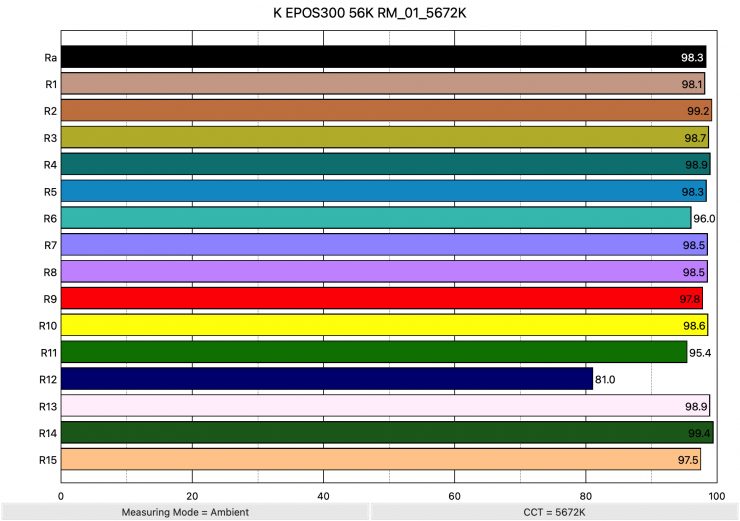
Above you can see that when the light was set at 5600K using the standard reflector and medium diffusion and running in its Max. Mode recorded an average CRI (R1-R8) of 98.3 and an extended CRI (R1-R15) of 96.98. For replicating accurate skin tones it recorded 97.8 for R9 (red), 98.9 for R13 (closest to caucasian skin tones), and 97.5 for R15 (closest to Asian skin tones). These are excellent results, and only R12 (Blue) was below 90.
What these results show me is that when you run the light in its Max. Mode it doesn’t alter the color rendering accuracy.
Kelvin Epos 300 3200K (55° reflector & Medium Diffusion) Max. Mode
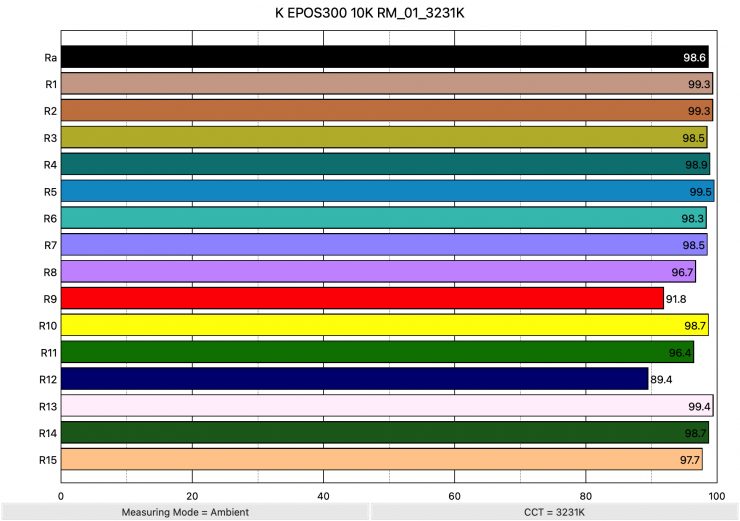
Above you can see that when the light was set at 3200K using the standard reflector and medium diffusion and running in its Max. Mode recorded an average CRI (R1-R8) of 98.6 and an extended CRI (R1-R15) of 97.40. For replicating accurate skin tones it recorded 91.8 for R9 (red), 99.4 for R13 (closest to caucasian skin tones), and 97.7 for R15 (closest to Asian skin tones). These are excellent results, and only R12 (Blue) was marginally below 90.
What was interesting is that the extended CRI score when running the light in its Max. Mode at 3200K was slightly higher than when using it in its Constant Mode. The score of 97.40 was the highest I have ever seen.
Kelvin Epos 300 Open Face
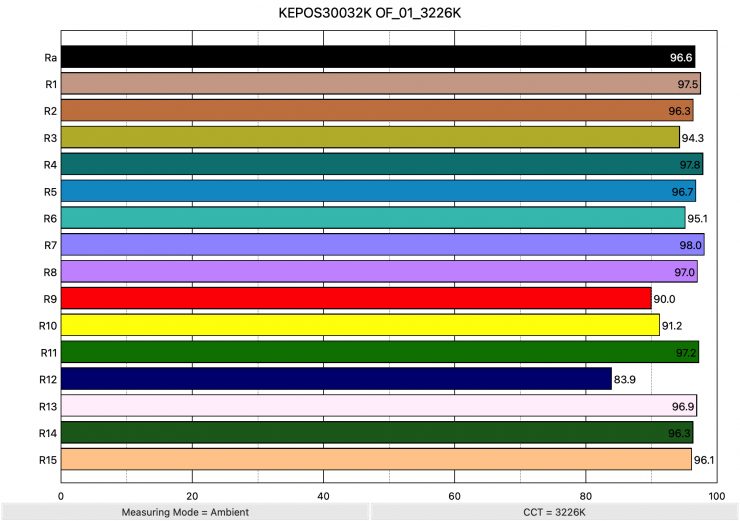
3200K 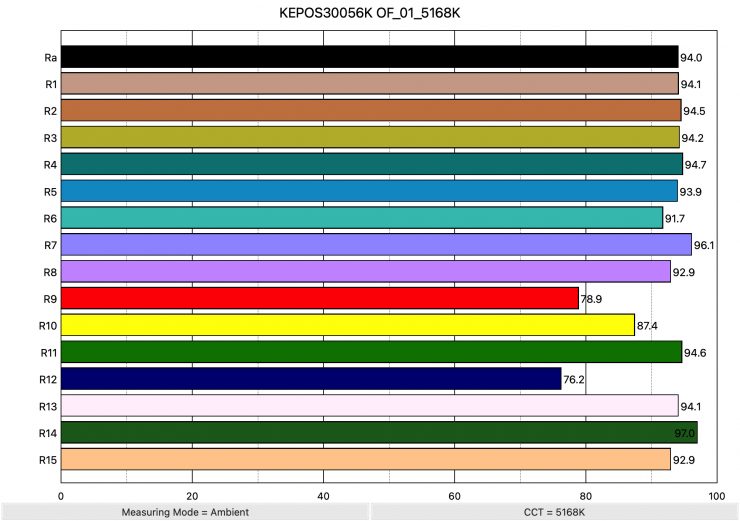
5600K
If you want to see what the color rendering was when using the light open face you can see those scores above.
The Kelvin Epos 300 CRI scores are not as good when you use the light open face with no diffusion or reflector.
Kelvin Epos 300 55° reflector (Bare)
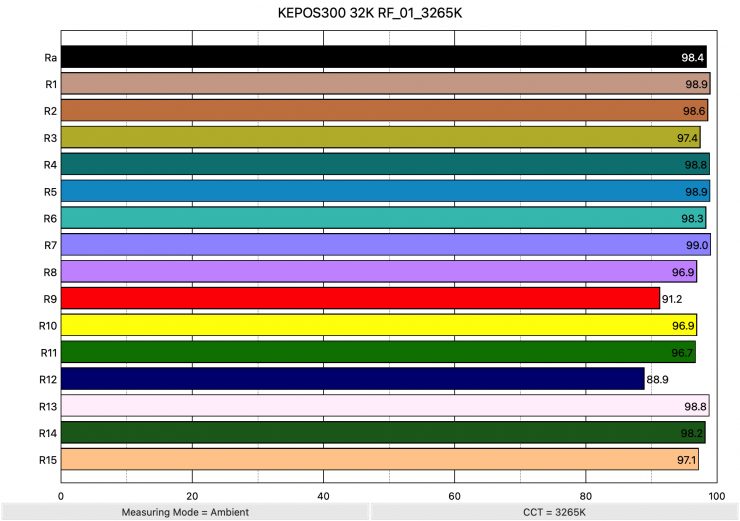
3200K 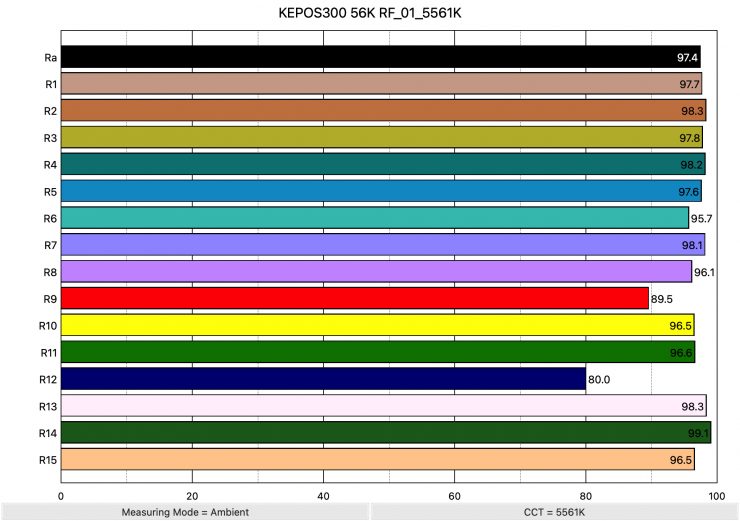
5600K
If you want to see what the color rendering was when using the light with its 55° reflector and no diffusion you can see those scores above.
These scores are very similar to those when you use the reflector and medium diffusion.
Kelvin Epos 300 62° reflector
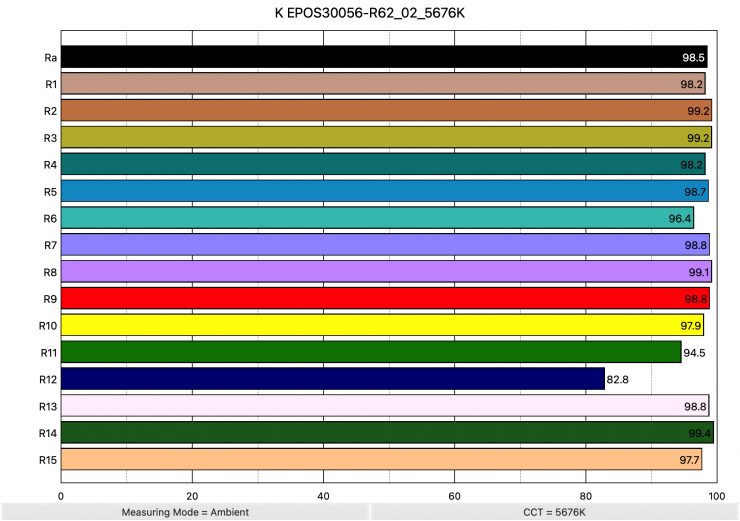
I was also interested to see what the color rendering performance was like when using the 62° reflector, as that is the way to get the most output from the fixture. Above you can see that the light recorded an average CRI (R1-R8) of 98.5 and an extended CRI (R1-R15) of 97.18. For replicating accurate skin tones it recorded 98.8 for R9 (red), 98.8 for R13 (closest to caucasian skin tones), and 97.7 for R15 (closest to Asian skin tones). These are excellent results, and only R12 (Blue) was below 90.
In fact, the extended CRI score of 97.18 was one of the highest I have ever seen from any LED light. This shows me that the color rendering performance when using the 62° reflector was outstanding.
CC Index & ⊿uv
The CC Index displays the CC correction value and whether any magenta or green need to be added or subtracted. 1 CC corresponds to 035 Kodak CC values or 1/8 Rosco filter values. Any reading less than +1.00 or -1.00 and you’re probably not going to need to make any kind of adjustment. The ⊿uv is the value to show how much this light is away from being an ideal light source (black body radiation = incandescent lamp). As with the CC Index you want this number to theoretically be zero. Kelvin is not a linear value, so we need to convert from Kelvin to MK-1 to compare the values of color temperature. To calculate from Kelvin to Mired is MK-1= 1*1000000/Kelvin. While this may sound confusing, it is the only way of measuring if the Kelvin shift is significant enough to warrant having to use a filter for correction. Below are the results for the Kelvin Epos 300:
Kelvin Epos 300 Kelvin Vs MK-1
| Kelvin | Difference in K | MK-1 | Difference in MK-1 | |
| SET VALUE | 2500K | 0 | 400 | 0 |
| ACTUAL READING | 2578K | 78 | 387.89 | 12.11 MK-1 |
| SET VALUE | 3200K | 0 | 312.5 | 0 |
| ACTUAL READING | 3236K | 36 | 309.02 | 3.48 MK-1 |
| SET VALUE | 4500K | 0 | 222.22 | 0 |
| ACTUAL READING | 4544K | 44 | 220.07 | 2.15 MK-1 |
| SET VALUE | 5600K | 0 | 178.57 | 0 |
| ACTUAL READING | 5662K | 62 | 176.61 | 1.96 MK-1 |
| SET VALUE | 6500K | 0 | 153.84 | 0 |
| ACTUAL READING | 6566K | 66 | 152.29 | 1.55 MK-1 |
| SET VALUE | 8000K | 0 | 125 | 0 |
| ACTUAL READING | 8093K | 93 | 123.56 | 1.44 MK-1 |
| SET VALUE | 10000K | 0 | 100 | 0 |
| ACTUAL READING | 10162K | 162 | 98.40 | 1.6 MK-1 |
These figures might look confusing, but what they tell me is that the light is very Kelvin color-accurate at 3200K and above. Any MK-1 score that is under -9/9 means you wouldn’t have to use any color correction gels. The MK-1 scores for this light were extremely good, especially at 4500K and above. At 2500K the score wasn’t good.
Kelvin Epos 300 CC INDEX & ⊿uv
| CC INDEX | ⊿uv | |
| 2500K | 0 | 0.0009 |
| 3200K | 0.1M | 0.0007 |
| 4500K | 0.1M | 0.0008 |
| 5600K | 0 | 0.0010 |
| 6500K | 0.2G | 0.0011 |
| 8000K | 0.4G | 0.0012 |
| 10000K | 0.8G | 0.0012 |
The CC Index & ⊿uv scores were very good and pretty consistent. The light does lean slightly green at 10000K.
TM-30
TM-30 is a relatively new color rendering standard that was developed to deal with the limitations of CRI. TM-30 looks at 99 individual colors. These 99 colors are categorized into seven groups: nature, skin color, textiles, paints, plastics, printed material, and color systems.
TM-30 scores go from 0 – 100. The higher the score, the more accurate a light is at producing colors. Any TM-30 Rf score in the ’90s is considered to be good. What is interesting and something that you need to be very aware of is that two separate light sources with the exact same CRI scores can render colors very differently. A light with a high CRI rating could have a low TM-30 score. Conversely, a light with a good TM-30 score could have a bad CRI score.
Now, there are two measurements associated with TM-30, Rf and Rg.
Rf (Color Fidelity)
Rg (Color Gamut)
With Rf value, ideally, you want a score in the 90’s.
With Rg value, a score below 100 indicates that the light source renders colors with less saturation than the reference source. So ideally you want this score to be above 100.
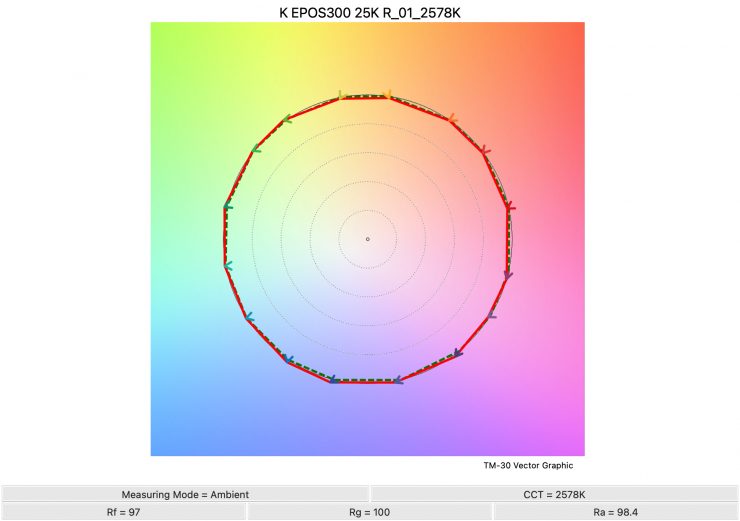
2500K 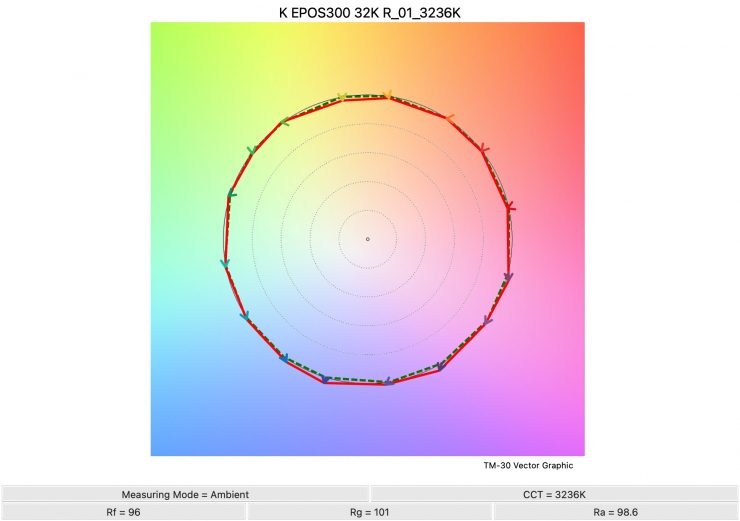
3200K 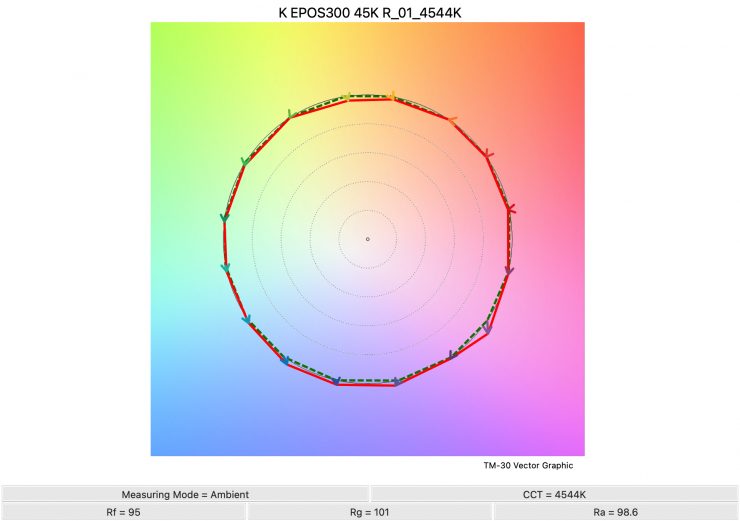
4500K 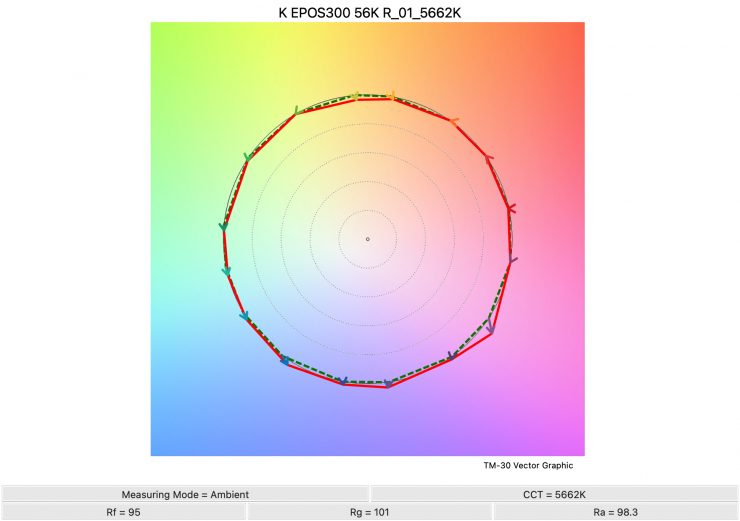
5600K 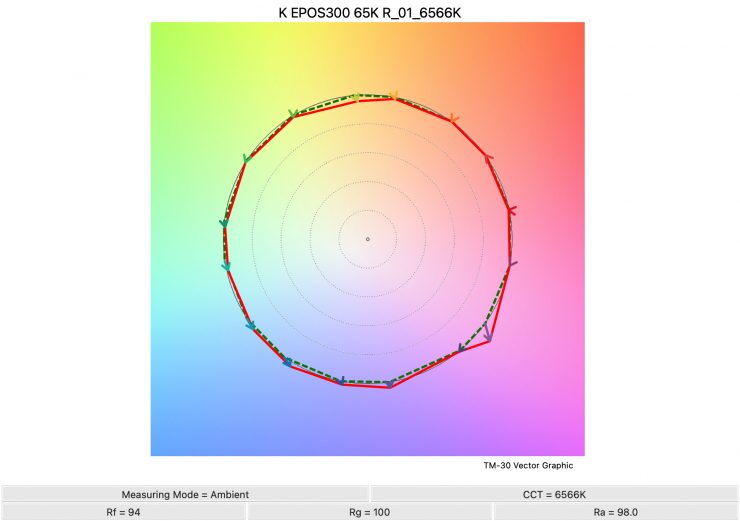
6500K 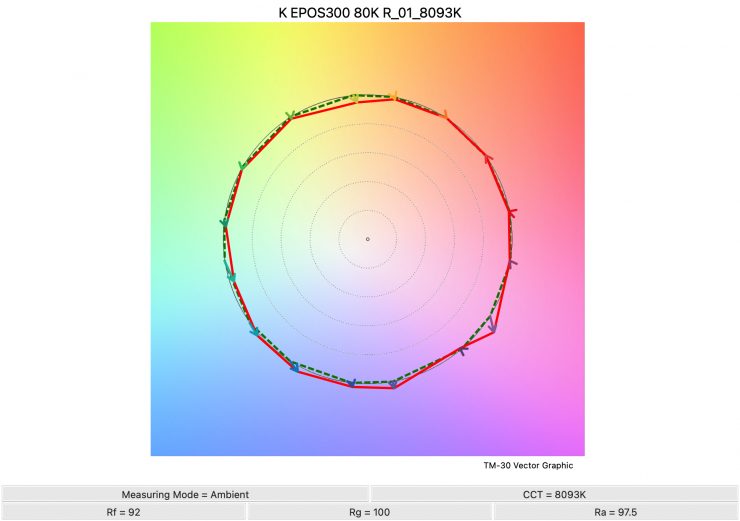
8000K 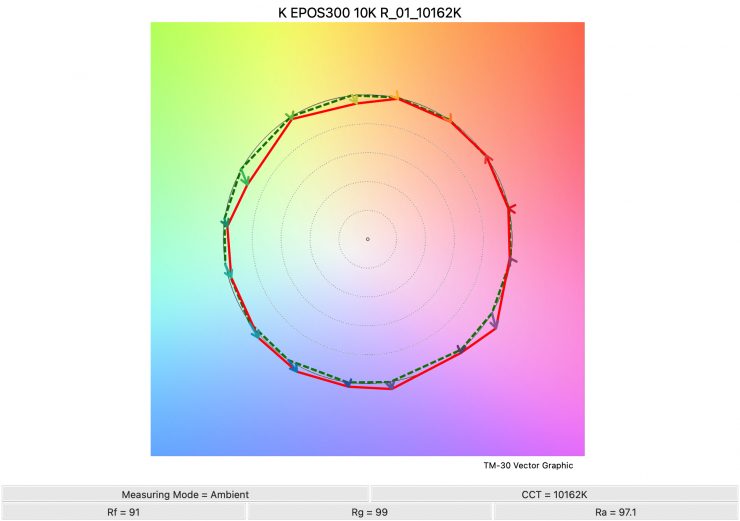
10000K
Above you can see the scores for the Kelvin Epos at various CCT settings. Below I have listed the figures as well.
Here are the results:
| Rf | Rg | |
| 2500K | 97 | 100 |
| 3200K | 96 | 101 |
| 4500K | 95 | 101 |
| 5600K | 95 | 101 |
| 6500K | 94 | 100 |
| 8000K | 92 | 100 |
| 9999K | 91 | 99 |
The TM-30 scores were excellent for this light and it shows me that it is very consistent at replicating accurate colors with full saturation.
Output & accuracy when creating saturated colors
I also wanted to test the light to see how it performed when creating super-saturated colors.
0° – RED
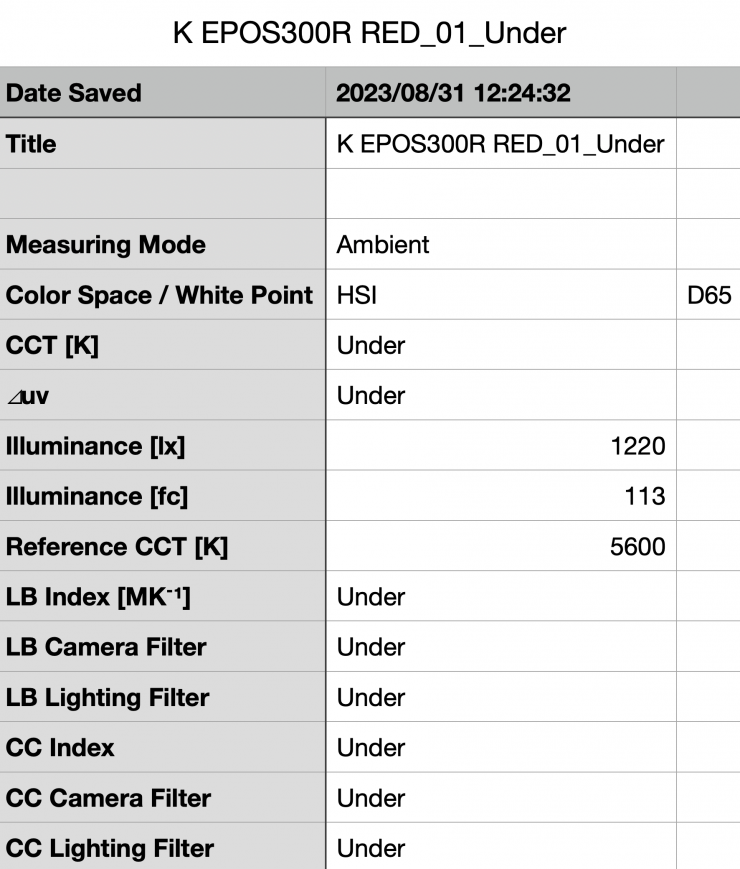
Above you can see that the light when using its reflector and medium diffusion recorded an output of 1220 lx (113 fc). What you clearly need to know when using RGBWACL lights like this is that the output levels you can produce when creating super saturated colors are a lot less than when using the light in a CCT mode.

As far as creating an accurate 0° RED, the Epos 300 was actually off by 3°.
120° – GREEN
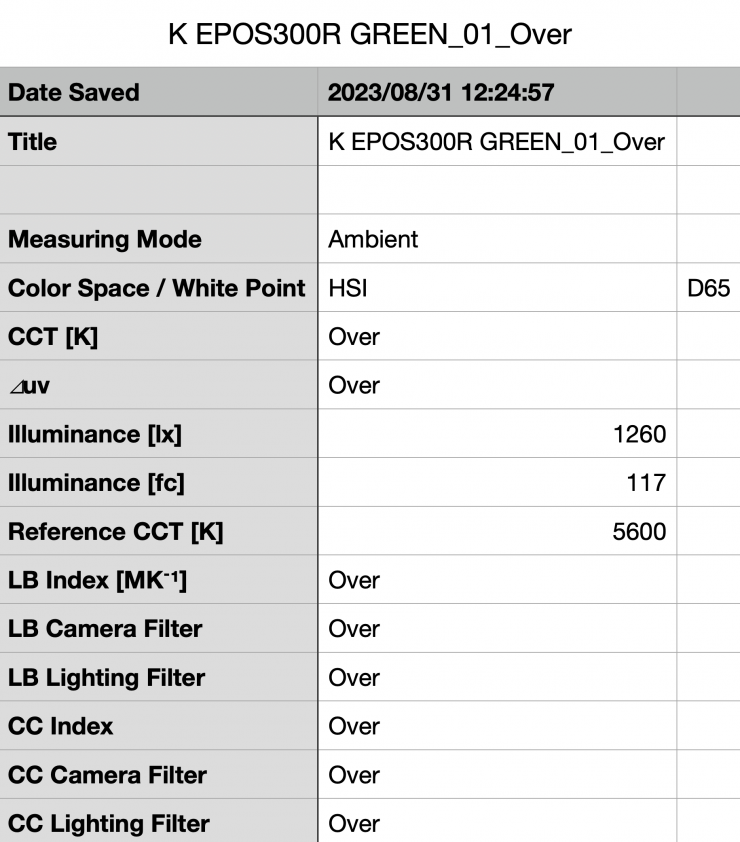
Above you can see that the light when using its reflector and medium diffusion recorded an output of 1260 lx (117 fc).

As far as creating an accurate 120° GREEN, the Epos 300 was spot on with a 120° reading and 100% saturation.
240° – BLUE
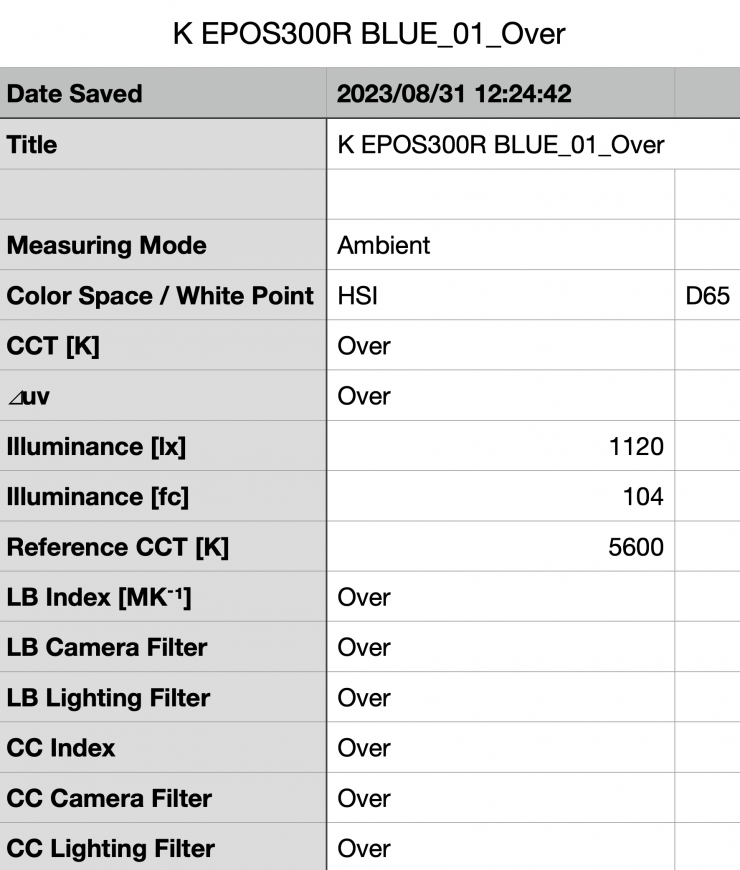
Above you can see that the light when using its reflector and medium diffusion recorded an output of 1120 lx (104 fc).

As far as creating an accurate 240° BLUE, the Epos 300 was 1° off with a reading of 241°, but it did have 100% saturation.
60° – YELLOW
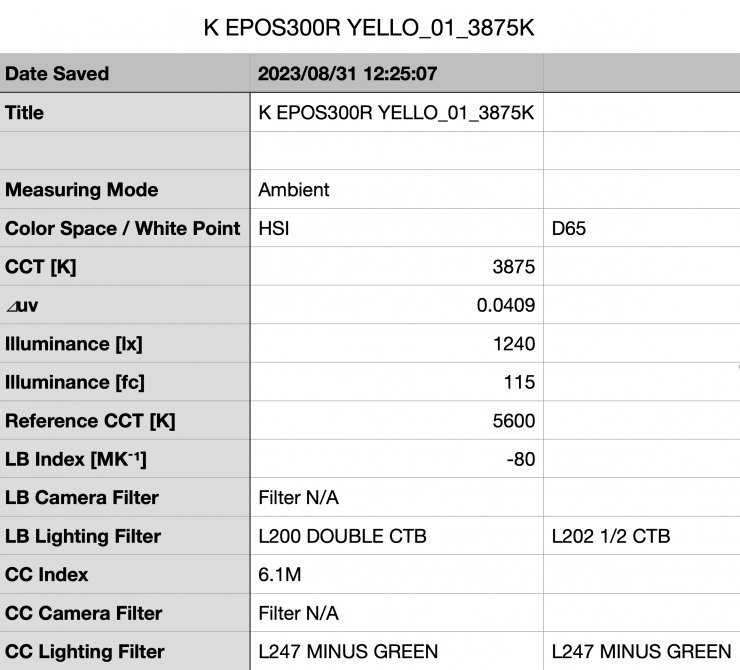
Above you can see that the light when using its reflector and medium diffusion recorded an output of 1240 lx (115 fc).

As far as creating an accurate 60° Yellow, the Epos 300 was 2° off with a reading of 62°, but it did have 100% saturation.
What impressed me with the Epos 300 was that the output remains very consistent no matter what color you are trying to generate.
SSI
SSI (Spectral Similarity Index) was developed by the Sci-Tech Council of the Academy. SSI gives me the ability to set any light as a standard, or use predefined standards (such as CIE D55), and then give other lights an SSI score based upon how well they will match standards such as CIE D55 measure spectral response and compare it directly against an ideal light source.
SSI is a much better way to judge an LED light than CRI or TLCI, although they don’t tell the full story of any light and you can’t judge a light by SSI scores alone.
SSI is useful to see how well different lights will play together. As the Sekonic C-800 Spectromaster can measure SSI, I decided to test out the Kelvin Epos 300 to see how it performed.
3200K
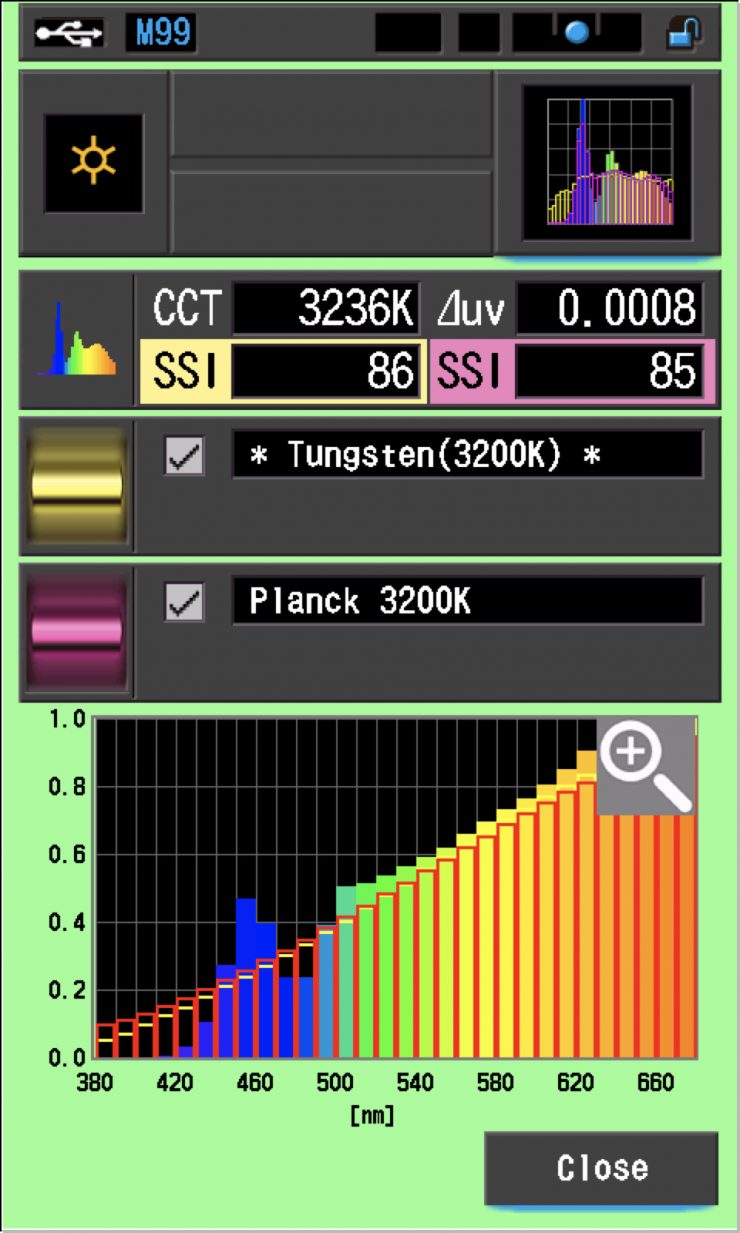
In this graph, the red bars indicate a perfect Planck 3200K source. The gold bars indicate a perfect 3200K Tungsten source. This lets us compare how close to a perfect 3200K lighting source the Kelvin Epos 300 is. Any SSI score in the high 70’s, low ’80s is very good for a 3200K LED light. These were outstanding scores.
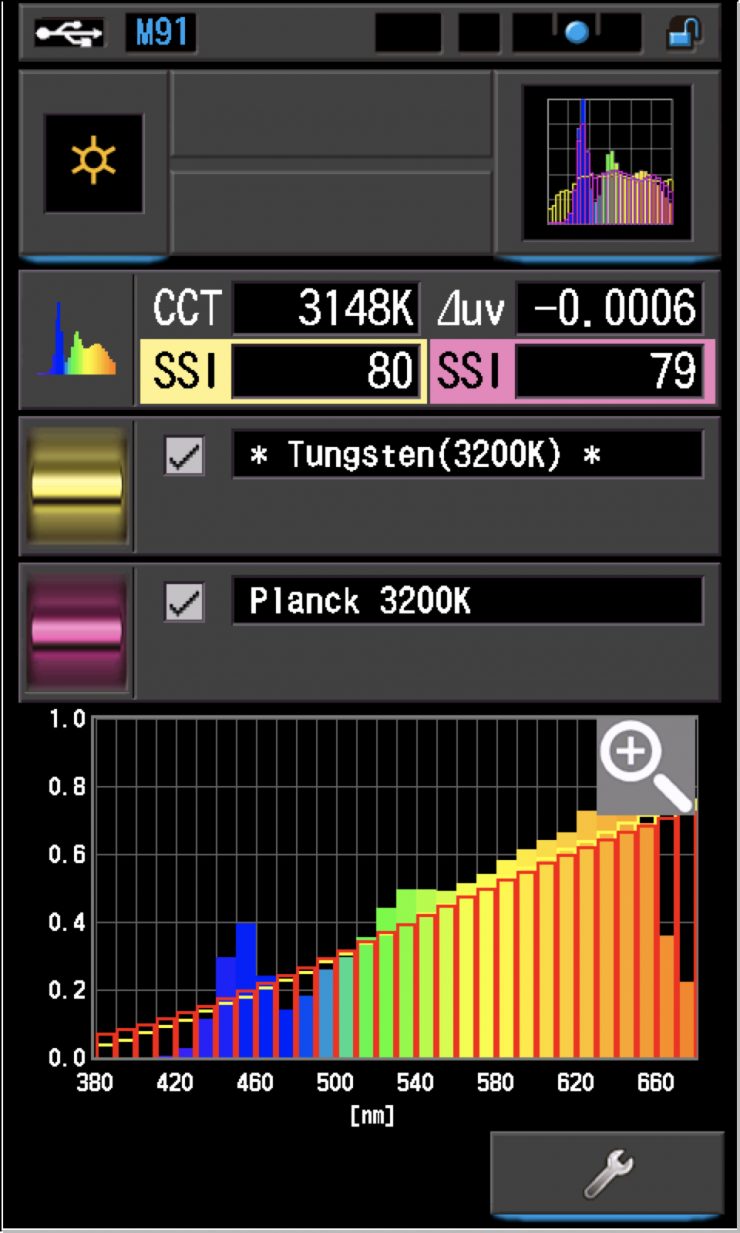
As a comparison, above are the same results for the Prolycht Orion 300 FS.
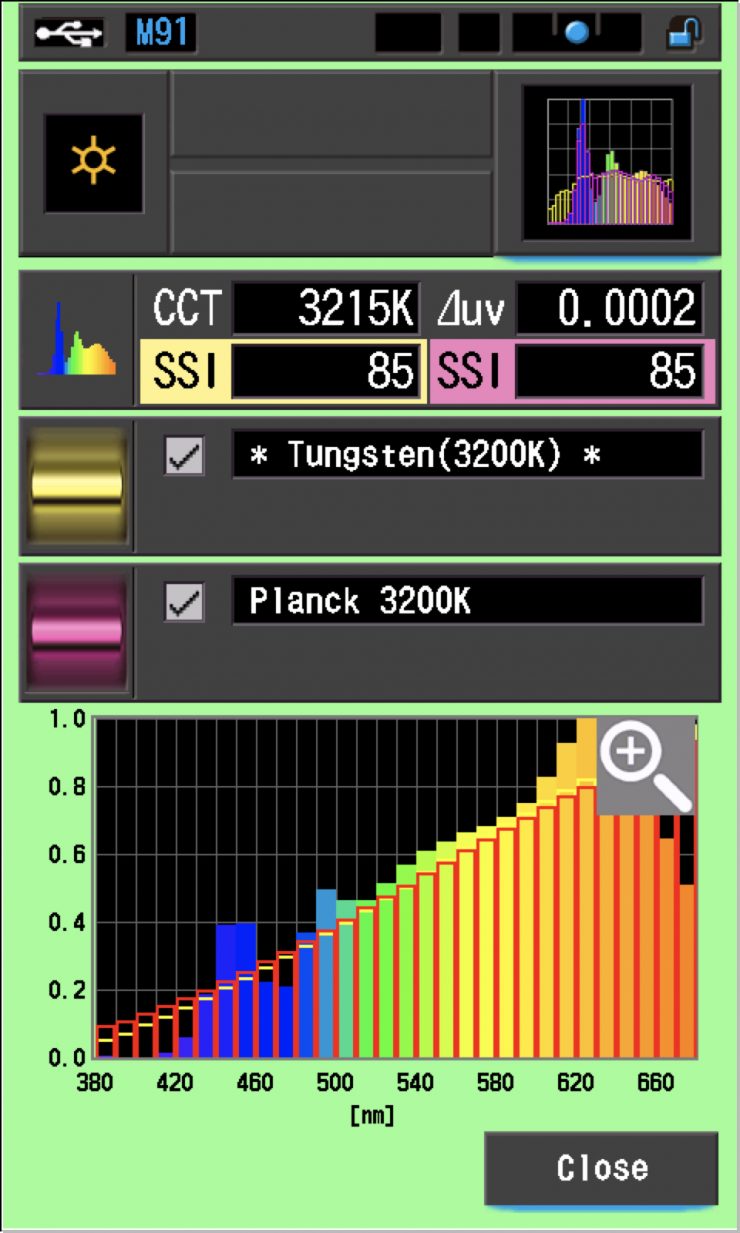
As another comparison, above are the results for the ARRI Orbiter.
5600K
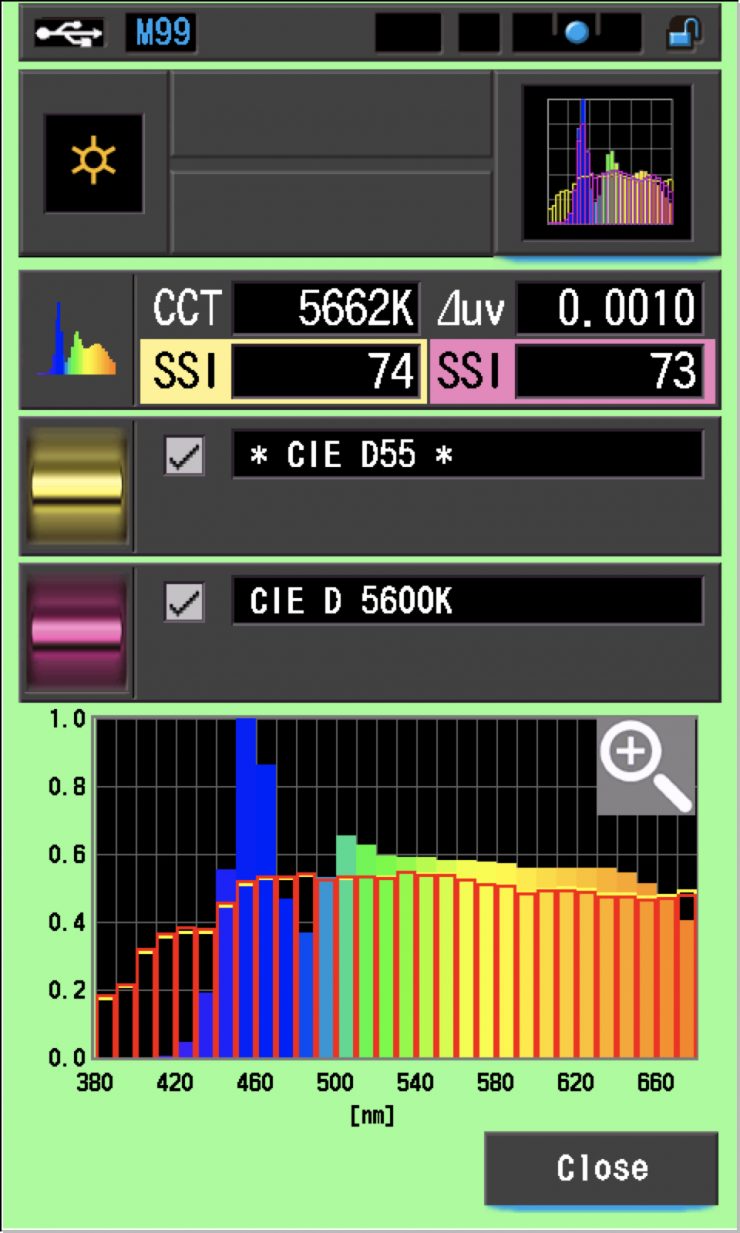
In the graph above the gold bars indicate a perfect CIE D55 source. The red bars indicate a perfect CIE D 5600K source. This lets us compare how close to a perfect 5600K lighting source the Kelvin Epos 300 is. A score in the low 70’s is typical for a 5600K LED source.
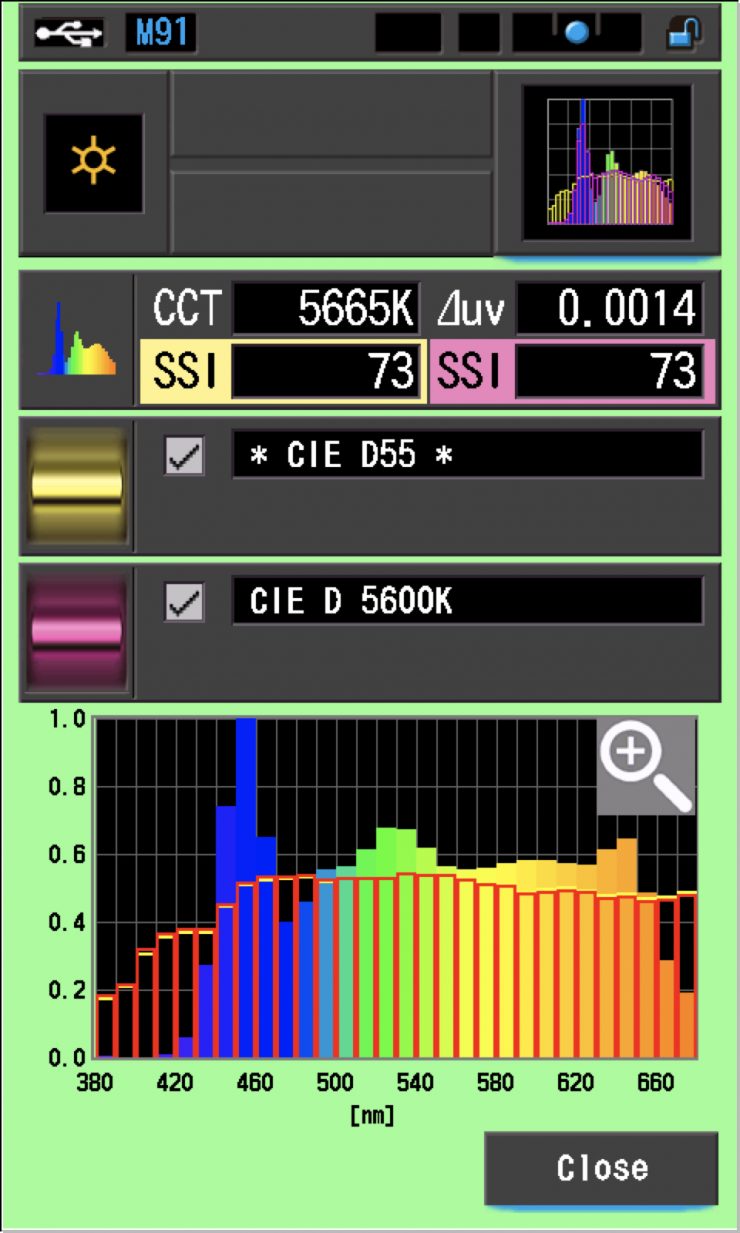
As a comparison, above are the scores for the Prolycht Orion 300 FS.
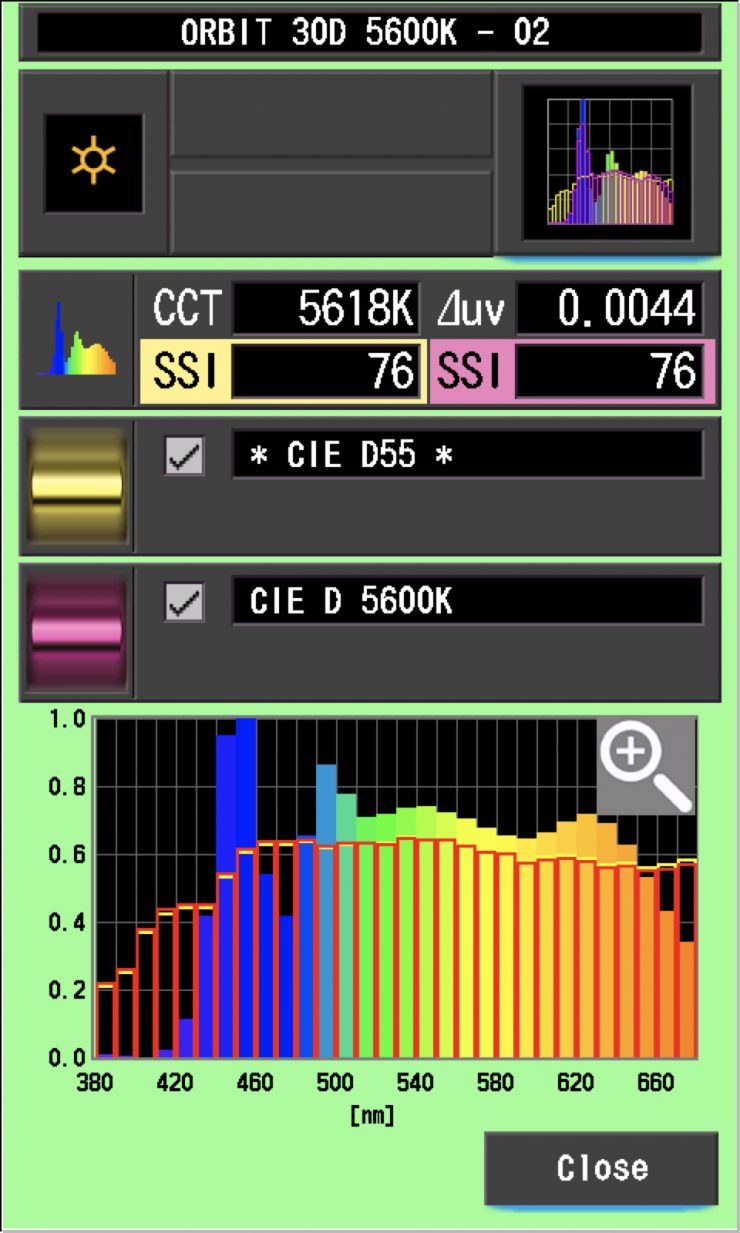
As another comparison, above are the results for the ARRI Orbiter.
The main reason we want to record SSI scores is so we can see how well they match with other lights. As an example, I wanted to see how well the Kelvin Epos 300 matched the ARRI Orbiter and Prolycht Orion 675 FS. Below you can see the results.
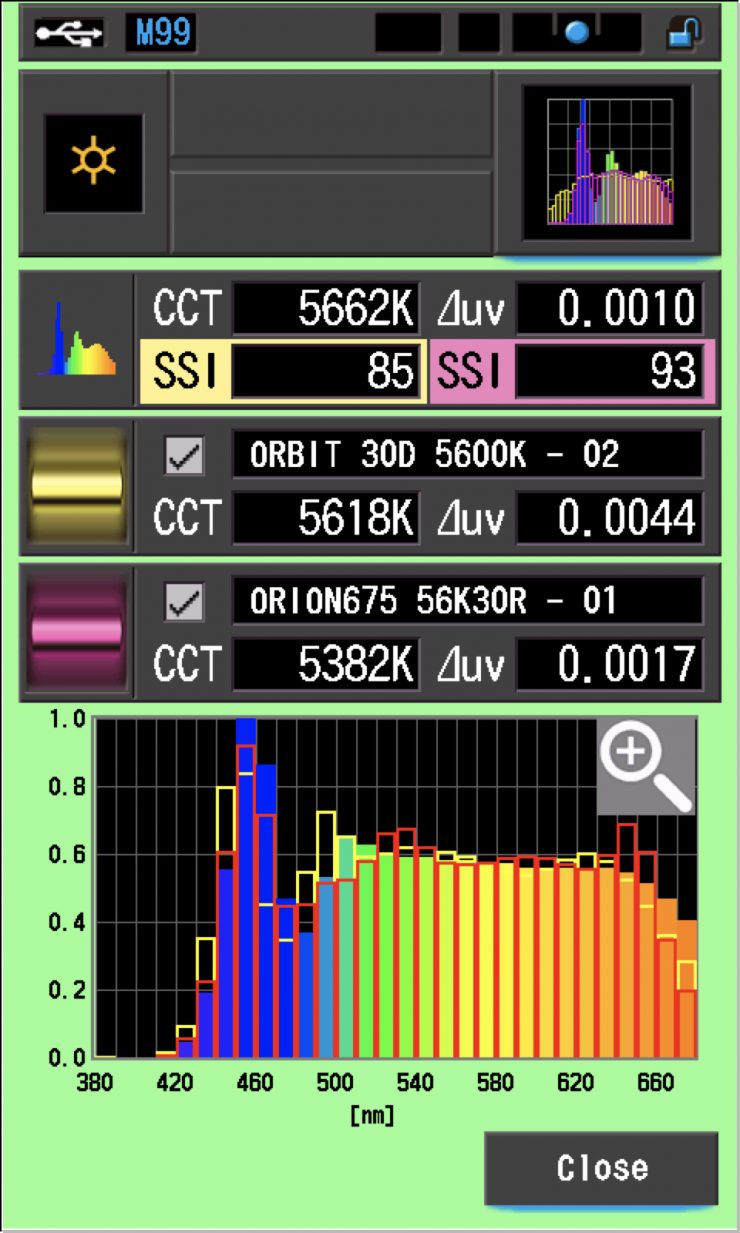
As you can see neither lights are a perfect match to the Kelvn Epos 300, but you could potentially fine-tune the lights to try and get them to match more closely. In saying that, a score in the ’90s is still reasonably good.
As another test, I thought I would compare those same lights against the Kelvin Epos 300 at 3200K. Below you can see the results.
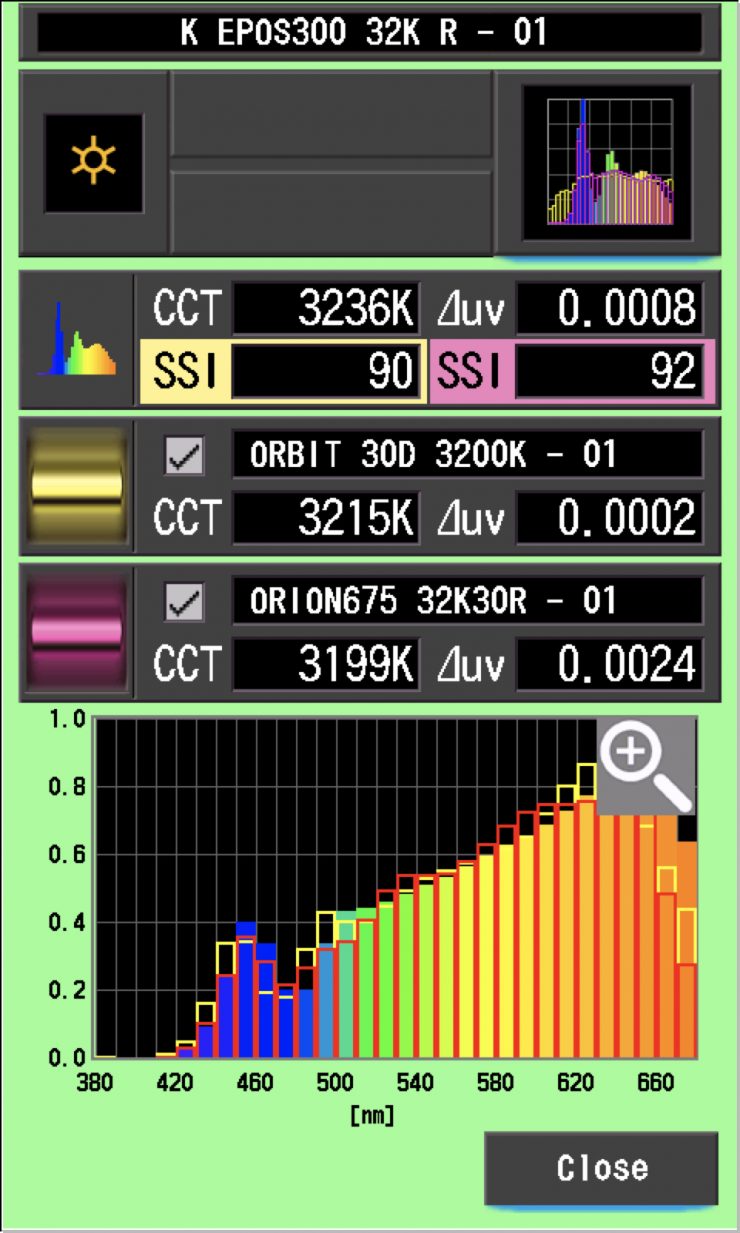
As you can see, both lights had similar scores, but again, they weren’t an exact match to the Kelvin Epos 300. In saying that, very few lights from different manufacturers are ever going to be an exact match.
Okay, so now let’s see how well the Kelvin Epos 300 matches itself when used with its reflector and medium diffuser, Open face, and its reflector with no diffusion.
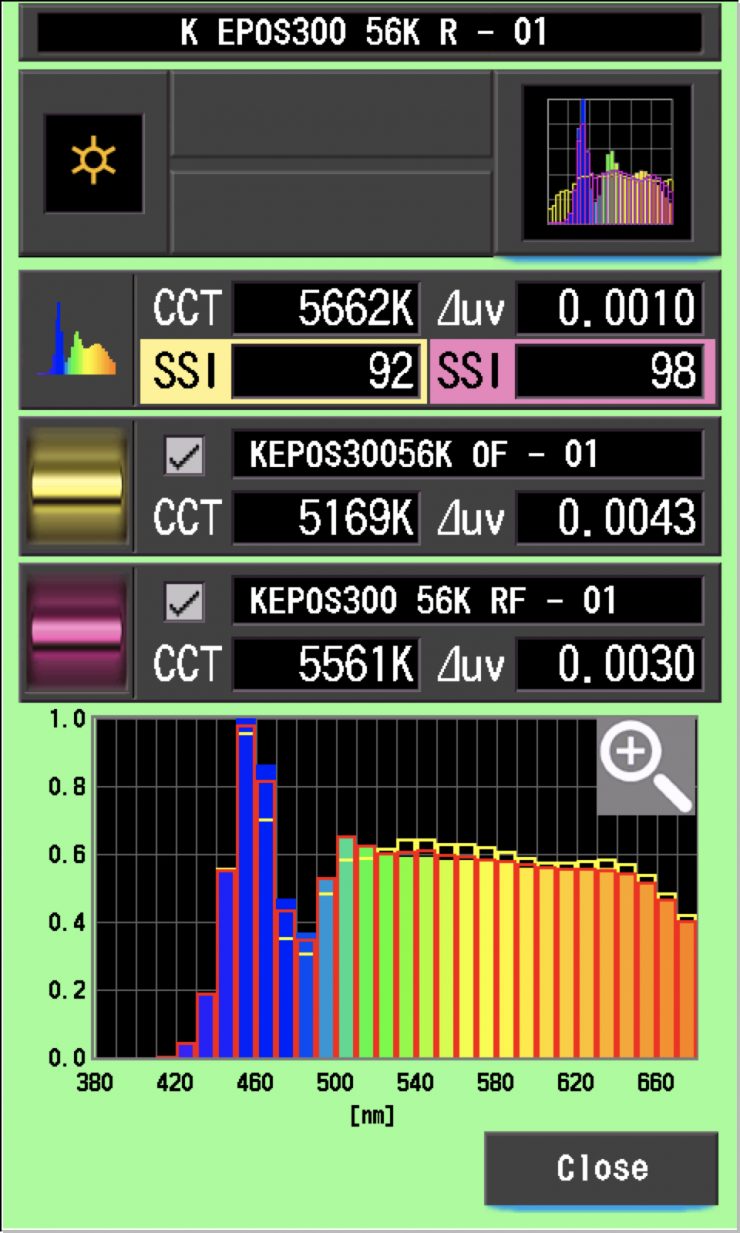
As you can see, when you use the light open face it isn’t going to be a perfect match if you were using it with another Epos 300 running its reflector and medium diffusion. Conversely, it is almost a perfect match when used with its reflector or reflector and medium diffusion.
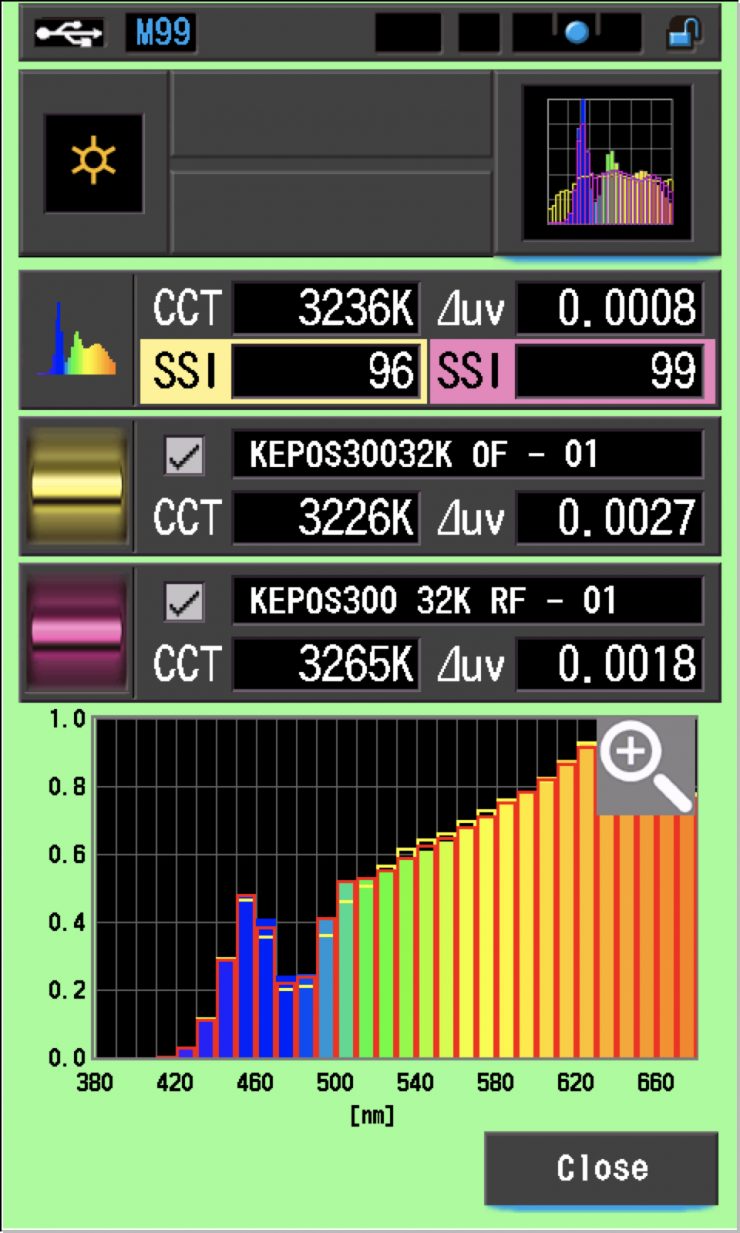
As you can see, when you use the light open face it is pretty close to being a perfect match if you were using it with another Epos 300 running its reflector and medium diffusion. It was also almost a perfect match when used with its reflector or reflector and medium diffusion.
SSI tests are a great way of telling you what lights you own or use will work well together.
Spectral Distribution
5600K
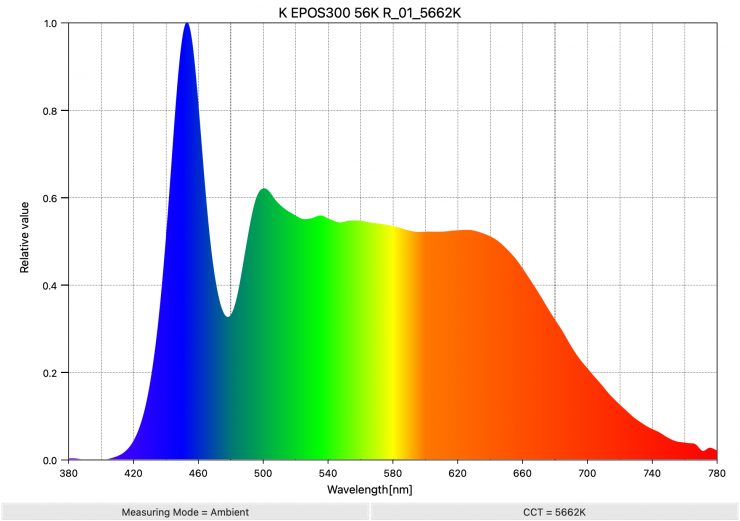
Above you can see the spectral distribution of the Kelvin Epos 300 when it is set at 5600K. The spectral distribution is very full, and it has a lot of information in the 640 nm to 680 nm that you don’t see in a lot of competing lights.
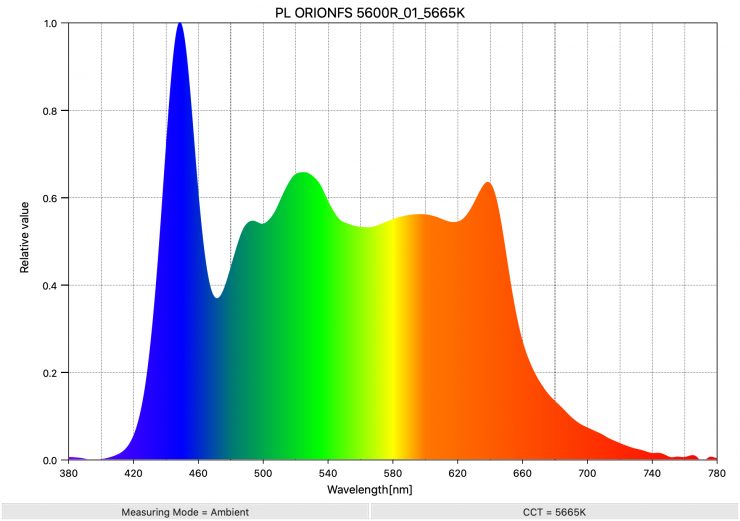
As a comparison, above you can see the spectral distribution of the Prolycht Orion 300 FS when it is set at 5600K
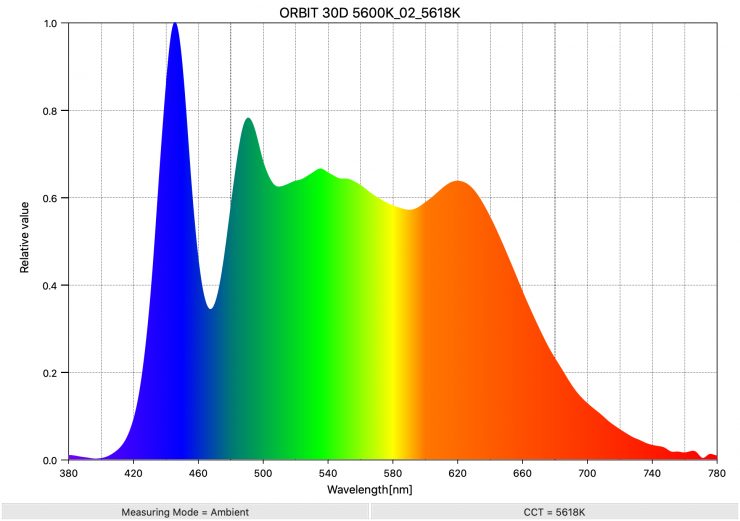
As another comparison, above you can see the spectral distribution of the ARRI Orbiter.
3200K
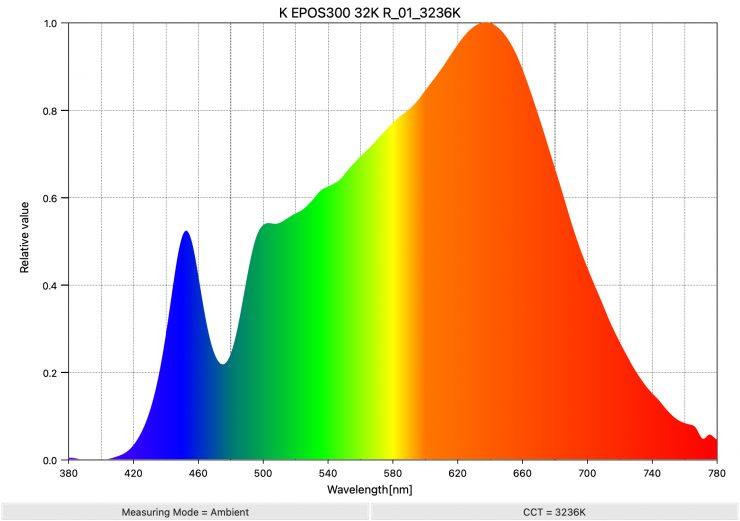
Above you can see the spectral distribution of the Kelvin Epos 300 when it is set at 3200K. The spectral distribution certainly has a slight push towards green but it is very full for a LED light set at 3200K
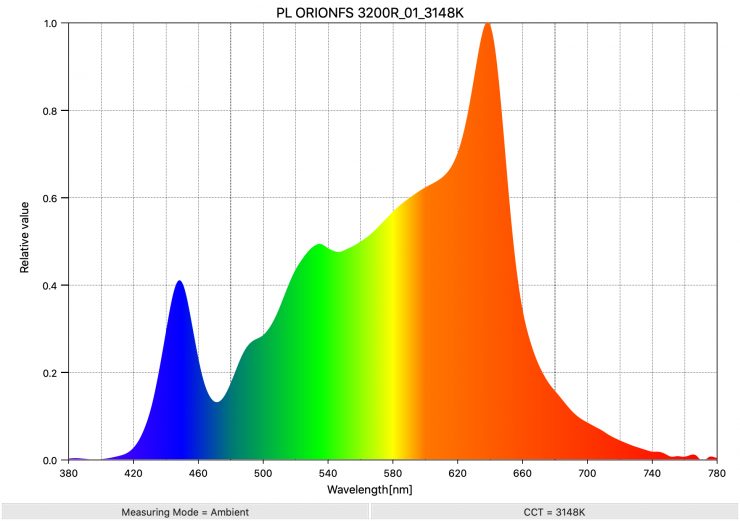
As a comparison, above you can see the spectral distribution of the Prolycht Orion 300 FS when it is set at 3200K
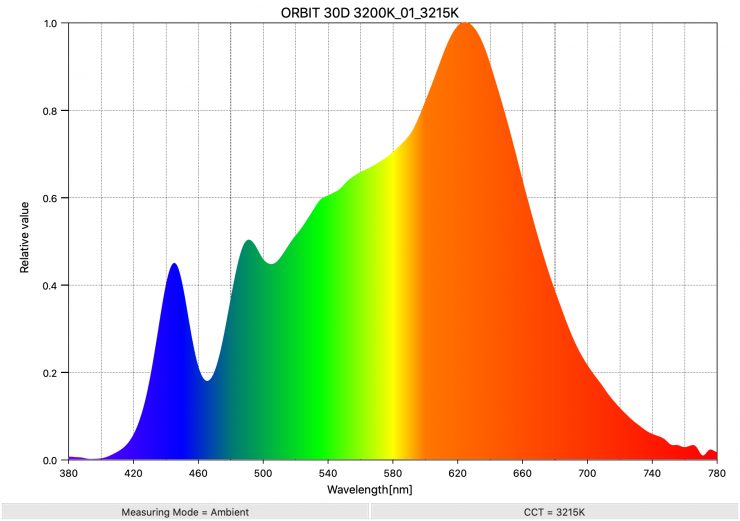
As another comparison, above you can see the spectral distribution of the ARRI Orbiter.
Real-World Performance & Quality of Light
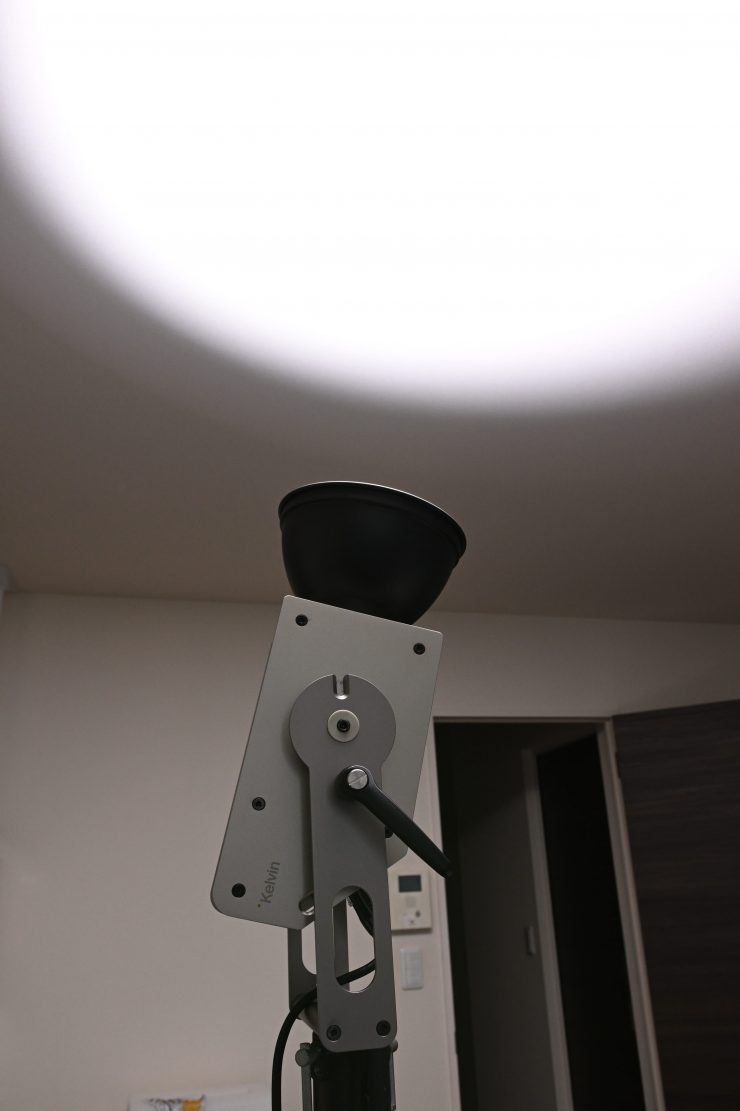
As I always say, photometric scores only tell you part of the story. So let’s find out if the scores from the Kelvin Epos 300 translate into good real-world performance.
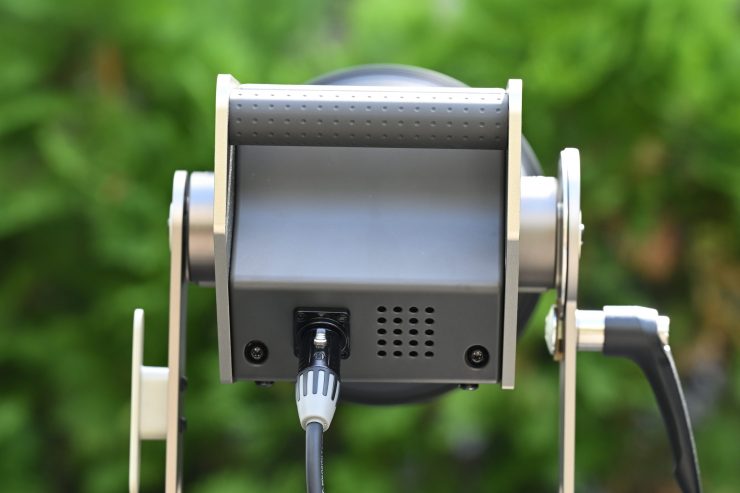
The photometric results can only give me scientific data and it is much more important for me to see how the light looks and performs, especially with skin tones.
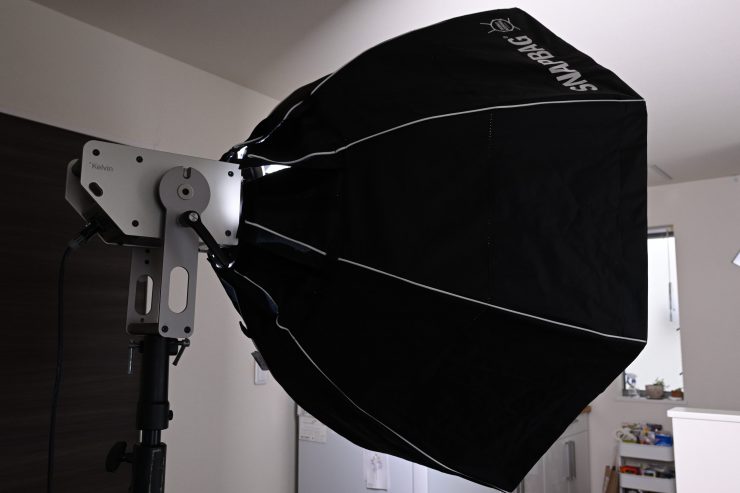
It is very easy to create a very soft, flattering light source using the Kelvin Epos 300. I found that by using a softbox you could create a very soft lighting source without needing to punch it through a diffusion screen. This makes it a very quick and easy light to use for interview situations or for any scenario where you need soft light.
Above you can see what the light looks like with a DoPChoice Octa 3 softbox being used. I am not using any other lights in these examples.
The light doesn’t completely fill up a large softbox because the beam angle isn’t overly wide, although that is also the case when using most point source lights. In saying that, there is still plenty of illumination and it works well. Kelvin recommends using the Diffusion Dome attachment with a softbox to get a broader spread, but that will reduce the output.
The softbox also produces nice soft shadows as you can see from these examples above.
It also works well when you punch the light through a large diffusion screen or into some polyboard.
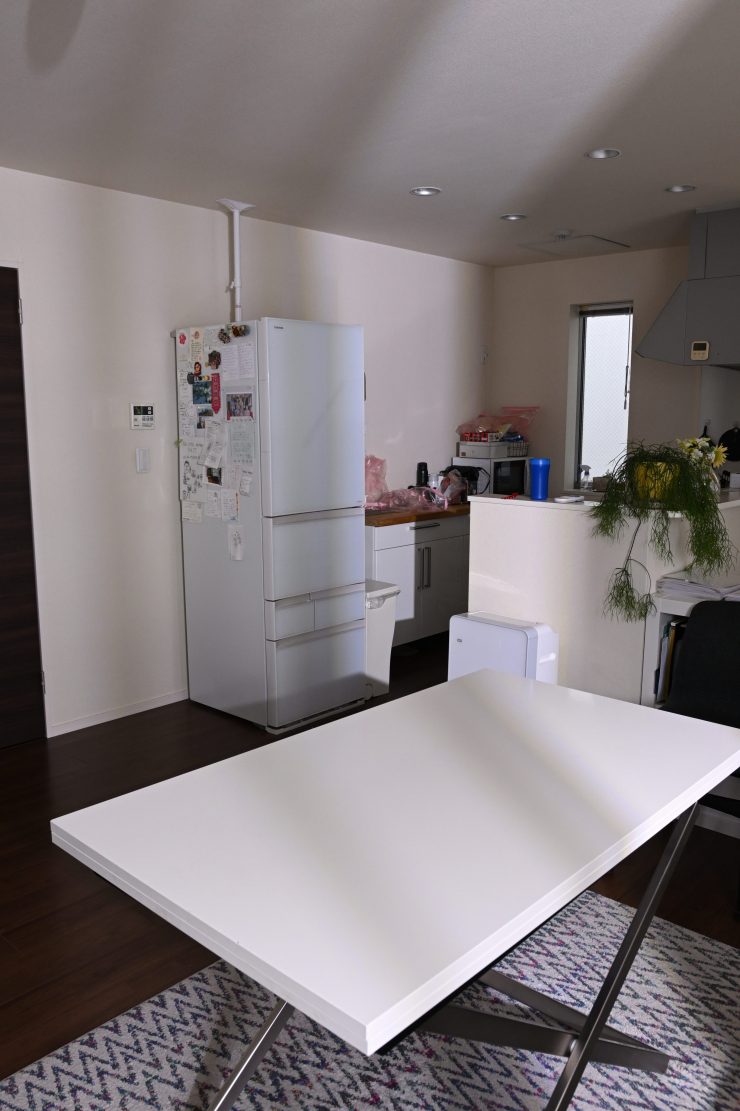
Open Face (Constant Mode) 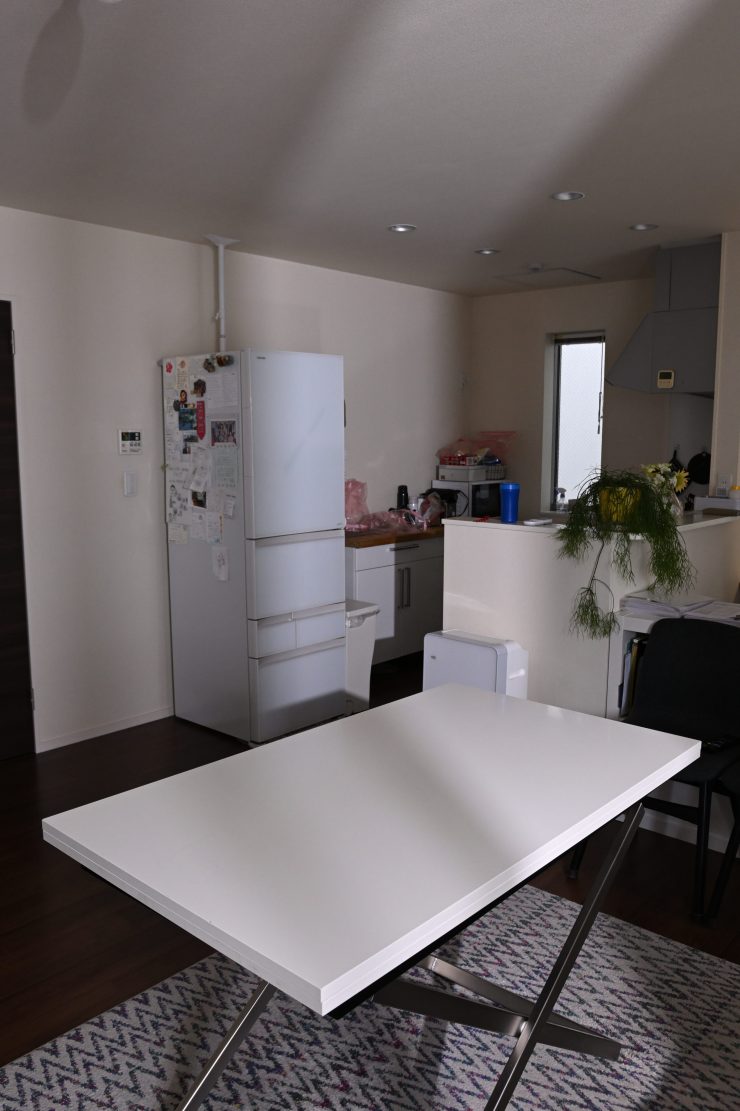
Medium Diffuser D90 (Constant Mode) 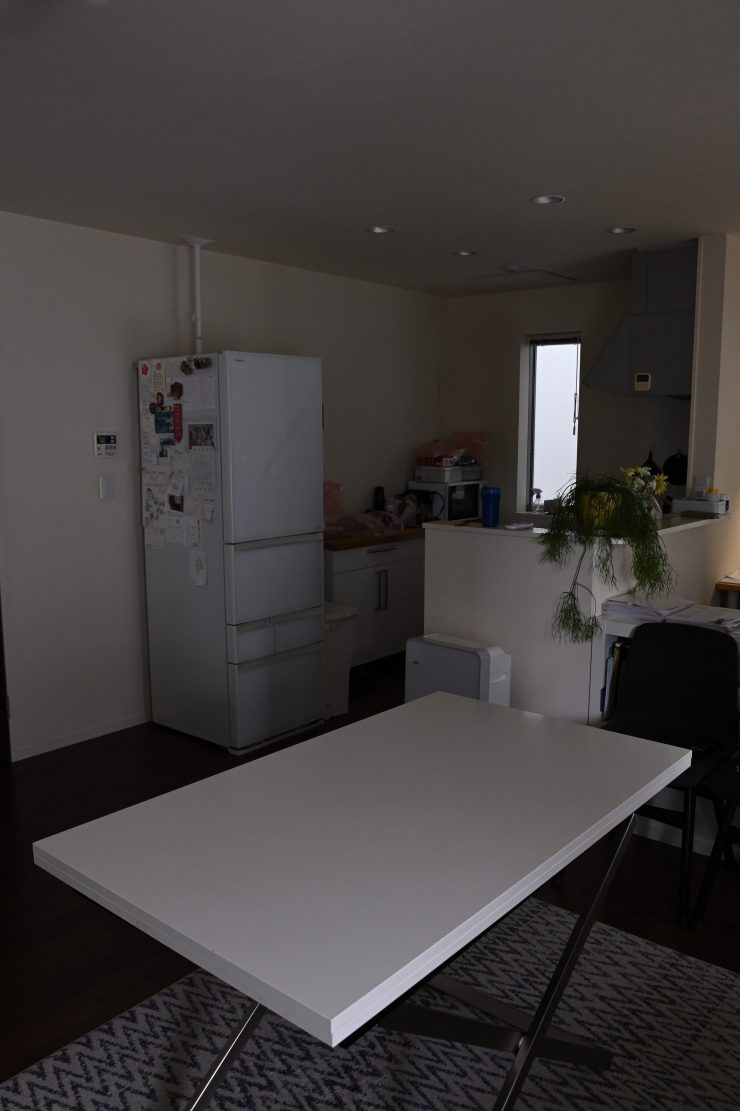
Light Off 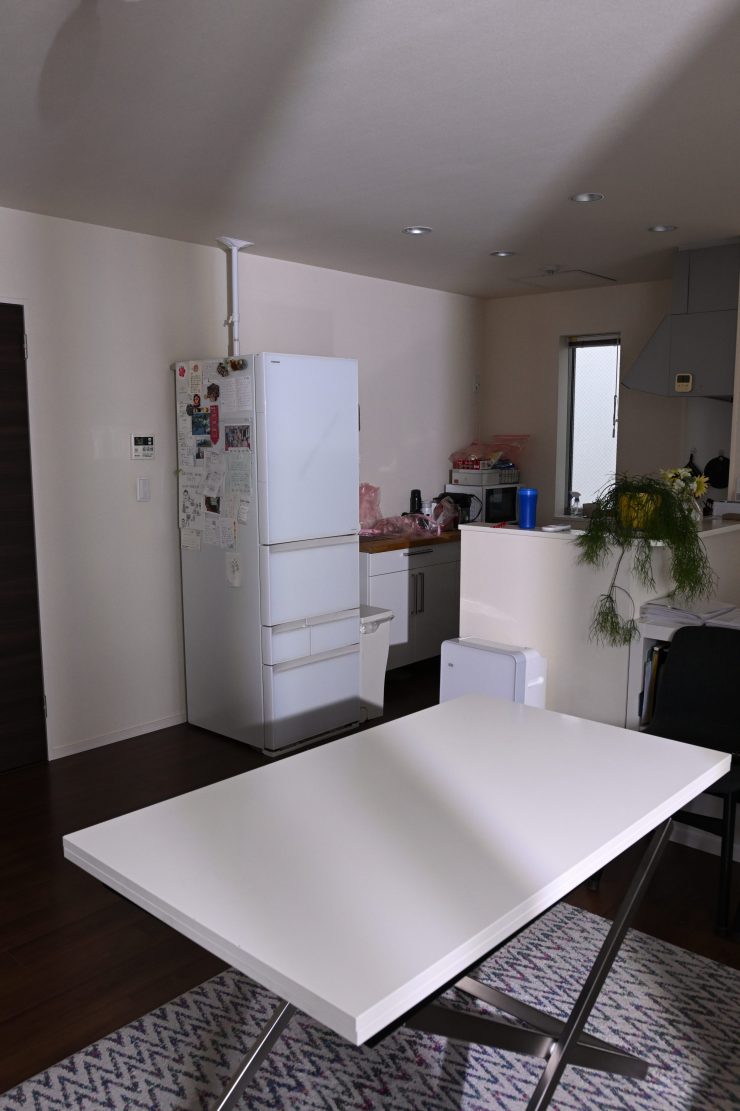
Light Diffuser D90 (Constant Mode) 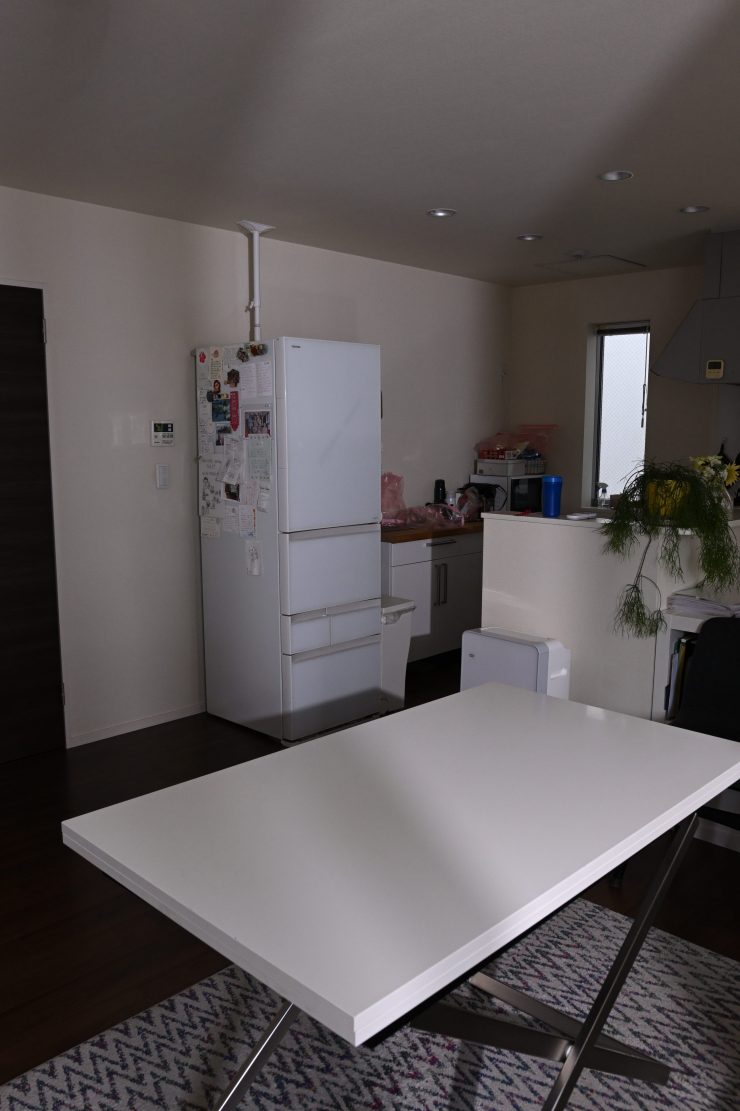
Diffusion Dome (Constant Mode) 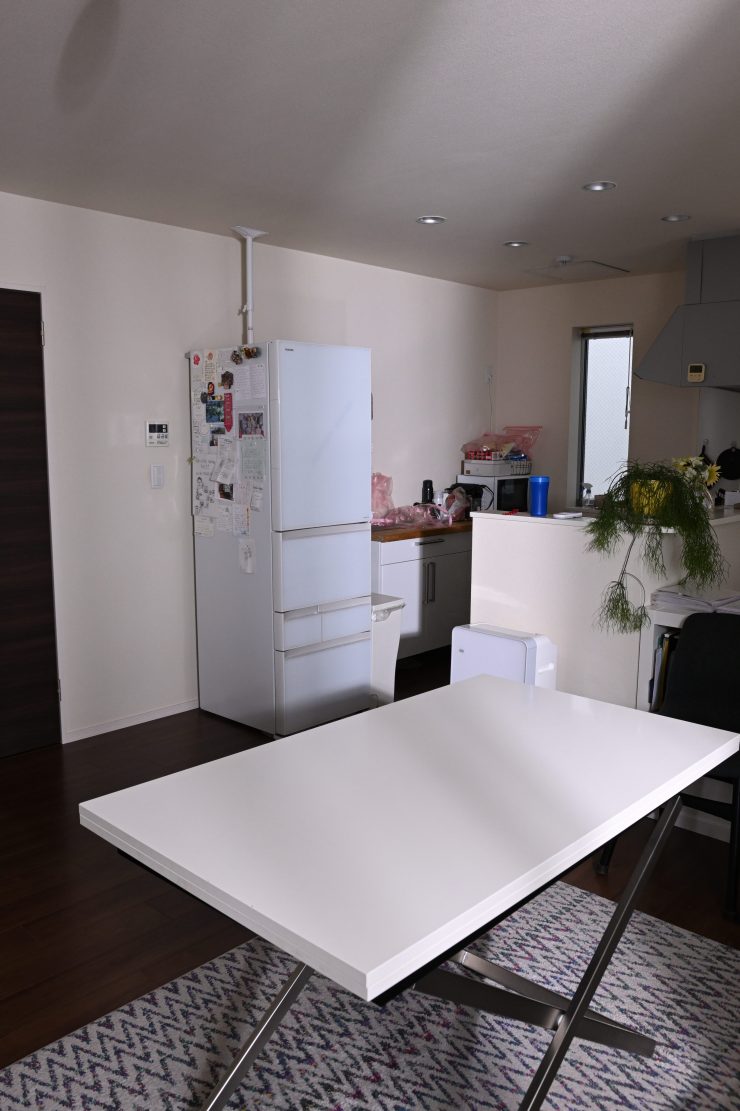
55 degree reflector and medium diffusion (constant Mode) 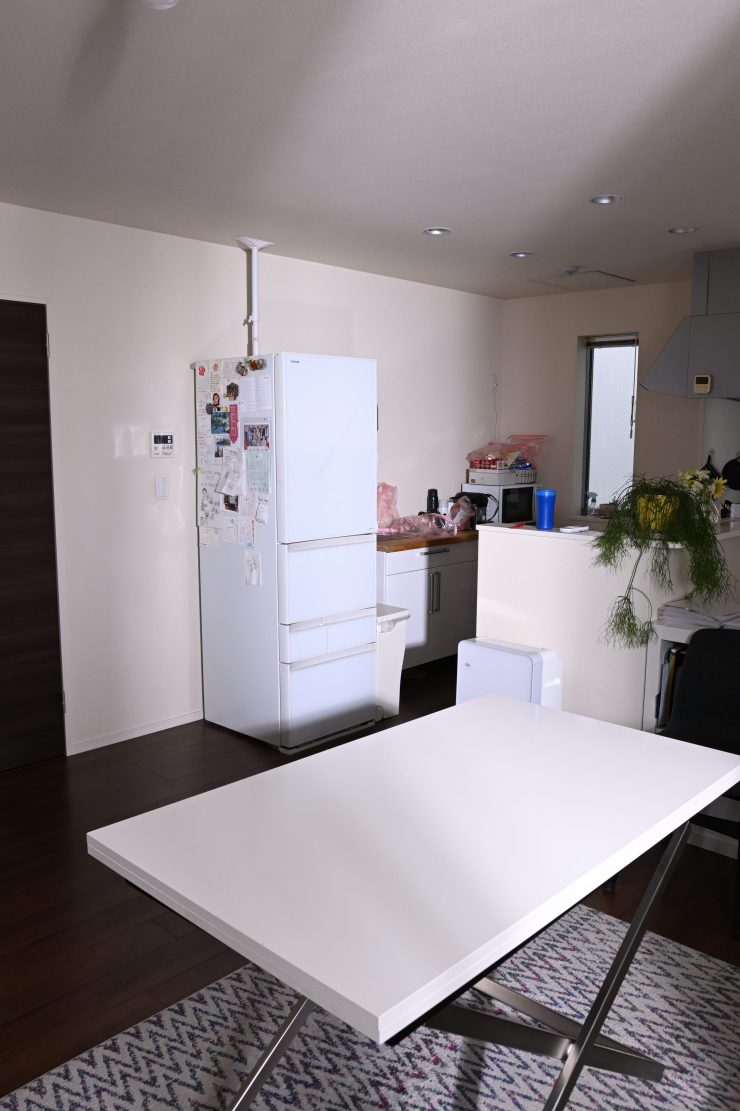
62 degree reflector and medium diffusion (constant Mode)
Above you can see comparison images showing the light when it is used open face and with its various magnetic diffusion filters, as well as the 55 and 62-degree reflectors. I have kept the settings exactly the same for all of the images.
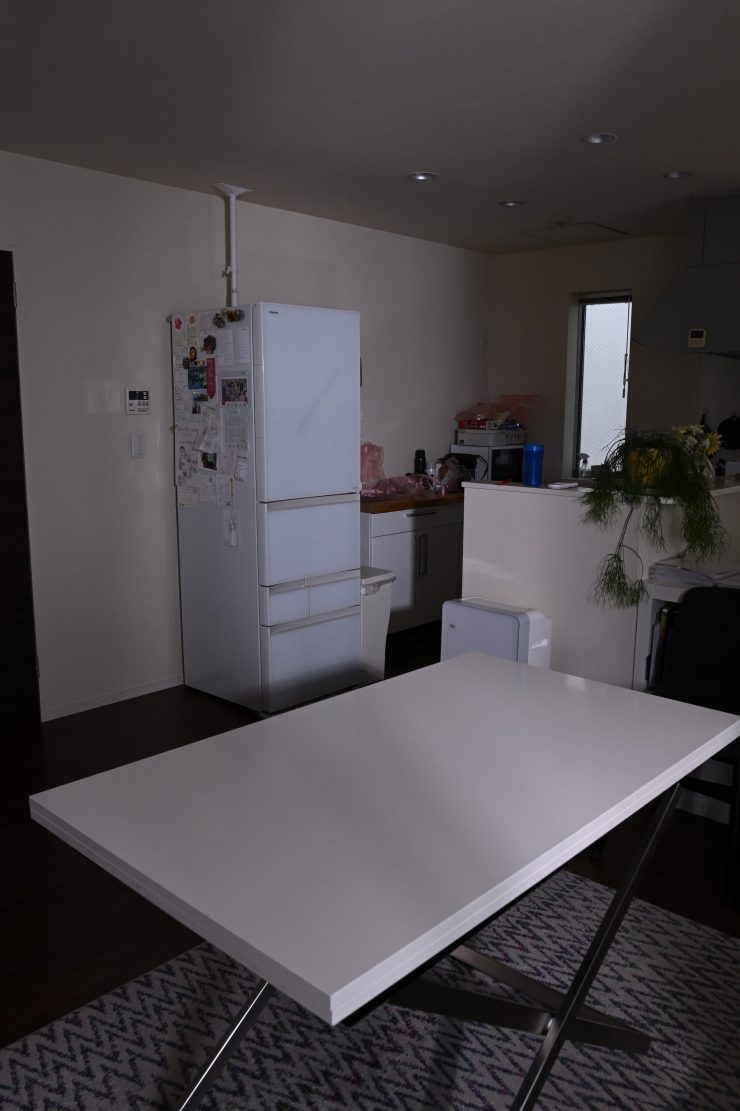
Silent 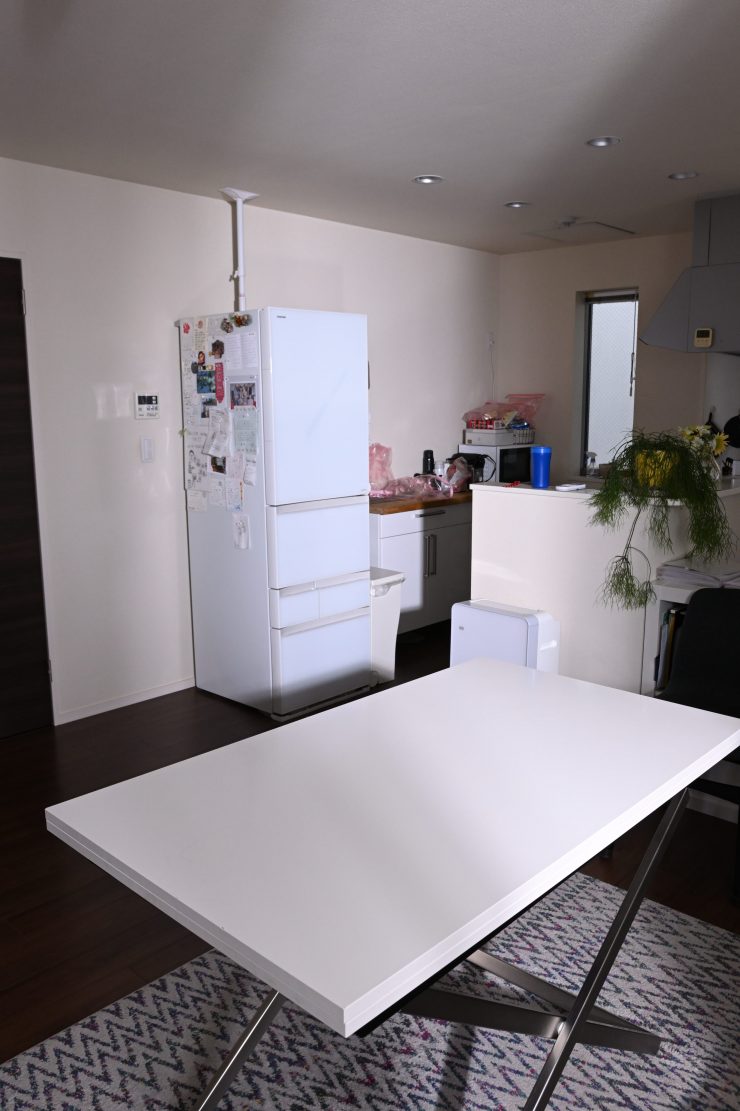
Quiet 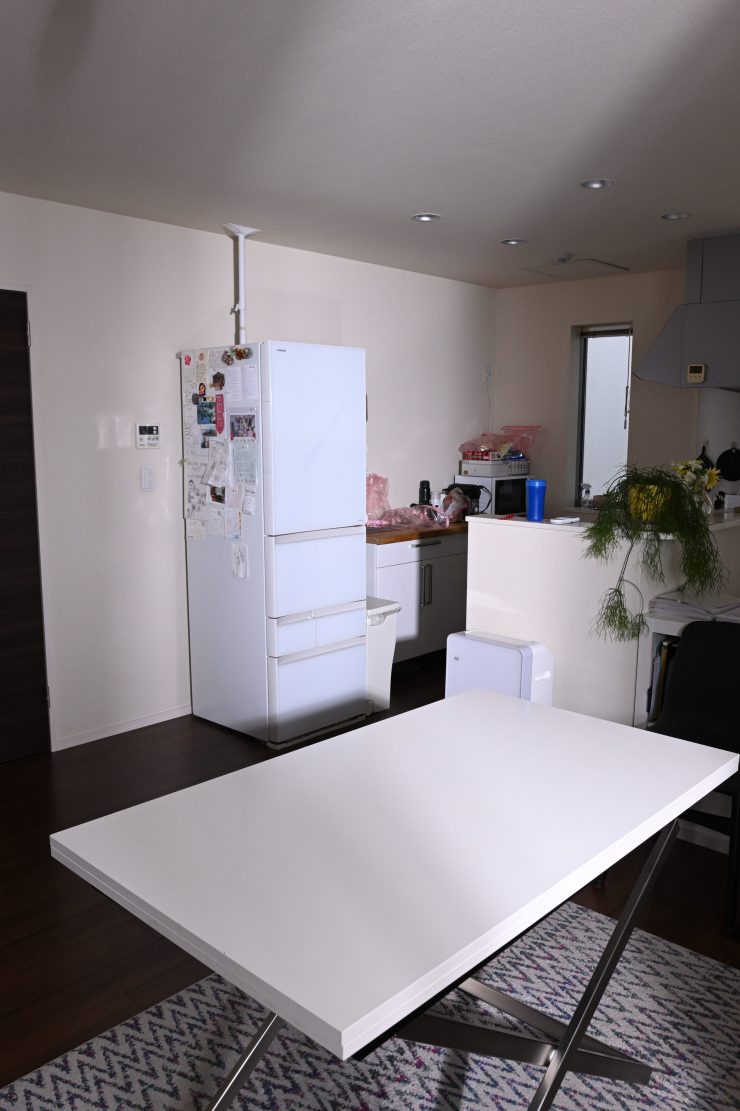
High
Above you can see the output of the light with the various fan settings.
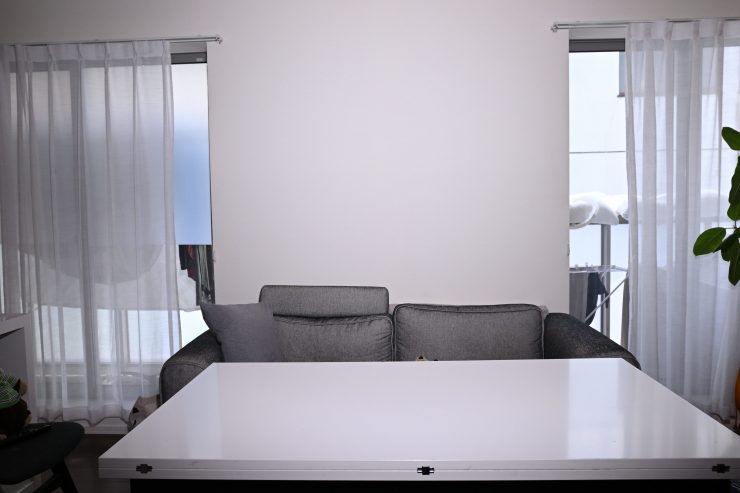
Kelvin Epos 300 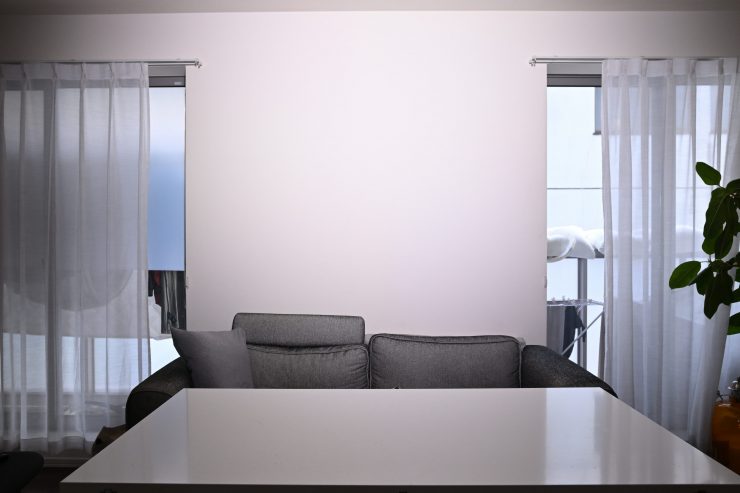
Prolycht Orion 300 FS
Ok, so now that’s have a look at an output comparison at a distance of 3m / 9.9′ between the Kelvin Orion 300 and the Prolycht Orion 300 FS when both fixtures are using their 55-degree reflectors.
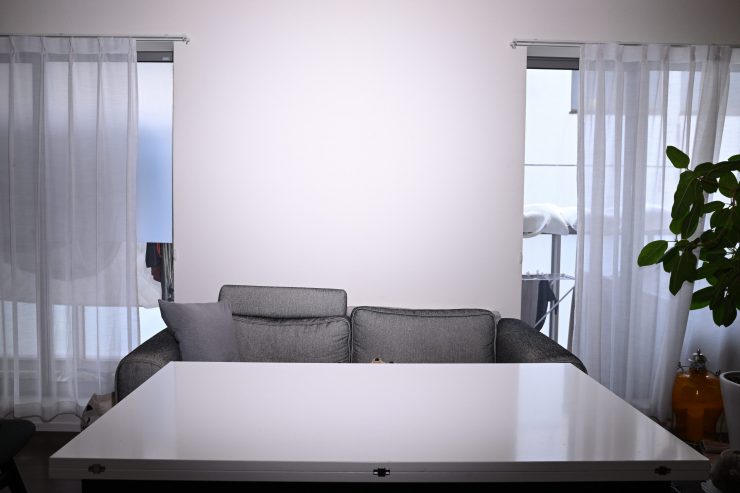
Kelvin Epos 300 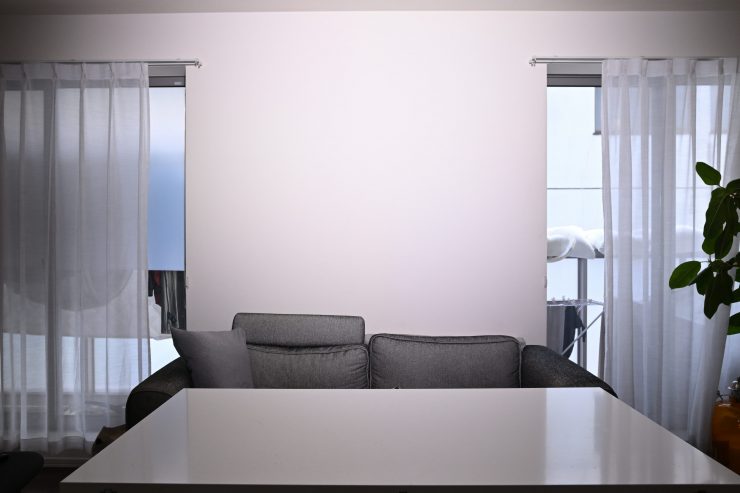
Prolycht Orion 300 FS
As another comparison, let’s do an output comparison between the Kelvin Epos 300 using its 62-degree reflector and the Prolycht Orion 300 FS using its 55-degree reflector.
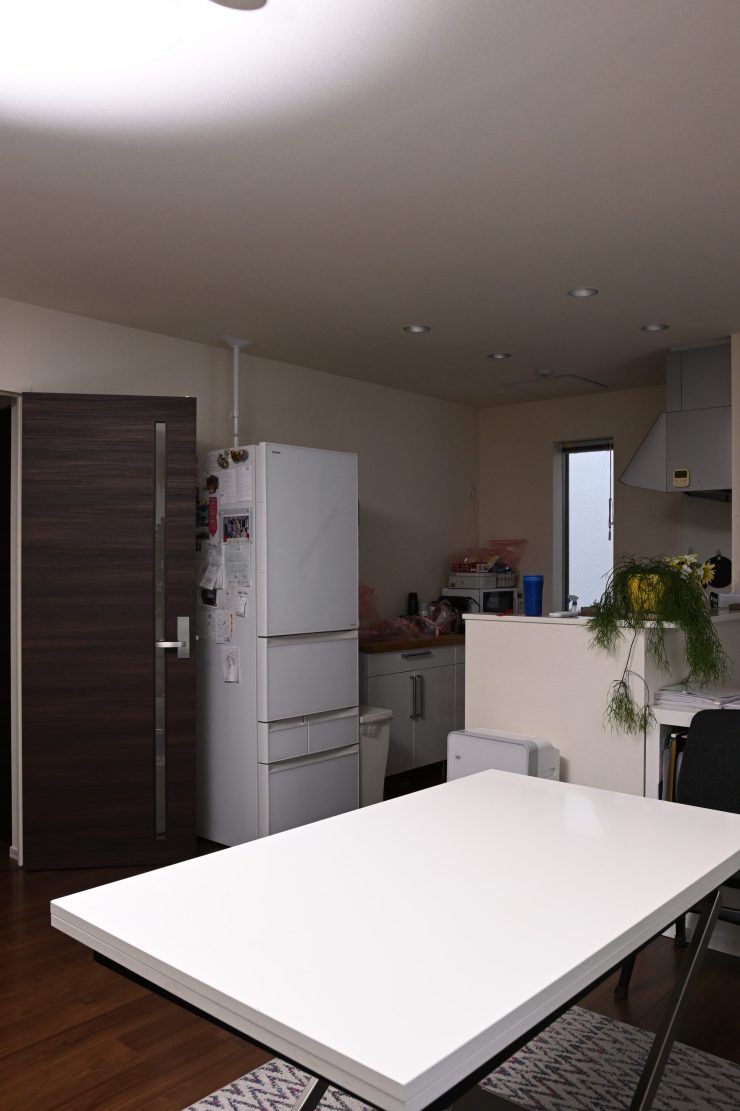
Light on 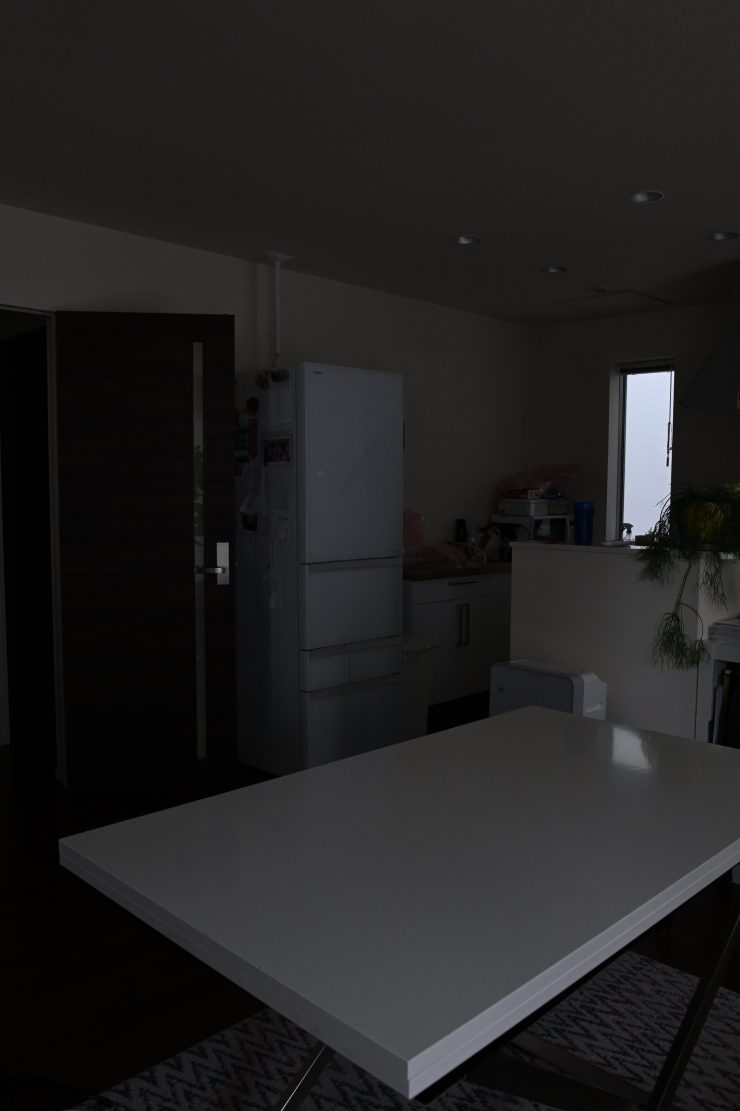
Light off
Above you can what the Kelvin Epos 300 looks like when it is punched directly into the ceiling.

The 62-degree reflector does have a bit of a hot spot in the middle, but it is not excessive.

The color fringing on the edges of the beam when using the reflector is well controlled.
Who is the Kelvin Epos 300 aimed at?
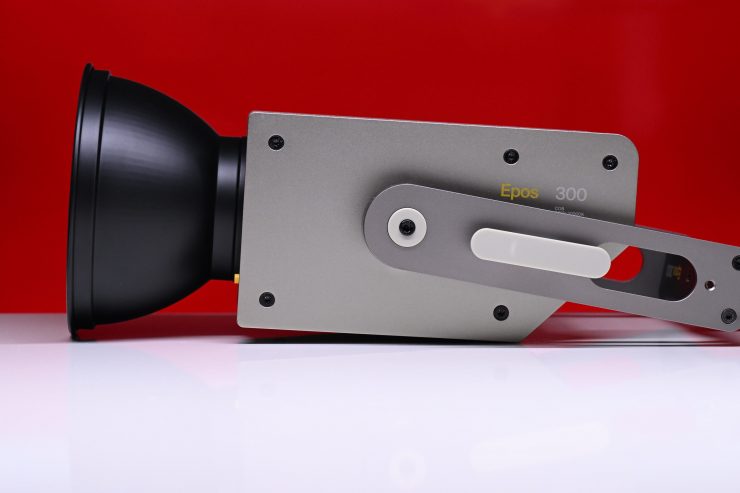
You could use the Kelvin Epos 300 for lots of different applications, but the light is certainly being aimed as a versatile, high-output, well-made lighting fixture for professionals in the TV and film industry.
It is priced to appeal to mid to high-end owner-operators who are looking for a jack-of-all-trades lighting solution. Just like most modern-day LED spotlights, the Epos 300 has the ability to be a hard light source, a soft source, a fresnel, a gobo, a Source 4, or just about anything else you want it to be. I like the magnetic diffusion filters that you can use with or without reflectors, soft boxes, etc. as it further increases the flexibility of the fixture.
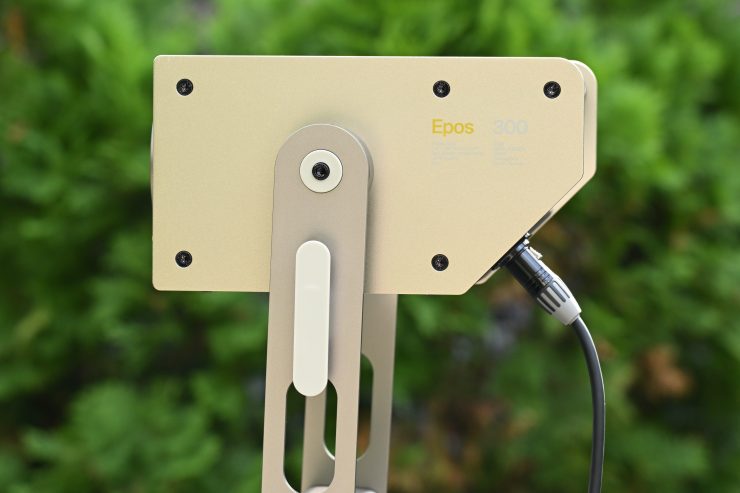
Is the Kelvin Epos 300 likely to appeal to solo shooters and small crews who are looking for a similar light to say an Aputure 300x, but with more features? That is hard to say, because it is considerably more expensive, and heavier, and you have the issue of not being able to run the light at 100% output from two regular 14.4V flight-safe batteries.
Price & Availability
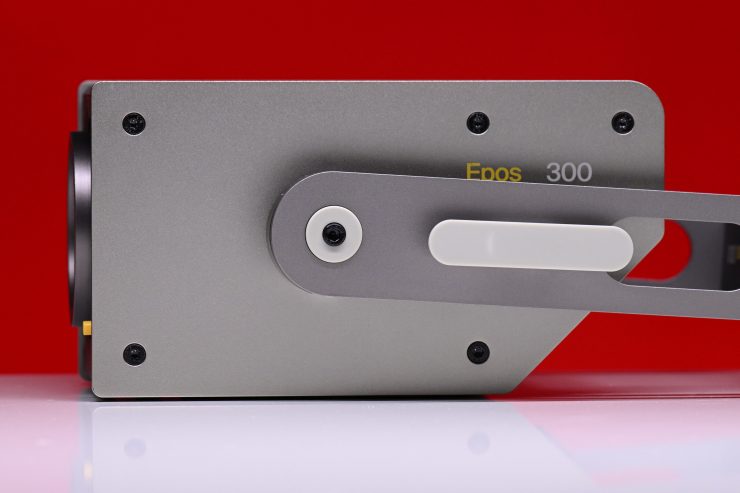
The Kelvin Epos 300 retails for $2,499 USD. This does make it more expensive than most other competing fixtures that could be considered competition. It is important to note that this light is handmade in Norway and the manufacturing costs are going to be significantly higher than lights that are made in China. The materials being used are also of a higher quality than the competition.
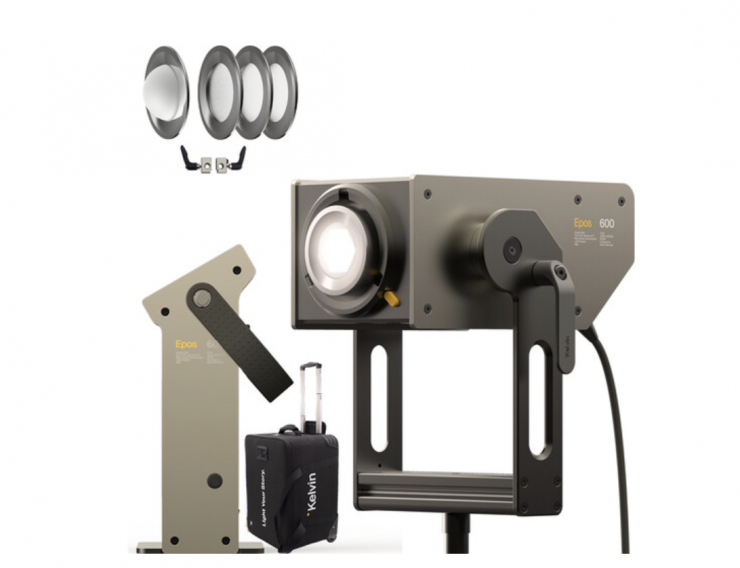
The other slight issue for Kelvin is that they are selling their new Epos 600 Travel Kit currently for $2,999 USD, which makes it only $200 USD more than the Epos 300.
Below you can see how the price compares to the competition:
| PRICE | |
| Kelvin Epos 300 | $2,499 USD |
| Kelvin Epos 300 Travel Kit with Accessories | $2,799 USD |
| Prolycht Orion 300 FS Kit | $1,899 USD* |
| amaran 300c RGB | $569 USD |
| Lupo Movielight 300 Full Color PRO Kit | $1,498 USD |
| Godox SZ300R | $729 USD |
| ARRI Orbiter | $3,150 USD* |
*Currently on sale at B&H as of the 31/8/2023
Optional Extras
The Kelvin Epos 300 can be used with a ton of affordable accessories due to having a Bowens-S mount. However, DoPChoice in conjunction with Kelvin also makes its own accessories. Above you can see what is available:
Conclusion
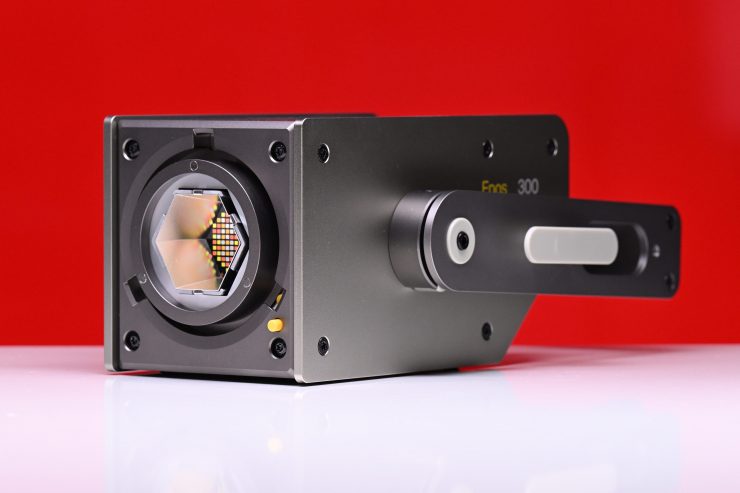
The Kelvin Epos 300 is certainly a very impressive fixture. It is beautifully made and easy to use and operate. With so many lighting modifiers available, it makes it a fixture you can use for so many different applications.
The Epos is fully featured, extremely versatile, and it produces a really nice quality of light. A lot of thought has gone into this fixture and the attention to detail shows.
The interface and operating system are super easy to use, as is the app. By utilizing a Bowens Mount you can utilize a large array of lighting modifiers without having to spend a ton of money. I also like that Kelvin’s own Magnetic Diffusers are relatively affordable.
The fan noise is not an issue, and only in the High setting are you likely to even notice it. The consistency of the light when it comes to output and color accuracy is impressive. In my opinion, the light is priced well given its feature set, output, and capabilities. The color accuracy is some of the best I have seen from any LED spotlight.
My biggest complaint with the light is that it isn’t nearly as easy to run at 100% output from camera batteries as a lot of its competition. This puts it at a disadvantage if that is one of the things you are looking for in a light.
The other slight negative is that it arguably doesn’t have as much output as some of the competing fixtures when you use it open face or with its standard 55-degree reflector. Although, if you use the 62-degree reflector then the output is very similar to that of the competition. I would also like to see Kelvin make a Fresnel attachment for it.
The light is also pretty heavy compared to the competition and that is something you need to take into account, especially if you travel a lot.
If you don’t need all of the bells and whistles and build quality that come with a light like this then you may well find that lower-priced options from amaran, Godox, or Lupo are a better option given their lower price. If, however, you are looking for a more affordable option than an ARRI Orbiter then the Kelvin Epos 300 makes a lot of sense.
The direct competition, at least in my opinion, comes from the Prolycht Orion 300 FS. It offers similar capabilities and it is more affordable, however, its build quality isn’t nearly as good as the Kelvin. I am also not sure what the future of Orion 300 FS will be now that Prolycht has been acquired by Aputure.
The Kelvin Epos 300 is an impressive fixture and it does a lot of things really well, without compromising on any of them. While it isn’t perfect (no light is) it is right up there with some of the best lighting fixtures I have ever reviewed.
Technical Specifications
Like what we do and want to support Newsshooter? Consider becoming a Patreon supporter and help us to continue being the best source of news and reviews for professional tools for the independent filmmaker.

